Service Quality Assessment on University of Central Lancashire in Cyprus Fitness Suite
VerifiedAdded on 2023/04/08
|123
|26891
|272
AI Summary
This research highlights the excellent quality of service in fitness centres and positive outcomes as a result of it both for the clients and the business.
Contribute Materials
Your contribution can guide someone’s learning journey. Share your
documents today.
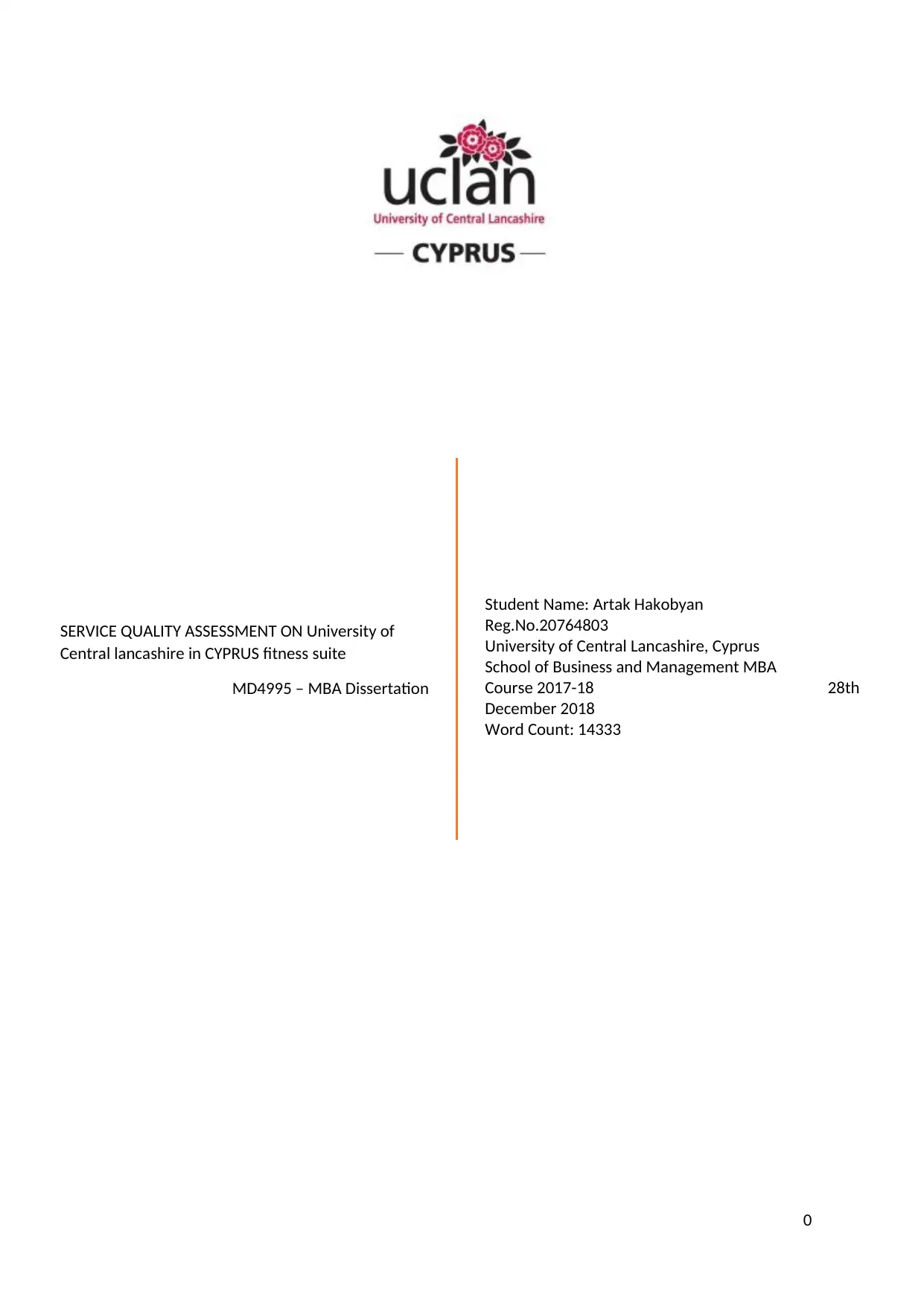
0
SERVICE QUALITY ASSESSMENT ON University of
Central lancashire in CYPRUS fitness suite
MD4995 – MBA Dissertation
Student Name: Artak Hakobyan
Reg.No.20764803
University of Central Lancashire, Cyprus
School of Business and Management MBA
Course 2017-18 28th
December 2018
Word Count: 14333
SERVICE QUALITY ASSESSMENT ON University of
Central lancashire in CYPRUS fitness suite
MD4995 – MBA Dissertation
Student Name: Artak Hakobyan
Reg.No.20764803
University of Central Lancashire, Cyprus
School of Business and Management MBA
Course 2017-18 28th
December 2018
Word Count: 14333
Secure Best Marks with AI Grader
Need help grading? Try our AI Grader for instant feedback on your assignments.
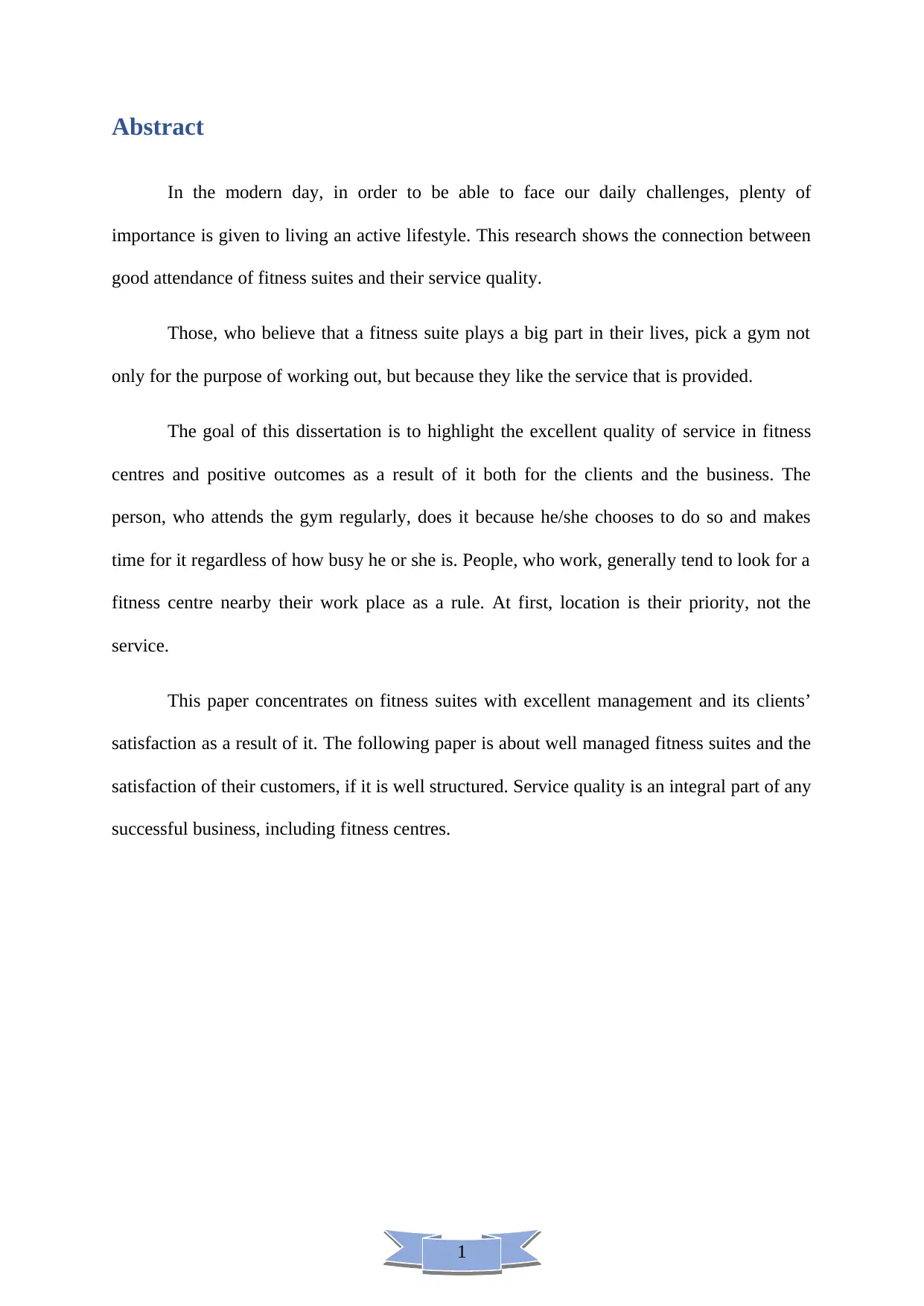
1
Abstract
In the modern day, in order to be able to face our daily challenges, plenty of
importance is given to living an active lifestyle. This research shows the connection between
good attendance of fitness suites and their service quality.
Those, who believe that a fitness suite plays a big part in their lives, pick a gym not
only for the purpose of working out, but because they like the service that is provided.
The goal of this dissertation is to highlight the excellent quality of service in fitness
centres and positive outcomes as a result of it both for the clients and the business. The
person, who attends the gym regularly, does it because he/she chooses to do so and makes
time for it regardless of how busy he or she is. People, who work, generally tend to look for a
fitness centre nearby their work place as a rule. At first, location is their priority, not the
service.
This paper concentrates on fitness suites with excellent management and its clients’
satisfaction as a result of it. The following paper is about well managed fitness suites and the
satisfaction of their customers, if it is well structured. Service quality is an integral part of any
successful business, including fitness centres.
Abstract
In the modern day, in order to be able to face our daily challenges, plenty of
importance is given to living an active lifestyle. This research shows the connection between
good attendance of fitness suites and their service quality.
Those, who believe that a fitness suite plays a big part in their lives, pick a gym not
only for the purpose of working out, but because they like the service that is provided.
The goal of this dissertation is to highlight the excellent quality of service in fitness
centres and positive outcomes as a result of it both for the clients and the business. The
person, who attends the gym regularly, does it because he/she chooses to do so and makes
time for it regardless of how busy he or she is. People, who work, generally tend to look for a
fitness centre nearby their work place as a rule. At first, location is their priority, not the
service.
This paper concentrates on fitness suites with excellent management and its clients’
satisfaction as a result of it. The following paper is about well managed fitness suites and the
satisfaction of their customers, if it is well structured. Service quality is an integral part of any
successful business, including fitness centres.

Acknowledgements
I would like to take the opportunity to thank my family who believe in me and support
me no matter the circumstances, especially my sister, who has been a great friend through
this entire challenging and exciting time. I would like to thank everybody, who have been
next to me through all this year, unknowingly teaching me life lessons big and small, positive
life lessons.
I would also like to thank everybody, who participated in the survey and the staff of
the UCLAN Library, the Office of Student Support and the Staff of the Fitness suite of
UCLAN Cyprus for helping me to find and connect with the students on campus.
I would also like to thank my professors, who taught me during the academic year for
the unforgettable knowledge that they gave me.
I would also like to extend my special gratitude to my amazing supervisor Dr.
Christos Anagnostopoulos for his help and guidance in helping me to find the skills and
knowledge that I needed and for the time he devoted to me to write this paper.
2
I would like to take the opportunity to thank my family who believe in me and support
me no matter the circumstances, especially my sister, who has been a great friend through
this entire challenging and exciting time. I would like to thank everybody, who have been
next to me through all this year, unknowingly teaching me life lessons big and small, positive
life lessons.
I would also like to thank everybody, who participated in the survey and the staff of
the UCLAN Library, the Office of Student Support and the Staff of the Fitness suite of
UCLAN Cyprus for helping me to find and connect with the students on campus.
I would also like to thank my professors, who taught me during the academic year for
the unforgettable knowledge that they gave me.
I would also like to extend my special gratitude to my amazing supervisor Dr.
Christos Anagnostopoulos for his help and guidance in helping me to find the skills and
knowledge that I needed and for the time he devoted to me to write this paper.
2
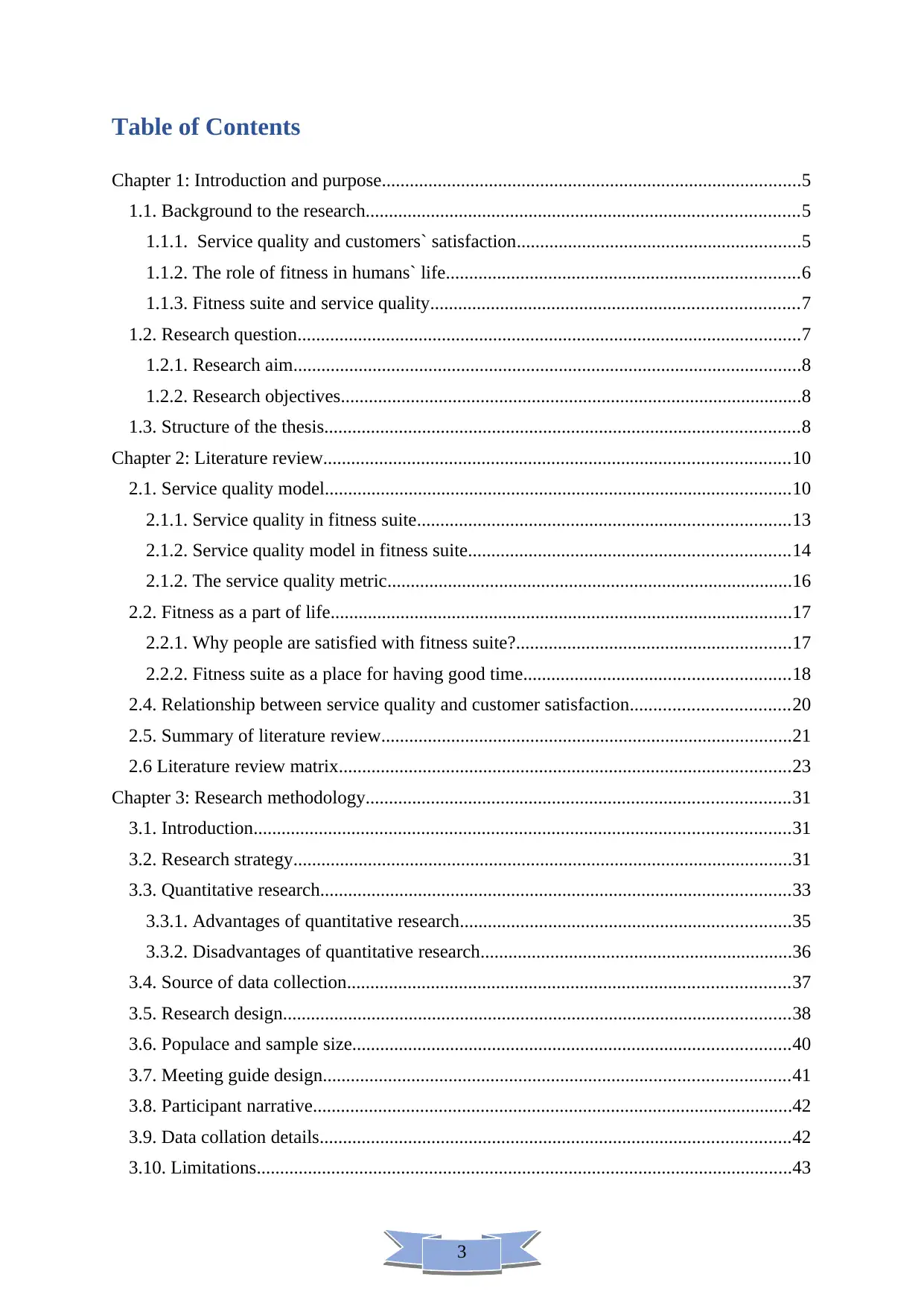
3
Table of Contents
Chapter 1: Introduction and purpose..........................................................................................5
1.1. Background to the research.............................................................................................5
1.1.1. Service quality and customers` satisfaction.............................................................5
1.1.2. The role of fitness in humans` life............................................................................6
1.1.3. Fitness suite and service quality...............................................................................7
1.2. Research question............................................................................................................7
1.2.1. Research aim.............................................................................................................8
1.2.2. Research objectives...................................................................................................8
1.3. Structure of the thesis......................................................................................................8
Chapter 2: Literature review....................................................................................................10
2.1. Service quality model....................................................................................................10
2.1.1. Service quality in fitness suite................................................................................13
2.1.2. Service quality model in fitness suite.....................................................................14
2.1.2. The service quality metric.......................................................................................16
2.2. Fitness as a part of life...................................................................................................17
2.2.1. Why people are satisfied with fitness suite?...........................................................17
2.2.2. Fitness suite as a place for having good time.........................................................18
2.4. Relationship between service quality and customer satisfaction..................................20
2.5. Summary of literature review........................................................................................21
2.6 Literature review matrix.................................................................................................23
Chapter 3: Research methodology...........................................................................................31
3.1. Introduction...................................................................................................................31
3.2. Research strategy...........................................................................................................31
3.3. Quantitative research.....................................................................................................33
3.3.1. Advantages of quantitative research.......................................................................35
3.3.2. Disadvantages of quantitative research...................................................................36
3.4. Source of data collection...............................................................................................37
3.5. Research design.............................................................................................................38
3.6. Populace and sample size..............................................................................................40
3.7. Meeting guide design....................................................................................................41
3.8. Participant narrative.......................................................................................................42
3.9. Data collation details.....................................................................................................42
3.10. Limitations...................................................................................................................43
Table of Contents
Chapter 1: Introduction and purpose..........................................................................................5
1.1. Background to the research.............................................................................................5
1.1.1. Service quality and customers` satisfaction.............................................................5
1.1.2. The role of fitness in humans` life............................................................................6
1.1.3. Fitness suite and service quality...............................................................................7
1.2. Research question............................................................................................................7
1.2.1. Research aim.............................................................................................................8
1.2.2. Research objectives...................................................................................................8
1.3. Structure of the thesis......................................................................................................8
Chapter 2: Literature review....................................................................................................10
2.1. Service quality model....................................................................................................10
2.1.1. Service quality in fitness suite................................................................................13
2.1.2. Service quality model in fitness suite.....................................................................14
2.1.2. The service quality metric.......................................................................................16
2.2. Fitness as a part of life...................................................................................................17
2.2.1. Why people are satisfied with fitness suite?...........................................................17
2.2.2. Fitness suite as a place for having good time.........................................................18
2.4. Relationship between service quality and customer satisfaction..................................20
2.5. Summary of literature review........................................................................................21
2.6 Literature review matrix.................................................................................................23
Chapter 3: Research methodology...........................................................................................31
3.1. Introduction...................................................................................................................31
3.2. Research strategy...........................................................................................................31
3.3. Quantitative research.....................................................................................................33
3.3.1. Advantages of quantitative research.......................................................................35
3.3.2. Disadvantages of quantitative research...................................................................36
3.4. Source of data collection...............................................................................................37
3.5. Research design.............................................................................................................38
3.6. Populace and sample size..............................................................................................40
3.7. Meeting guide design....................................................................................................41
3.8. Participant narrative.......................................................................................................42
3.9. Data collation details.....................................................................................................42
3.10. Limitations...................................................................................................................43
Secure Best Marks with AI Grader
Need help grading? Try our AI Grader for instant feedback on your assignments.
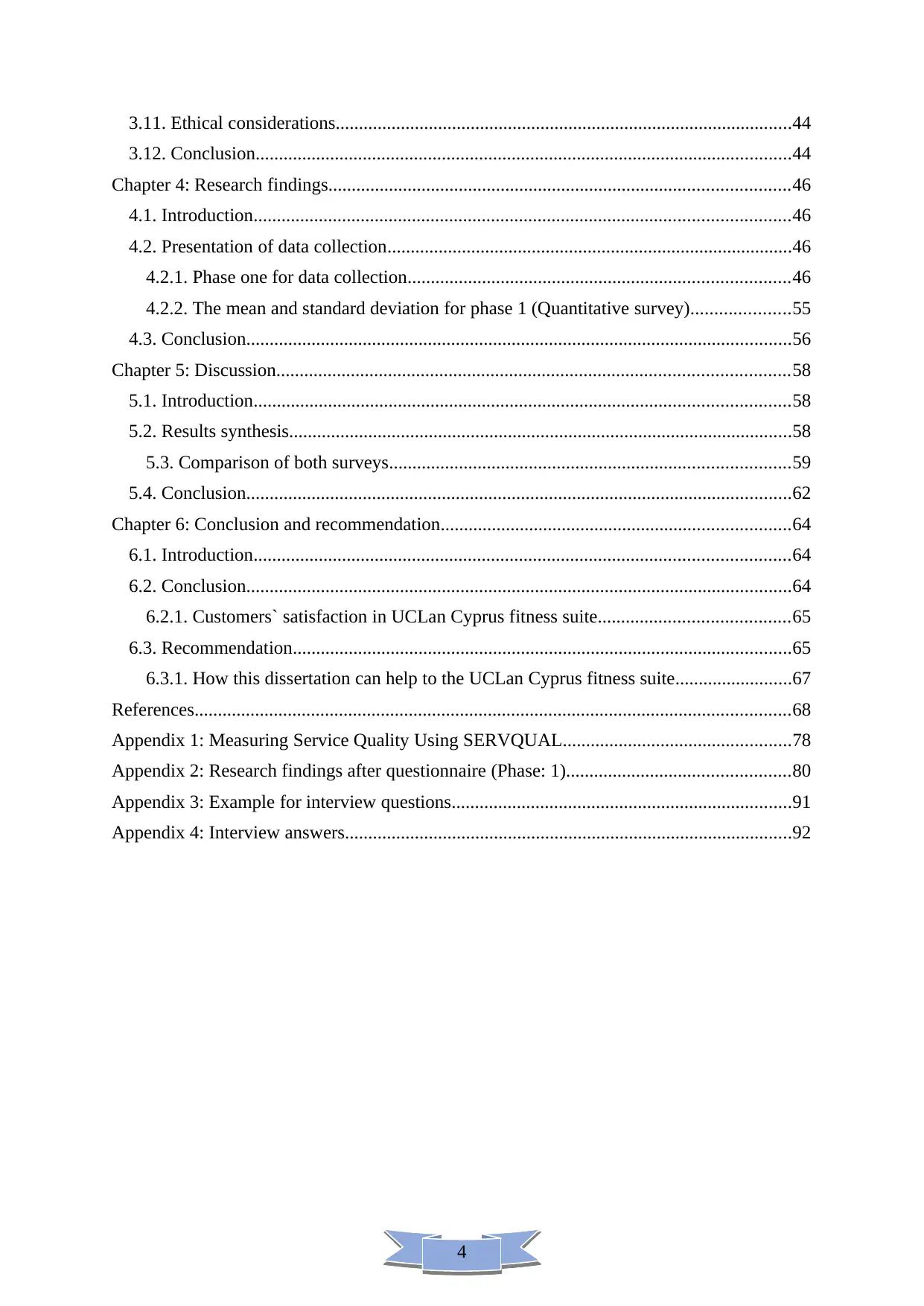
4
3.11. Ethical considerations..................................................................................................44
3.12. Conclusion...................................................................................................................44
Chapter 4: Research findings...................................................................................................46
4.1. Introduction...................................................................................................................46
4.2. Presentation of data collection.......................................................................................46
4.2.1. Phase one for data collection..................................................................................46
4.2.2. The mean and standard deviation for phase 1 (Quantitative survey).....................55
4.3. Conclusion.....................................................................................................................56
Chapter 5: Discussion..............................................................................................................58
5.1. Introduction...................................................................................................................58
5.2. Results synthesis............................................................................................................58
5.3. Comparison of both surveys......................................................................................59
5.4. Conclusion.....................................................................................................................62
Chapter 6: Conclusion and recommendation...........................................................................64
6.1. Introduction...................................................................................................................64
6.2. Conclusion.....................................................................................................................64
6.2.1. Customers` satisfaction in UCLan Cyprus fitness suite.........................................65
6.3. Recommendation...........................................................................................................65
6.3.1. How this dissertation can help to the UCLan Cyprus fitness suite.........................67
References................................................................................................................................68
Appendix 1: Measuring Service Quality Using SERVQUAL.................................................78
Appendix 2: Research findings after questionnaire (Phase: 1)................................................80
Appendix 3: Example for interview questions.........................................................................91
Appendix 4: Interview answers................................................................................................92
3.11. Ethical considerations..................................................................................................44
3.12. Conclusion...................................................................................................................44
Chapter 4: Research findings...................................................................................................46
4.1. Introduction...................................................................................................................46
4.2. Presentation of data collection.......................................................................................46
4.2.1. Phase one for data collection..................................................................................46
4.2.2. The mean and standard deviation for phase 1 (Quantitative survey).....................55
4.3. Conclusion.....................................................................................................................56
Chapter 5: Discussion..............................................................................................................58
5.1. Introduction...................................................................................................................58
5.2. Results synthesis............................................................................................................58
5.3. Comparison of both surveys......................................................................................59
5.4. Conclusion.....................................................................................................................62
Chapter 6: Conclusion and recommendation...........................................................................64
6.1. Introduction...................................................................................................................64
6.2. Conclusion.....................................................................................................................64
6.2.1. Customers` satisfaction in UCLan Cyprus fitness suite.........................................65
6.3. Recommendation...........................................................................................................65
6.3.1. How this dissertation can help to the UCLan Cyprus fitness suite.........................67
References................................................................................................................................68
Appendix 1: Measuring Service Quality Using SERVQUAL.................................................78
Appendix 2: Research findings after questionnaire (Phase: 1)................................................80
Appendix 3: Example for interview questions.........................................................................91
Appendix 4: Interview answers................................................................................................92
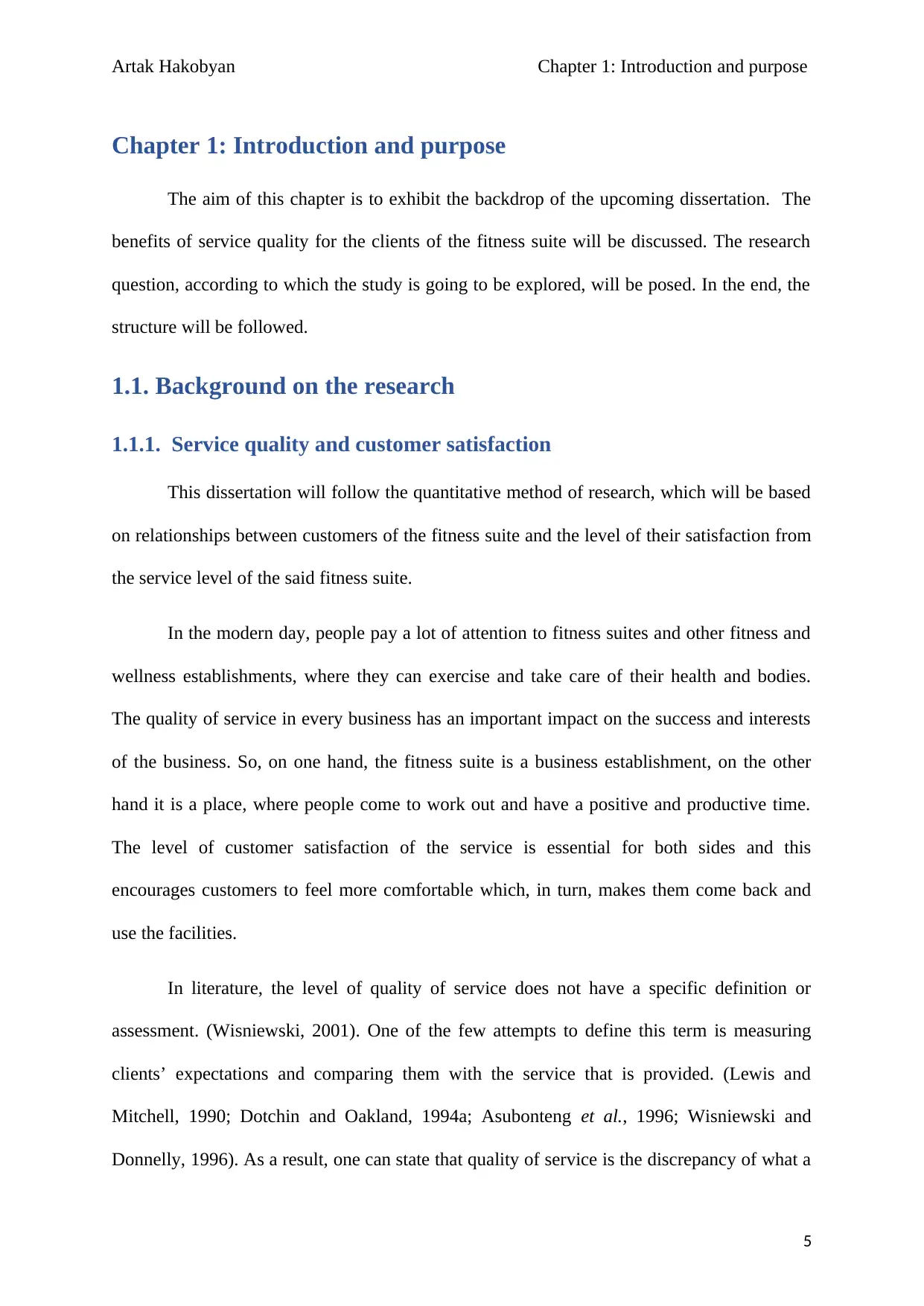
Artak Hakobyan Chapter 1: Introduction and purpose
Chapter 1: Introduction and purpose
The aim of this chapter is to exhibit the backdrop of the upcoming dissertation. The
benefits of service quality for the clients of the fitness suite will be discussed. The research
question, according to which the study is going to be explored, will be posed. In the end, the
structure will be followed.
1.1. Background on the research
1.1.1. Service quality and customer satisfaction
This dissertation will follow the quantitative method of research, which will be based
on relationships between customers of the fitness suite and the level of their satisfaction from
the service level of the said fitness suite.
In the modern day, people pay a lot of attention to fitness suites and other fitness and
wellness establishments, where they can exercise and take care of their health and bodies.
The quality of service in every business has an important impact on the success and interests
of the business. So, on one hand, the fitness suite is a business establishment, on the other
hand it is a place, where people come to work out and have a positive and productive time.
The level of customer satisfaction of the service is essential for both sides and this
encourages customers to feel more comfortable which, in turn, makes them come back and
use the facilities.
In literature, the level of quality of service does not have a specific definition or
assessment. (Wisniewski, 2001). One of the few attempts to define this term is measuring
clients’ expectations and comparing them with the service that is provided. (Lewis and
Mitchell, 1990; Dotchin and Oakland, 1994a; Asubonteng et al., 1996; Wisniewski and
Donnelly, 1996). As a result, one can state that quality of service is the discrepancy of what a
5
Chapter 1: Introduction and purpose
The aim of this chapter is to exhibit the backdrop of the upcoming dissertation. The
benefits of service quality for the clients of the fitness suite will be discussed. The research
question, according to which the study is going to be explored, will be posed. In the end, the
structure will be followed.
1.1. Background on the research
1.1.1. Service quality and customer satisfaction
This dissertation will follow the quantitative method of research, which will be based
on relationships between customers of the fitness suite and the level of their satisfaction from
the service level of the said fitness suite.
In the modern day, people pay a lot of attention to fitness suites and other fitness and
wellness establishments, where they can exercise and take care of their health and bodies.
The quality of service in every business has an important impact on the success and interests
of the business. So, on one hand, the fitness suite is a business establishment, on the other
hand it is a place, where people come to work out and have a positive and productive time.
The level of customer satisfaction of the service is essential for both sides and this
encourages customers to feel more comfortable which, in turn, makes them come back and
use the facilities.
In literature, the level of quality of service does not have a specific definition or
assessment. (Wisniewski, 2001). One of the few attempts to define this term is measuring
clients’ expectations and comparing them with the service that is provided. (Lewis and
Mitchell, 1990; Dotchin and Oakland, 1994a; Asubonteng et al., 1996; Wisniewski and
Donnelly, 1996). As a result, one can state that quality of service is the discrepancy of what a
5
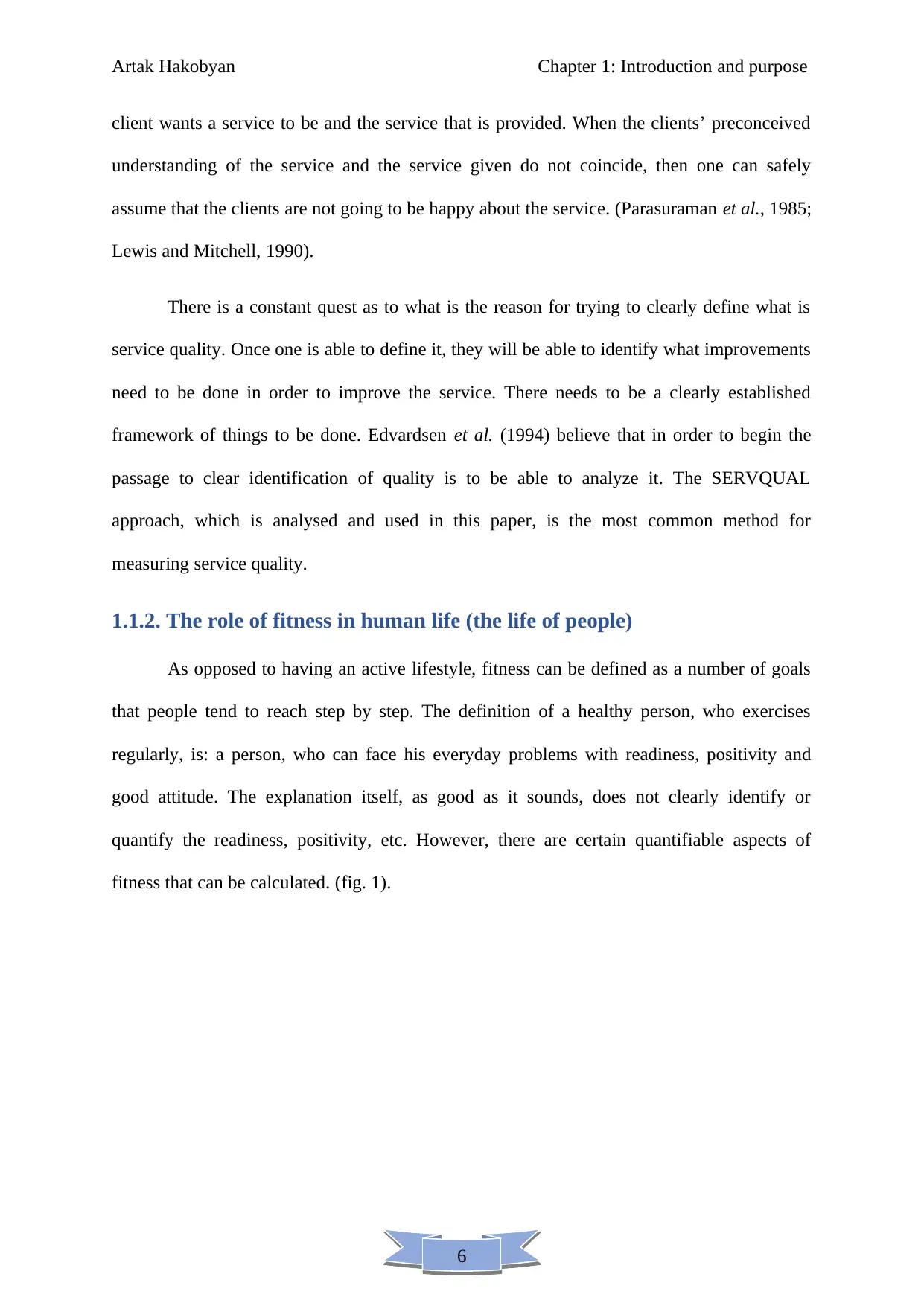
6
Artak Hakobyan Chapter 1: Introduction and purpose
client wants a service to be and the service that is provided. When the clients’ preconceived
understanding of the service and the service given do not coincide, then one can safely
assume that the clients are not going to be happy about the service. (Parasuraman et al., 1985;
Lewis and Mitchell, 1990).
There is a constant quest as to what is the reason for trying to clearly define what is
service quality. Once one is able to define it, they will be able to identify what improvements
need to be done in order to improve the service. There needs to be a clearly established
framework of things to be done. Edvardsen et al. (1994) believe that in order to begin the
passage to clear identification of quality is to be able to analyze it. The SERVQUAL
approach, which is analysed and used in this paper, is the most common method for
measuring service quality.
1.1.2. The role of fitness in human life (the life of people)
As opposed to having an active lifestyle, fitness can be defined as a number of goals
that people tend to reach step by step. The definition of a healthy person, who exercises
regularly, is: a person, who can face his everyday problems with readiness, positivity and
good attitude. The explanation itself, as good as it sounds, does not clearly identify or
quantify the readiness, positivity, etc. However, there are certain quantifiable aspects of
fitness that can be calculated. (fig. 1).
Artak Hakobyan Chapter 1: Introduction and purpose
client wants a service to be and the service that is provided. When the clients’ preconceived
understanding of the service and the service given do not coincide, then one can safely
assume that the clients are not going to be happy about the service. (Parasuraman et al., 1985;
Lewis and Mitchell, 1990).
There is a constant quest as to what is the reason for trying to clearly define what is
service quality. Once one is able to define it, they will be able to identify what improvements
need to be done in order to improve the service. There needs to be a clearly established
framework of things to be done. Edvardsen et al. (1994) believe that in order to begin the
passage to clear identification of quality is to be able to analyze it. The SERVQUAL
approach, which is analysed and used in this paper, is the most common method for
measuring service quality.
1.1.2. The role of fitness in human life (the life of people)
As opposed to having an active lifestyle, fitness can be defined as a number of goals
that people tend to reach step by step. The definition of a healthy person, who exercises
regularly, is: a person, who can face his everyday problems with readiness, positivity and
good attitude. The explanation itself, as good as it sounds, does not clearly identify or
quantify the readiness, positivity, etc. However, there are certain quantifiable aspects of
fitness that can be calculated. (fig. 1).
Paraphrase This Document
Need a fresh take? Get an instant paraphrase of this document with our AI Paraphraser
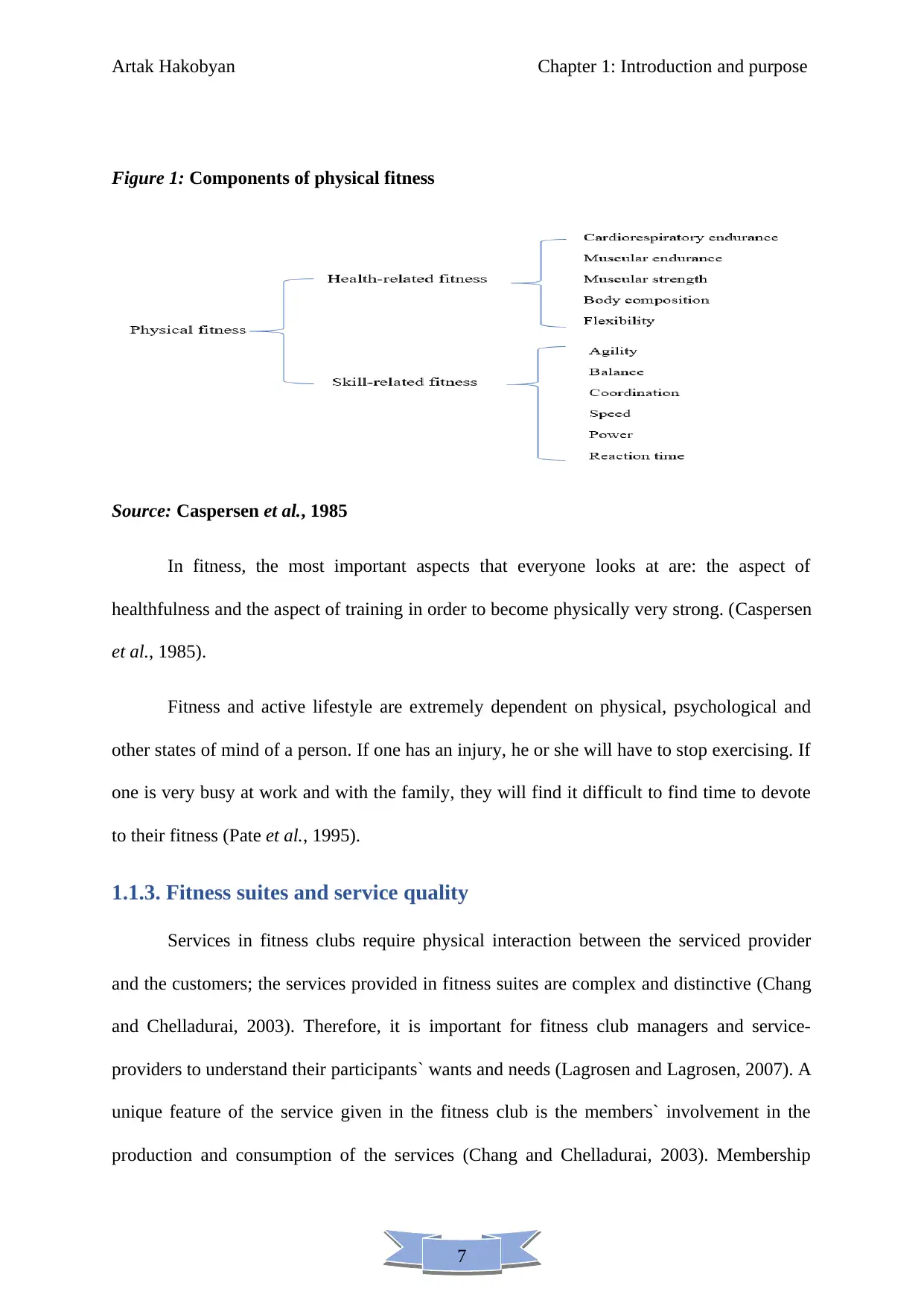
7
Artak Hakobyan Chapter 1: Introduction and purpose
Figure 1: Components of physical fitness
Source: Caspersen et al., 1985
In fitness, the most important aspects that everyone looks at are: the aspect of
healthfulness and the aspect of training in order to become physically very strong. (Caspersen
et al., 1985).
Fitness and active lifestyle are extremely dependent on physical, psychological and
other states of mind of a person. If one has an injury, he or she will have to stop exercising. If
one is very busy at work and with the family, they will find it difficult to find time to devote
to their fitness (Pate et al., 1995).
1.1.3. Fitness suites and service quality
Services in fitness clubs require physical interaction between the serviced provider
and the customers; the services provided in fitness suites are complex and distinctive (Chang
and Chelladurai, 2003). Therefore, it is important for fitness club managers and service-
providers to understand their participants` wants and needs (Lagrosen and Lagrosen, 2007). A
unique feature of the service given in the fitness club is the members` involvement in the
production and consumption of the services (Chang and Chelladurai, 2003). Membership
Artak Hakobyan Chapter 1: Introduction and purpose
Figure 1: Components of physical fitness
Source: Caspersen et al., 1985
In fitness, the most important aspects that everyone looks at are: the aspect of
healthfulness and the aspect of training in order to become physically very strong. (Caspersen
et al., 1985).
Fitness and active lifestyle are extremely dependent on physical, psychological and
other states of mind of a person. If one has an injury, he or she will have to stop exercising. If
one is very busy at work and with the family, they will find it difficult to find time to devote
to their fitness (Pate et al., 1995).
1.1.3. Fitness suites and service quality
Services in fitness clubs require physical interaction between the serviced provider
and the customers; the services provided in fitness suites are complex and distinctive (Chang
and Chelladurai, 2003). Therefore, it is important for fitness club managers and service-
providers to understand their participants` wants and needs (Lagrosen and Lagrosen, 2007). A
unique feature of the service given in the fitness club is the members` involvement in the
production and consumption of the services (Chang and Chelladurai, 2003). Membership
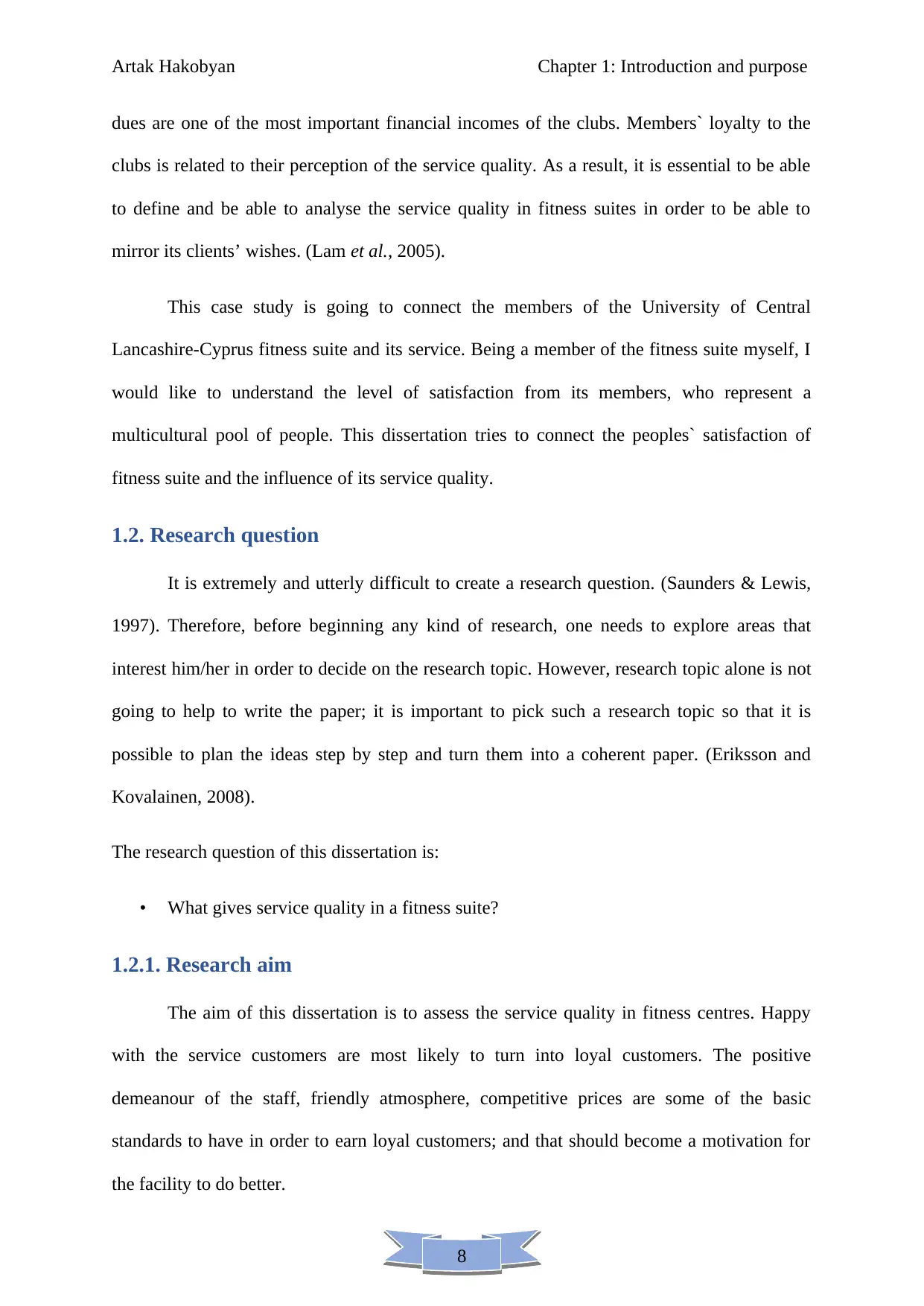
8
Artak Hakobyan Chapter 1: Introduction and purpose
dues are one of the most important financial incomes of the clubs. Members` loyalty to the
clubs is related to their perception of the service quality. As a result, it is essential to be able
to define and be able to analyse the service quality in fitness suites in order to be able to
mirror its clients’ wishes. (Lam et al., 2005).
This case study is going to connect the members of the University of Central
Lancashire-Cyprus fitness suite and its service. Being a member of the fitness suite myself, I
would like to understand the level of satisfaction from its members, who represent a
multicultural pool of people. This dissertation tries to connect the peoples` satisfaction of
fitness suite and the influence of its service quality.
1.2. Research question
It is extremely and utterly difficult to create a research question. (Saunders & Lewis,
1997). Therefore, before beginning any kind of research, one needs to explore areas that
interest him/her in order to decide on the research topic. However, research topic alone is not
going to help to write the paper; it is important to pick such a research topic so that it is
possible to plan the ideas step by step and turn them into a coherent paper. (Eriksson and
Kovalainen, 2008).
The research question of this dissertation is:
• What gives service quality in a fitness suite?
1.2.1. Research aim
The aim of this dissertation is to assess the service quality in fitness centres. Happy
with the service customers are most likely to turn into loyal customers. The positive
demeanour of the staff, friendly atmosphere, competitive prices are some of the basic
standards to have in order to earn loyal customers; and that should become a motivation for
the facility to do better.
Artak Hakobyan Chapter 1: Introduction and purpose
dues are one of the most important financial incomes of the clubs. Members` loyalty to the
clubs is related to their perception of the service quality. As a result, it is essential to be able
to define and be able to analyse the service quality in fitness suites in order to be able to
mirror its clients’ wishes. (Lam et al., 2005).
This case study is going to connect the members of the University of Central
Lancashire-Cyprus fitness suite and its service. Being a member of the fitness suite myself, I
would like to understand the level of satisfaction from its members, who represent a
multicultural pool of people. This dissertation tries to connect the peoples` satisfaction of
fitness suite and the influence of its service quality.
1.2. Research question
It is extremely and utterly difficult to create a research question. (Saunders & Lewis,
1997). Therefore, before beginning any kind of research, one needs to explore areas that
interest him/her in order to decide on the research topic. However, research topic alone is not
going to help to write the paper; it is important to pick such a research topic so that it is
possible to plan the ideas step by step and turn them into a coherent paper. (Eriksson and
Kovalainen, 2008).
The research question of this dissertation is:
• What gives service quality in a fitness suite?
1.2.1. Research aim
The aim of this dissertation is to assess the service quality in fitness centres. Happy
with the service customers are most likely to turn into loyal customers. The positive
demeanour of the staff, friendly atmosphere, competitive prices are some of the basic
standards to have in order to earn loyal customers; and that should become a motivation for
the facility to do better.
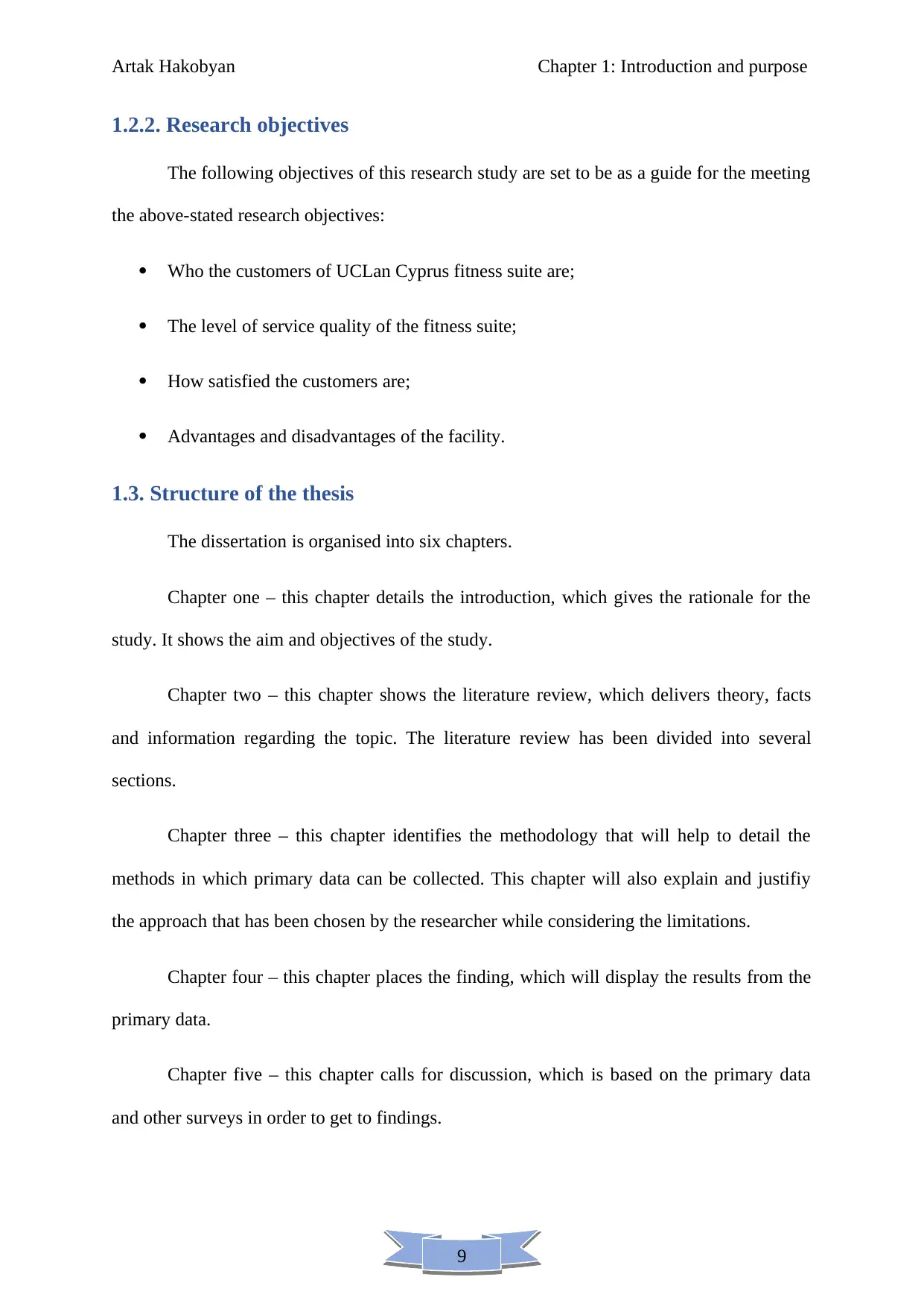
9
Artak Hakobyan Chapter 1: Introduction and purpose
1.2.2. Research objectives
The following objectives of this research study are set to be as a guide for the meeting
the above-stated research objectives:
Who the customers of UCLan Cyprus fitness suite are;
The level of service quality of the fitness suite;
How satisfied the customers are;
Advantages and disadvantages of the facility.
1.3. Structure of the thesis
The dissertation is organised into six chapters.
Chapter one – this chapter details the introduction, which gives the rationale for the
study. It shows the aim and objectives of the study.
Chapter two – this chapter shows the literature review, which delivers theory, facts
and information regarding the topic. The literature review has been divided into several
sections.
Chapter three – this chapter identifies the methodology that will help to detail the
methods in which primary data can be collected. This chapter will also explain and justifiy
the approach that has been chosen by the researcher while considering the limitations.
Chapter four – this chapter places the finding, which will display the results from the
primary data.
Chapter five – this chapter calls for discussion, which is based on the primary data
and other surveys in order to get to findings.
Artak Hakobyan Chapter 1: Introduction and purpose
1.2.2. Research objectives
The following objectives of this research study are set to be as a guide for the meeting
the above-stated research objectives:
Who the customers of UCLan Cyprus fitness suite are;
The level of service quality of the fitness suite;
How satisfied the customers are;
Advantages and disadvantages of the facility.
1.3. Structure of the thesis
The dissertation is organised into six chapters.
Chapter one – this chapter details the introduction, which gives the rationale for the
study. It shows the aim and objectives of the study.
Chapter two – this chapter shows the literature review, which delivers theory, facts
and information regarding the topic. The literature review has been divided into several
sections.
Chapter three – this chapter identifies the methodology that will help to detail the
methods in which primary data can be collected. This chapter will also explain and justifiy
the approach that has been chosen by the researcher while considering the limitations.
Chapter four – this chapter places the finding, which will display the results from the
primary data.
Chapter five – this chapter calls for discussion, which is based on the primary data
and other surveys in order to get to findings.
Secure Best Marks with AI Grader
Need help grading? Try our AI Grader for instant feedback on your assignments.

10
Artak Hakobyan Chapter 1: Introduction and purpose
Chapter six - this chapter shows the conclusion and recommendations, which will
summarise the main finding from the both research methods providing with
recommendations for future research.
Artak Hakobyan Chapter 1: Introduction and purpose
Chapter six - this chapter shows the conclusion and recommendations, which will
summarise the main finding from the both research methods providing with
recommendations for future research.
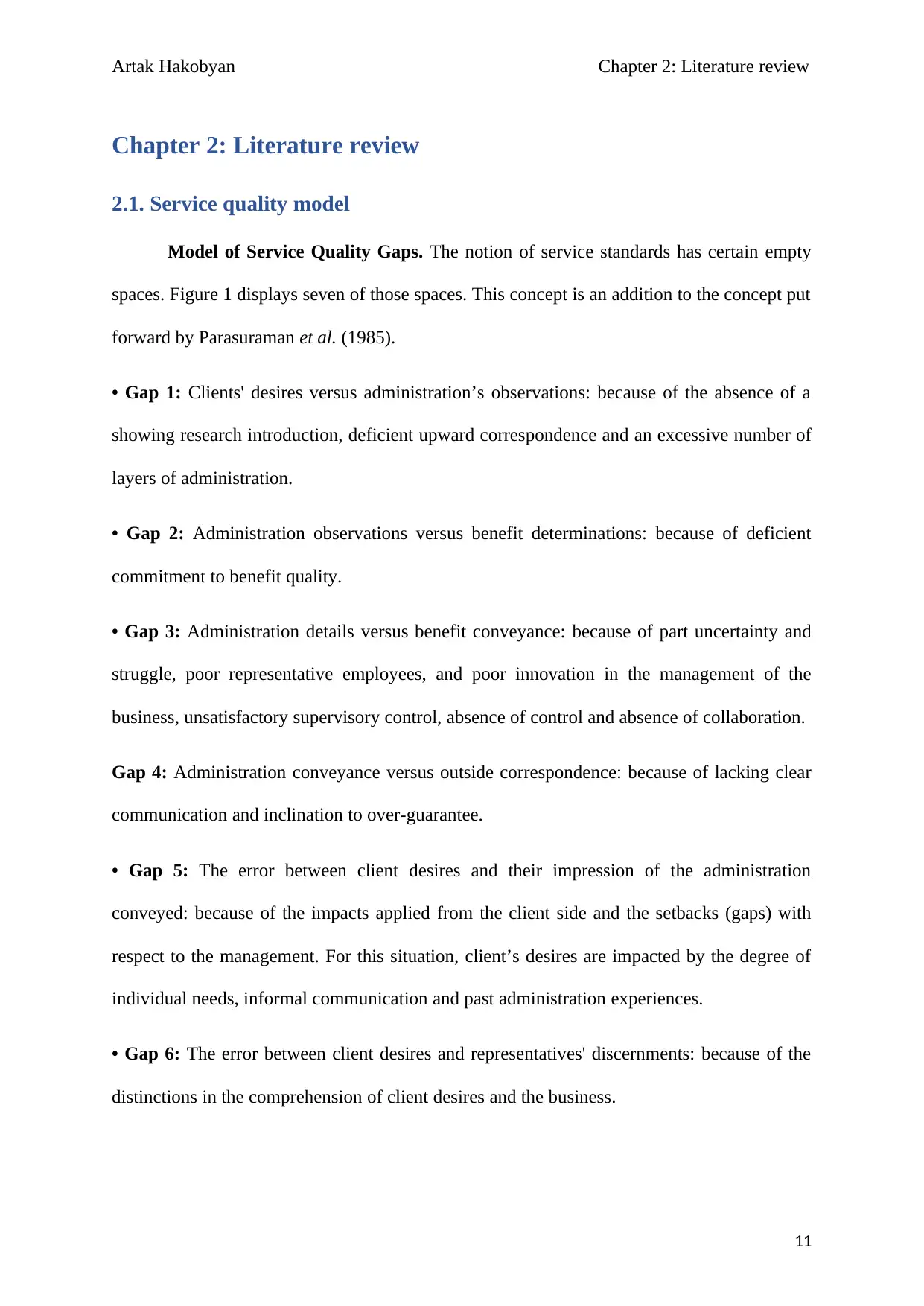
Artak Hakobyan Chapter 2: Literature review
Chapter 2: Literature review
2.1. Service quality model
Model of Service Quality Gaps. The notion of service standards has certain empty
spaces. Figure 1 displays seven of those spaces. This concept is an addition to the concept put
forward by Parasuraman et al. (1985).
• Gap 1: Clients' desires versus administration’s observations: because of the absence of a
showing research introduction, deficient upward correspondence and an excessive number of
layers of administration.
• Gap 2: Administration observations versus benefit determinations: because of deficient
commitment to benefit quality.
• Gap 3: Administration details versus benefit conveyance: because of part uncertainty and
struggle, poor representative employees, and poor innovation in the management of the
business, unsatisfactory supervisory control, absence of control and absence of collaboration.
Gap 4: Administration conveyance versus outside correspondence: because of lacking clear
communication and inclination to over-guarantee.
• Gap 5: The error between client desires and their impression of the administration
conveyed: because of the impacts applied from the client side and the setbacks (gaps) with
respect to the management. For this situation, client’s desires are impacted by the degree of
individual needs, informal communication and past administration experiences.
• Gap 6: The error between client desires and representatives' discernments: because of the
distinctions in the comprehension of client desires and the business.
11
Chapter 2: Literature review
2.1. Service quality model
Model of Service Quality Gaps. The notion of service standards has certain empty
spaces. Figure 1 displays seven of those spaces. This concept is an addition to the concept put
forward by Parasuraman et al. (1985).
• Gap 1: Clients' desires versus administration’s observations: because of the absence of a
showing research introduction, deficient upward correspondence and an excessive number of
layers of administration.
• Gap 2: Administration observations versus benefit determinations: because of deficient
commitment to benefit quality.
• Gap 3: Administration details versus benefit conveyance: because of part uncertainty and
struggle, poor representative employees, and poor innovation in the management of the
business, unsatisfactory supervisory control, absence of control and absence of collaboration.
Gap 4: Administration conveyance versus outside correspondence: because of lacking clear
communication and inclination to over-guarantee.
• Gap 5: The error between client desires and their impression of the administration
conveyed: because of the impacts applied from the client side and the setbacks (gaps) with
respect to the management. For this situation, client’s desires are impacted by the degree of
individual needs, informal communication and past administration experiences.
• Gap 6: The error between client desires and representatives' discernments: because of the
distinctions in the comprehension of client desires and the business.
11
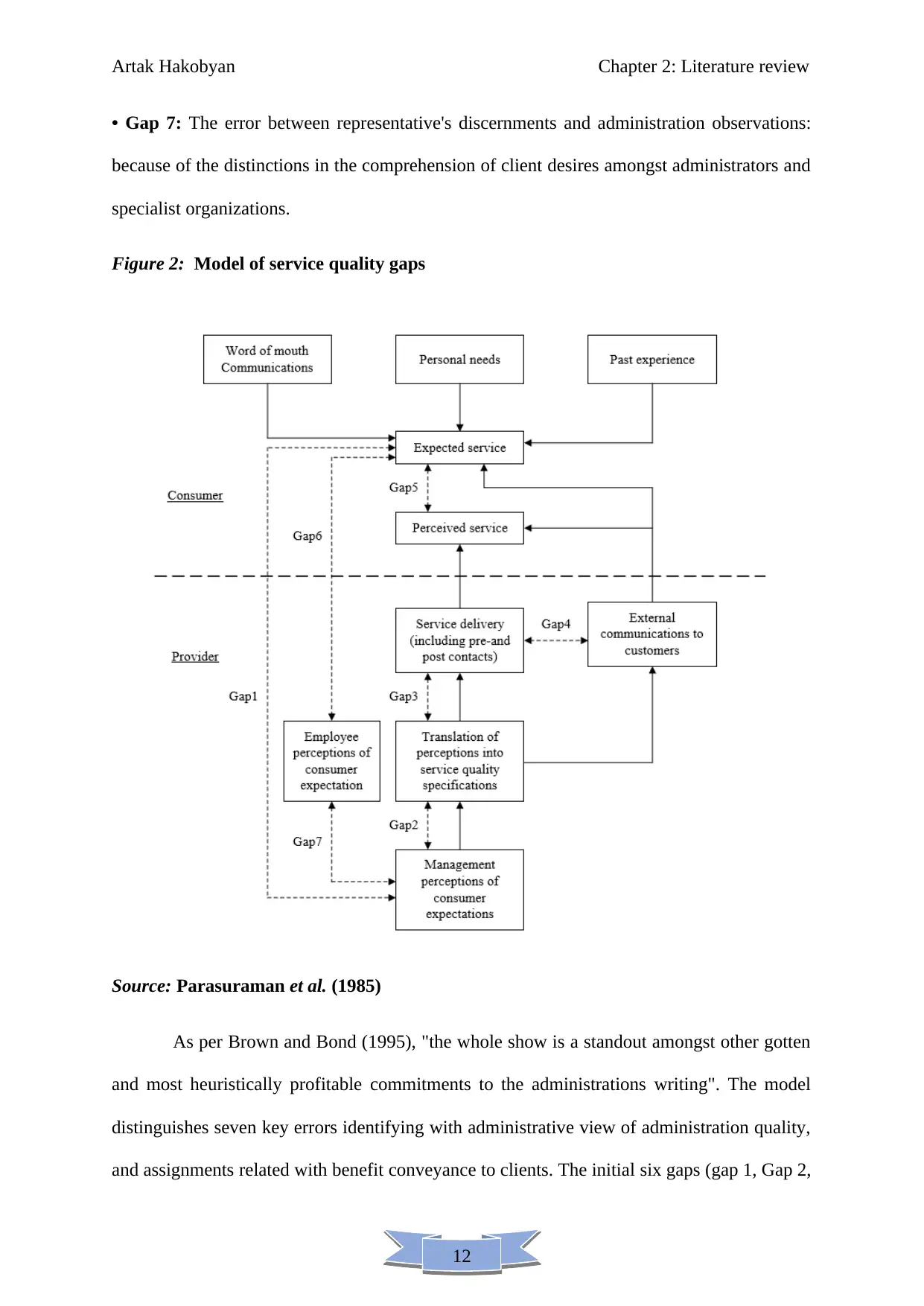
12
Artak Hakobyan Chapter 2: Literature review
• Gap 7: The error between representative's discernments and administration observations:
because of the distinctions in the comprehension of client desires amongst administrators and
specialist organizations.
Figure 2: Model of service quality gaps
Source: Parasuraman et al. (1985)
As per Brown and Bond (1995), "the whole show is a standout amongst other gotten
and most heuristically profitable commitments to the administrations writing". The model
distinguishes seven key errors identifying with administrative view of administration quality,
and assignments related with benefit conveyance to clients. The initial six gaps (gap 1, Gap 2,
Artak Hakobyan Chapter 2: Literature review
• Gap 7: The error between representative's discernments and administration observations:
because of the distinctions in the comprehension of client desires amongst administrators and
specialist organizations.
Figure 2: Model of service quality gaps
Source: Parasuraman et al. (1985)
As per Brown and Bond (1995), "the whole show is a standout amongst other gotten
and most heuristically profitable commitments to the administrations writing". The model
distinguishes seven key errors identifying with administrative view of administration quality,
and assignments related with benefit conveyance to clients. The initial six gaps (gap 1, Gap 2,
Paraphrase This Document
Need a fresh take? Get an instant paraphrase of this document with our AI Paraphraser
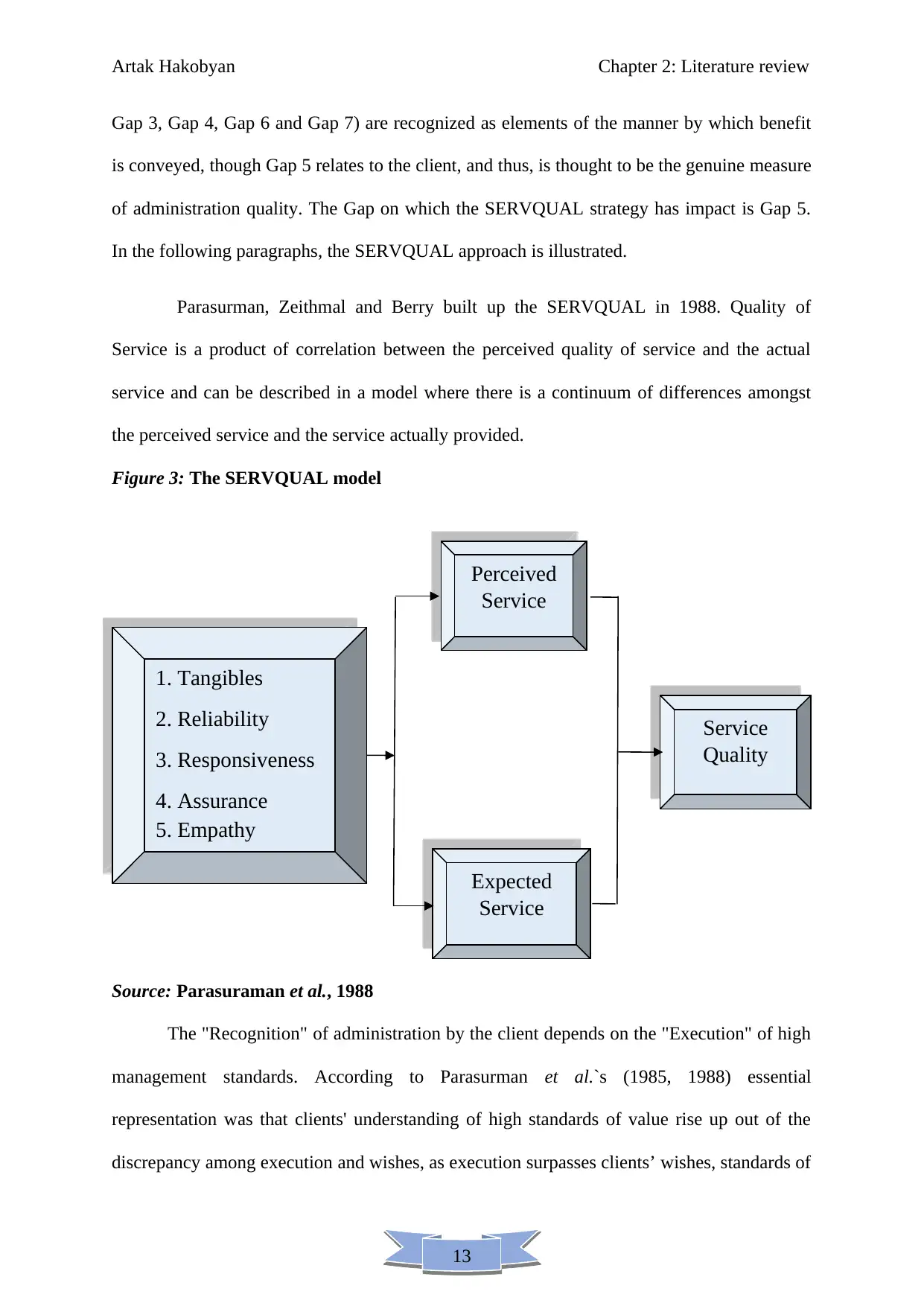
13
Artak Hakobyan Chapter 2: Literature review
Gap 3, Gap 4, Gap 6 and Gap 7) are recognized as elements of the manner by which benefit
is conveyed, though Gap 5 relates to the client, and thus, is thought to be the genuine measure
of administration quality. The Gap on which the SERVQUAL strategy has impact is Gap 5.
In the following paragraphs, the SERVQUAL approach is illustrated.
Parasurman, Zeithmal and Berry built up the SERVQUAL in 1988. Quality of
Service is a product of correlation between the perceived quality of service and the actual
service and can be described in a model where there is a continuum of differences amongst
the perceived service and the service actually provided.
Figure 3: The SERVQUAL model
Source: Parasuraman et al., 1988
The "Recognition" of administration by the client depends on the "Execution" of high
management standards. According to Parasurman et al.`s (1985, 1988) essential
representation was that clients' understanding of high standards of value rise up out of the
discrepancy among execution and wishes, as execution surpasses clients’ wishes, standards of
1. Tangibles
2. Reliability
3. Responsiveness
4. Assurance
5. Empathy
Perceived
Service
Expected
Service
Service
Quality
Artak Hakobyan Chapter 2: Literature review
Gap 3, Gap 4, Gap 6 and Gap 7) are recognized as elements of the manner by which benefit
is conveyed, though Gap 5 relates to the client, and thus, is thought to be the genuine measure
of administration quality. The Gap on which the SERVQUAL strategy has impact is Gap 5.
In the following paragraphs, the SERVQUAL approach is illustrated.
Parasurman, Zeithmal and Berry built up the SERVQUAL in 1988. Quality of
Service is a product of correlation between the perceived quality of service and the actual
service and can be described in a model where there is a continuum of differences amongst
the perceived service and the service actually provided.
Figure 3: The SERVQUAL model
Source: Parasuraman et al., 1988
The "Recognition" of administration by the client depends on the "Execution" of high
management standards. According to Parasurman et al.`s (1985, 1988) essential
representation was that clients' understanding of high standards of value rise up out of the
discrepancy among execution and wishes, as execution surpasses clients’ wishes, standards of
1. Tangibles
2. Reliability
3. Responsiveness
4. Assurance
5. Empathy
Perceived
Service
Expected
Service
Service
Quality
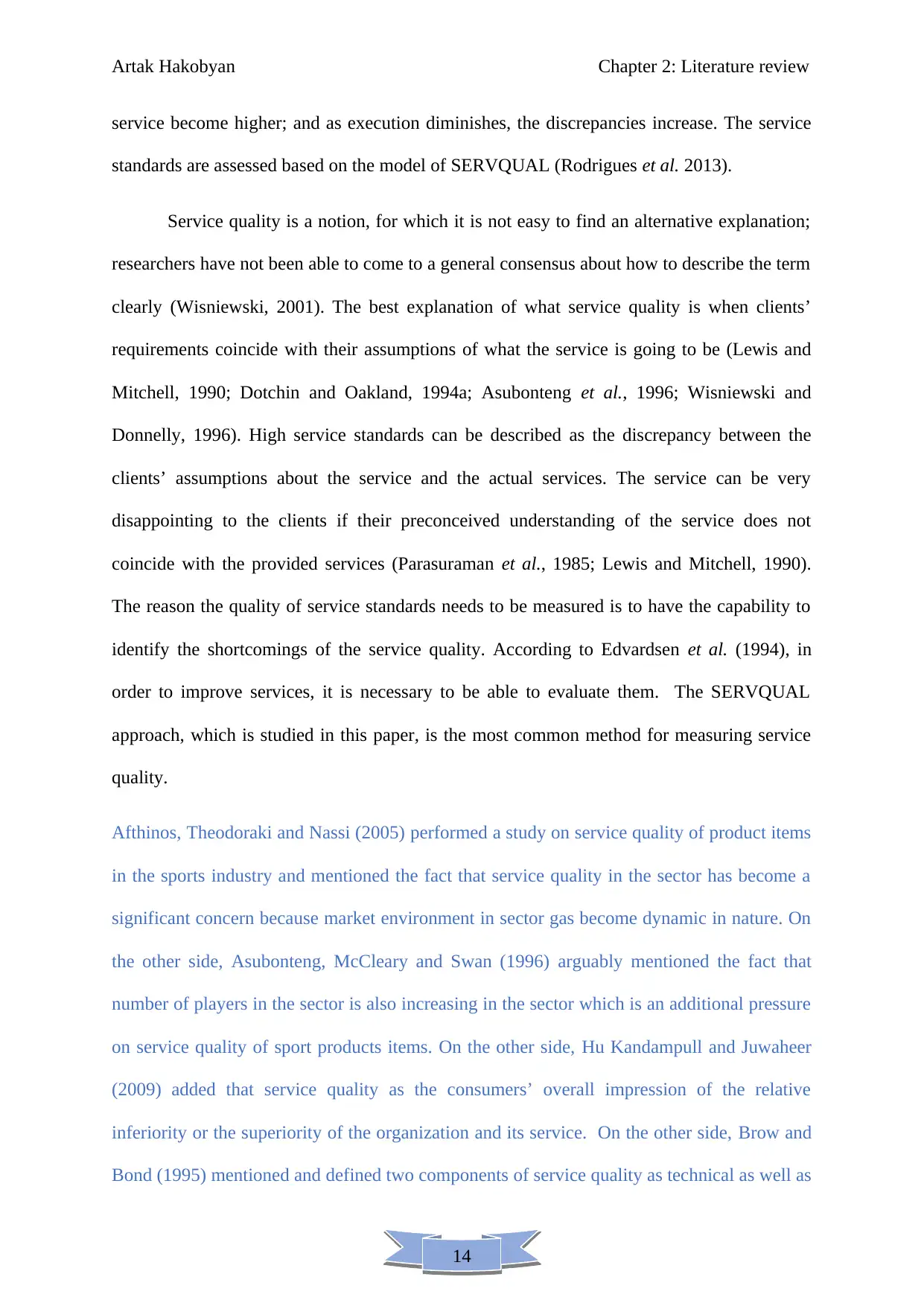
14
Artak Hakobyan Chapter 2: Literature review
service become higher; and as execution diminishes, the discrepancies increase. The service
standards are assessed based on the model of SERVQUAL (Rodrigues et al. 2013).
Service quality is a notion, for which it is not easy to find an alternative explanation;
researchers have not been able to come to a general consensus about how to describe the term
clearly (Wisniewski, 2001). The best explanation of what service quality is when clients’
requirements coincide with their assumptions of what the service is going to be (Lewis and
Mitchell, 1990; Dotchin and Oakland, 1994a; Asubonteng et al., 1996; Wisniewski and
Donnelly, 1996). High service standards can be described as the discrepancy between the
clients’ assumptions about the service and the actual services. The service can be very
disappointing to the clients if their preconceived understanding of the service does not
coincide with the provided services (Parasuraman et al., 1985; Lewis and Mitchell, 1990).
The reason the quality of service standards needs to be measured is to have the capability to
identify the shortcomings of the service quality. According to Edvardsen et al. (1994), in
order to improve services, it is necessary to be able to evaluate them. The SERVQUAL
approach, which is studied in this paper, is the most common method for measuring service
quality.
Afthinos, Theodoraki and Nassi (2005) performed a study on service quality of product items
in the sports industry and mentioned the fact that service quality in the sector has become a
significant concern because market environment in sector gas become dynamic in nature. On
the other side, Asubonteng, McCleary and Swan (1996) arguably mentioned the fact that
number of players in the sector is also increasing in the sector which is an additional pressure
on service quality of sport products items. On the other side, Hu Kandampull and Juwaheer
(2009) added that service quality as the consumers’ overall impression of the relative
inferiority or the superiority of the organization and its service. On the other side, Brow and
Bond (1995) mentioned and defined two components of service quality as technical as well as
Artak Hakobyan Chapter 2: Literature review
service become higher; and as execution diminishes, the discrepancies increase. The service
standards are assessed based on the model of SERVQUAL (Rodrigues et al. 2013).
Service quality is a notion, for which it is not easy to find an alternative explanation;
researchers have not been able to come to a general consensus about how to describe the term
clearly (Wisniewski, 2001). The best explanation of what service quality is when clients’
requirements coincide with their assumptions of what the service is going to be (Lewis and
Mitchell, 1990; Dotchin and Oakland, 1994a; Asubonteng et al., 1996; Wisniewski and
Donnelly, 1996). High service standards can be described as the discrepancy between the
clients’ assumptions about the service and the actual services. The service can be very
disappointing to the clients if their preconceived understanding of the service does not
coincide with the provided services (Parasuraman et al., 1985; Lewis and Mitchell, 1990).
The reason the quality of service standards needs to be measured is to have the capability to
identify the shortcomings of the service quality. According to Edvardsen et al. (1994), in
order to improve services, it is necessary to be able to evaluate them. The SERVQUAL
approach, which is studied in this paper, is the most common method for measuring service
quality.
Afthinos, Theodoraki and Nassi (2005) performed a study on service quality of product items
in the sports industry and mentioned the fact that service quality in the sector has become a
significant concern because market environment in sector gas become dynamic in nature. On
the other side, Asubonteng, McCleary and Swan (1996) arguably mentioned the fact that
number of players in the sector is also increasing in the sector which is an additional pressure
on service quality of sport products items. On the other side, Hu Kandampull and Juwaheer
(2009) added that service quality as the consumers’ overall impression of the relative
inferiority or the superiority of the organization and its service. On the other side, Brow and
Bond (1995) mentioned and defined two components of service quality as technical as well as
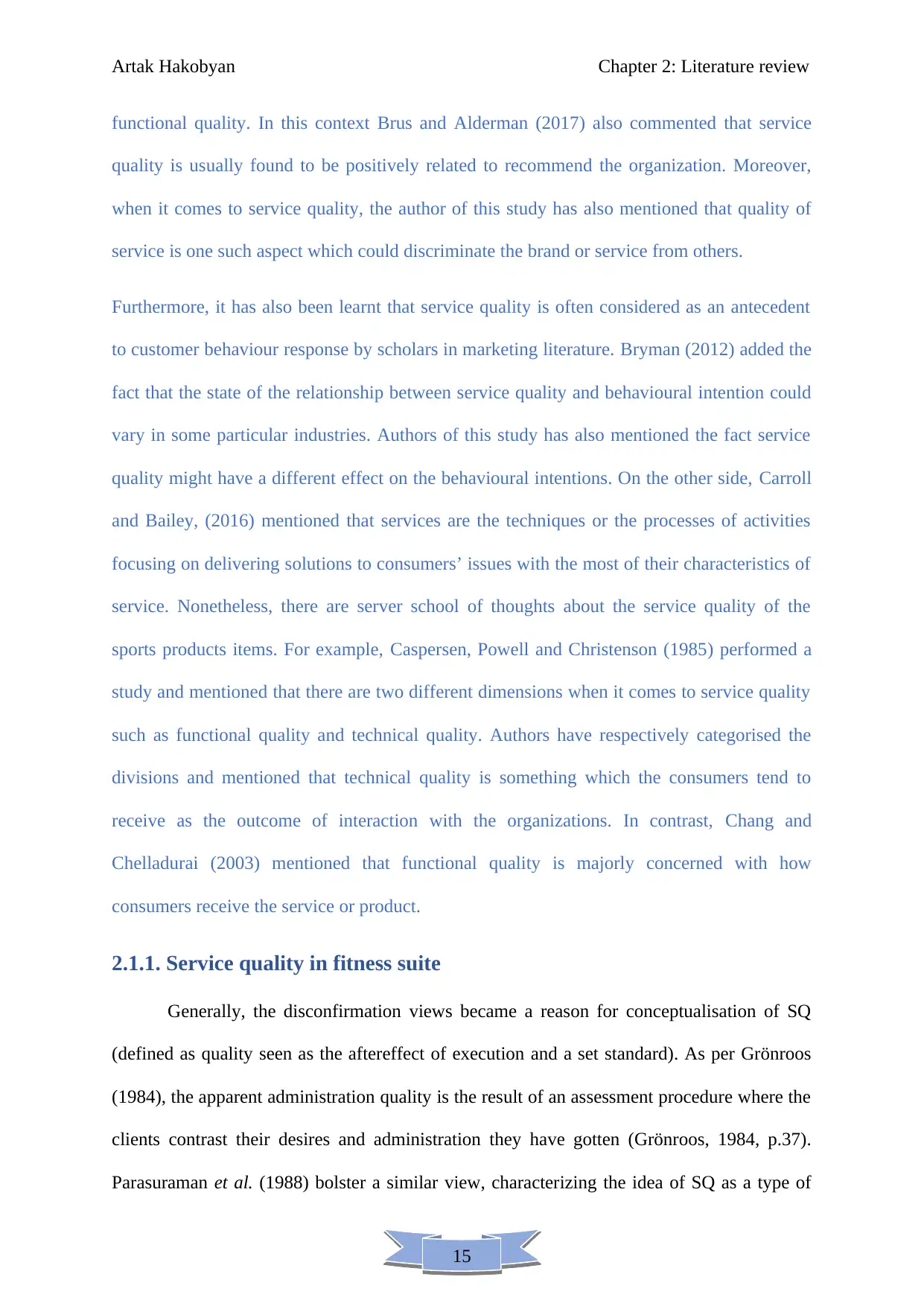
15
Artak Hakobyan Chapter 2: Literature review
functional quality. In this context Brus and Alderman (2017) also commented that service
quality is usually found to be positively related to recommend the organization. Moreover,
when it comes to service quality, the author of this study has also mentioned that quality of
service is one such aspect which could discriminate the brand or service from others.
Furthermore, it has also been learnt that service quality is often considered as an antecedent
to customer behaviour response by scholars in marketing literature. Bryman (2012) added the
fact that the state of the relationship between service quality and behavioural intention could
vary in some particular industries. Authors of this study has also mentioned the fact service
quality might have a different effect on the behavioural intentions. On the other side, Carroll
and Bailey, (2016) mentioned that services are the techniques or the processes of activities
focusing on delivering solutions to consumers’ issues with the most of their characteristics of
service. Nonetheless, there are server school of thoughts about the service quality of the
sports products items. For example, Caspersen, Powell and Christenson (1985) performed a
study and mentioned that there are two different dimensions when it comes to service quality
such as functional quality and technical quality. Authors have respectively categorised the
divisions and mentioned that technical quality is something which the consumers tend to
receive as the outcome of interaction with the organizations. In contrast, Chang and
Chelladurai (2003) mentioned that functional quality is majorly concerned with how
consumers receive the service or product.
2.1.1. Service quality in fitness suite
Generally, the disconfirmation views became a reason for conceptualisation of SQ
(defined as quality seen as the aftereffect of execution and a set standard). As per Grönroos
(1984), the apparent administration quality is the result of an assessment procedure where the
clients contrast their desires and administration they have gotten (Grönroos, 1984, p.37).
Parasuraman et al. (1988) bolster a similar view, characterizing the idea of SQ as a type of
Artak Hakobyan Chapter 2: Literature review
functional quality. In this context Brus and Alderman (2017) also commented that service
quality is usually found to be positively related to recommend the organization. Moreover,
when it comes to service quality, the author of this study has also mentioned that quality of
service is one such aspect which could discriminate the brand or service from others.
Furthermore, it has also been learnt that service quality is often considered as an antecedent
to customer behaviour response by scholars in marketing literature. Bryman (2012) added the
fact that the state of the relationship between service quality and behavioural intention could
vary in some particular industries. Authors of this study has also mentioned the fact service
quality might have a different effect on the behavioural intentions. On the other side, Carroll
and Bailey, (2016) mentioned that services are the techniques or the processes of activities
focusing on delivering solutions to consumers’ issues with the most of their characteristics of
service. Nonetheless, there are server school of thoughts about the service quality of the
sports products items. For example, Caspersen, Powell and Christenson (1985) performed a
study and mentioned that there are two different dimensions when it comes to service quality
such as functional quality and technical quality. Authors have respectively categorised the
divisions and mentioned that technical quality is something which the consumers tend to
receive as the outcome of interaction with the organizations. In contrast, Chang and
Chelladurai (2003) mentioned that functional quality is majorly concerned with how
consumers receive the service or product.
2.1.1. Service quality in fitness suite
Generally, the disconfirmation views became a reason for conceptualisation of SQ
(defined as quality seen as the aftereffect of execution and a set standard). As per Grönroos
(1984), the apparent administration quality is the result of an assessment procedure where the
clients contrast their desires and administration they have gotten (Grönroos, 1984, p.37).
Parasuraman et al. (1988) bolster a similar view, characterizing the idea of SQ as a type of
Secure Best Marks with AI Grader
Need help grading? Try our AI Grader for instant feedback on your assignments.
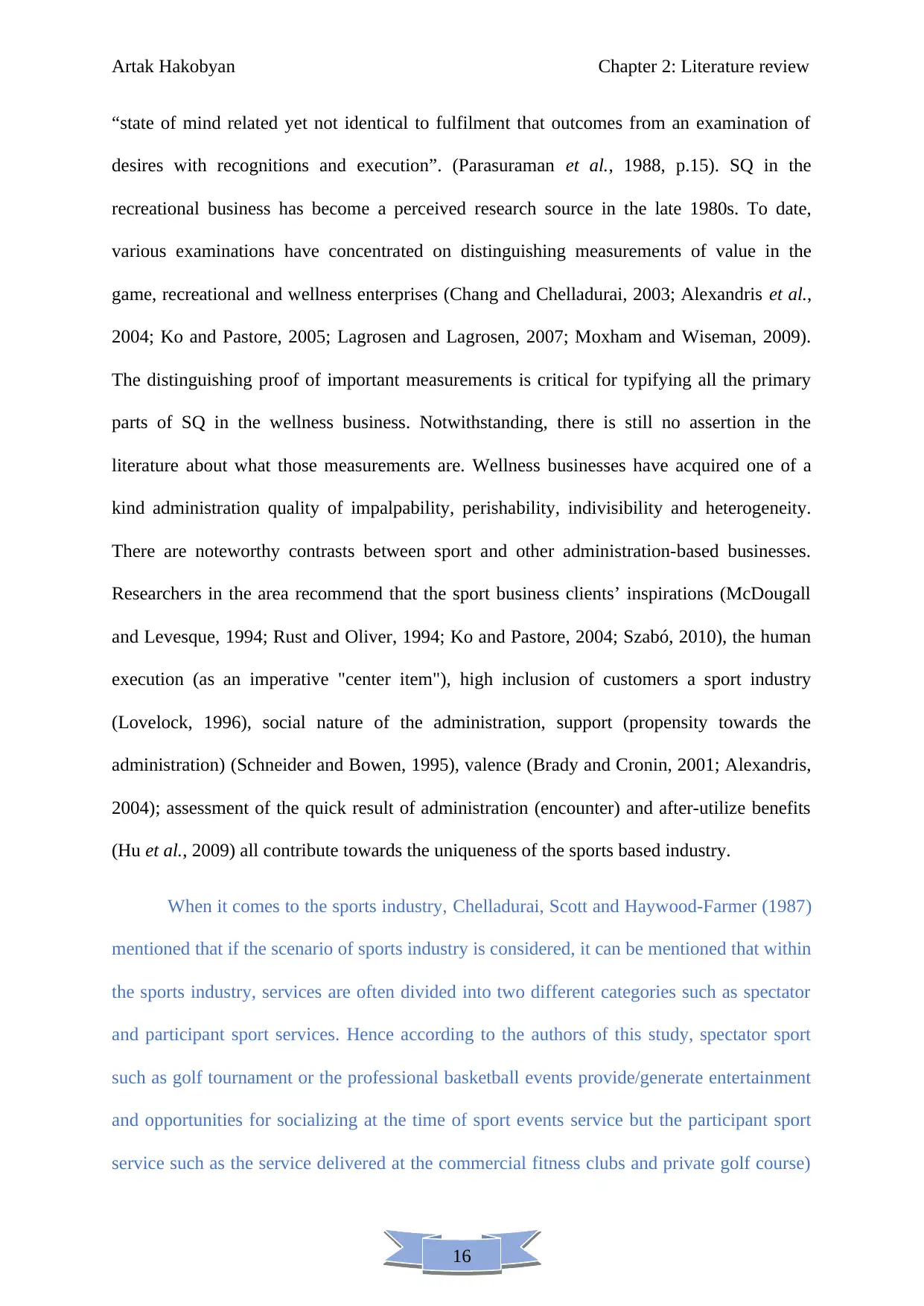
16
Artak Hakobyan Chapter 2: Literature review
“state of mind related yet not identical to fulfilment that outcomes from an examination of
desires with recognitions and execution”. (Parasuraman et al., 1988, p.15). SQ in the
recreational business has become a perceived research source in the late 1980s. To date,
various examinations have concentrated on distinguishing measurements of value in the
game, recreational and wellness enterprises (Chang and Chelladurai, 2003; Alexandris et al.,
2004; Ko and Pastore, 2005; Lagrosen and Lagrosen, 2007; Moxham and Wiseman, 2009).
The distinguishing proof of important measurements is critical for typifying all the primary
parts of SQ in the wellness business. Notwithstanding, there is still no assertion in the
literature about what those measurements are. Wellness businesses have acquired one of a
kind administration quality of impalpability, perishability, indivisibility and heterogeneity.
There are noteworthy contrasts between sport and other administration-based businesses.
Researchers in the area recommend that the sport business clients’ inspirations (McDougall
and Levesque, 1994; Rust and Oliver, 1994; Ko and Pastore, 2004; Szabó, 2010), the human
execution (as an imperative "center item"), high inclusion of customers a sport industry
(Lovelock, 1996), social nature of the administration, support (propensity towards the
administration) (Schneider and Bowen, 1995), valence (Brady and Cronin, 2001; Alexandris,
2004); assessment of the quick result of administration (encounter) and after-utilize benefits
(Hu et al., 2009) all contribute towards the uniqueness of the sports based industry.
When it comes to the sports industry, Chelladurai, Scott and Haywood-Farmer (1987)
mentioned that if the scenario of sports industry is considered, it can be mentioned that within
the sports industry, services are often divided into two different categories such as spectator
and participant sport services. Hence according to the authors of this study, spectator sport
such as golf tournament or the professional basketball events provide/generate entertainment
and opportunities for socializing at the time of sport events service but the participant sport
service such as the service delivered at the commercial fitness clubs and private golf course)
Artak Hakobyan Chapter 2: Literature review
“state of mind related yet not identical to fulfilment that outcomes from an examination of
desires with recognitions and execution”. (Parasuraman et al., 1988, p.15). SQ in the
recreational business has become a perceived research source in the late 1980s. To date,
various examinations have concentrated on distinguishing measurements of value in the
game, recreational and wellness enterprises (Chang and Chelladurai, 2003; Alexandris et al.,
2004; Ko and Pastore, 2005; Lagrosen and Lagrosen, 2007; Moxham and Wiseman, 2009).
The distinguishing proof of important measurements is critical for typifying all the primary
parts of SQ in the wellness business. Notwithstanding, there is still no assertion in the
literature about what those measurements are. Wellness businesses have acquired one of a
kind administration quality of impalpability, perishability, indivisibility and heterogeneity.
There are noteworthy contrasts between sport and other administration-based businesses.
Researchers in the area recommend that the sport business clients’ inspirations (McDougall
and Levesque, 1994; Rust and Oliver, 1994; Ko and Pastore, 2004; Szabó, 2010), the human
execution (as an imperative "center item"), high inclusion of customers a sport industry
(Lovelock, 1996), social nature of the administration, support (propensity towards the
administration) (Schneider and Bowen, 1995), valence (Brady and Cronin, 2001; Alexandris,
2004); assessment of the quick result of administration (encounter) and after-utilize benefits
(Hu et al., 2009) all contribute towards the uniqueness of the sports based industry.
When it comes to the sports industry, Chelladurai, Scott and Haywood-Farmer (1987)
mentioned that if the scenario of sports industry is considered, it can be mentioned that within
the sports industry, services are often divided into two different categories such as spectator
and participant sport services. Hence according to the authors of this study, spectator sport
such as golf tournament or the professional basketball events provide/generate entertainment
and opportunities for socializing at the time of sport events service but the participant sport
service such as the service delivered at the commercial fitness clubs and private golf course)
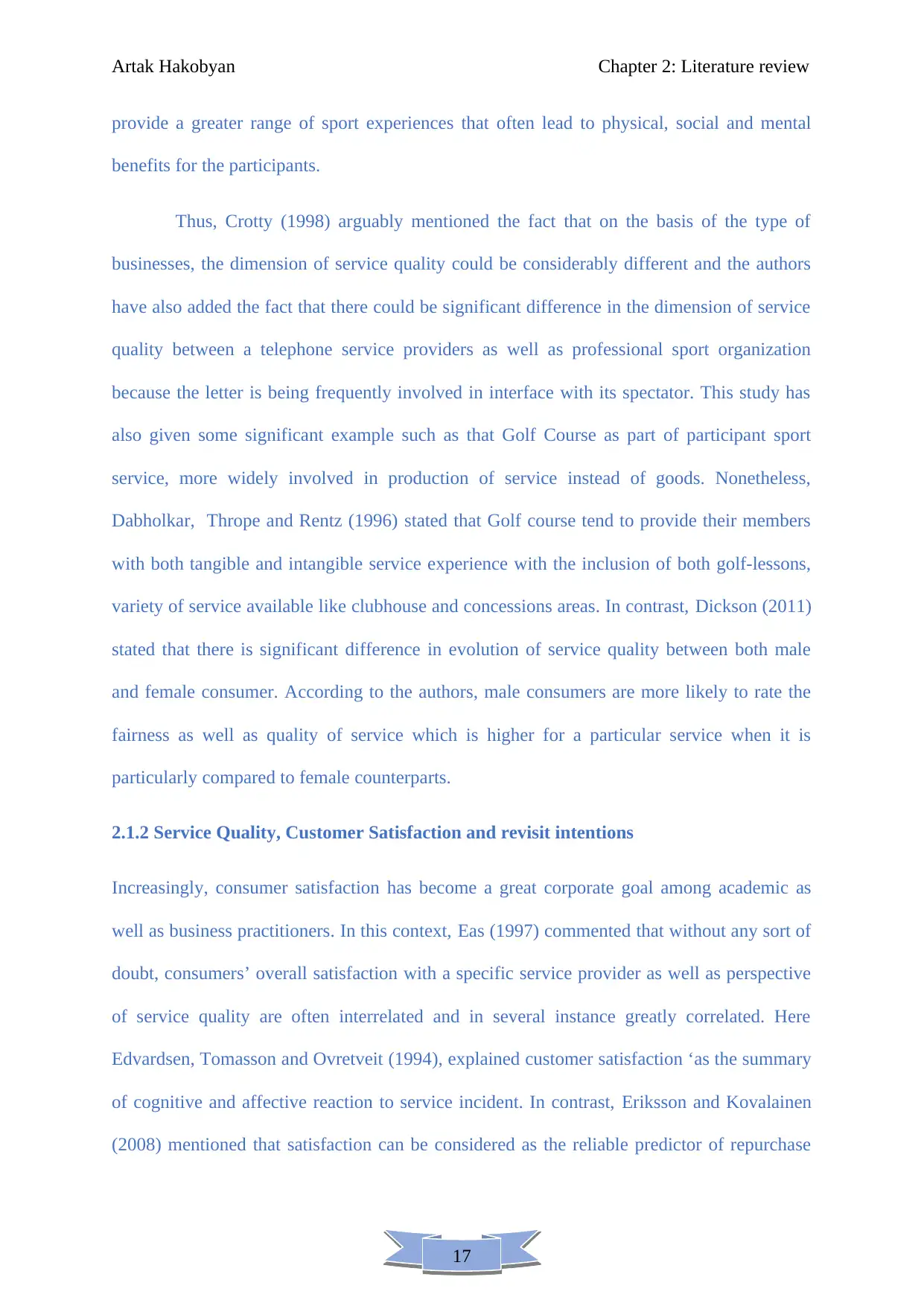
17
Artak Hakobyan Chapter 2: Literature review
provide a greater range of sport experiences that often lead to physical, social and mental
benefits for the participants.
Thus, Crotty (1998) arguably mentioned the fact that on the basis of the type of
businesses, the dimension of service quality could be considerably different and the authors
have also added the fact that there could be significant difference in the dimension of service
quality between a telephone service providers as well as professional sport organization
because the letter is being frequently involved in interface with its spectator. This study has
also given some significant example such as that Golf Course as part of participant sport
service, more widely involved in production of service instead of goods. Nonetheless,
Dabholkar, Thrope and Rentz (1996) stated that Golf course tend to provide their members
with both tangible and intangible service experience with the inclusion of both golf-lessons,
variety of service available like clubhouse and concessions areas. In contrast, Dickson (2011)
stated that there is significant difference in evolution of service quality between both male
and female consumer. According to the authors, male consumers are more likely to rate the
fairness as well as quality of service which is higher for a particular service when it is
particularly compared to female counterparts.
2.1.2 Service Quality, Customer Satisfaction and revisit intentions
Increasingly, consumer satisfaction has become a great corporate goal among academic as
well as business practitioners. In this context, Eas (1997) commented that without any sort of
doubt, consumers’ overall satisfaction with a specific service provider as well as perspective
of service quality are often interrelated and in several instance greatly correlated. Here
Edvardsen, Tomasson and Ovretveit (1994), explained customer satisfaction ‘as the summary
of cognitive and affective reaction to service incident. In contrast, Eriksson and Kovalainen
(2008) mentioned that satisfaction can be considered as the reliable predictor of repurchase
Artak Hakobyan Chapter 2: Literature review
provide a greater range of sport experiences that often lead to physical, social and mental
benefits for the participants.
Thus, Crotty (1998) arguably mentioned the fact that on the basis of the type of
businesses, the dimension of service quality could be considerably different and the authors
have also added the fact that there could be significant difference in the dimension of service
quality between a telephone service providers as well as professional sport organization
because the letter is being frequently involved in interface with its spectator. This study has
also given some significant example such as that Golf Course as part of participant sport
service, more widely involved in production of service instead of goods. Nonetheless,
Dabholkar, Thrope and Rentz (1996) stated that Golf course tend to provide their members
with both tangible and intangible service experience with the inclusion of both golf-lessons,
variety of service available like clubhouse and concessions areas. In contrast, Dickson (2011)
stated that there is significant difference in evolution of service quality between both male
and female consumer. According to the authors, male consumers are more likely to rate the
fairness as well as quality of service which is higher for a particular service when it is
particularly compared to female counterparts.
2.1.2 Service Quality, Customer Satisfaction and revisit intentions
Increasingly, consumer satisfaction has become a great corporate goal among academic as
well as business practitioners. In this context, Eas (1997) commented that without any sort of
doubt, consumers’ overall satisfaction with a specific service provider as well as perspective
of service quality are often interrelated and in several instance greatly correlated. Here
Edvardsen, Tomasson and Ovretveit (1994), explained customer satisfaction ‘as the summary
of cognitive and affective reaction to service incident. In contrast, Eriksson and Kovalainen
(2008) mentioned that satisfaction can be considered as the reliable predictor of repurchase
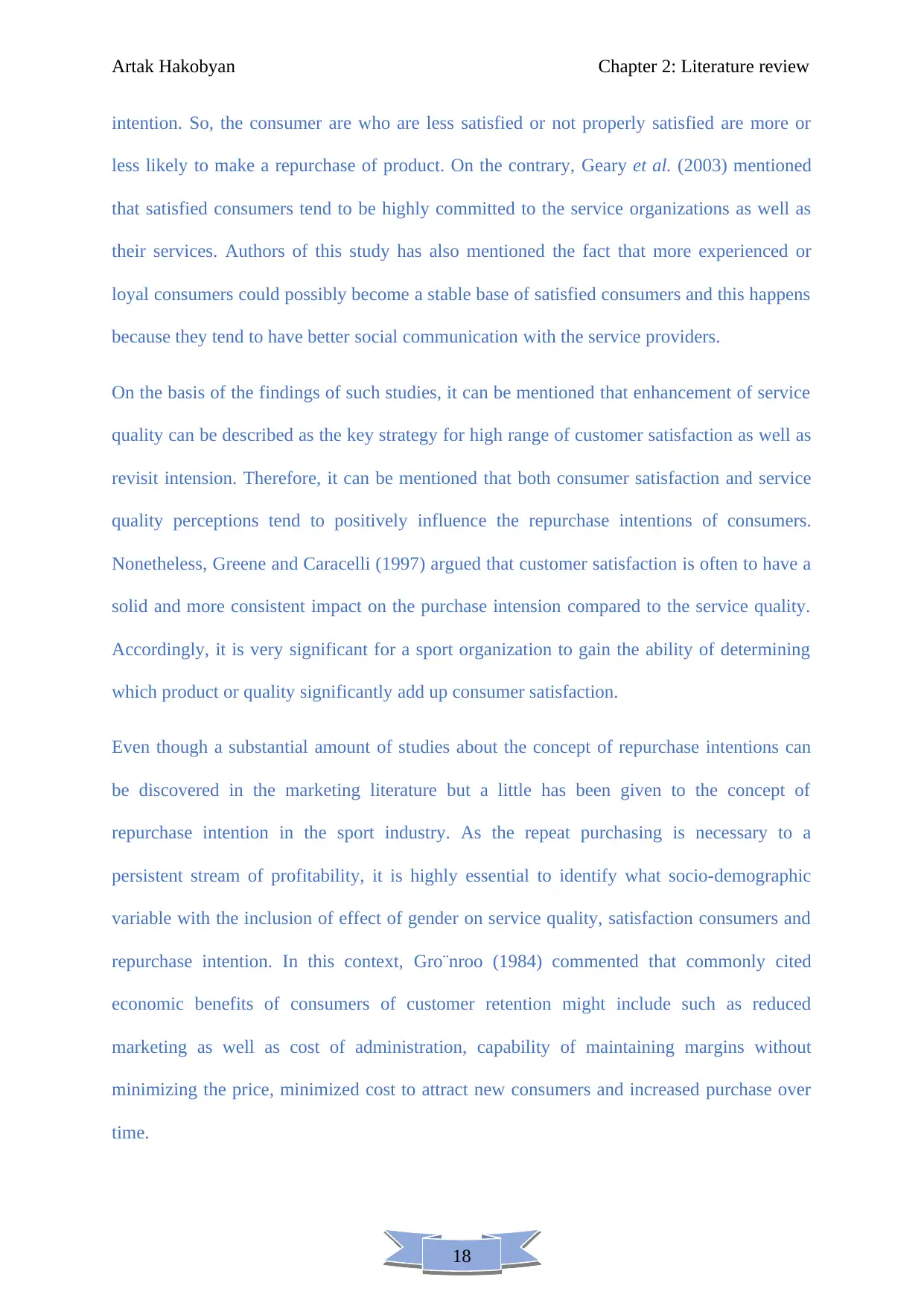
18
Artak Hakobyan Chapter 2: Literature review
intention. So, the consumer are who are less satisfied or not properly satisfied are more or
less likely to make a repurchase of product. On the contrary, Geary et al. (2003) mentioned
that satisfied consumers tend to be highly committed to the service organizations as well as
their services. Authors of this study has also mentioned the fact that more experienced or
loyal consumers could possibly become a stable base of satisfied consumers and this happens
because they tend to have better social communication with the service providers.
On the basis of the findings of such studies, it can be mentioned that enhancement of service
quality can be described as the key strategy for high range of customer satisfaction as well as
revisit intension. Therefore, it can be mentioned that both consumer satisfaction and service
quality perceptions tend to positively influence the repurchase intentions of consumers.
Nonetheless, Greene and Caracelli (1997) argued that customer satisfaction is often to have a
solid and more consistent impact on the purchase intension compared to the service quality.
Accordingly, it is very significant for a sport organization to gain the ability of determining
which product or quality significantly add up consumer satisfaction.
Even though a substantial amount of studies about the concept of repurchase intentions can
be discovered in the marketing literature but a little has been given to the concept of
repurchase intention in the sport industry. As the repeat purchasing is necessary to a
persistent stream of profitability, it is highly essential to identify what socio-demographic
variable with the inclusion of effect of gender on service quality, satisfaction consumers and
repurchase intention. In this context, Gro¨nroo (1984) commented that commonly cited
economic benefits of consumers of customer retention might include such as reduced
marketing as well as cost of administration, capability of maintaining margins without
minimizing the price, minimized cost to attract new consumers and increased purchase over
time.
Artak Hakobyan Chapter 2: Literature review
intention. So, the consumer are who are less satisfied or not properly satisfied are more or
less likely to make a repurchase of product. On the contrary, Geary et al. (2003) mentioned
that satisfied consumers tend to be highly committed to the service organizations as well as
their services. Authors of this study has also mentioned the fact that more experienced or
loyal consumers could possibly become a stable base of satisfied consumers and this happens
because they tend to have better social communication with the service providers.
On the basis of the findings of such studies, it can be mentioned that enhancement of service
quality can be described as the key strategy for high range of customer satisfaction as well as
revisit intension. Therefore, it can be mentioned that both consumer satisfaction and service
quality perceptions tend to positively influence the repurchase intentions of consumers.
Nonetheless, Greene and Caracelli (1997) argued that customer satisfaction is often to have a
solid and more consistent impact on the purchase intension compared to the service quality.
Accordingly, it is very significant for a sport organization to gain the ability of determining
which product or quality significantly add up consumer satisfaction.
Even though a substantial amount of studies about the concept of repurchase intentions can
be discovered in the marketing literature but a little has been given to the concept of
repurchase intention in the sport industry. As the repeat purchasing is necessary to a
persistent stream of profitability, it is highly essential to identify what socio-demographic
variable with the inclusion of effect of gender on service quality, satisfaction consumers and
repurchase intention. In this context, Gro¨nroo (1984) commented that commonly cited
economic benefits of consumers of customer retention might include such as reduced
marketing as well as cost of administration, capability of maintaining margins without
minimizing the price, minimized cost to attract new consumers and increased purchase over
time.
Paraphrase This Document
Need a fresh take? Get an instant paraphrase of this document with our AI Paraphraser
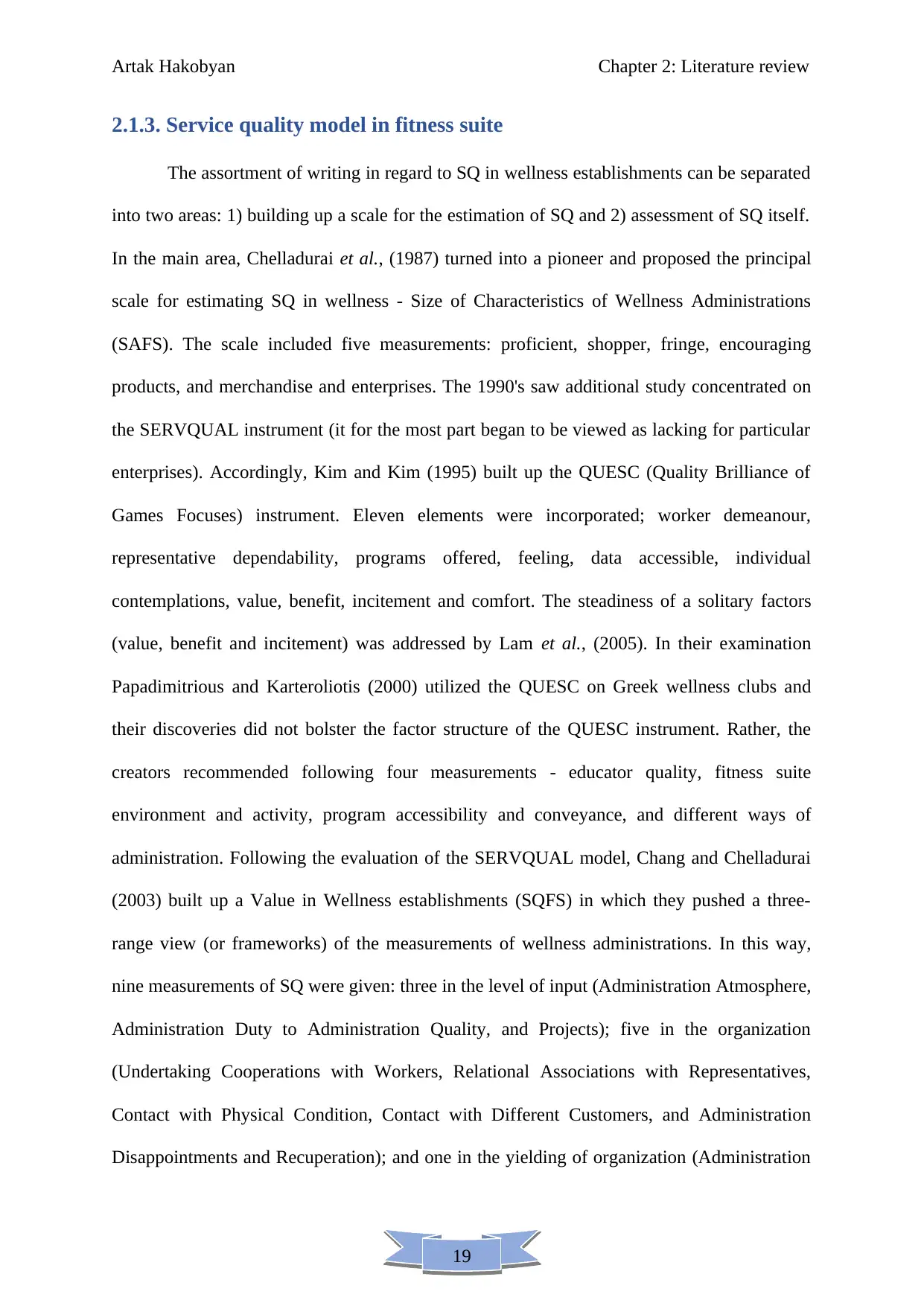
19
Artak Hakobyan Chapter 2: Literature review
2.1.3. Service quality model in fitness suite
The assortment of writing in regard to SQ in wellness establishments can be separated
into two areas: 1) building up a scale for the estimation of SQ and 2) assessment of SQ itself.
In the main area, Chelladurai et al., (1987) turned into a pioneer and proposed the principal
scale for estimating SQ in wellness - Size of Characteristics of Wellness Administrations
(SAFS). The scale included five measurements: proficient, shopper, fringe, encouraging
products, and merchandise and enterprises. The 1990's saw additional study concentrated on
the SERVQUAL instrument (it for the most part began to be viewed as lacking for particular
enterprises). Accordingly, Kim and Kim (1995) built up the QUESC (Quality Brilliance of
Games Focuses) instrument. Eleven elements were incorporated; worker demeanour,
representative dependability, programs offered, feeling, data accessible, individual
contemplations, value, benefit, incitement and comfort. The steadiness of a solitary factors
(value, benefit and incitement) was addressed by Lam et al., (2005). In their examination
Papadimitrious and Karteroliotis (2000) utilized the QUESC on Greek wellness clubs and
their discoveries did not bolster the factor structure of the QUESC instrument. Rather, the
creators recommended following four measurements - educator quality, fitness suite
environment and activity, program accessibility and conveyance, and different ways of
administration. Following the evaluation of the SERVQUAL model, Chang and Chelladurai
(2003) built up a Value in Wellness establishments (SQFS) in which they pushed a three-
range view (or frameworks) of the measurements of wellness administrations. In this way,
nine measurements of SQ were given: three in the level of input (Administration Atmosphere,
Administration Duty to Administration Quality, and Projects); five in the organization
(Undertaking Cooperations with Workers, Relational Associations with Representatives,
Contact with Physical Condition, Contact with Different Customers, and Administration
Disappointments and Recuperation); and one in the yielding of organization (Administration
Artak Hakobyan Chapter 2: Literature review
2.1.3. Service quality model in fitness suite
The assortment of writing in regard to SQ in wellness establishments can be separated
into two areas: 1) building up a scale for the estimation of SQ and 2) assessment of SQ itself.
In the main area, Chelladurai et al., (1987) turned into a pioneer and proposed the principal
scale for estimating SQ in wellness - Size of Characteristics of Wellness Administrations
(SAFS). The scale included five measurements: proficient, shopper, fringe, encouraging
products, and merchandise and enterprises. The 1990's saw additional study concentrated on
the SERVQUAL instrument (it for the most part began to be viewed as lacking for particular
enterprises). Accordingly, Kim and Kim (1995) built up the QUESC (Quality Brilliance of
Games Focuses) instrument. Eleven elements were incorporated; worker demeanour,
representative dependability, programs offered, feeling, data accessible, individual
contemplations, value, benefit, incitement and comfort. The steadiness of a solitary factors
(value, benefit and incitement) was addressed by Lam et al., (2005). In their examination
Papadimitrious and Karteroliotis (2000) utilized the QUESC on Greek wellness clubs and
their discoveries did not bolster the factor structure of the QUESC instrument. Rather, the
creators recommended following four measurements - educator quality, fitness suite
environment and activity, program accessibility and conveyance, and different ways of
administration. Following the evaluation of the SERVQUAL model, Chang and Chelladurai
(2003) built up a Value in Wellness establishments (SQFS) in which they pushed a three-
range view (or frameworks) of the measurements of wellness administrations. In this way,
nine measurements of SQ were given: three in the level of input (Administration Atmosphere,
Administration Duty to Administration Quality, and Projects); five in the organization
(Undertaking Cooperations with Workers, Relational Associations with Representatives,
Contact with Physical Condition, Contact with Different Customers, and Administration
Disappointments and Recuperation); and one in the yielding of organization (Administration
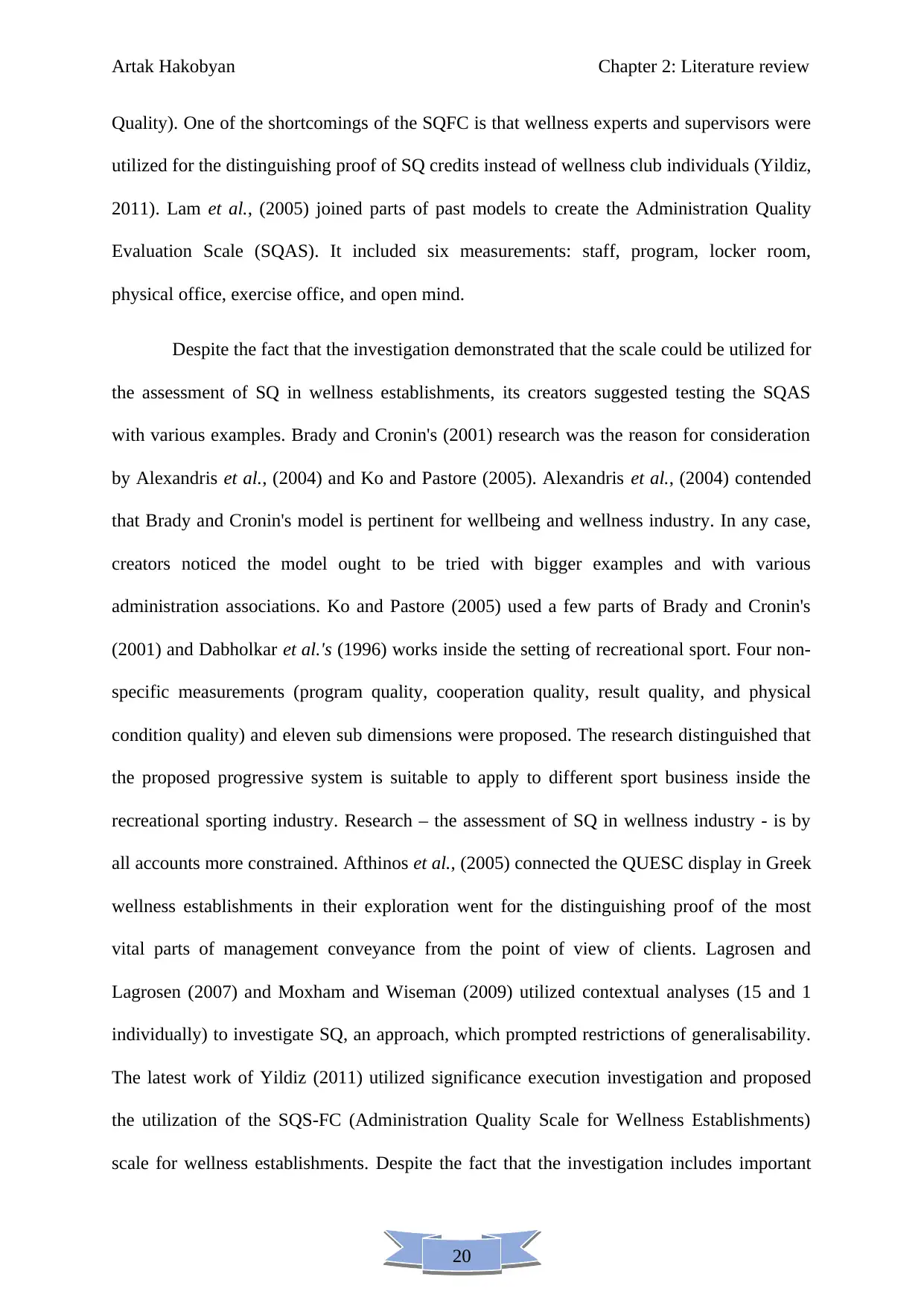
20
Artak Hakobyan Chapter 2: Literature review
Quality). One of the shortcomings of the SQFC is that wellness experts and supervisors were
utilized for the distinguishing proof of SQ credits instead of wellness club individuals (Yildiz,
2011). Lam et al., (2005) joined parts of past models to create the Administration Quality
Evaluation Scale (SQAS). It included six measurements: staff, program, locker room,
physical office, exercise office, and open mind.
Despite the fact that the investigation demonstrated that the scale could be utilized for
the assessment of SQ in wellness establishments, its creators suggested testing the SQAS
with various examples. Brady and Cronin's (2001) research was the reason for consideration
by Alexandris et al., (2004) and Ko and Pastore (2005). Alexandris et al., (2004) contended
that Brady and Cronin's model is pertinent for wellbeing and wellness industry. In any case,
creators noticed the model ought to be tried with bigger examples and with various
administration associations. Ko and Pastore (2005) used a few parts of Brady and Cronin's
(2001) and Dabholkar et al.'s (1996) works inside the setting of recreational sport. Four non-
specific measurements (program quality, cooperation quality, result quality, and physical
condition quality) and eleven sub dimensions were proposed. The research distinguished that
the proposed progressive system is suitable to apply to different sport business inside the
recreational sporting industry. Research – the assessment of SQ in wellness industry - is by
all accounts more constrained. Afthinos et al., (2005) connected the QUESC display in Greek
wellness establishments in their exploration went for the distinguishing proof of the most
vital parts of management conveyance from the point of view of clients. Lagrosen and
Lagrosen (2007) and Moxham and Wiseman (2009) utilized contextual analyses (15 and 1
individually) to investigate SQ, an approach, which prompted restrictions of generalisability.
The latest work of Yildiz (2011) utilized significance execution investigation and proposed
the utilization of the SQS-FC (Administration Quality Scale for Wellness Establishments)
scale for wellness establishments. Despite the fact that the investigation includes important
Artak Hakobyan Chapter 2: Literature review
Quality). One of the shortcomings of the SQFC is that wellness experts and supervisors were
utilized for the distinguishing proof of SQ credits instead of wellness club individuals (Yildiz,
2011). Lam et al., (2005) joined parts of past models to create the Administration Quality
Evaluation Scale (SQAS). It included six measurements: staff, program, locker room,
physical office, exercise office, and open mind.
Despite the fact that the investigation demonstrated that the scale could be utilized for
the assessment of SQ in wellness establishments, its creators suggested testing the SQAS
with various examples. Brady and Cronin's (2001) research was the reason for consideration
by Alexandris et al., (2004) and Ko and Pastore (2005). Alexandris et al., (2004) contended
that Brady and Cronin's model is pertinent for wellbeing and wellness industry. In any case,
creators noticed the model ought to be tried with bigger examples and with various
administration associations. Ko and Pastore (2005) used a few parts of Brady and Cronin's
(2001) and Dabholkar et al.'s (1996) works inside the setting of recreational sport. Four non-
specific measurements (program quality, cooperation quality, result quality, and physical
condition quality) and eleven sub dimensions were proposed. The research distinguished that
the proposed progressive system is suitable to apply to different sport business inside the
recreational sporting industry. Research – the assessment of SQ in wellness industry - is by
all accounts more constrained. Afthinos et al., (2005) connected the QUESC display in Greek
wellness establishments in their exploration went for the distinguishing proof of the most
vital parts of management conveyance from the point of view of clients. Lagrosen and
Lagrosen (2007) and Moxham and Wiseman (2009) utilized contextual analyses (15 and 1
individually) to investigate SQ, an approach, which prompted restrictions of generalisability.
The latest work of Yildiz (2011) utilized significance execution investigation and proposed
the utilization of the SQS-FC (Administration Quality Scale for Wellness Establishments)
scale for wellness establishments. Despite the fact that the investigation includes important
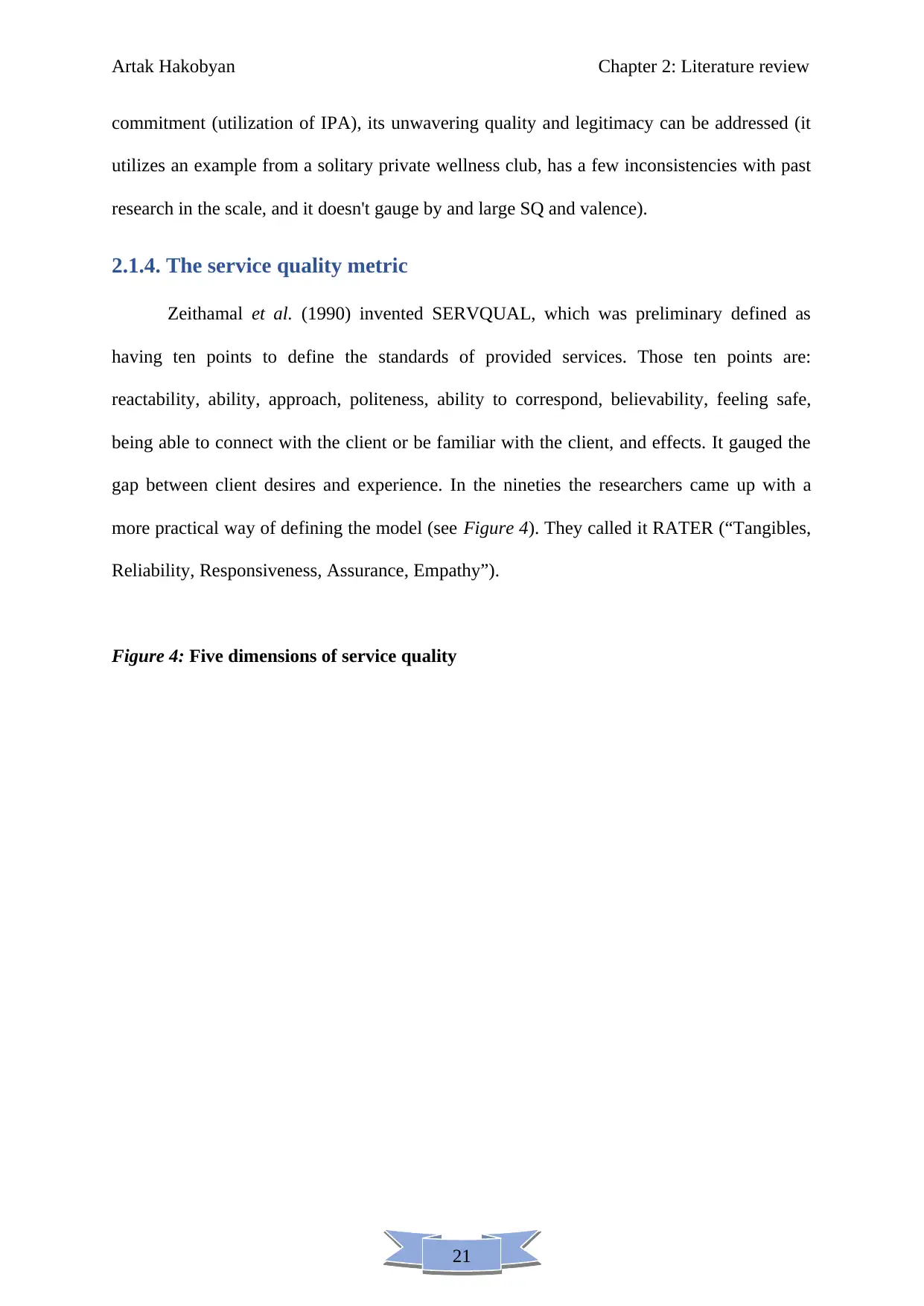
21
Artak Hakobyan Chapter 2: Literature review
commitment (utilization of IPA), its unwavering quality and legitimacy can be addressed (it
utilizes an example from a solitary private wellness club, has a few inconsistencies with past
research in the scale, and it doesn't gauge by and large SQ and valence).
2.1.4. The service quality metric
Zeithamal et al. (1990) invented SERVQUAL, which was preliminary defined as
having ten points to define the standards of provided services. Those ten points are:
reactability, ability, approach, politeness, ability to correspond, believability, feeling safe,
being able to connect with the client or be familiar with the client, and effects. It gauged the
gap between client desires and experience. In the nineties the researchers came up with a
more practical way of defining the model (see Figure 4). They called it RATER (“Tangibles,
Reliability, Responsiveness, Assurance, Empathy”).
Figure 4: Five dimensions of service quality
Artak Hakobyan Chapter 2: Literature review
commitment (utilization of IPA), its unwavering quality and legitimacy can be addressed (it
utilizes an example from a solitary private wellness club, has a few inconsistencies with past
research in the scale, and it doesn't gauge by and large SQ and valence).
2.1.4. The service quality metric
Zeithamal et al. (1990) invented SERVQUAL, which was preliminary defined as
having ten points to define the standards of provided services. Those ten points are:
reactability, ability, approach, politeness, ability to correspond, believability, feeling safe,
being able to connect with the client or be familiar with the client, and effects. It gauged the
gap between client desires and experience. In the nineties the researchers came up with a
more practical way of defining the model (see Figure 4). They called it RATER (“Tangibles,
Reliability, Responsiveness, Assurance, Empathy”).
Figure 4: Five dimensions of service quality
Secure Best Marks with AI Grader
Need help grading? Try our AI Grader for instant feedback on your assignments.
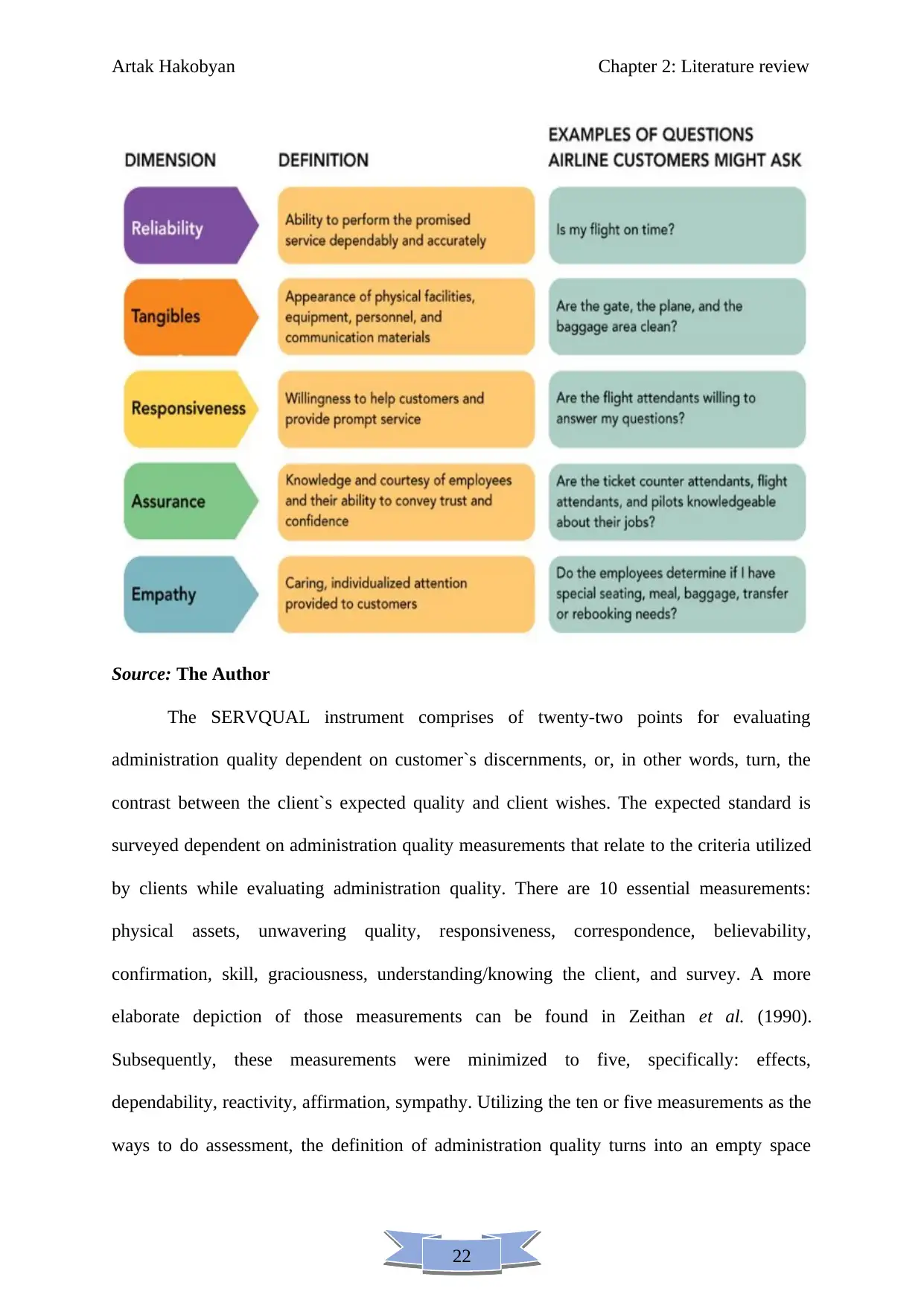
22
Artak Hakobyan Chapter 2: Literature review
Source: The Author
The SERVQUAL instrument comprises of twenty-two points for evaluating
administration quality dependent on customer`s discernments, or, in other words, turn, the
contrast between the client`s expected quality and client wishes. The expected standard is
surveyed dependent on administration quality measurements that relate to the criteria utilized
by clients while evaluating administration quality. There are 10 essential measurements:
physical assets, unwavering quality, responsiveness, correspondence, believability,
confirmation, skill, graciousness, understanding/knowing the client, and survey. A more
elaborate depiction of those measurements can be found in Zeithan et al. (1990).
Subsequently, these measurements were minimized to five, specifically: effects,
dependability, reactivity, affirmation, sympathy. Utilizing the ten or five measurements as the
ways to do assessment, the definition of administration quality turns into an empty space
Artak Hakobyan Chapter 2: Literature review
Source: The Author
The SERVQUAL instrument comprises of twenty-two points for evaluating
administration quality dependent on customer`s discernments, or, in other words, turn, the
contrast between the client`s expected quality and client wishes. The expected standard is
surveyed dependent on administration quality measurements that relate to the criteria utilized
by clients while evaluating administration quality. There are 10 essential measurements:
physical assets, unwavering quality, responsiveness, correspondence, believability,
confirmation, skill, graciousness, understanding/knowing the client, and survey. A more
elaborate depiction of those measurements can be found in Zeithan et al. (1990).
Subsequently, these measurements were minimized to five, specifically: effects,
dependability, reactivity, affirmation, sympathy. Utilizing the ten or five measurements as the
ways to do assessment, the definition of administration quality turns into an empty space
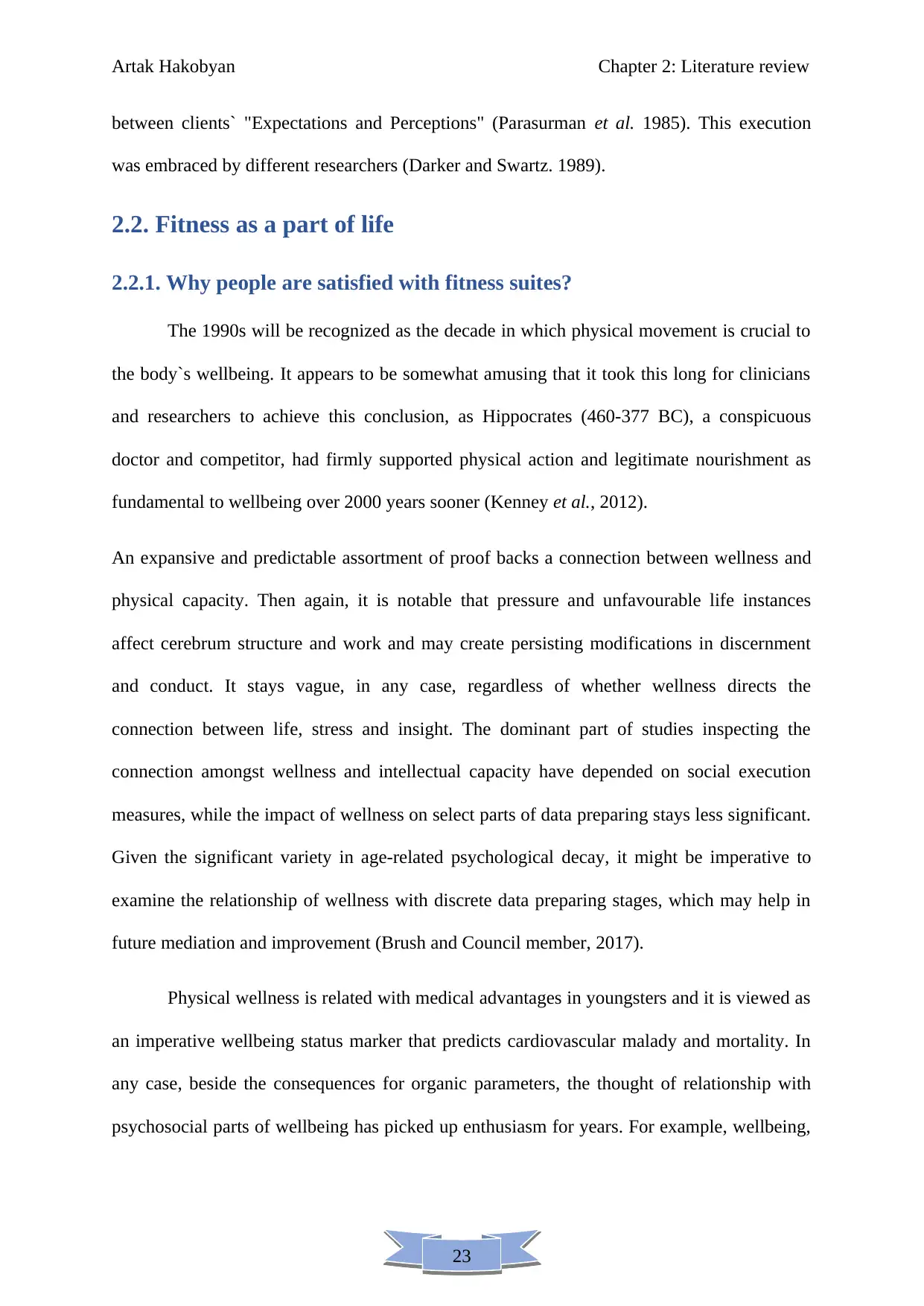
23
Artak Hakobyan Chapter 2: Literature review
between clients` "Expectations and Perceptions" (Parasurman et al. 1985). This execution
was embraced by different researchers (Darker and Swartz. 1989).
2.2. Fitness as a part of life
2.2.1. Why people are satisfied with fitness suites?
The 1990s will be recognized as the decade in which physical movement is crucial to
the body`s wellbeing. It appears to be somewhat amusing that it took this long for clinicians
and researchers to achieve this conclusion, as Hippocrates (460-377 BC), a conspicuous
doctor and competitor, had firmly supported physical action and legitimate nourishment as
fundamental to wellbeing over 2000 years sooner (Kenney et al., 2012).
An expansive and predictable assortment of proof backs a connection between wellness and
physical capacity. Then again, it is notable that pressure and unfavourable life instances
affect cerebrum structure and work and may create persisting modifications in discernment
and conduct. It stays vague, in any case, regardless of whether wellness directs the
connection between life, stress and insight. The dominant part of studies inspecting the
connection amongst wellness and intellectual capacity have depended on social execution
measures, while the impact of wellness on select parts of data preparing stays less significant.
Given the significant variety in age-related psychological decay, it might be imperative to
examine the relationship of wellness with discrete data preparing stages, which may help in
future mediation and improvement (Brush and Council member, 2017).
Physical wellness is related with medical advantages in youngsters and it is viewed as
an imperative wellbeing status marker that predicts cardiovascular malady and mortality. In
any case, beside the consequences for organic parameters, the thought of relationship with
psychosocial parts of wellbeing has picked up enthusiasm for years. For example, wellbeing,
Artak Hakobyan Chapter 2: Literature review
between clients` "Expectations and Perceptions" (Parasurman et al. 1985). This execution
was embraced by different researchers (Darker and Swartz. 1989).
2.2. Fitness as a part of life
2.2.1. Why people are satisfied with fitness suites?
The 1990s will be recognized as the decade in which physical movement is crucial to
the body`s wellbeing. It appears to be somewhat amusing that it took this long for clinicians
and researchers to achieve this conclusion, as Hippocrates (460-377 BC), a conspicuous
doctor and competitor, had firmly supported physical action and legitimate nourishment as
fundamental to wellbeing over 2000 years sooner (Kenney et al., 2012).
An expansive and predictable assortment of proof backs a connection between wellness and
physical capacity. Then again, it is notable that pressure and unfavourable life instances
affect cerebrum structure and work and may create persisting modifications in discernment
and conduct. It stays vague, in any case, regardless of whether wellness directs the
connection between life, stress and insight. The dominant part of studies inspecting the
connection amongst wellness and intellectual capacity have depended on social execution
measures, while the impact of wellness on select parts of data preparing stays less significant.
Given the significant variety in age-related psychological decay, it might be imperative to
examine the relationship of wellness with discrete data preparing stages, which may help in
future mediation and improvement (Brush and Council member, 2017).
Physical wellness is related with medical advantages in youngsters and it is viewed as
an imperative wellbeing status marker that predicts cardiovascular malady and mortality. In
any case, beside the consequences for organic parameters, the thought of relationship with
psychosocial parts of wellbeing has picked up enthusiasm for years. For example, wellbeing,
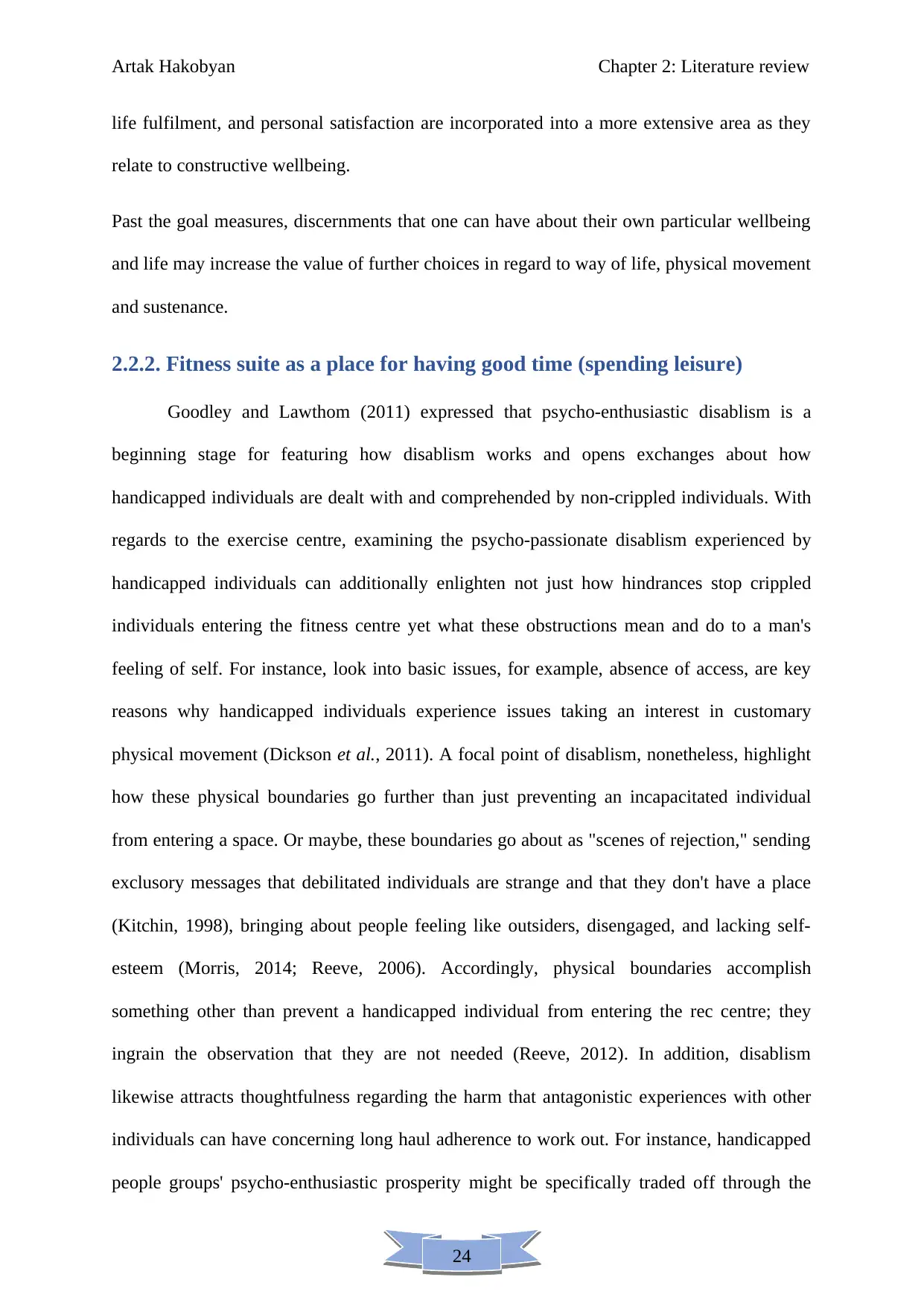
24
Artak Hakobyan Chapter 2: Literature review
life fulfilment, and personal satisfaction are incorporated into a more extensive area as they
relate to constructive wellbeing.
Past the goal measures, discernments that one can have about their own particular wellbeing
and life may increase the value of further choices in regard to way of life, physical movement
and sustenance.
2.2.2. Fitness suite as a place for having good time (spending leisure)
Goodley and Lawthom (2011) expressed that psycho-enthusiastic disablism is a
beginning stage for featuring how disablism works and opens exchanges about how
handicapped individuals are dealt with and comprehended by non-crippled individuals. With
regards to the exercise centre, examining the psycho-passionate disablism experienced by
handicapped individuals can additionally enlighten not just how hindrances stop crippled
individuals entering the fitness centre yet what these obstructions mean and do to a man's
feeling of self. For instance, look into basic issues, for example, absence of access, are key
reasons why handicapped individuals experience issues taking an interest in customary
physical movement (Dickson et al., 2011). A focal point of disablism, nonetheless, highlight
how these physical boundaries go further than just preventing an incapacitated individual
from entering a space. Or maybe, these boundaries go about as "scenes of rejection," sending
exclusory messages that debilitated individuals are strange and that they don't have a place
(Kitchin, 1998), bringing about people feeling like outsiders, disengaged, and lacking self-
esteem (Morris, 2014; Reeve, 2006). Accordingly, physical boundaries accomplish
something other than prevent a handicapped individual from entering the rec centre; they
ingrain the observation that they are not needed (Reeve, 2012). In addition, disablism
likewise attracts thoughtfulness regarding the harm that antagonistic experiences with other
individuals can have concerning long haul adherence to work out. For instance, handicapped
people groups' psycho-enthusiastic prosperity might be specifically traded off through the
Artak Hakobyan Chapter 2: Literature review
life fulfilment, and personal satisfaction are incorporated into a more extensive area as they
relate to constructive wellbeing.
Past the goal measures, discernments that one can have about their own particular wellbeing
and life may increase the value of further choices in regard to way of life, physical movement
and sustenance.
2.2.2. Fitness suite as a place for having good time (spending leisure)
Goodley and Lawthom (2011) expressed that psycho-enthusiastic disablism is a
beginning stage for featuring how disablism works and opens exchanges about how
handicapped individuals are dealt with and comprehended by non-crippled individuals. With
regards to the exercise centre, examining the psycho-passionate disablism experienced by
handicapped individuals can additionally enlighten not just how hindrances stop crippled
individuals entering the fitness centre yet what these obstructions mean and do to a man's
feeling of self. For instance, look into basic issues, for example, absence of access, are key
reasons why handicapped individuals experience issues taking an interest in customary
physical movement (Dickson et al., 2011). A focal point of disablism, nonetheless, highlight
how these physical boundaries go further than just preventing an incapacitated individual
from entering a space. Or maybe, these boundaries go about as "scenes of rejection," sending
exclusory messages that debilitated individuals are strange and that they don't have a place
(Kitchin, 1998), bringing about people feeling like outsiders, disengaged, and lacking self-
esteem (Morris, 2014; Reeve, 2006). Accordingly, physical boundaries accomplish
something other than prevent a handicapped individual from entering the rec centre; they
ingrain the observation that they are not needed (Reeve, 2012). In addition, disablism
likewise attracts thoughtfulness regarding the harm that antagonistic experiences with other
individuals can have concerning long haul adherence to work out. For instance, handicapped
people groups' psycho-enthusiastic prosperity might be specifically traded off through the
Paraphrase This Document
Need a fresh take? Get an instant paraphrase of this document with our AI Paraphraser
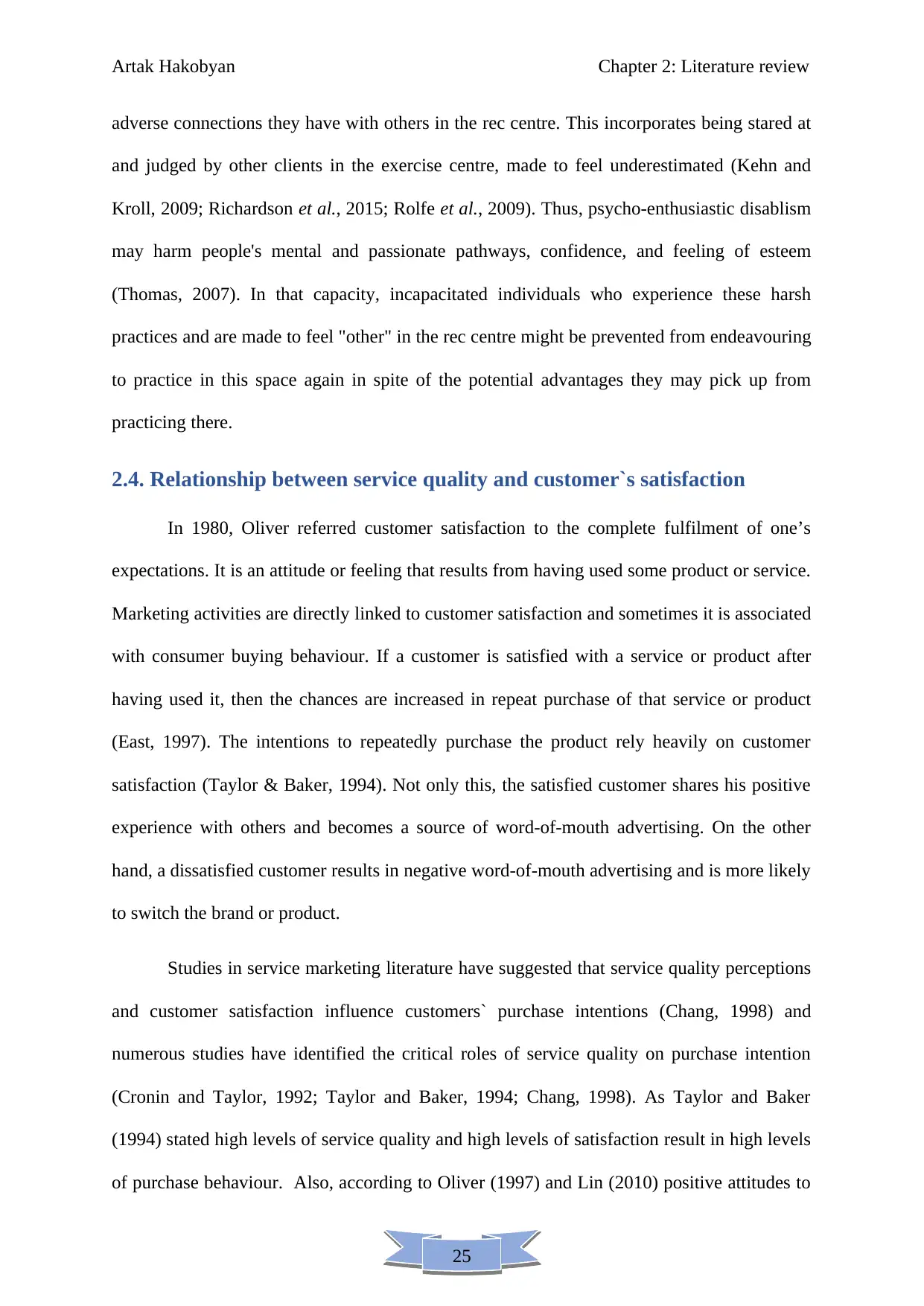
25
Artak Hakobyan Chapter 2: Literature review
adverse connections they have with others in the rec centre. This incorporates being stared at
and judged by other clients in the exercise centre, made to feel underestimated (Kehn and
Kroll, 2009; Richardson et al., 2015; Rolfe et al., 2009). Thus, psycho-enthusiastic disablism
may harm people's mental and passionate pathways, confidence, and feeling of esteem
(Thomas, 2007). In that capacity, incapacitated individuals who experience these harsh
practices and are made to feel "other" in the rec centre might be prevented from endeavouring
to practice in this space again in spite of the potential advantages they may pick up from
practicing there.
2.4. Relationship between service quality and customer`s satisfaction
In 1980, Oliver referred customer satisfaction to the complete fulfilment of one’s
expectations. It is an attitude or feeling that results from having used some product or service.
Marketing activities are directly linked to customer satisfaction and sometimes it is associated
with consumer buying behaviour. If a customer is satisfied with a service or product after
having used it, then the chances are increased in repeat purchase of that service or product
(East, 1997). The intentions to repeatedly purchase the product rely heavily on customer
satisfaction (Taylor & Baker, 1994). Not only this, the satisfied customer shares his positive
experience with others and becomes a source of word-of-mouth advertising. On the other
hand, a dissatisfied customer results in negative word-of-mouth advertising and is more likely
to switch the brand or product.
Studies in service marketing literature have suggested that service quality perceptions
and customer satisfaction influence customers` purchase intentions (Chang, 1998) and
numerous studies have identified the critical roles of service quality on purchase intention
(Cronin and Taylor, 1992; Taylor and Baker, 1994; Chang, 1998). As Taylor and Baker
(1994) stated high levels of service quality and high levels of satisfaction result in high levels
of purchase behaviour. Also, according to Oliver (1997) and Lin (2010) positive attitudes to
Artak Hakobyan Chapter 2: Literature review
adverse connections they have with others in the rec centre. This incorporates being stared at
and judged by other clients in the exercise centre, made to feel underestimated (Kehn and
Kroll, 2009; Richardson et al., 2015; Rolfe et al., 2009). Thus, psycho-enthusiastic disablism
may harm people's mental and passionate pathways, confidence, and feeling of esteem
(Thomas, 2007). In that capacity, incapacitated individuals who experience these harsh
practices and are made to feel "other" in the rec centre might be prevented from endeavouring
to practice in this space again in spite of the potential advantages they may pick up from
practicing there.
2.4. Relationship between service quality and customer`s satisfaction
In 1980, Oliver referred customer satisfaction to the complete fulfilment of one’s
expectations. It is an attitude or feeling that results from having used some product or service.
Marketing activities are directly linked to customer satisfaction and sometimes it is associated
with consumer buying behaviour. If a customer is satisfied with a service or product after
having used it, then the chances are increased in repeat purchase of that service or product
(East, 1997). The intentions to repeatedly purchase the product rely heavily on customer
satisfaction (Taylor & Baker, 1994). Not only this, the satisfied customer shares his positive
experience with others and becomes a source of word-of-mouth advertising. On the other
hand, a dissatisfied customer results in negative word-of-mouth advertising and is more likely
to switch the brand or product.
Studies in service marketing literature have suggested that service quality perceptions
and customer satisfaction influence customers` purchase intentions (Chang, 1998) and
numerous studies have identified the critical roles of service quality on purchase intention
(Cronin and Taylor, 1992; Taylor and Baker, 1994; Chang, 1998). As Taylor and Baker
(1994) stated high levels of service quality and high levels of satisfaction result in high levels
of purchase behaviour. Also, according to Oliver (1997) and Lin (2010) positive attitudes to
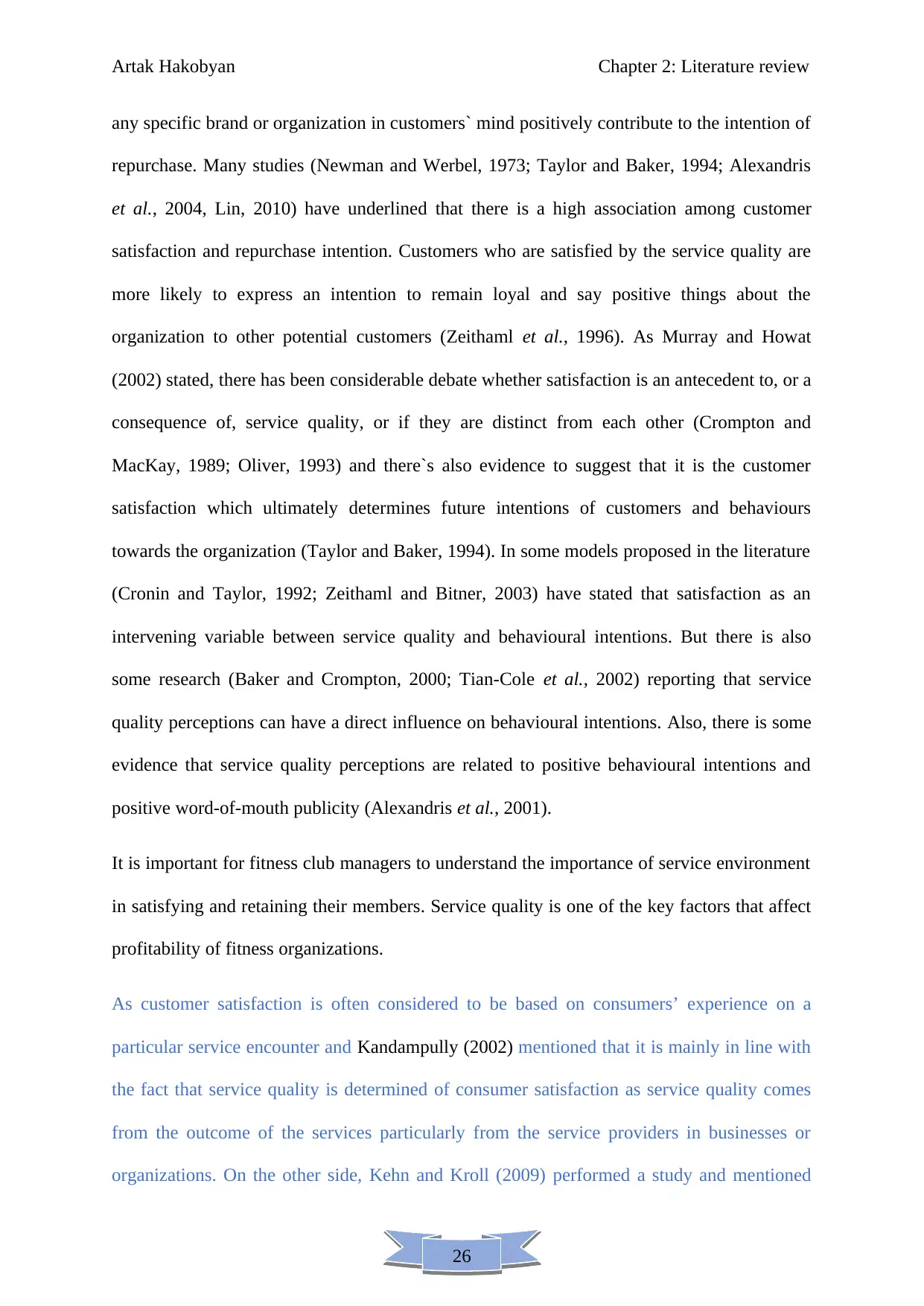
26
Artak Hakobyan Chapter 2: Literature review
any specific brand or organization in customers` mind positively contribute to the intention of
repurchase. Many studies (Newman and Werbel, 1973; Taylor and Baker, 1994; Alexandris
et al., 2004, Lin, 2010) have underlined that there is a high association among customer
satisfaction and repurchase intention. Customers who are satisfied by the service quality are
more likely to express an intention to remain loyal and say positive things about the
organization to other potential customers (Zeithaml et al., 1996). As Murray and Howat
(2002) stated, there has been considerable debate whether satisfaction is an antecedent to, or a
consequence of, service quality, or if they are distinct from each other (Crompton and
MacKay, 1989; Oliver, 1993) and there`s also evidence to suggest that it is the customer
satisfaction which ultimately determines future intentions of customers and behaviours
towards the organization (Taylor and Baker, 1994). In some models proposed in the literature
(Cronin and Taylor, 1992; Zeithaml and Bitner, 2003) have stated that satisfaction as an
intervening variable between service quality and behavioural intentions. But there is also
some research (Baker and Crompton, 2000; Tian-Cole et al., 2002) reporting that service
quality perceptions can have a direct influence on behavioural intentions. Also, there is some
evidence that service quality perceptions are related to positive behavioural intentions and
positive word-of-mouth publicity (Alexandris et al., 2001).
It is important for fitness club managers to understand the importance of service environment
in satisfying and retaining their members. Service quality is one of the key factors that affect
profitability of fitness organizations.
As customer satisfaction is often considered to be based on consumers’ experience on a
particular service encounter and Kandampully (2002) mentioned that it is mainly in line with
the fact that service quality is determined of consumer satisfaction as service quality comes
from the outcome of the services particularly from the service providers in businesses or
organizations. On the other side, Kehn and Kroll (2009) performed a study and mentioned
Artak Hakobyan Chapter 2: Literature review
any specific brand or organization in customers` mind positively contribute to the intention of
repurchase. Many studies (Newman and Werbel, 1973; Taylor and Baker, 1994; Alexandris
et al., 2004, Lin, 2010) have underlined that there is a high association among customer
satisfaction and repurchase intention. Customers who are satisfied by the service quality are
more likely to express an intention to remain loyal and say positive things about the
organization to other potential customers (Zeithaml et al., 1996). As Murray and Howat
(2002) stated, there has been considerable debate whether satisfaction is an antecedent to, or a
consequence of, service quality, or if they are distinct from each other (Crompton and
MacKay, 1989; Oliver, 1993) and there`s also evidence to suggest that it is the customer
satisfaction which ultimately determines future intentions of customers and behaviours
towards the organization (Taylor and Baker, 1994). In some models proposed in the literature
(Cronin and Taylor, 1992; Zeithaml and Bitner, 2003) have stated that satisfaction as an
intervening variable between service quality and behavioural intentions. But there is also
some research (Baker and Crompton, 2000; Tian-Cole et al., 2002) reporting that service
quality perceptions can have a direct influence on behavioural intentions. Also, there is some
evidence that service quality perceptions are related to positive behavioural intentions and
positive word-of-mouth publicity (Alexandris et al., 2001).
It is important for fitness club managers to understand the importance of service environment
in satisfying and retaining their members. Service quality is one of the key factors that affect
profitability of fitness organizations.
As customer satisfaction is often considered to be based on consumers’ experience on a
particular service encounter and Kandampully (2002) mentioned that it is mainly in line with
the fact that service quality is determined of consumer satisfaction as service quality comes
from the outcome of the services particularly from the service providers in businesses or
organizations. On the other side, Kehn and Kroll (2009) performed a study and mentioned
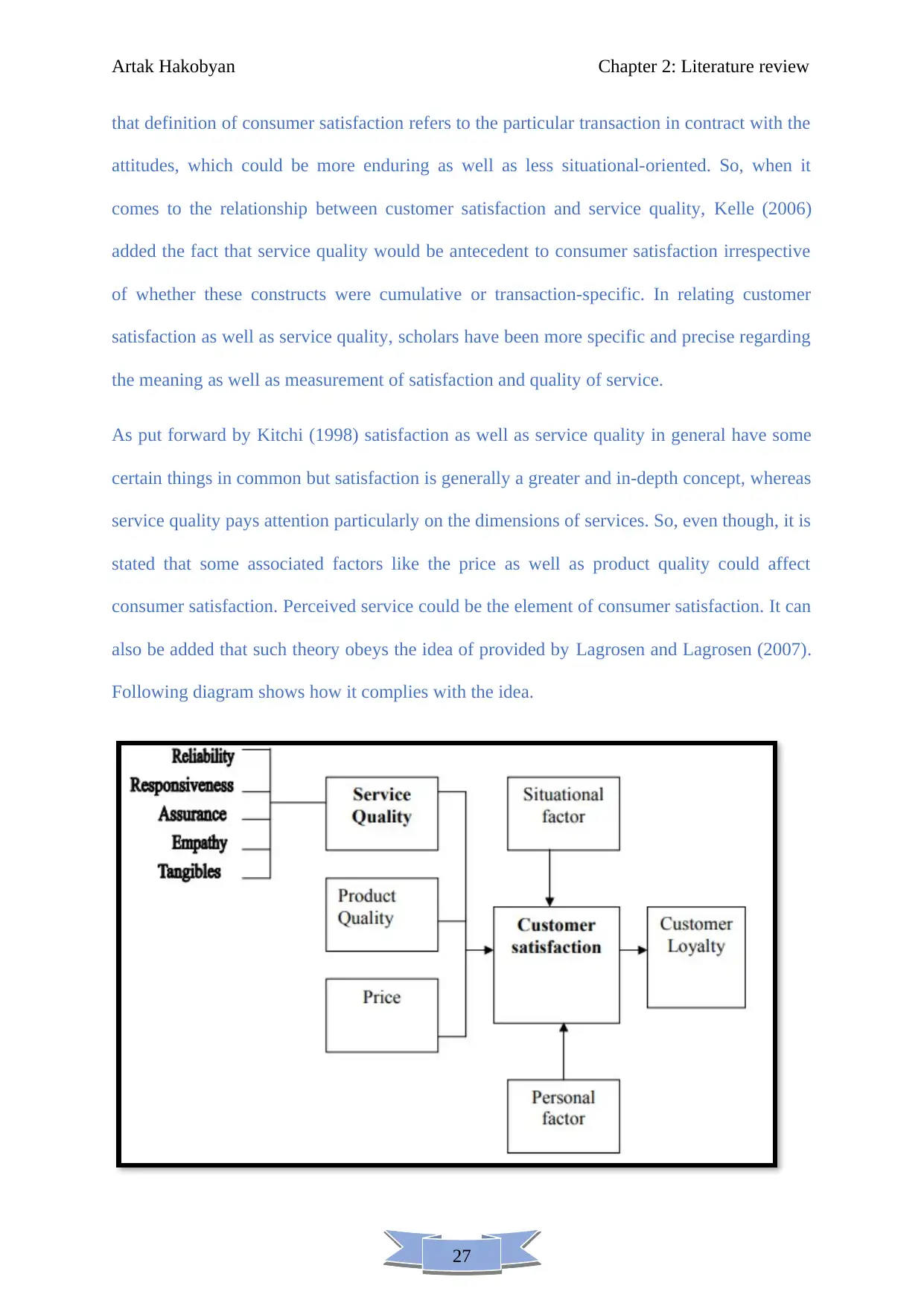
27
Artak Hakobyan Chapter 2: Literature review
that definition of consumer satisfaction refers to the particular transaction in contract with the
attitudes, which could be more enduring as well as less situational-oriented. So, when it
comes to the relationship between customer satisfaction and service quality, Kelle (2006)
added the fact that service quality would be antecedent to consumer satisfaction irrespective
of whether these constructs were cumulative or transaction-specific. In relating customer
satisfaction as well as service quality, scholars have been more specific and precise regarding
the meaning as well as measurement of satisfaction and quality of service.
As put forward by Kitchi (1998) satisfaction as well as service quality in general have some
certain things in common but satisfaction is generally a greater and in-depth concept, whereas
service quality pays attention particularly on the dimensions of services. So, even though, it is
stated that some associated factors like the price as well as product quality could affect
consumer satisfaction. Perceived service could be the element of consumer satisfaction. It can
also be added that such theory obeys the idea of provided by Lagrosen and Lagrosen (2007).
Following diagram shows how it complies with the idea.
Artak Hakobyan Chapter 2: Literature review
that definition of consumer satisfaction refers to the particular transaction in contract with the
attitudes, which could be more enduring as well as less situational-oriented. So, when it
comes to the relationship between customer satisfaction and service quality, Kelle (2006)
added the fact that service quality would be antecedent to consumer satisfaction irrespective
of whether these constructs were cumulative or transaction-specific. In relating customer
satisfaction as well as service quality, scholars have been more specific and precise regarding
the meaning as well as measurement of satisfaction and quality of service.
As put forward by Kitchi (1998) satisfaction as well as service quality in general have some
certain things in common but satisfaction is generally a greater and in-depth concept, whereas
service quality pays attention particularly on the dimensions of services. So, even though, it is
stated that some associated factors like the price as well as product quality could affect
consumer satisfaction. Perceived service could be the element of consumer satisfaction. It can
also be added that such theory obeys the idea of provided by Lagrosen and Lagrosen (2007).
Following diagram shows how it complies with the idea.
Secure Best Marks with AI Grader
Need help grading? Try our AI Grader for instant feedback on your assignments.
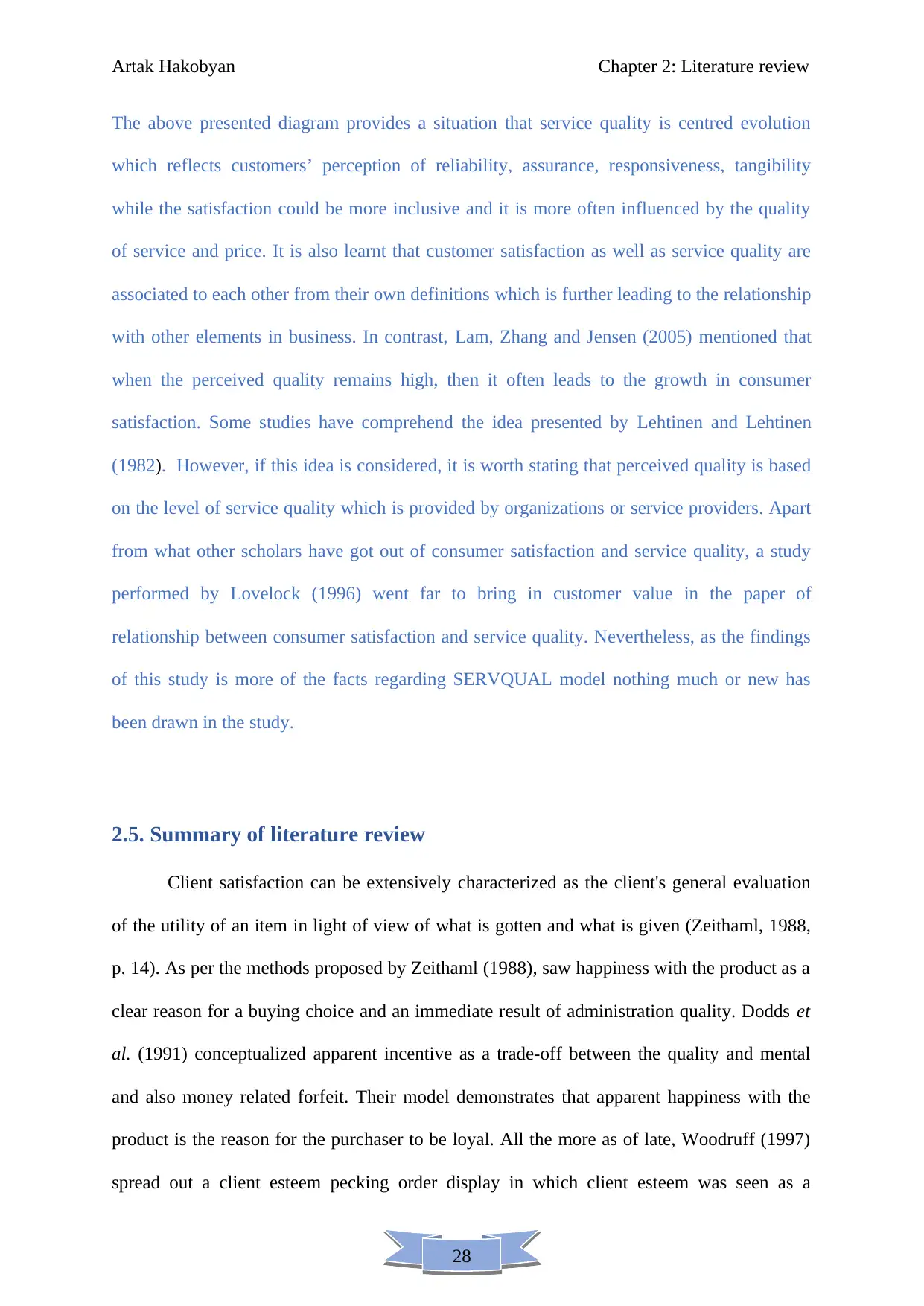
28
Artak Hakobyan Chapter 2: Literature review
The above presented diagram provides a situation that service quality is centred evolution
which reflects customers’ perception of reliability, assurance, responsiveness, tangibility
while the satisfaction could be more inclusive and it is more often influenced by the quality
of service and price. It is also learnt that customer satisfaction as well as service quality are
associated to each other from their own definitions which is further leading to the relationship
with other elements in business. In contrast, Lam, Zhang and Jensen (2005) mentioned that
when the perceived quality remains high, then it often leads to the growth in consumer
satisfaction. Some studies have comprehend the idea presented by Lehtinen and Lehtinen
(1982). However, if this idea is considered, it is worth stating that perceived quality is based
on the level of service quality which is provided by organizations or service providers. Apart
from what other scholars have got out of consumer satisfaction and service quality, a study
performed by Lovelock (1996) went far to bring in customer value in the paper of
relationship between consumer satisfaction and service quality. Nevertheless, as the findings
of this study is more of the facts regarding SERVQUAL model nothing much or new has
been drawn in the study.
2.5. Summary of literature review
Client satisfaction can be extensively characterized as the client's general evaluation
of the utility of an item in light of view of what is gotten and what is given (Zeithaml, 1988,
p. 14). As per the methods proposed by Zeithaml (1988), saw happiness with the product as a
clear reason for a buying choice and an immediate result of administration quality. Dodds et
al. (1991) conceptualized apparent incentive as a trade-off between the quality and mental
and also money related forfeit. Their model demonstrates that apparent happiness with the
product is the reason for the purchaser to be loyal. All the more as of late, Woodruff (1997)
spread out a client esteem pecking order display in which client esteem was seen as a
Artak Hakobyan Chapter 2: Literature review
The above presented diagram provides a situation that service quality is centred evolution
which reflects customers’ perception of reliability, assurance, responsiveness, tangibility
while the satisfaction could be more inclusive and it is more often influenced by the quality
of service and price. It is also learnt that customer satisfaction as well as service quality are
associated to each other from their own definitions which is further leading to the relationship
with other elements in business. In contrast, Lam, Zhang and Jensen (2005) mentioned that
when the perceived quality remains high, then it often leads to the growth in consumer
satisfaction. Some studies have comprehend the idea presented by Lehtinen and Lehtinen
(1982). However, if this idea is considered, it is worth stating that perceived quality is based
on the level of service quality which is provided by organizations or service providers. Apart
from what other scholars have got out of consumer satisfaction and service quality, a study
performed by Lovelock (1996) went far to bring in customer value in the paper of
relationship between consumer satisfaction and service quality. Nevertheless, as the findings
of this study is more of the facts regarding SERVQUAL model nothing much or new has
been drawn in the study.
2.5. Summary of literature review
Client satisfaction can be extensively characterized as the client's general evaluation
of the utility of an item in light of view of what is gotten and what is given (Zeithaml, 1988,
p. 14). As per the methods proposed by Zeithaml (1988), saw happiness with the product as a
clear reason for a buying choice and an immediate result of administration quality. Dodds et
al. (1991) conceptualized apparent incentive as a trade-off between the quality and mental
and also money related forfeit. Their model demonstrates that apparent happiness with the
product is the reason for the purchaser to be loyal. All the more as of late, Woodruff (1997)
spread out a client esteem pecking order display in which client esteem was seen as a
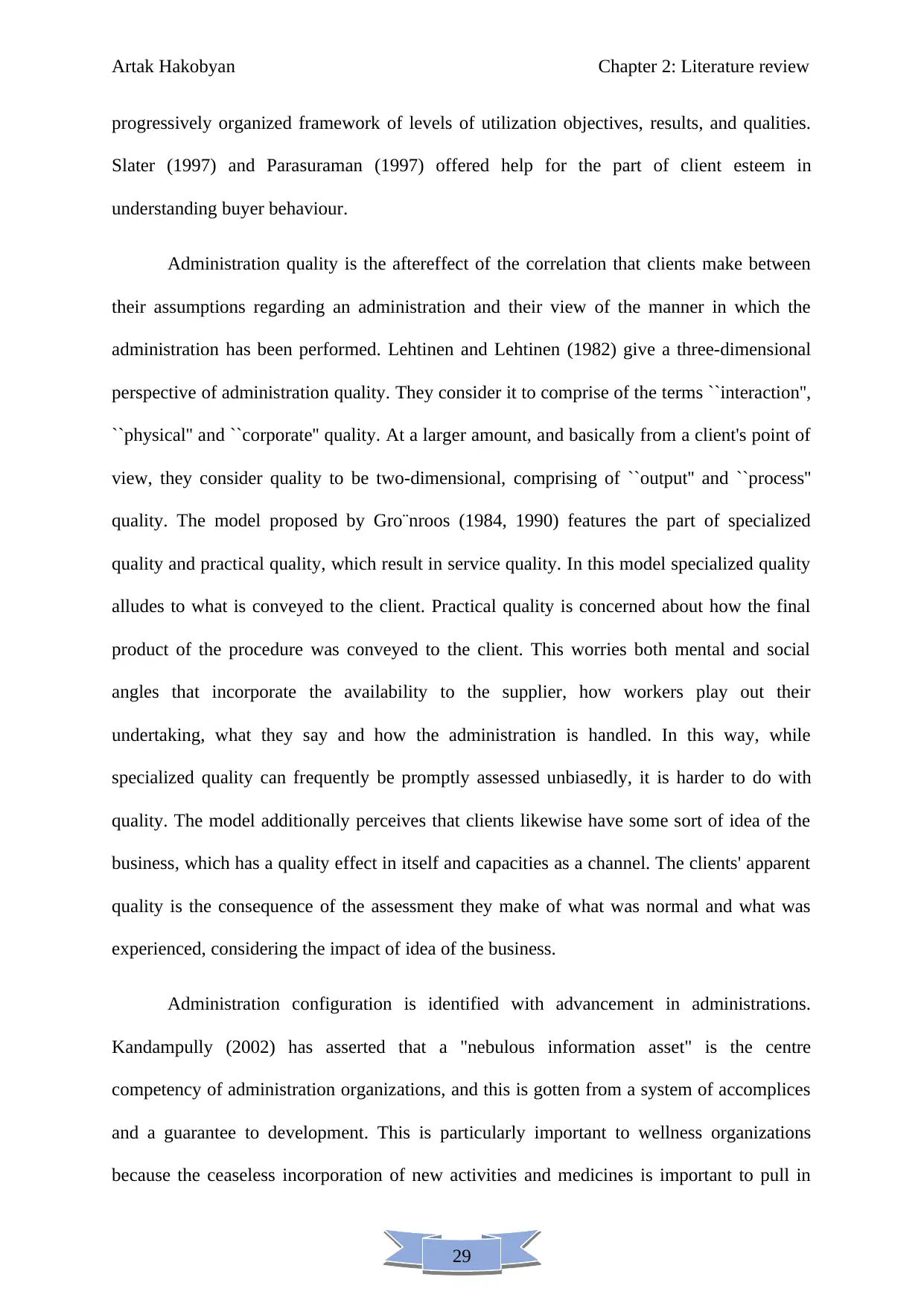
29
Artak Hakobyan Chapter 2: Literature review
progressively organized framework of levels of utilization objectives, results, and qualities.
Slater (1997) and Parasuraman (1997) offered help for the part of client esteem in
understanding buyer behaviour.
Administration quality is the aftereffect of the correlation that clients make between
their assumptions regarding an administration and their view of the manner in which the
administration has been performed. Lehtinen and Lehtinen (1982) give a three-dimensional
perspective of administration quality. They consider it to comprise of the terms ``interaction'',
``physical'' and ``corporate'' quality. At a larger amount, and basically from a client's point of
view, they consider quality to be two-dimensional, comprising of ``output'' and ``process''
quality. The model proposed by Gro¨nroos (1984, 1990) features the part of specialized
quality and practical quality, which result in service quality. In this model specialized quality
alludes to what is conveyed to the client. Practical quality is concerned about how the final
product of the procedure was conveyed to the client. This worries both mental and social
angles that incorporate the availability to the supplier, how workers play out their
undertaking, what they say and how the administration is handled. In this way, while
specialized quality can frequently be promptly assessed unbiasedly, it is harder to do with
quality. The model additionally perceives that clients likewise have some sort of idea of the
business, which has a quality effect in itself and capacities as a channel. The clients' apparent
quality is the consequence of the assessment they make of what was normal and what was
experienced, considering the impact of idea of the business.
Administration configuration is identified with advancement in administrations.
Kandampully (2002) has asserted that a "nebulous information asset" is the centre
competency of administration organizations, and this is gotten from a system of accomplices
and a guarantee to development. This is particularly important to wellness organizations
because the ceaseless incorporation of new activities and medicines is important to pull in
Artak Hakobyan Chapter 2: Literature review
progressively organized framework of levels of utilization objectives, results, and qualities.
Slater (1997) and Parasuraman (1997) offered help for the part of client esteem in
understanding buyer behaviour.
Administration quality is the aftereffect of the correlation that clients make between
their assumptions regarding an administration and their view of the manner in which the
administration has been performed. Lehtinen and Lehtinen (1982) give a three-dimensional
perspective of administration quality. They consider it to comprise of the terms ``interaction'',
``physical'' and ``corporate'' quality. At a larger amount, and basically from a client's point of
view, they consider quality to be two-dimensional, comprising of ``output'' and ``process''
quality. The model proposed by Gro¨nroos (1984, 1990) features the part of specialized
quality and practical quality, which result in service quality. In this model specialized quality
alludes to what is conveyed to the client. Practical quality is concerned about how the final
product of the procedure was conveyed to the client. This worries both mental and social
angles that incorporate the availability to the supplier, how workers play out their
undertaking, what they say and how the administration is handled. In this way, while
specialized quality can frequently be promptly assessed unbiasedly, it is harder to do with
quality. The model additionally perceives that clients likewise have some sort of idea of the
business, which has a quality effect in itself and capacities as a channel. The clients' apparent
quality is the consequence of the assessment they make of what was normal and what was
experienced, considering the impact of idea of the business.
Administration configuration is identified with advancement in administrations.
Kandampully (2002) has asserted that a "nebulous information asset" is the centre
competency of administration organizations, and this is gotten from a system of accomplices
and a guarantee to development. This is particularly important to wellness organizations
because the ceaseless incorporation of new activities and medicines is important to pull in
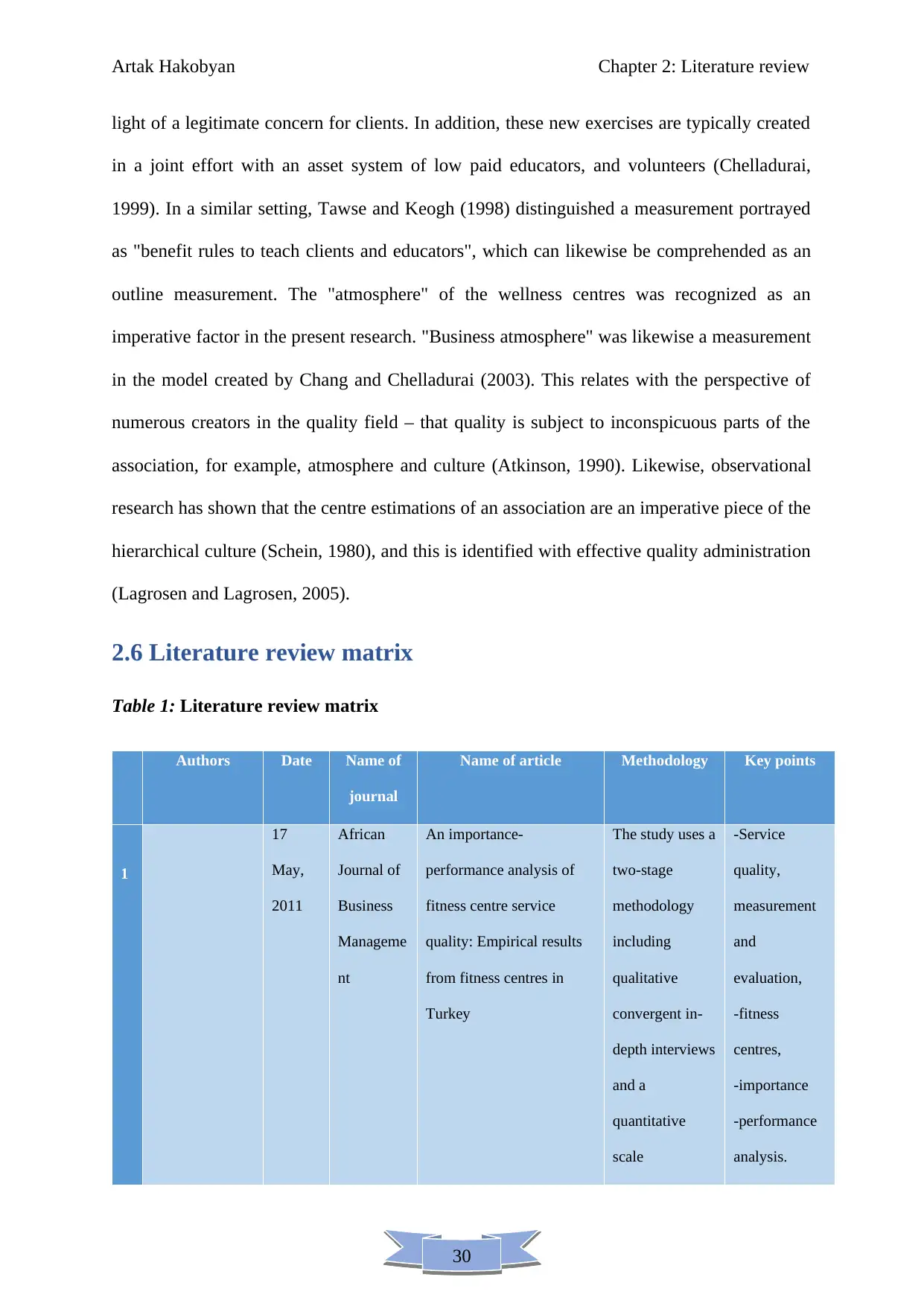
30
Artak Hakobyan Chapter 2: Literature review
light of a legitimate concern for clients. In addition, these new exercises are typically created
in a joint effort with an asset system of low paid educators, and volunteers (Chelladurai,
1999). In a similar setting, Tawse and Keogh (1998) distinguished a measurement portrayed
as "benefit rules to teach clients and educators", which can likewise be comprehended as an
outline measurement. The "atmosphere" of the wellness centres was recognized as an
imperative factor in the present research. "Business atmosphere" was likewise a measurement
in the model created by Chang and Chelladurai (2003). This relates with the perspective of
numerous creators in the quality field – that quality is subject to inconspicuous parts of the
association, for example, atmosphere and culture (Atkinson, 1990). Likewise, observational
research has shown that the centre estimations of an association are an imperative piece of the
hierarchical culture (Schein, 1980), and this is identified with effective quality administration
(Lagrosen and Lagrosen, 2005).
2.6 Literature review matrix
Table 1: Literature review matrix
Authors Date Name of
journal
Name of article Methodology Key points
1
17
May,
2011
African
Journal of
Business
Manageme
nt
An importance-
performance analysis of
fitness centre service
quality: Empirical results
from fitness centres in
Turkey
The study uses a
two-stage
methodology
including
qualitative
convergent in-
depth interviews
and a
quantitative
scale
-Service
quality,
measurement
and
evaluation,
-fitness
centres,
-importance
-performance
analysis.
Artak Hakobyan Chapter 2: Literature review
light of a legitimate concern for clients. In addition, these new exercises are typically created
in a joint effort with an asset system of low paid educators, and volunteers (Chelladurai,
1999). In a similar setting, Tawse and Keogh (1998) distinguished a measurement portrayed
as "benefit rules to teach clients and educators", which can likewise be comprehended as an
outline measurement. The "atmosphere" of the wellness centres was recognized as an
imperative factor in the present research. "Business atmosphere" was likewise a measurement
in the model created by Chang and Chelladurai (2003). This relates with the perspective of
numerous creators in the quality field – that quality is subject to inconspicuous parts of the
association, for example, atmosphere and culture (Atkinson, 1990). Likewise, observational
research has shown that the centre estimations of an association are an imperative piece of the
hierarchical culture (Schein, 1980), and this is identified with effective quality administration
(Lagrosen and Lagrosen, 2005).
2.6 Literature review matrix
Table 1: Literature review matrix
Authors Date Name of
journal
Name of article Methodology Key points
1
17
May,
2011
African
Journal of
Business
Manageme
nt
An importance-
performance analysis of
fitness centre service
quality: Empirical results
from fitness centres in
Turkey
The study uses a
two-stage
methodology
including
qualitative
convergent in-
depth interviews
and a
quantitative
scale
-Service
quality,
measurement
and
evaluation,
-fitness
centres,
-importance
-performance
analysis.
Paraphrase This Document
Need a fresh take? Get an instant paraphrase of this document with our AI Paraphraser
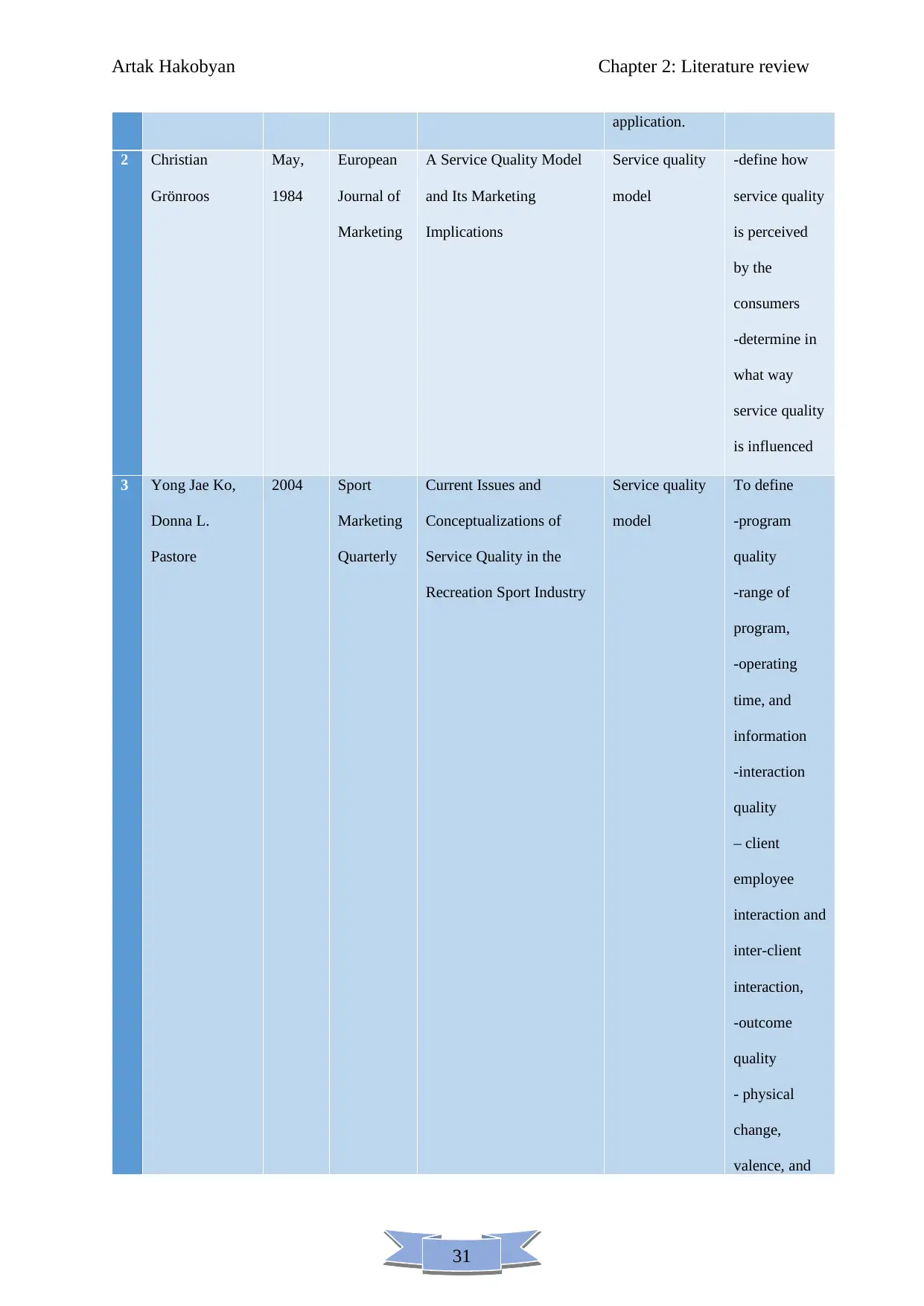
31
Artak Hakobyan Chapter 2: Literature review
application.
2 Christian
Grönroos
May,
1984
European
Journal of
Marketing
A Service Quality Model
and Its Marketing
Implications
Service quality
model
-define how
service quality
is perceived
by the
consumers
-determine in
what way
service quality
is influenced
3 Yong Jae Ko,
Donna L.
Pastore
2004 Sport
Marketing
Quarterly
Current Issues and
Conceptualizations of
Service Quality in the
Recreation Sport Industry
Service quality
model
To define
-program
quality
-range of
program,
-operating
time, and
information
-interaction
quality
– client
employee
interaction and
inter-client
interaction,
-outcome
quality
- physical
change,
valence, and
Artak Hakobyan Chapter 2: Literature review
application.
2 Christian
Grönroos
May,
1984
European
Journal of
Marketing
A Service Quality Model
and Its Marketing
Implications
Service quality
model
-define how
service quality
is perceived
by the
consumers
-determine in
what way
service quality
is influenced
3 Yong Jae Ko,
Donna L.
Pastore
2004 Sport
Marketing
Quarterly
Current Issues and
Conceptualizations of
Service Quality in the
Recreation Sport Industry
Service quality
model
To define
-program
quality
-range of
program,
-operating
time, and
information
-interaction
quality
– client
employee
interaction and
inter-client
interaction,
-outcome
quality
- physical
change,
valence, and
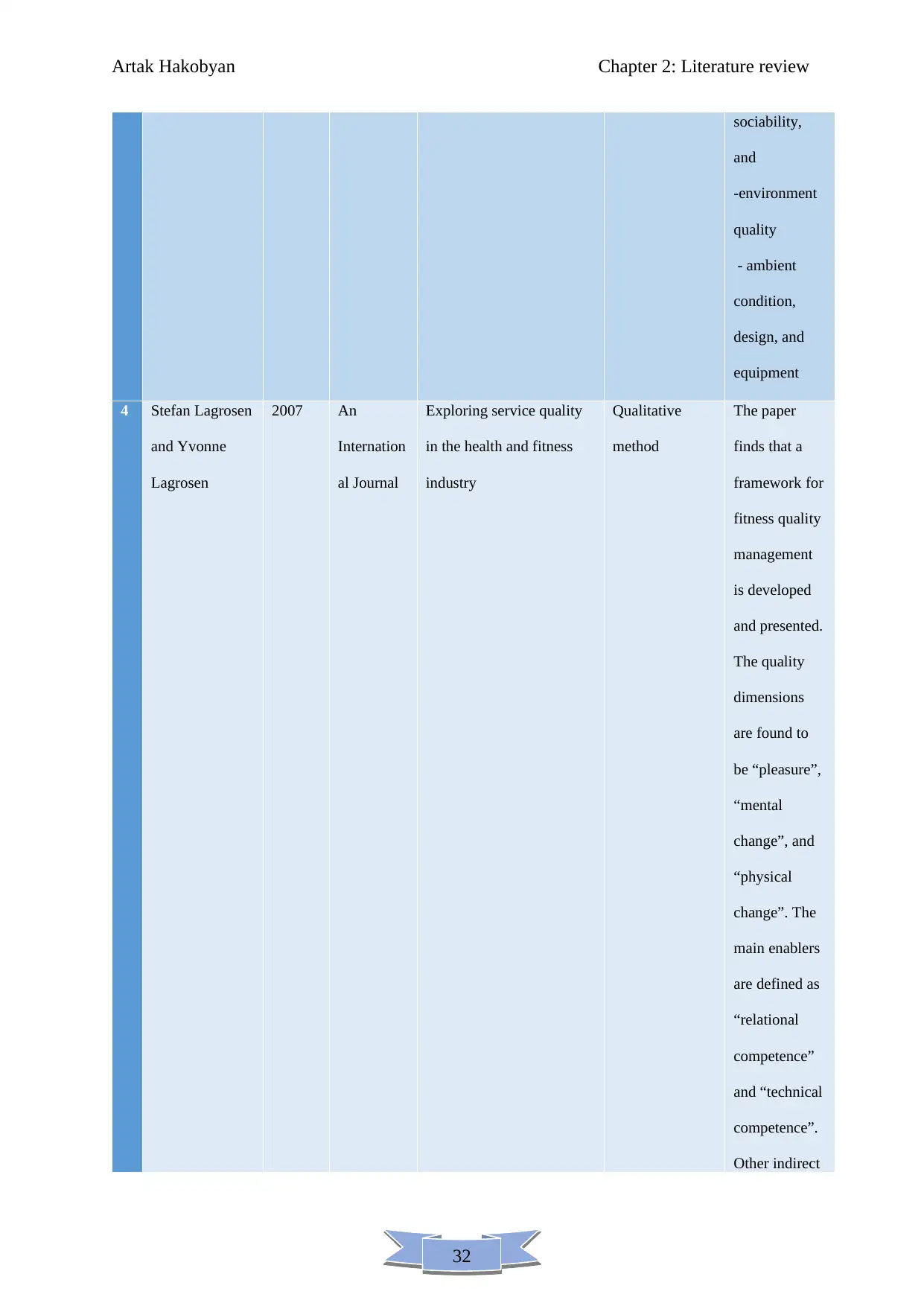
32
Artak Hakobyan Chapter 2: Literature review
sociability,
and
-environment
quality
- ambient
condition,
design, and
equipment
4 Stefan Lagrosen
and Yvonne
Lagrosen
2007 An
Internation
al Journal
Exploring service quality
in the health and fitness
industry
Qualitative
method
The paper
finds that a
framework for
fitness quality
management
is developed
and presented.
The quality
dimensions
are found to
be “pleasure”,
“mental
change”, and
“physical
change”. The
main enablers
are defined as
“relational
competence”
and “technical
competence”.
Other indirect
Artak Hakobyan Chapter 2: Literature review
sociability,
and
-environment
quality
- ambient
condition,
design, and
equipment
4 Stefan Lagrosen
and Yvonne
Lagrosen
2007 An
Internation
al Journal
Exploring service quality
in the health and fitness
industry
Qualitative
method
The paper
finds that a
framework for
fitness quality
management
is developed
and presented.
The quality
dimensions
are found to
be “pleasure”,
“mental
change”, and
“physical
change”. The
main enablers
are defined as
“relational
competence”
and “technical
competence”.
Other indirect
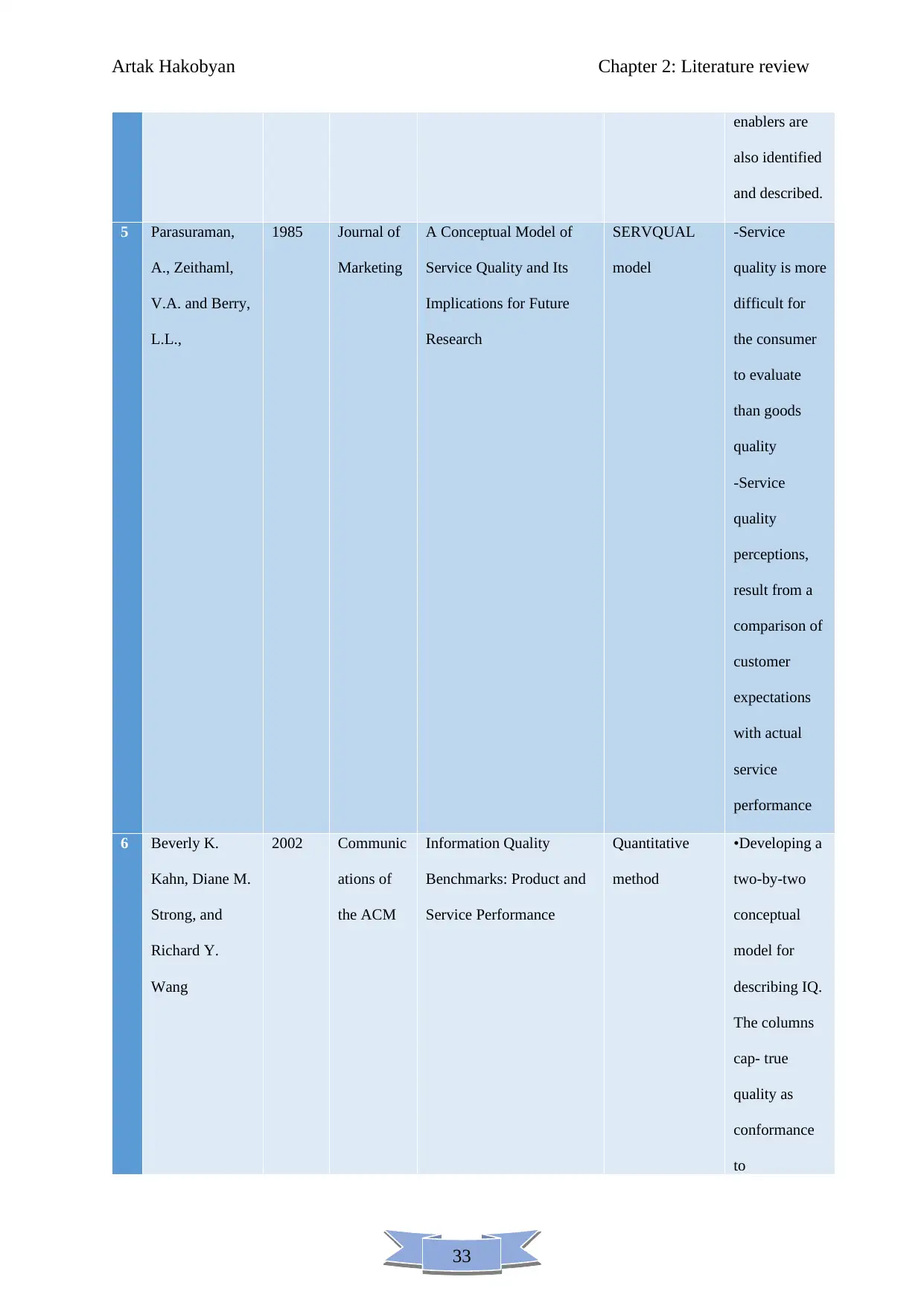
33
Artak Hakobyan Chapter 2: Literature review
enablers are
also identified
and described.
5 Parasuraman,
A., Zeithaml,
V.A. and Berry,
L.L.,
1985 Journal of
Marketing
A Conceptual Model of
Service Quality and Its
Implications for Future
Research
SERVQUAL
model
-Service
quality is more
difficult for
the consumer
to evaluate
than goods
quality
-Service
quality
perceptions,
result from a
comparison of
customer
expectations
with actual
service
performance
6 Beverly K.
Kahn, Diane M.
Strong, and
Richard Y.
Wang
2002 Communic
ations of
the ACM
Information Quality
Benchmarks: Product and
Service Performance
Quantitative
method
•Developing a
two-by-two
conceptual
model for
describing IQ.
The columns
cap- true
quality as
conformance
to
Artak Hakobyan Chapter 2: Literature review
enablers are
also identified
and described.
5 Parasuraman,
A., Zeithaml,
V.A. and Berry,
L.L.,
1985 Journal of
Marketing
A Conceptual Model of
Service Quality and Its
Implications for Future
Research
SERVQUAL
model
-Service
quality is more
difficult for
the consumer
to evaluate
than goods
quality
-Service
quality
perceptions,
result from a
comparison of
customer
expectations
with actual
service
performance
6 Beverly K.
Kahn, Diane M.
Strong, and
Richard Y.
Wang
2002 Communic
ations of
the ACM
Information Quality
Benchmarks: Product and
Service Performance
Quantitative
method
•Developing a
two-by-two
conceptual
model for
describing IQ.
The columns
cap- true
quality as
conformance
to
Secure Best Marks with AI Grader
Need help grading? Try our AI Grader for instant feedback on your assignments.
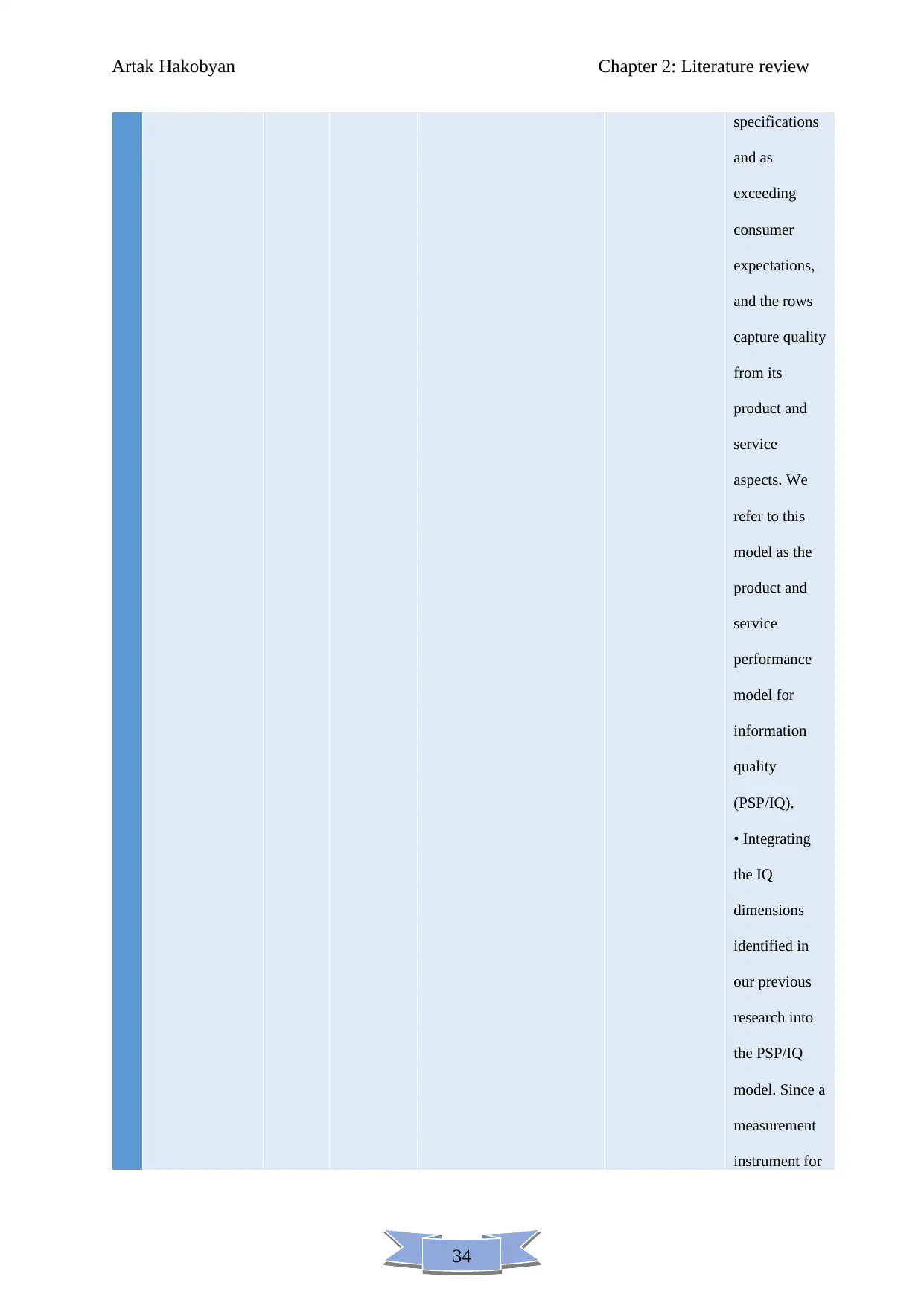
34
Artak Hakobyan Chapter 2: Literature review
specifications
and as
exceeding
consumer
expectations,
and the rows
capture quality
from its
product and
service
aspects. We
refer to this
model as the
product and
service
performance
model for
information
quality
(PSP/IQ).
• Integrating
the IQ
dimensions
identified in
our previous
research into
the PSP/IQ
model. Since a
measurement
instrument for
Artak Hakobyan Chapter 2: Literature review
specifications
and as
exceeding
consumer
expectations,
and the rows
capture quality
from its
product and
service
aspects. We
refer to this
model as the
product and
service
performance
model for
information
quality
(PSP/IQ).
• Integrating
the IQ
dimensions
identified in
our previous
research into
the PSP/IQ
model. Since a
measurement
instrument for
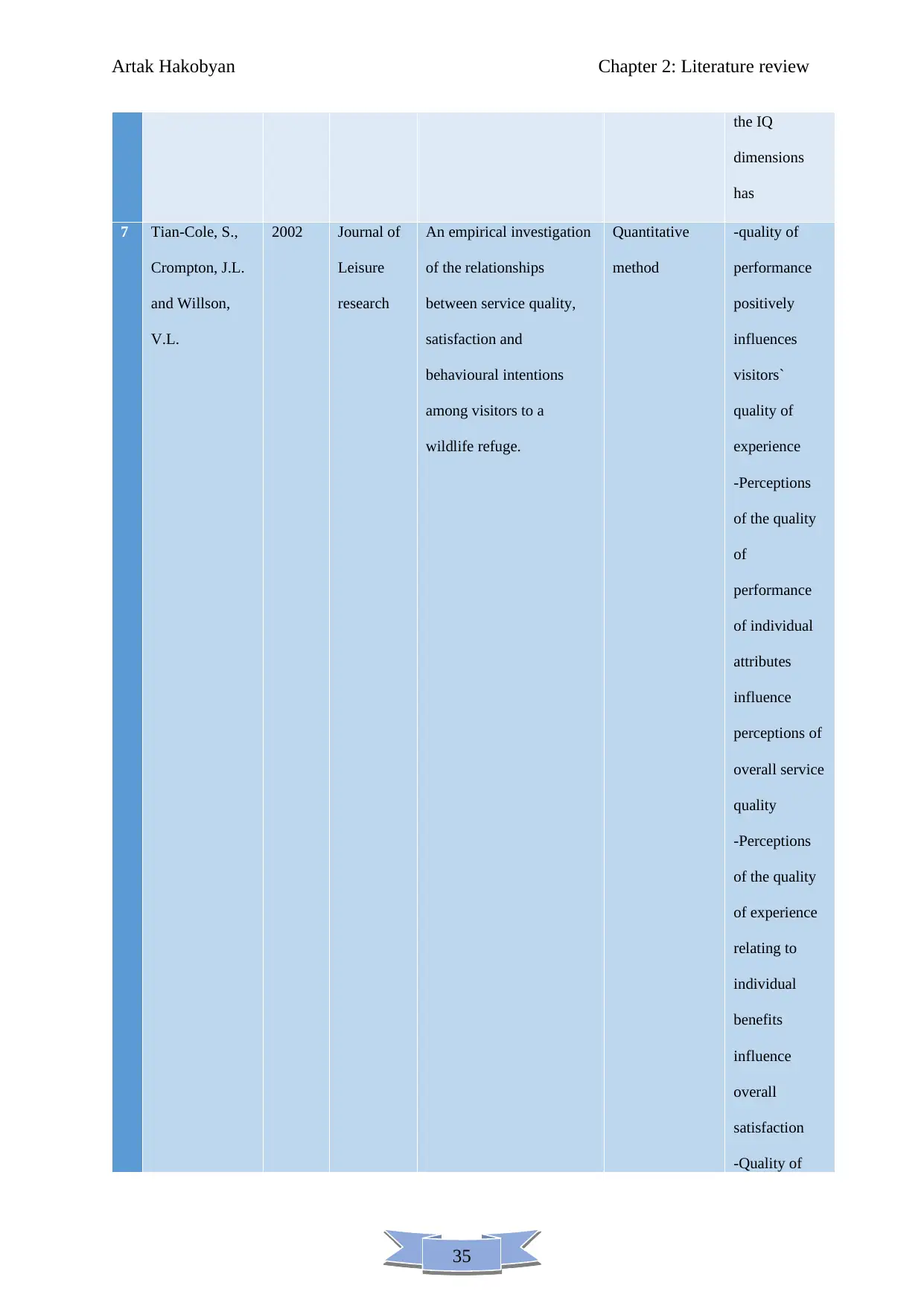
35
Artak Hakobyan Chapter 2: Literature review
the IQ
dimensions
has
7 Tian-Cole, S.,
Crompton, J.L.
and Willson,
V.L.
2002 Journal of
Leisure
research
An empirical investigation
of the relationships
between service quality,
satisfaction and
behavioural intentions
among visitors to a
wildlife refuge.
Quantitative
method
-quality of
performance
positively
influences
visitors`
quality of
experience
-Perceptions
of the quality
of
performance
of individual
attributes
influence
perceptions of
overall service
quality
-Perceptions
of the quality
of experience
relating to
individual
benefits
influence
overall
satisfaction
-Quality of
Artak Hakobyan Chapter 2: Literature review
the IQ
dimensions
has
7 Tian-Cole, S.,
Crompton, J.L.
and Willson,
V.L.
2002 Journal of
Leisure
research
An empirical investigation
of the relationships
between service quality,
satisfaction and
behavioural intentions
among visitors to a
wildlife refuge.
Quantitative
method
-quality of
performance
positively
influences
visitors`
quality of
experience
-Perceptions
of the quality
of
performance
of individual
attributes
influence
perceptions of
overall service
quality
-Perceptions
of the quality
of experience
relating to
individual
benefits
influence
overall
satisfaction
-Quality of
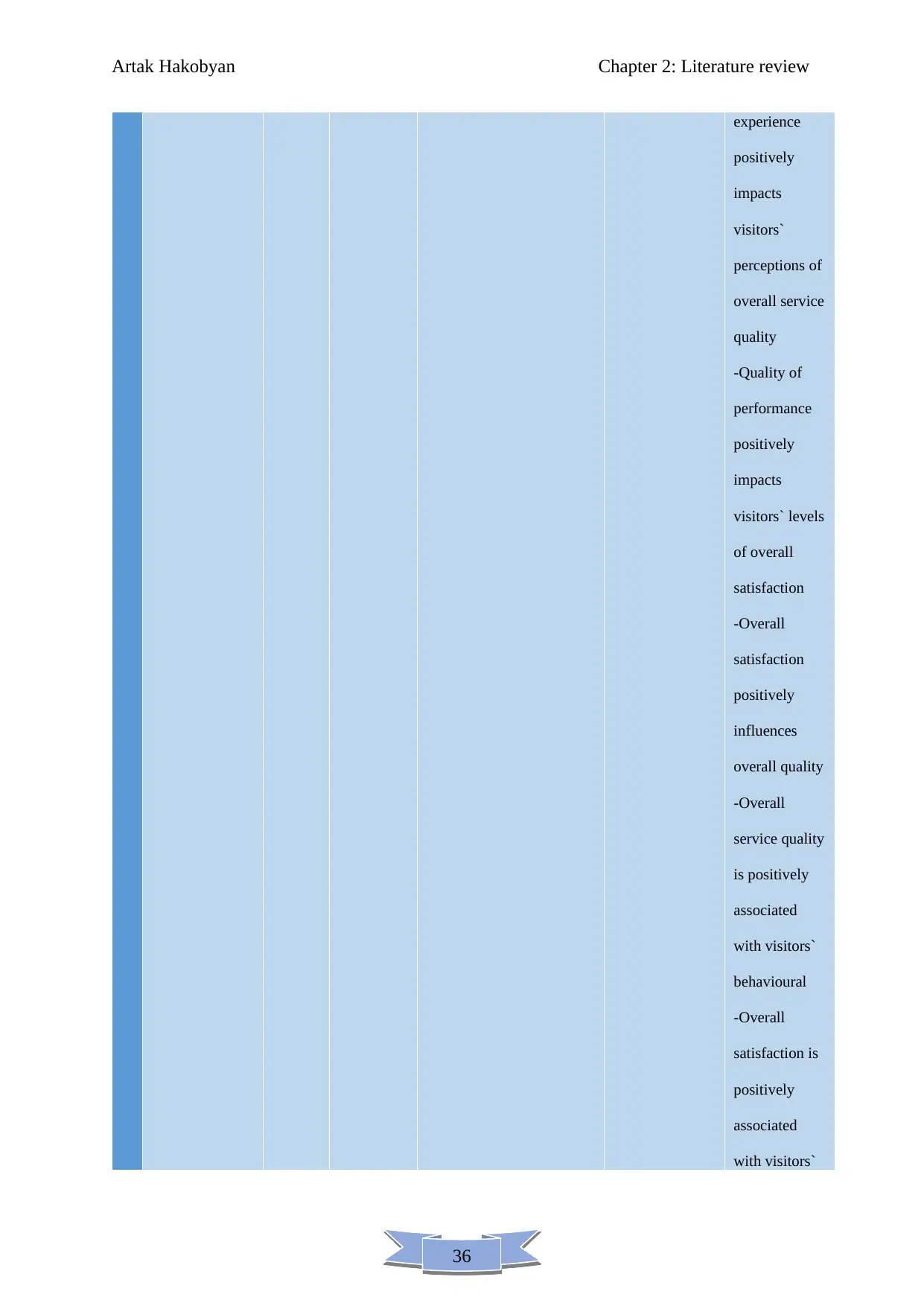
36
Artak Hakobyan Chapter 2: Literature review
experience
positively
impacts
visitors`
perceptions of
overall service
quality
-Quality of
performance
positively
impacts
visitors` levels
of overall
satisfaction
-Overall
satisfaction
positively
influences
overall quality
-Overall
service quality
is positively
associated
with visitors`
behavioural
-Overall
satisfaction is
positively
associated
with visitors`
Artak Hakobyan Chapter 2: Literature review
experience
positively
impacts
visitors`
perceptions of
overall service
quality
-Quality of
performance
positively
impacts
visitors` levels
of overall
satisfaction
-Overall
satisfaction
positively
influences
overall quality
-Overall
service quality
is positively
associated
with visitors`
behavioural
-Overall
satisfaction is
positively
associated
with visitors`
Paraphrase This Document
Need a fresh take? Get an instant paraphrase of this document with our AI Paraphraser
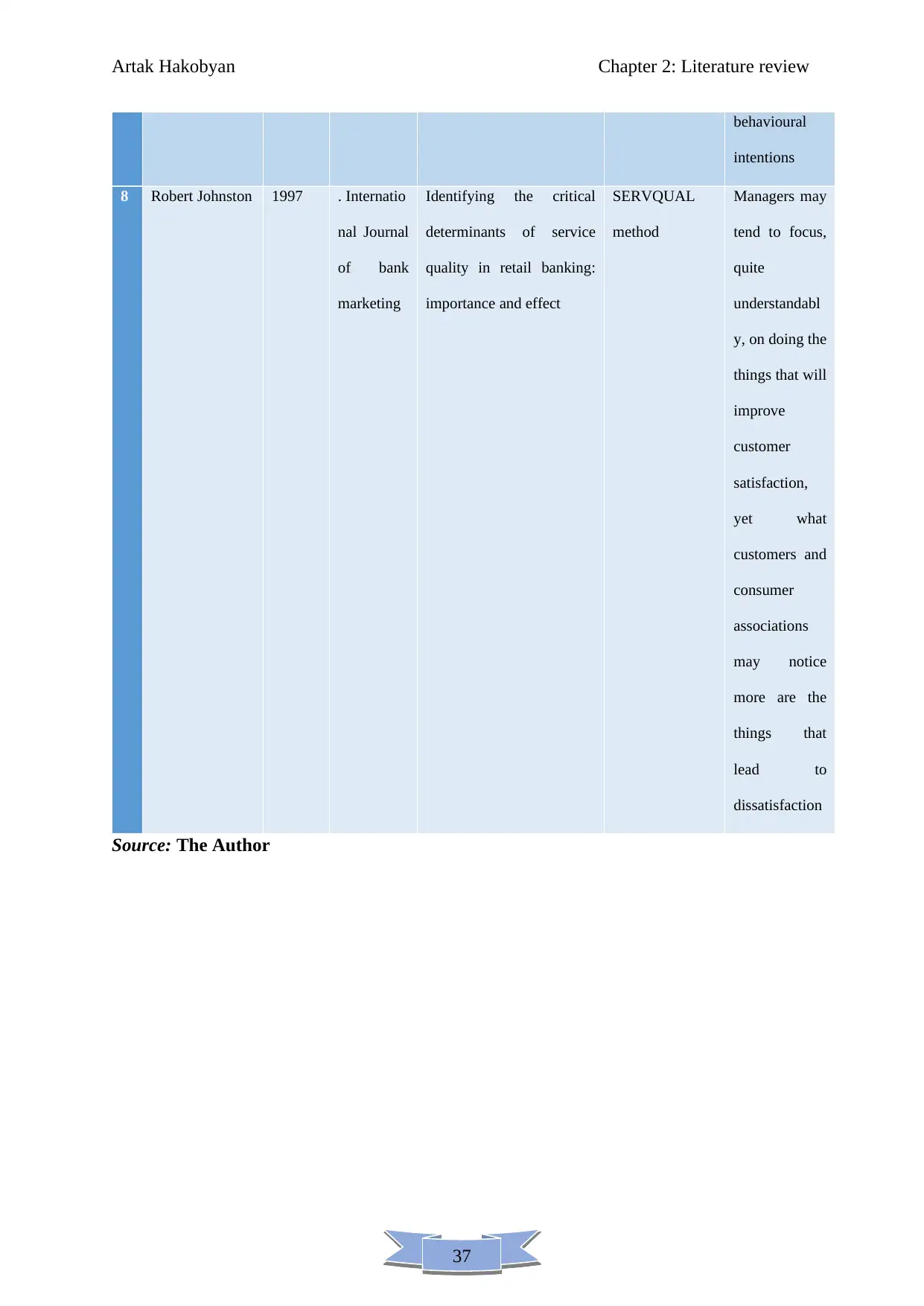
37
Artak Hakobyan Chapter 2: Literature review
behavioural
intentions
8 Robert Johnston 1997 . Internatio
nal Journal
of bank
marketing
Identifying the critical
determinants of service
quality in retail banking:
importance and effect
SERVQUAL
method
Managers may
tend to focus,
quite
understandabl
y, on doing the
things that will
improve
customer
satisfaction,
yet what
customers and
consumer
associations
may notice
more are the
things that
lead to
dissatisfaction
Source: The Author
Artak Hakobyan Chapter 2: Literature review
behavioural
intentions
8 Robert Johnston 1997 . Internatio
nal Journal
of bank
marketing
Identifying the critical
determinants of service
quality in retail banking:
importance and effect
SERVQUAL
method
Managers may
tend to focus,
quite
understandabl
y, on doing the
things that will
improve
customer
satisfaction,
yet what
customers and
consumer
associations
may notice
more are the
things that
lead to
dissatisfaction
Source: The Author
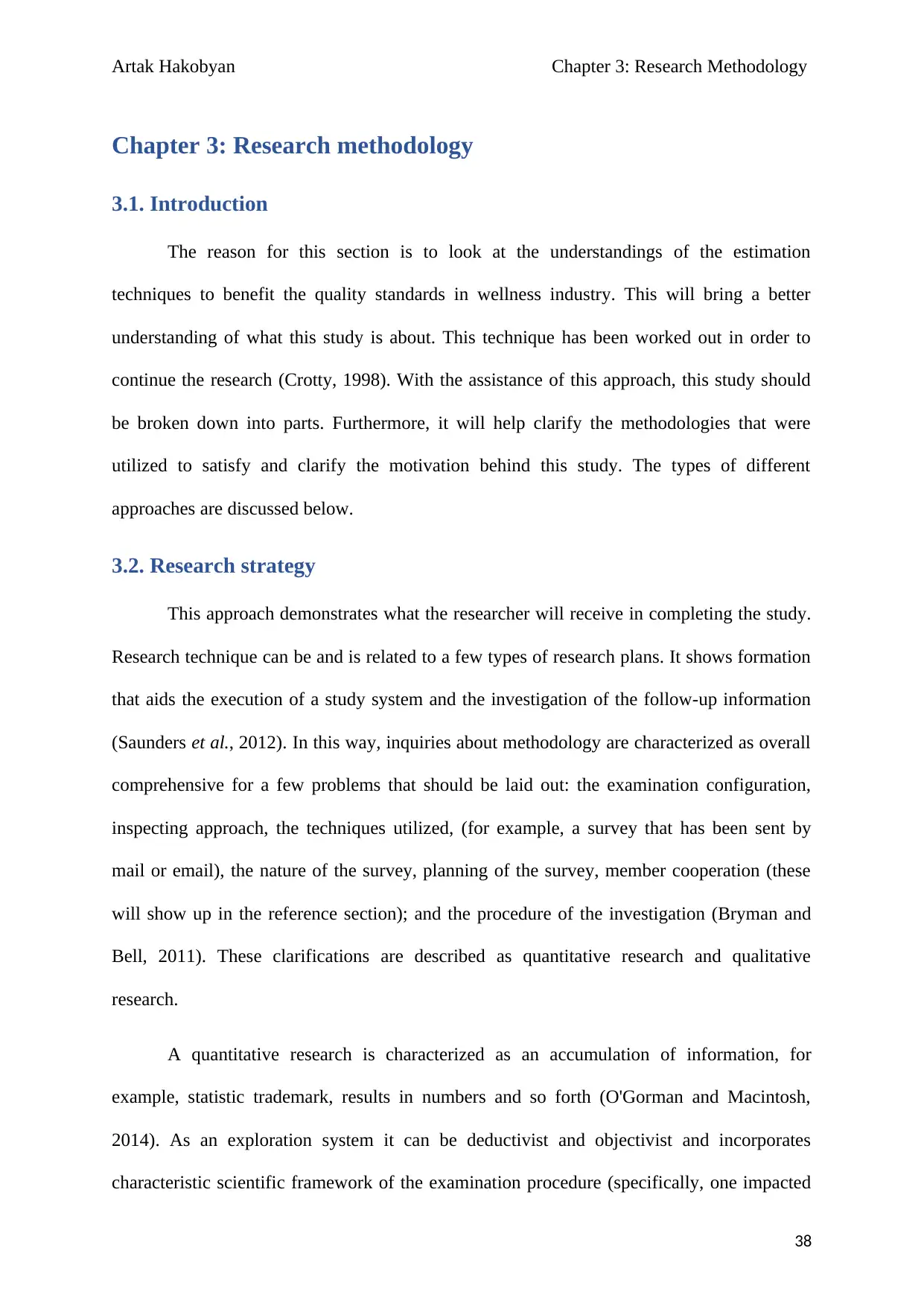
Artak Hakobyan Chapter 3: Research Methodology
Chapter 3: Research methodology
3.1. Introduction
The reason for this section is to look at the understandings of the estimation
techniques to benefit the quality standards in wellness industry. This will bring a better
understanding of what this study is about. This technique has been worked out in order to
continue the research (Crotty, 1998). With the assistance of this approach, this study should
be broken down into parts. Furthermore, it will help clarify the methodologies that were
utilized to satisfy and clarify the motivation behind this study. The types of different
approaches are discussed below.
3.2. Research strategy
This approach demonstrates what the researcher will receive in completing the study.
Research technique can be and is related to a few types of research plans. It shows formation
that aids the execution of a study system and the investigation of the follow-up information
(Saunders et al., 2012). In this way, inquiries about methodology are characterized as overall
comprehensive for a few problems that should be laid out: the examination configuration,
inspecting approach, the techniques utilized, (for example, a survey that has been sent by
mail or email), the nature of the survey, planning of the survey, member cooperation (these
will show up in the reference section); and the procedure of the investigation (Bryman and
Bell, 2011). These clarifications are described as quantitative research and qualitative
research.
A quantitative research is characterized as an accumulation of information, for
example, statistic trademark, results in numbers and so forth (O'Gorman and Macintosh,
2014). As an exploration system it can be deductivist and objectivist and incorporates
characteristic scientific framework of the examination procedure (specifically, one impacted
38
Chapter 3: Research methodology
3.1. Introduction
The reason for this section is to look at the understandings of the estimation
techniques to benefit the quality standards in wellness industry. This will bring a better
understanding of what this study is about. This technique has been worked out in order to
continue the research (Crotty, 1998). With the assistance of this approach, this study should
be broken down into parts. Furthermore, it will help clarify the methodologies that were
utilized to satisfy and clarify the motivation behind this study. The types of different
approaches are discussed below.
3.2. Research strategy
This approach demonstrates what the researcher will receive in completing the study.
Research technique can be and is related to a few types of research plans. It shows formation
that aids the execution of a study system and the investigation of the follow-up information
(Saunders et al., 2012). In this way, inquiries about methodology are characterized as overall
comprehensive for a few problems that should be laid out: the examination configuration,
inspecting approach, the techniques utilized, (for example, a survey that has been sent by
mail or email), the nature of the survey, planning of the survey, member cooperation (these
will show up in the reference section); and the procedure of the investigation (Bryman and
Bell, 2011). These clarifications are described as quantitative research and qualitative
research.
A quantitative research is characterized as an accumulation of information, for
example, statistic trademark, results in numbers and so forth (O'Gorman and Macintosh,
2014). As an exploration system it can be deductivist and objectivist and incorporates
characteristic scientific framework of the examination procedure (specifically, one impacted
38

39
Artak Hakobyan Chapter 3: Research Methodology
by positivism), yet quantitative specialists don't generally agree with all these ideas. A
positivist method is used regularly when collecting information and measurements.
According to Belk (2007), the philosophical assumptions guiding positivist research
include an objective view of reality, which research seeks to measure and explain. Certain
scientists utilize positivist view in case of carrying out studies about service quality in fitness.
The researchers think that it incorporates an established and clear method of positivity about
themselves and drive as the most important ingredient, whereas qualitative research is
characterized as a view of investigation and examination. (Coles et al., 2013). As a study
approach, it is inductivist, constructivist, and interpretivist, but qualitative research supporters
do not often support the three aspects. (Bryman and Bell, 2011). By being trustworthy to the
people they were studying, the scientists turned the phenomenologist approach, and, as
Mason (2014) states phenomenologist approach believes that those people, who believe that
their mentality, actions, etc are the only true things. A phenomenologist approach gathers
significant information and recognitions through person's data. One on one meetings are
described as sincere interactions. Because of this interaction, unlike any other meeting
strategy, one on one communication can become a valuable source of additional information.
The additional information is provided through various clues. These clues can be meaningful
gestures, for example, voice, pitch, non-verbal communication and so on, where the
interviewee can give the questioner a considerable material of additional data that could
provide additional clarifications to the responses that the surveyors give (Opdenakker, 2006).
This research project is aimed at focusing on the service quality in fitness where UCLan
Cyprus fitness suite will be used as a case study. The aim of qualitative method is to discover
new ideas, way of thinking, wishes and what is better for both customers and the fitness suite.
There is an important part of the quantitative research process that requires the availability of
culture-specific knowledge, the operationalization of theoretical concepts and the
Artak Hakobyan Chapter 3: Research Methodology
by positivism), yet quantitative specialists don't generally agree with all these ideas. A
positivist method is used regularly when collecting information and measurements.
According to Belk (2007), the philosophical assumptions guiding positivist research
include an objective view of reality, which research seeks to measure and explain. Certain
scientists utilize positivist view in case of carrying out studies about service quality in fitness.
The researchers think that it incorporates an established and clear method of positivity about
themselves and drive as the most important ingredient, whereas qualitative research is
characterized as a view of investigation and examination. (Coles et al., 2013). As a study
approach, it is inductivist, constructivist, and interpretivist, but qualitative research supporters
do not often support the three aspects. (Bryman and Bell, 2011). By being trustworthy to the
people they were studying, the scientists turned the phenomenologist approach, and, as
Mason (2014) states phenomenologist approach believes that those people, who believe that
their mentality, actions, etc are the only true things. A phenomenologist approach gathers
significant information and recognitions through person's data. One on one meetings are
described as sincere interactions. Because of this interaction, unlike any other meeting
strategy, one on one communication can become a valuable source of additional information.
The additional information is provided through various clues. These clues can be meaningful
gestures, for example, voice, pitch, non-verbal communication and so on, where the
interviewee can give the questioner a considerable material of additional data that could
provide additional clarifications to the responses that the surveyors give (Opdenakker, 2006).
This research project is aimed at focusing on the service quality in fitness where UCLan
Cyprus fitness suite will be used as a case study. The aim of qualitative method is to discover
new ideas, way of thinking, wishes and what is better for both customers and the fitness suite.
There is an important part of the quantitative research process that requires the availability of
culture-specific knowledge, the operationalization of theoretical concepts and the
Secure Best Marks with AI Grader
Need help grading? Try our AI Grader for instant feedback on your assignments.
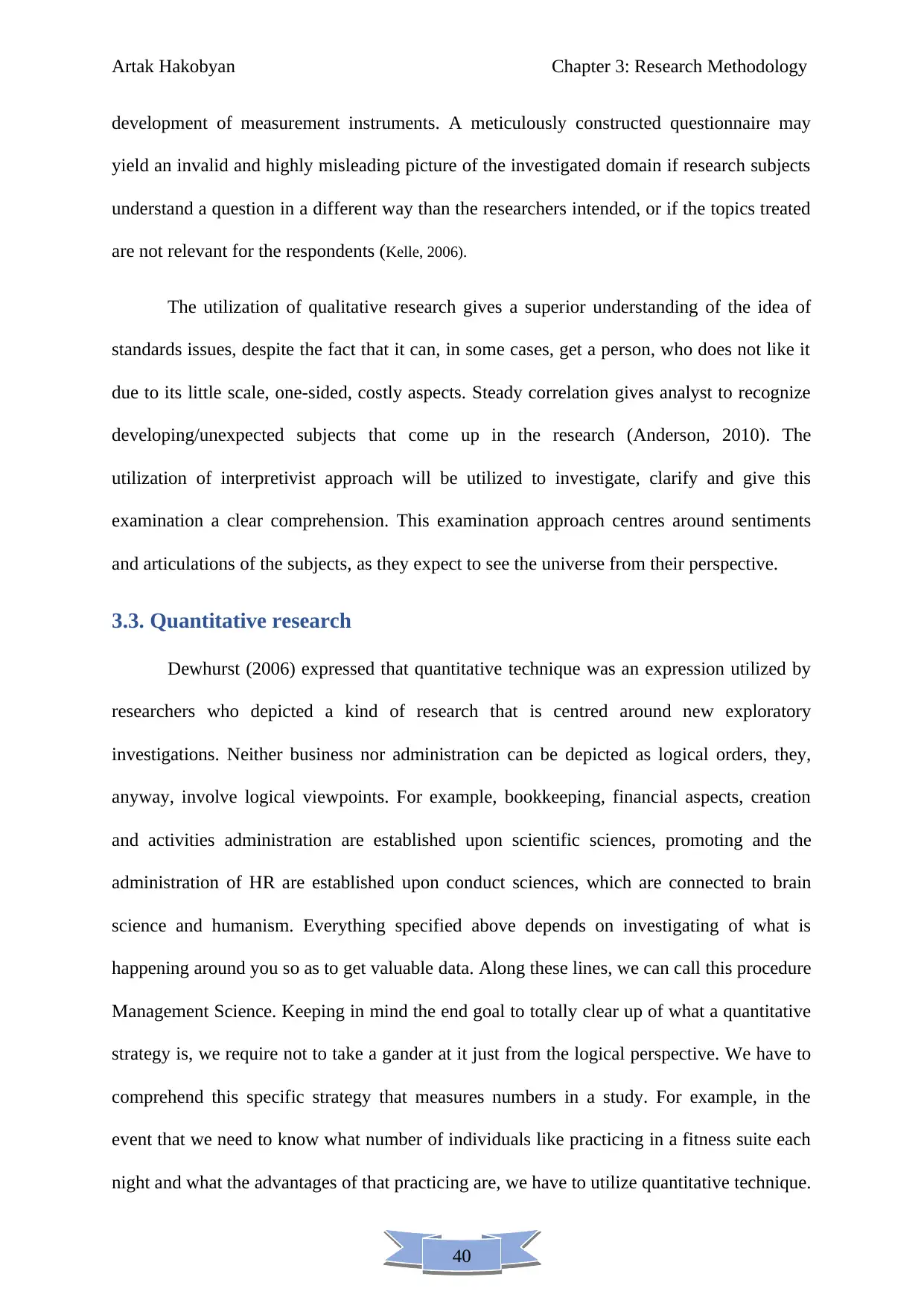
40
Artak Hakobyan Chapter 3: Research Methodology
development of measurement instruments. A meticulously constructed questionnaire may
yield an invalid and highly misleading picture of the investigated domain if research subjects
understand a question in a different way than the researchers intended, or if the topics treated
are not relevant for the respondents (Kelle, 2006).
The utilization of qualitative research gives a superior understanding of the idea of
standards issues, despite the fact that it can, in some cases, get a person, who does not like it
due to its little scale, one-sided, costly aspects. Steady correlation gives analyst to recognize
developing/unexpected subjects that come up in the research (Anderson, 2010). The
utilization of interpretivist approach will be utilized to investigate, clarify and give this
examination a clear comprehension. This examination approach centres around sentiments
and articulations of the subjects, as they expect to see the universe from their perspective.
3.3. Quantitative research
Dewhurst (2006) expressed that quantitative technique was an expression utilized by
researchers who depicted a kind of research that is centred around new exploratory
investigations. Neither business nor administration can be depicted as logical orders, they,
anyway, involve logical viewpoints. For example, bookkeeping, financial aspects, creation
and activities administration are established upon scientific sciences, promoting and the
administration of HR are established upon conduct sciences, which are connected to brain
science and humanism. Everything specified above depends on investigating of what is
happening around you so as to get valuable data. Along these lines, we can call this procedure
Management Science. Keeping in mind the end goal to totally clear up of what a quantitative
strategy is, we require not to take a gander at it just from the logical perspective. We have to
comprehend this specific strategy that measures numbers in a study. For example, in the
event that we need to know what number of individuals like practicing in a fitness suite each
night and what the advantages of that practicing are, we have to utilize quantitative technique.
Artak Hakobyan Chapter 3: Research Methodology
development of measurement instruments. A meticulously constructed questionnaire may
yield an invalid and highly misleading picture of the investigated domain if research subjects
understand a question in a different way than the researchers intended, or if the topics treated
are not relevant for the respondents (Kelle, 2006).
The utilization of qualitative research gives a superior understanding of the idea of
standards issues, despite the fact that it can, in some cases, get a person, who does not like it
due to its little scale, one-sided, costly aspects. Steady correlation gives analyst to recognize
developing/unexpected subjects that come up in the research (Anderson, 2010). The
utilization of interpretivist approach will be utilized to investigate, clarify and give this
examination a clear comprehension. This examination approach centres around sentiments
and articulations of the subjects, as they expect to see the universe from their perspective.
3.3. Quantitative research
Dewhurst (2006) expressed that quantitative technique was an expression utilized by
researchers who depicted a kind of research that is centred around new exploratory
investigations. Neither business nor administration can be depicted as logical orders, they,
anyway, involve logical viewpoints. For example, bookkeeping, financial aspects, creation
and activities administration are established upon scientific sciences, promoting and the
administration of HR are established upon conduct sciences, which are connected to brain
science and humanism. Everything specified above depends on investigating of what is
happening around you so as to get valuable data. Along these lines, we can call this procedure
Management Science. Keeping in mind the end goal to totally clear up of what a quantitative
strategy is, we require not to take a gander at it just from the logical perspective. We have to
comprehend this specific strategy that measures numbers in a study. For example, in the
event that we need to know what number of individuals like practicing in a fitness suite each
night and what the advantages of that practicing are, we have to utilize quantitative technique.
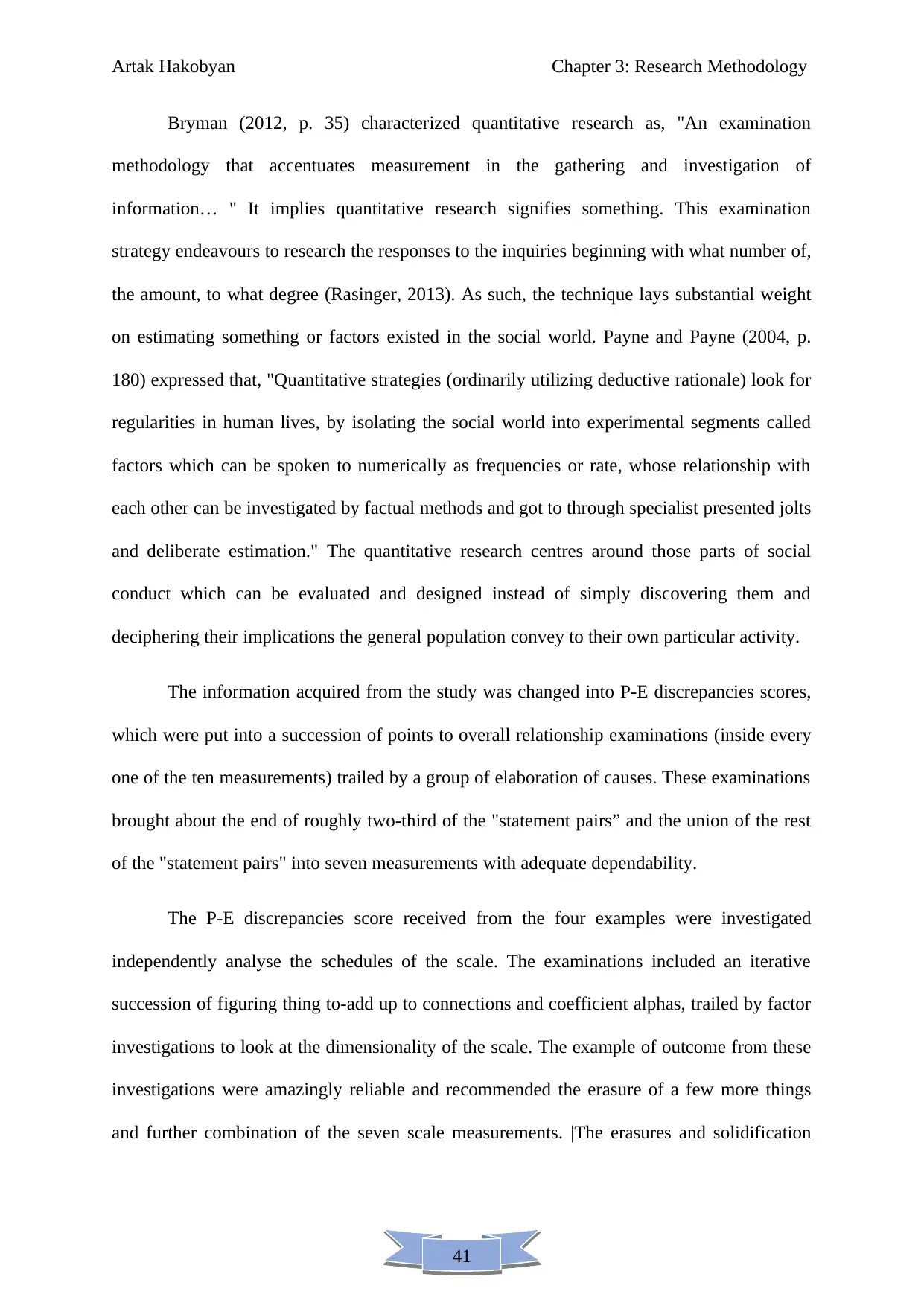
41
Artak Hakobyan Chapter 3: Research Methodology
Bryman (2012, p. 35) characterized quantitative research as, "An examination
methodology that accentuates measurement in the gathering and investigation of
information… " It implies quantitative research signifies something. This examination
strategy endeavours to research the responses to the inquiries beginning with what number of,
the amount, to what degree (Rasinger, 2013). As such, the technique lays substantial weight
on estimating something or factors existed in the social world. Payne and Payne (2004, p.
180) expressed that, "Quantitative strategies (ordinarily utilizing deductive rationale) look for
regularities in human lives, by isolating the social world into experimental segments called
factors which can be spoken to numerically as frequencies or rate, whose relationship with
each other can be investigated by factual methods and got to through specialist presented jolts
and deliberate estimation." The quantitative research centres around those parts of social
conduct which can be evaluated and designed instead of simply discovering them and
deciphering their implications the general population convey to their own particular activity.
The information acquired from the study was changed into P-E discrepancies scores,
which were put into a succession of points to overall relationship examinations (inside every
one of the ten measurements) trailed by a group of elaboration of causes. These examinations
brought about the end of roughly two-third of the "statement pairs” and the union of the rest
of the "statement pairs" into seven measurements with adequate dependability.
The P-E discrepancies score received from the four examples were investigated
independently analyse the schedules of the scale. The examinations included an iterative
succession of figuring thing to-add up to connections and coefficient alphas, trailed by factor
investigations to look at the dimensionality of the scale. The example of outcome from these
investigations were amazingly reliable and recommended the erasure of a few more things
and further combination of the seven scale measurements. |The erasures and solidification
Artak Hakobyan Chapter 3: Research Methodology
Bryman (2012, p. 35) characterized quantitative research as, "An examination
methodology that accentuates measurement in the gathering and investigation of
information… " It implies quantitative research signifies something. This examination
strategy endeavours to research the responses to the inquiries beginning with what number of,
the amount, to what degree (Rasinger, 2013). As such, the technique lays substantial weight
on estimating something or factors existed in the social world. Payne and Payne (2004, p.
180) expressed that, "Quantitative strategies (ordinarily utilizing deductive rationale) look for
regularities in human lives, by isolating the social world into experimental segments called
factors which can be spoken to numerically as frequencies or rate, whose relationship with
each other can be investigated by factual methods and got to through specialist presented jolts
and deliberate estimation." The quantitative research centres around those parts of social
conduct which can be evaluated and designed instead of simply discovering them and
deciphering their implications the general population convey to their own particular activity.
The information acquired from the study was changed into P-E discrepancies scores,
which were put into a succession of points to overall relationship examinations (inside every
one of the ten measurements) trailed by a group of elaboration of causes. These examinations
brought about the end of roughly two-third of the "statement pairs” and the union of the rest
of the "statement pairs" into seven measurements with adequate dependability.
The P-E discrepancies score received from the four examples were investigated
independently analyse the schedules of the scale. The examinations included an iterative
succession of figuring thing to-add up to connections and coefficient alphas, trailed by factor
investigations to look at the dimensionality of the scale. The example of outcome from these
investigations were amazingly reliable and recommended the erasure of a few more things
and further combination of the seven scale measurements. |The erasures and solidification
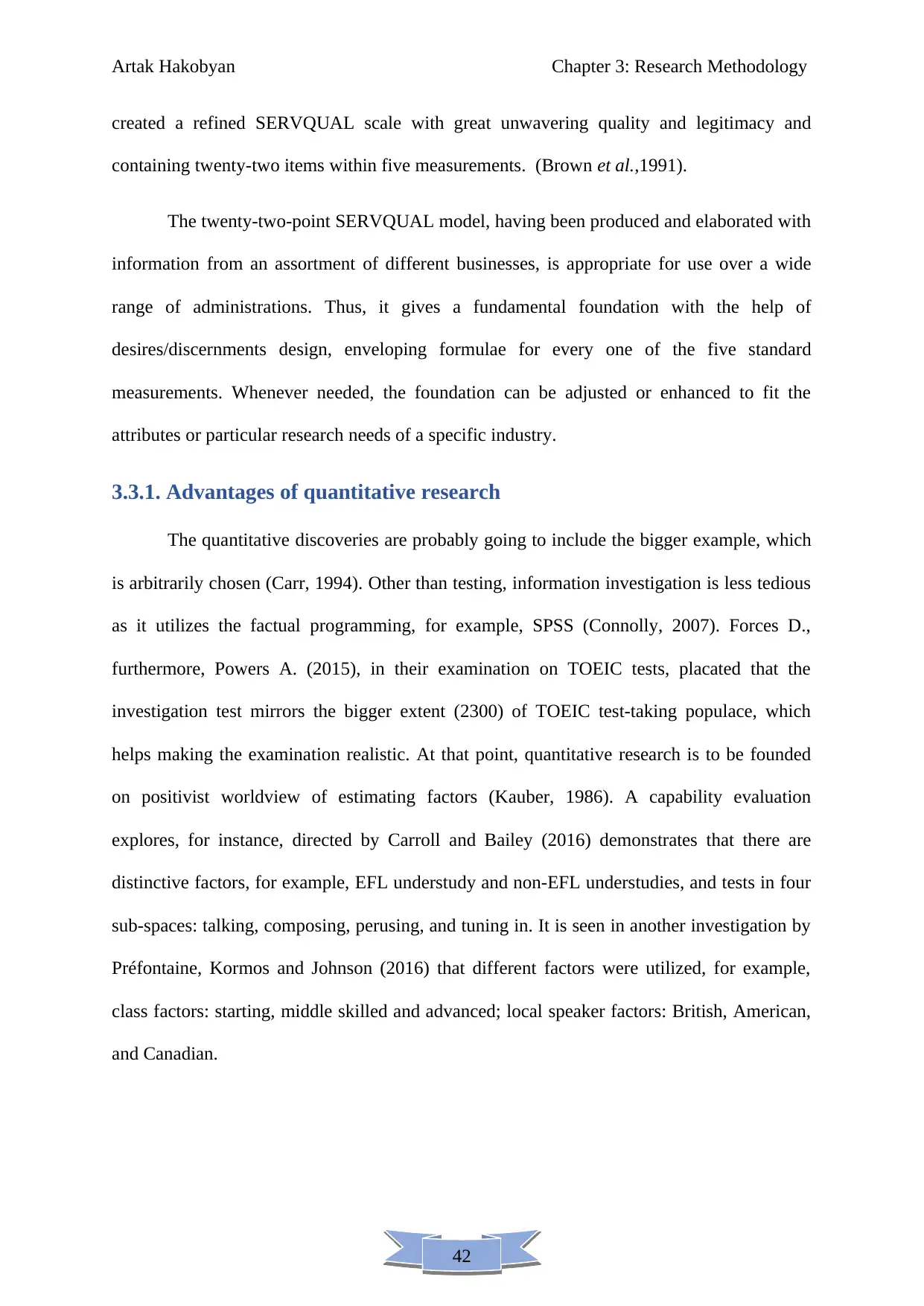
42
Artak Hakobyan Chapter 3: Research Methodology
created a refined SERVQUAL scale with great unwavering quality and legitimacy and
containing twenty-two items within five measurements. (Brown et al.,1991).
The twenty-two-point SERVQUAL model, having been produced and elaborated with
information from an assortment of different businesses, is appropriate for use over a wide
range of administrations. Thus, it gives a fundamental foundation with the help of
desires/discernments design, enveloping formulae for every one of the five standard
measurements. Whenever needed, the foundation can be adjusted or enhanced to fit the
attributes or particular research needs of a specific industry.
3.3.1. Advantages of quantitative research
The quantitative discoveries are probably going to include the bigger example, which
is arbitrarily chosen (Carr, 1994). Other than testing, information investigation is less tedious
as it utilizes the factual programming, for example, SPSS (Connolly, 2007). Forces D.,
furthermore, Powers A. (2015), in their examination on TOEIC tests, placated that the
investigation test mirrors the bigger extent (2300) of TOEIC test-taking populace, which
helps making the examination realistic. At that point, quantitative research is to be founded
on positivist worldview of estimating factors (Kauber, 1986). A capability evaluation
explores, for instance, directed by Carroll and Bailey (2016) demonstrates that there are
distinctive factors, for example, EFL understudy and non-EFL understudies, and tests in four
sub-spaces: talking, composing, perusing, and tuning in. It is seen in another investigation by
Préfontaine, Kormos and Johnson (2016) that different factors were utilized, for example,
class factors: starting, middle skilled and advanced; local speaker factors: British, American,
and Canadian.
Artak Hakobyan Chapter 3: Research Methodology
created a refined SERVQUAL scale with great unwavering quality and legitimacy and
containing twenty-two items within five measurements. (Brown et al.,1991).
The twenty-two-point SERVQUAL model, having been produced and elaborated with
information from an assortment of different businesses, is appropriate for use over a wide
range of administrations. Thus, it gives a fundamental foundation with the help of
desires/discernments design, enveloping formulae for every one of the five standard
measurements. Whenever needed, the foundation can be adjusted or enhanced to fit the
attributes or particular research needs of a specific industry.
3.3.1. Advantages of quantitative research
The quantitative discoveries are probably going to include the bigger example, which
is arbitrarily chosen (Carr, 1994). Other than testing, information investigation is less tedious
as it utilizes the factual programming, for example, SPSS (Connolly, 2007). Forces D.,
furthermore, Powers A. (2015), in their examination on TOEIC tests, placated that the
investigation test mirrors the bigger extent (2300) of TOEIC test-taking populace, which
helps making the examination realistic. At that point, quantitative research is to be founded
on positivist worldview of estimating factors (Kauber, 1986). A capability evaluation
explores, for instance, directed by Carroll and Bailey (2016) demonstrates that there are
distinctive factors, for example, EFL understudy and non-EFL understudies, and tests in four
sub-spaces: talking, composing, perusing, and tuning in. It is seen in another investigation by
Préfontaine, Kormos and Johnson (2016) that different factors were utilized, for example,
class factors: starting, middle skilled and advanced; local speaker factors: British, American,
and Canadian.
Paraphrase This Document
Need a fresh take? Get an instant paraphrase of this document with our AI Paraphraser
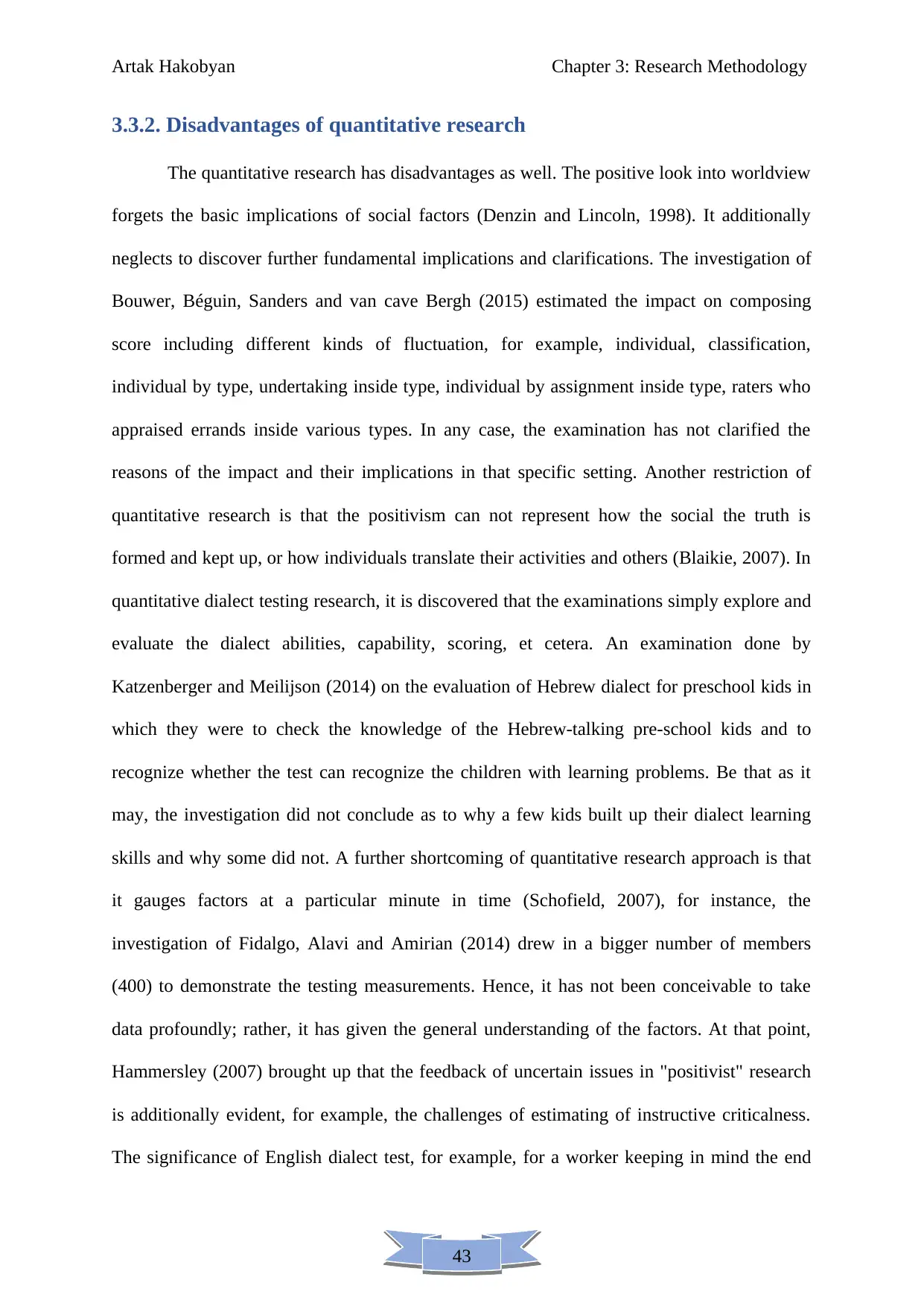
43
Artak Hakobyan Chapter 3: Research Methodology
3.3.2. Disadvantages of quantitative research
The quantitative research has disadvantages as well. The positive look into worldview
forgets the basic implications of social factors (Denzin and Lincoln, 1998). It additionally
neglects to discover further fundamental implications and clarifications. The investigation of
Bouwer, Béguin, Sanders and van cave Bergh (2015) estimated the impact on composing
score including different kinds of fluctuation, for example, individual, classification,
individual by type, undertaking inside type, individual by assignment inside type, raters who
appraised errands inside various types. In any case, the examination has not clarified the
reasons of the impact and their implications in that specific setting. Another restriction of
quantitative research is that the positivism can not represent how the social the truth is
formed and kept up, or how individuals translate their activities and others (Blaikie, 2007). In
quantitative dialect testing research, it is discovered that the examinations simply explore and
evaluate the dialect abilities, capability, scoring, et cetera. An examination done by
Katzenberger and Meilijson (2014) on the evaluation of Hebrew dialect for preschool kids in
which they were to check the knowledge of the Hebrew-talking pre-school kids and to
recognize whether the test can recognize the children with learning problems. Be that as it
may, the investigation did not conclude as to why a few kids built up their dialect learning
skills and why some did not. A further shortcoming of quantitative research approach is that
it gauges factors at a particular minute in time (Schofield, 2007), for instance, the
investigation of Fidalgo, Alavi and Amirian (2014) drew in a bigger number of members
(400) to demonstrate the testing measurements. Hence, it has not been conceivable to take
data profoundly; rather, it has given the general understanding of the factors. At that point,
Hammersley (2007) brought up that the feedback of uncertain issues in "positivist" research
is additionally evident, for example, the challenges of estimating of instructive criticalness.
The significance of English dialect test, for example, for a worker keeping in mind the end
Artak Hakobyan Chapter 3: Research Methodology
3.3.2. Disadvantages of quantitative research
The quantitative research has disadvantages as well. The positive look into worldview
forgets the basic implications of social factors (Denzin and Lincoln, 1998). It additionally
neglects to discover further fundamental implications and clarifications. The investigation of
Bouwer, Béguin, Sanders and van cave Bergh (2015) estimated the impact on composing
score including different kinds of fluctuation, for example, individual, classification,
individual by type, undertaking inside type, individual by assignment inside type, raters who
appraised errands inside various types. In any case, the examination has not clarified the
reasons of the impact and their implications in that specific setting. Another restriction of
quantitative research is that the positivism can not represent how the social the truth is
formed and kept up, or how individuals translate their activities and others (Blaikie, 2007). In
quantitative dialect testing research, it is discovered that the examinations simply explore and
evaluate the dialect abilities, capability, scoring, et cetera. An examination done by
Katzenberger and Meilijson (2014) on the evaluation of Hebrew dialect for preschool kids in
which they were to check the knowledge of the Hebrew-talking pre-school kids and to
recognize whether the test can recognize the children with learning problems. Be that as it
may, the investigation did not conclude as to why a few kids built up their dialect learning
skills and why some did not. A further shortcoming of quantitative research approach is that
it gauges factors at a particular minute in time (Schofield, 2007), for instance, the
investigation of Fidalgo, Alavi and Amirian (2014) drew in a bigger number of members
(400) to demonstrate the testing measurements. Hence, it has not been conceivable to take
data profoundly; rather, it has given the general understanding of the factors. At that point,
Hammersley (2007) brought up that the feedback of uncertain issues in "positivist" research
is additionally evident, for example, the challenges of estimating of instructive criticalness.
The significance of English dialect test, for example, for a worker keeping in mind the end
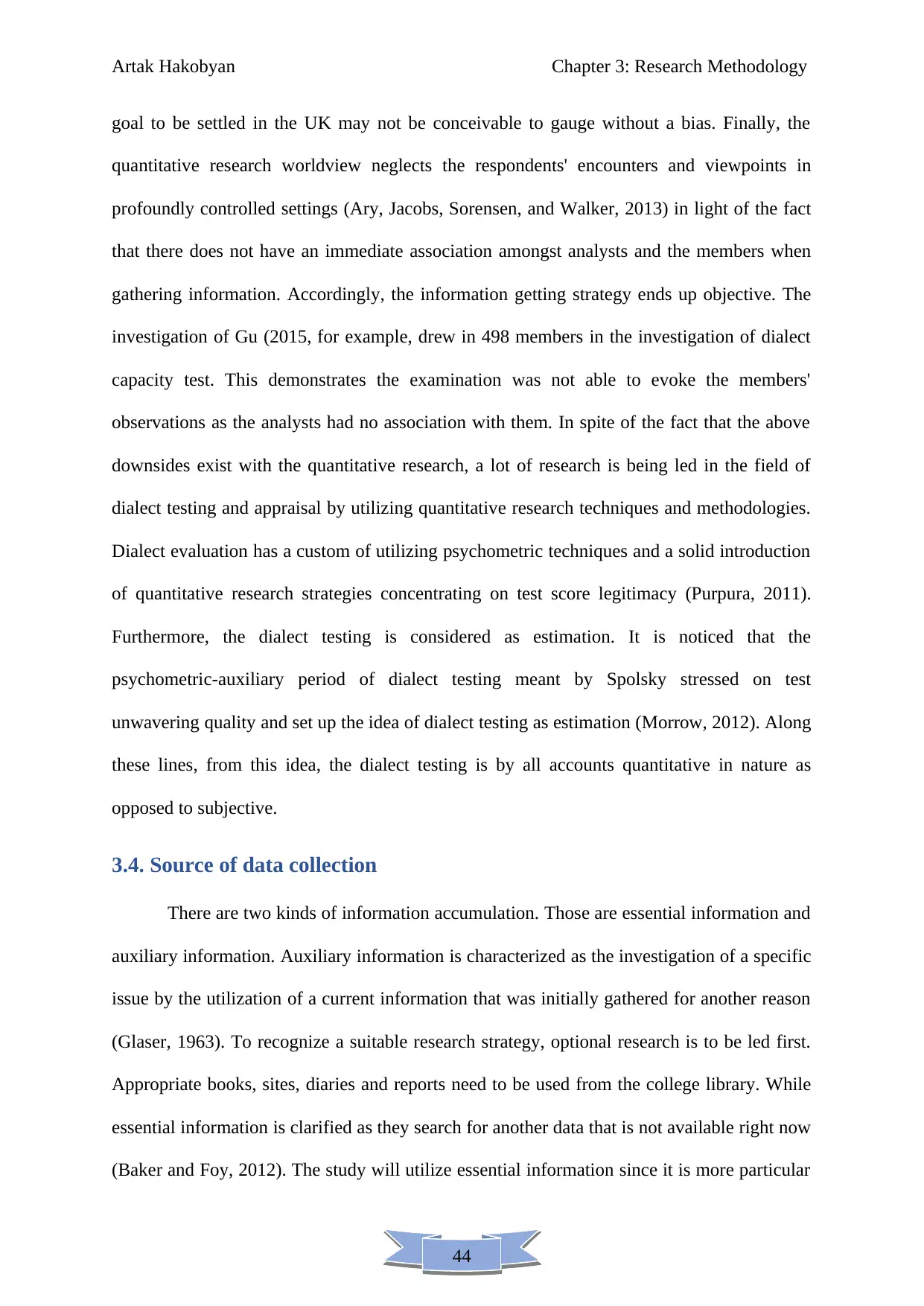
44
Artak Hakobyan Chapter 3: Research Methodology
goal to be settled in the UK may not be conceivable to gauge without a bias. Finally, the
quantitative research worldview neglects the respondents' encounters and viewpoints in
profoundly controlled settings (Ary, Jacobs, Sorensen, and Walker, 2013) in light of the fact
that there does not have an immediate association amongst analysts and the members when
gathering information. Accordingly, the information getting strategy ends up objective. The
investigation of Gu (2015, for example, drew in 498 members in the investigation of dialect
capacity test. This demonstrates the examination was not able to evoke the members'
observations as the analysts had no association with them. In spite of the fact that the above
downsides exist with the quantitative research, a lot of research is being led in the field of
dialect testing and appraisal by utilizing quantitative research techniques and methodologies.
Dialect evaluation has a custom of utilizing psychometric techniques and a solid introduction
of quantitative research strategies concentrating on test score legitimacy (Purpura, 2011).
Furthermore, the dialect testing is considered as estimation. It is noticed that the
psychometric-auxiliary period of dialect testing meant by Spolsky stressed on test
unwavering quality and set up the idea of dialect testing as estimation (Morrow, 2012). Along
these lines, from this idea, the dialect testing is by all accounts quantitative in nature as
opposed to subjective.
3.4. Source of data collection
There are two kinds of information accumulation. Those are essential information and
auxiliary information. Auxiliary information is characterized as the investigation of a specific
issue by the utilization of a current information that was initially gathered for another reason
(Glaser, 1963). To recognize a suitable research strategy, optional research is to be led first.
Appropriate books, sites, diaries and reports need to be used from the college library. While
essential information is clarified as they search for another data that is not available right now
(Baker and Foy, 2012). The study will utilize essential information since it is more particular
Artak Hakobyan Chapter 3: Research Methodology
goal to be settled in the UK may not be conceivable to gauge without a bias. Finally, the
quantitative research worldview neglects the respondents' encounters and viewpoints in
profoundly controlled settings (Ary, Jacobs, Sorensen, and Walker, 2013) in light of the fact
that there does not have an immediate association amongst analysts and the members when
gathering information. Accordingly, the information getting strategy ends up objective. The
investigation of Gu (2015, for example, drew in 498 members in the investigation of dialect
capacity test. This demonstrates the examination was not able to evoke the members'
observations as the analysts had no association with them. In spite of the fact that the above
downsides exist with the quantitative research, a lot of research is being led in the field of
dialect testing and appraisal by utilizing quantitative research techniques and methodologies.
Dialect evaluation has a custom of utilizing psychometric techniques and a solid introduction
of quantitative research strategies concentrating on test score legitimacy (Purpura, 2011).
Furthermore, the dialect testing is considered as estimation. It is noticed that the
psychometric-auxiliary period of dialect testing meant by Spolsky stressed on test
unwavering quality and set up the idea of dialect testing as estimation (Morrow, 2012). Along
these lines, from this idea, the dialect testing is by all accounts quantitative in nature as
opposed to subjective.
3.4. Source of data collection
There are two kinds of information accumulation. Those are essential information and
auxiliary information. Auxiliary information is characterized as the investigation of a specific
issue by the utilization of a current information that was initially gathered for another reason
(Glaser, 1963). To recognize a suitable research strategy, optional research is to be led first.
Appropriate books, sites, diaries and reports need to be used from the college library. While
essential information is clarified as they search for another data that is not available right now
(Baker and Foy, 2012). The study will utilize essential information since it is more particular
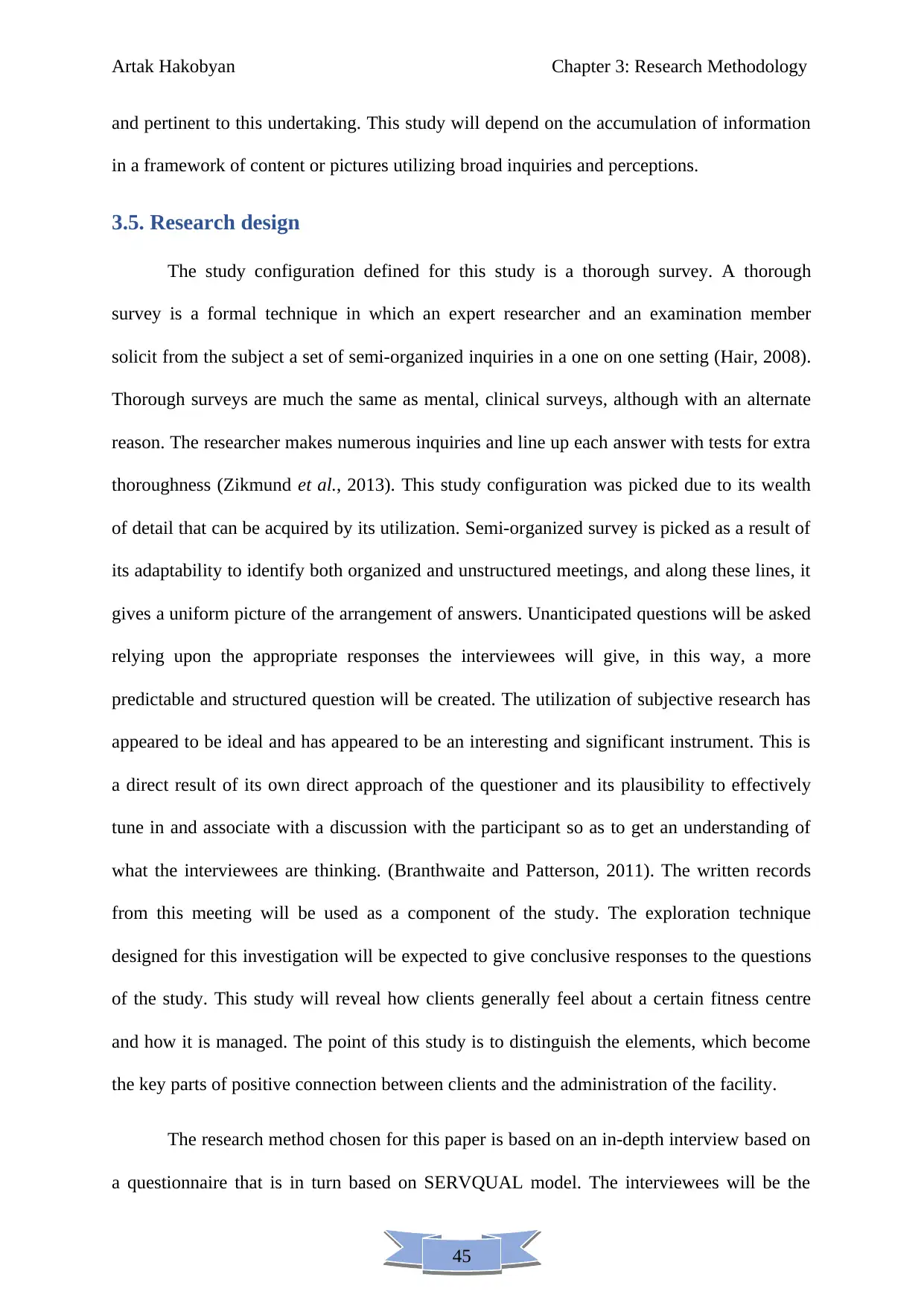
45
Artak Hakobyan Chapter 3: Research Methodology
and pertinent to this undertaking. This study will depend on the accumulation of information
in a framework of content or pictures utilizing broad inquiries and perceptions.
3.5. Research design
The study configuration defined for this study is a thorough survey. A thorough
survey is a formal technique in which an expert researcher and an examination member
solicit from the subject a set of semi-organized inquiries in a one on one setting (Hair, 2008).
Thorough surveys are much the same as mental, clinical surveys, although with an alternate
reason. The researcher makes numerous inquiries and line up each answer with tests for extra
thoroughness (Zikmund et al., 2013). This study configuration was picked due to its wealth
of detail that can be acquired by its utilization. Semi-organized survey is picked as a result of
its adaptability to identify both organized and unstructured meetings, and along these lines, it
gives a uniform picture of the arrangement of answers. Unanticipated questions will be asked
relying upon the appropriate responses the interviewees will give, in this way, a more
predictable and structured question will be created. The utilization of subjective research has
appeared to be ideal and has appeared to be an interesting and significant instrument. This is
a direct result of its own direct approach of the questioner and its plausibility to effectively
tune in and associate with a discussion with the participant so as to get an understanding of
what the interviewees are thinking. (Branthwaite and Patterson, 2011). The written records
from this meeting will be used as a component of the study. The exploration technique
designed for this investigation will be expected to give conclusive responses to the questions
of the study. This study will reveal how clients generally feel about a certain fitness centre
and how it is managed. The point of this study is to distinguish the elements, which become
the key parts of positive connection between clients and the administration of the facility.
The research method chosen for this paper is based on an in-depth interview based on
a questionnaire that is in turn based on SERVQUAL model. The interviewees will be the
Artak Hakobyan Chapter 3: Research Methodology
and pertinent to this undertaking. This study will depend on the accumulation of information
in a framework of content or pictures utilizing broad inquiries and perceptions.
3.5. Research design
The study configuration defined for this study is a thorough survey. A thorough
survey is a formal technique in which an expert researcher and an examination member
solicit from the subject a set of semi-organized inquiries in a one on one setting (Hair, 2008).
Thorough surveys are much the same as mental, clinical surveys, although with an alternate
reason. The researcher makes numerous inquiries and line up each answer with tests for extra
thoroughness (Zikmund et al., 2013). This study configuration was picked due to its wealth
of detail that can be acquired by its utilization. Semi-organized survey is picked as a result of
its adaptability to identify both organized and unstructured meetings, and along these lines, it
gives a uniform picture of the arrangement of answers. Unanticipated questions will be asked
relying upon the appropriate responses the interviewees will give, in this way, a more
predictable and structured question will be created. The utilization of subjective research has
appeared to be ideal and has appeared to be an interesting and significant instrument. This is
a direct result of its own direct approach of the questioner and its plausibility to effectively
tune in and associate with a discussion with the participant so as to get an understanding of
what the interviewees are thinking. (Branthwaite and Patterson, 2011). The written records
from this meeting will be used as a component of the study. The exploration technique
designed for this investigation will be expected to give conclusive responses to the questions
of the study. This study will reveal how clients generally feel about a certain fitness centre
and how it is managed. The point of this study is to distinguish the elements, which become
the key parts of positive connection between clients and the administration of the facility.
The research method chosen for this paper is based on an in-depth interview based on
a questionnaire that is in turn based on SERVQUAL model. The interviewees will be the
Secure Best Marks with AI Grader
Need help grading? Try our AI Grader for instant feedback on your assignments.
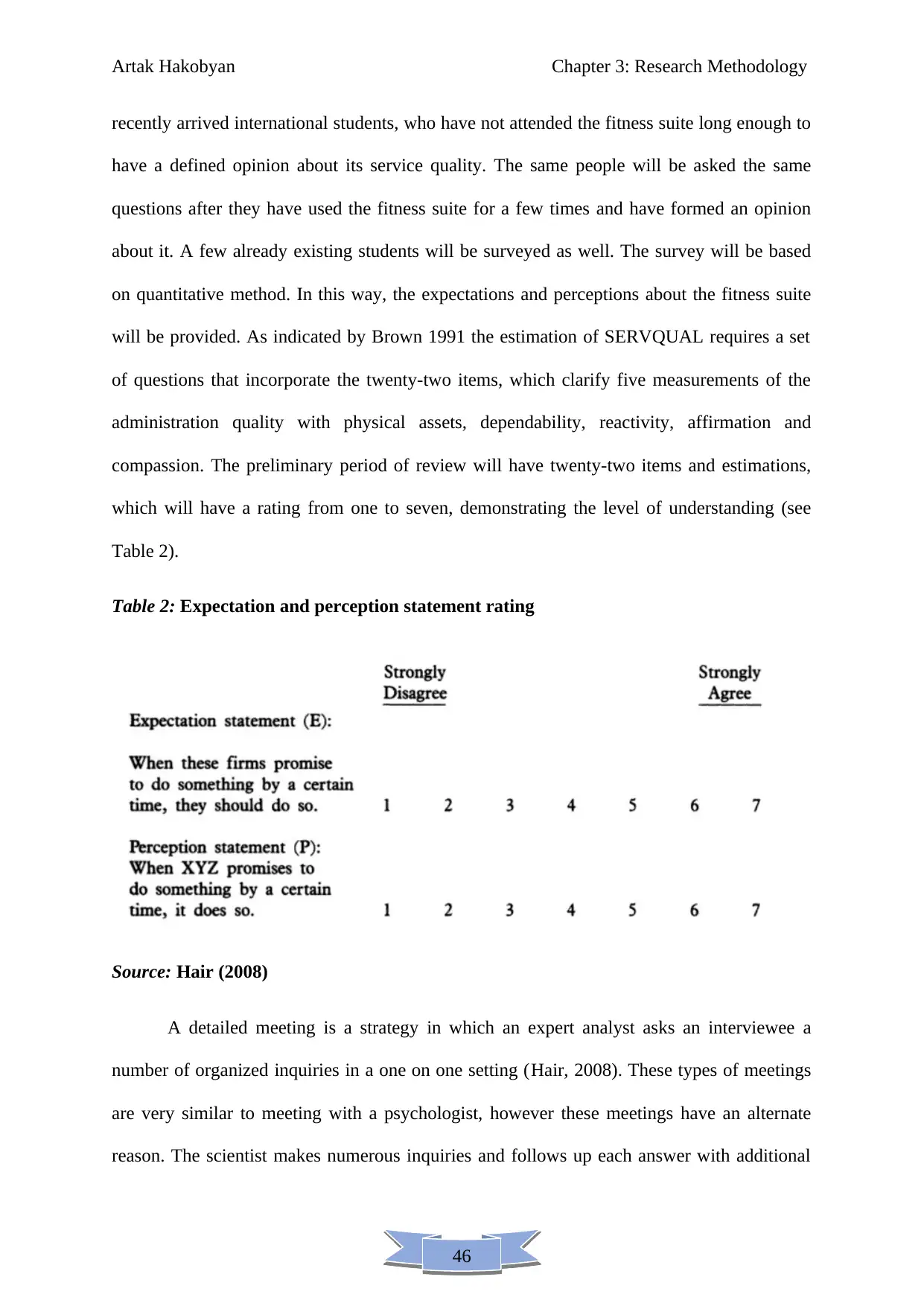
46
Artak Hakobyan Chapter 3: Research Methodology
recently arrived international students, who have not attended the fitness suite long enough to
have a defined opinion about its service quality. The same people will be asked the same
questions after they have used the fitness suite for a few times and have formed an opinion
about it. A few already existing students will be surveyed as well. The survey will be based
on quantitative method. In this way, the expectations and perceptions about the fitness suite
will be provided. As indicated by Brown 1991 the estimation of SERVQUAL requires a set
of questions that incorporate the twenty-two items, which clarify five measurements of the
administration quality with physical assets, dependability, reactivity, affirmation and
compassion. The preliminary period of review will have twenty-two items and estimations,
which will have a rating from one to seven, demonstrating the level of understanding (see
Table 2).
Table 2: Expectation and perception statement rating
Source: Hair (2008)
A detailed meeting is a strategy in which an expert analyst asks an interviewee a
number of organized inquiries in a one on one setting (Hair, 2008). These types of meetings
are very similar to meeting with a psychologist, however these meetings have an alternate
reason. The scientist makes numerous inquiries and follows up each answer with additional
Artak Hakobyan Chapter 3: Research Methodology
recently arrived international students, who have not attended the fitness suite long enough to
have a defined opinion about its service quality. The same people will be asked the same
questions after they have used the fitness suite for a few times and have formed an opinion
about it. A few already existing students will be surveyed as well. The survey will be based
on quantitative method. In this way, the expectations and perceptions about the fitness suite
will be provided. As indicated by Brown 1991 the estimation of SERVQUAL requires a set
of questions that incorporate the twenty-two items, which clarify five measurements of the
administration quality with physical assets, dependability, reactivity, affirmation and
compassion. The preliminary period of review will have twenty-two items and estimations,
which will have a rating from one to seven, demonstrating the level of understanding (see
Table 2).
Table 2: Expectation and perception statement rating
Source: Hair (2008)
A detailed meeting is a strategy in which an expert analyst asks an interviewee a
number of organized inquiries in a one on one setting (Hair, 2008). These types of meetings
are very similar to meeting with a psychologist, however these meetings have an alternate
reason. The scientist makes numerous inquiries and follows up each answer with additional
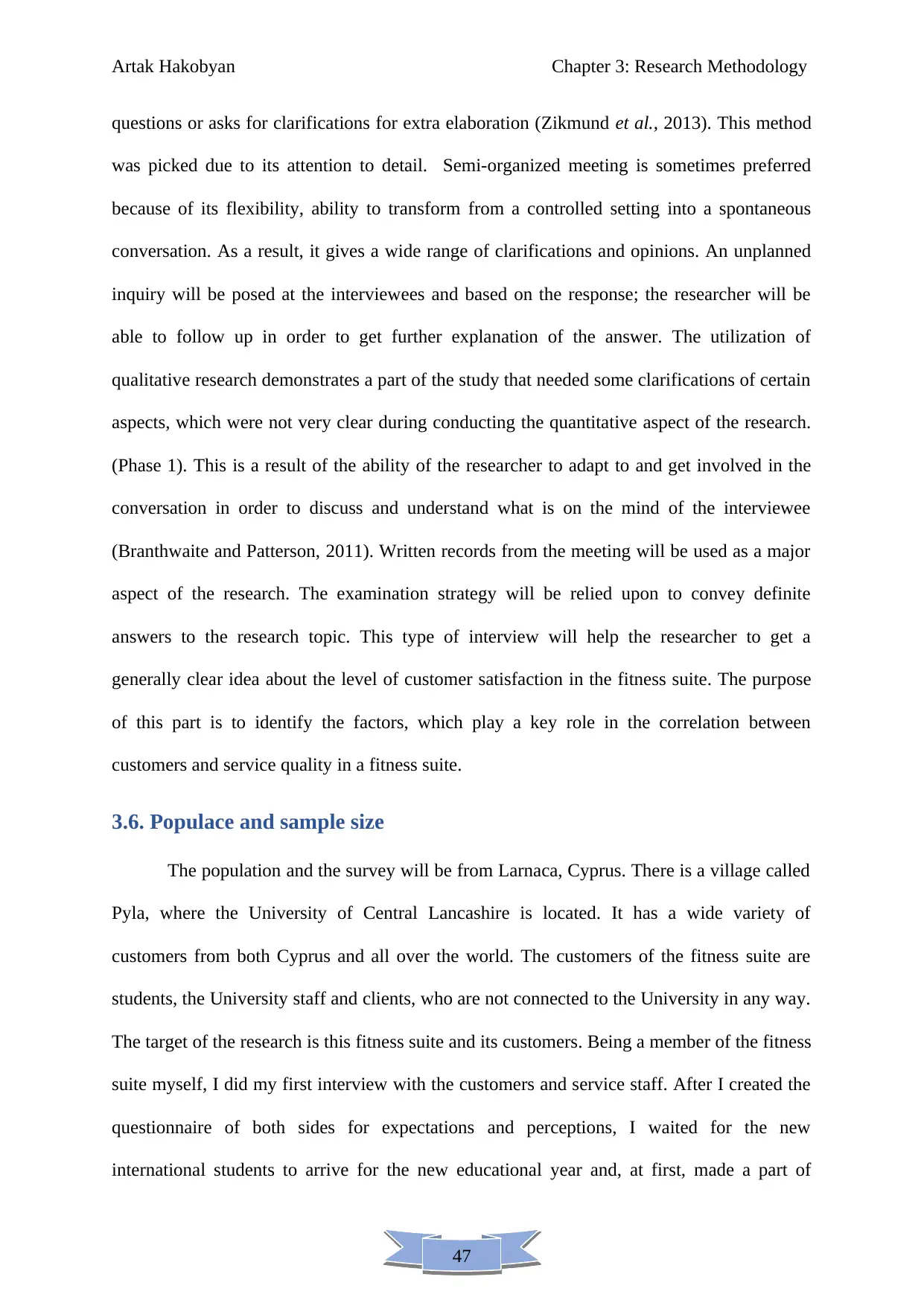
47
Artak Hakobyan Chapter 3: Research Methodology
questions or asks for clarifications for extra elaboration (Zikmund et al., 2013). This method
was picked due to its attention to detail. Semi-organized meeting is sometimes preferred
because of its flexibility, ability to transform from a controlled setting into a spontaneous
conversation. As a result, it gives a wide range of clarifications and opinions. An unplanned
inquiry will be posed at the interviewees and based on the response; the researcher will be
able to follow up in order to get further explanation of the answer. The utilization of
qualitative research demonstrates a part of the study that needed some clarifications of certain
aspects, which were not very clear during conducting the quantitative aspect of the research.
(Phase 1). This is a result of the ability of the researcher to adapt to and get involved in the
conversation in order to discuss and understand what is on the mind of the interviewee
(Branthwaite and Patterson, 2011). Written records from the meeting will be used as a major
aspect of the research. The examination strategy will be relied upon to convey definite
answers to the research topic. This type of interview will help the researcher to get a
generally clear idea about the level of customer satisfaction in the fitness suite. The purpose
of this part is to identify the factors, which play a key role in the correlation between
customers and service quality in a fitness suite.
3.6. Populace and sample size
The population and the survey will be from Larnaca, Cyprus. There is a village called
Pyla, where the University of Central Lancashire is located. It has a wide variety of
customers from both Cyprus and all over the world. The customers of the fitness suite are
students, the University staff and clients, who are not connected to the University in any way.
The target of the research is this fitness suite and its customers. Being a member of the fitness
suite myself, I did my first interview with the customers and service staff. After I created the
questionnaire of both sides for expectations and perceptions, I waited for the new
international students to arrive for the new educational year and, at first, made a part of
Artak Hakobyan Chapter 3: Research Methodology
questions or asks for clarifications for extra elaboration (Zikmund et al., 2013). This method
was picked due to its attention to detail. Semi-organized meeting is sometimes preferred
because of its flexibility, ability to transform from a controlled setting into a spontaneous
conversation. As a result, it gives a wide range of clarifications and opinions. An unplanned
inquiry will be posed at the interviewees and based on the response; the researcher will be
able to follow up in order to get further explanation of the answer. The utilization of
qualitative research demonstrates a part of the study that needed some clarifications of certain
aspects, which were not very clear during conducting the quantitative aspect of the research.
(Phase 1). This is a result of the ability of the researcher to adapt to and get involved in the
conversation in order to discuss and understand what is on the mind of the interviewee
(Branthwaite and Patterson, 2011). Written records from the meeting will be used as a major
aspect of the research. The examination strategy will be relied upon to convey definite
answers to the research topic. This type of interview will help the researcher to get a
generally clear idea about the level of customer satisfaction in the fitness suite. The purpose
of this part is to identify the factors, which play a key role in the correlation between
customers and service quality in a fitness suite.
3.6. Populace and sample size
The population and the survey will be from Larnaca, Cyprus. There is a village called
Pyla, where the University of Central Lancashire is located. It has a wide variety of
customers from both Cyprus and all over the world. The customers of the fitness suite are
students, the University staff and clients, who are not connected to the University in any way.
The target of the research is this fitness suite and its customers. Being a member of the fitness
suite myself, I did my first interview with the customers and service staff. After I created the
questionnaire of both sides for expectations and perceptions, I waited for the new
international students to arrive for the new educational year and, at first, made a part of
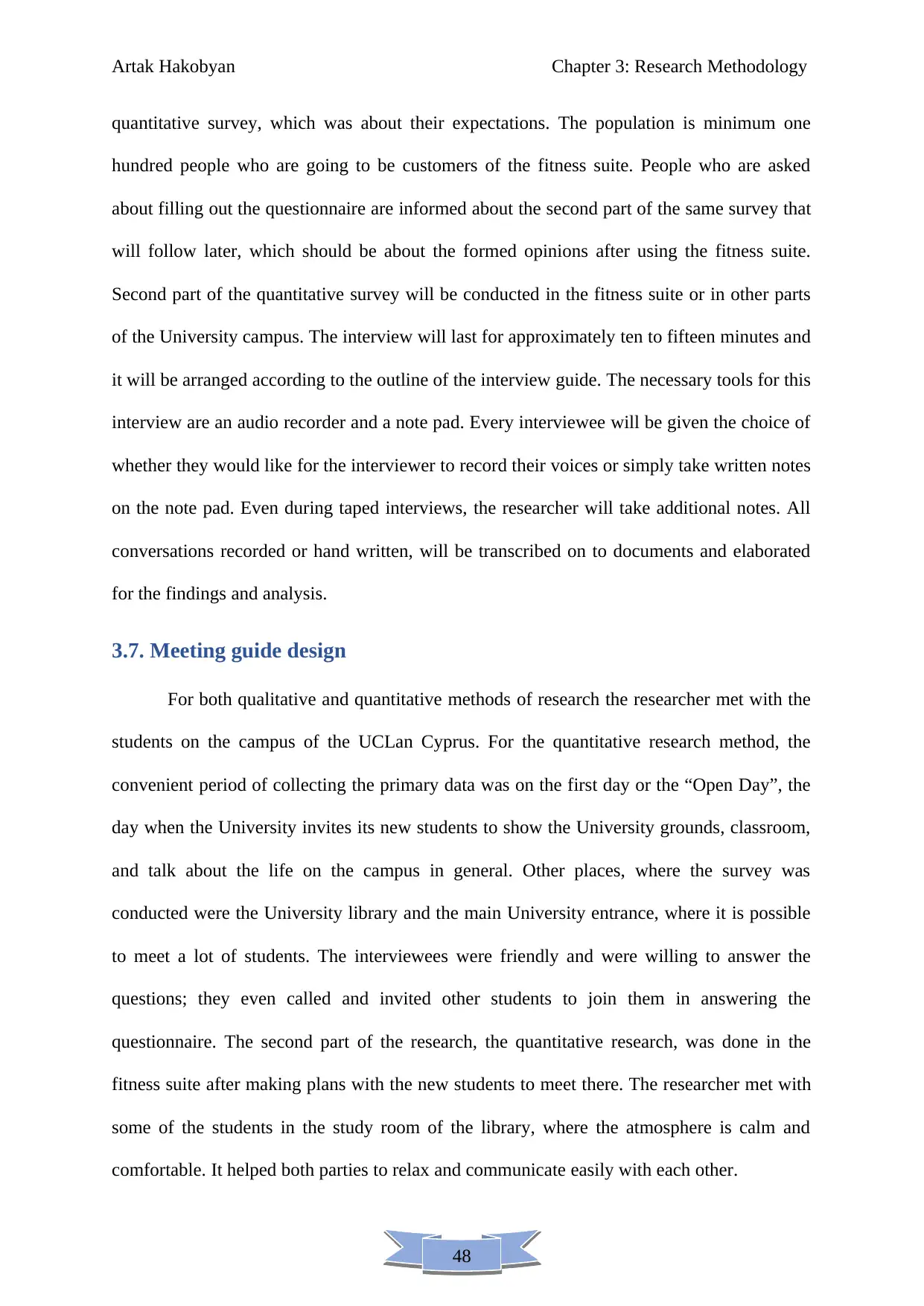
48
Artak Hakobyan Chapter 3: Research Methodology
quantitative survey, which was about their expectations. The population is minimum one
hundred people who are going to be customers of the fitness suite. People who are asked
about filling out the questionnaire are informed about the second part of the same survey that
will follow later, which should be about the formed opinions after using the fitness suite.
Second part of the quantitative survey will be conducted in the fitness suite or in other parts
of the University campus. The interview will last for approximately ten to fifteen minutes and
it will be arranged according to the outline of the interview guide. The necessary tools for this
interview are an audio recorder and a note pad. Every interviewee will be given the choice of
whether they would like for the interviewer to record their voices or simply take written notes
on the note pad. Even during taped interviews, the researcher will take additional notes. All
conversations recorded or hand written, will be transcribed on to documents and elaborated
for the findings and analysis.
3.7. Meeting guide design
For both qualitative and quantitative methods of research the researcher met with the
students on the campus of the UCLan Cyprus. For the quantitative research method, the
convenient period of collecting the primary data was on the first day or the “Open Day”, the
day when the University invites its new students to show the University grounds, classroom,
and talk about the life on the campus in general. Other places, where the survey was
conducted were the University library and the main University entrance, where it is possible
to meet a lot of students. The interviewees were friendly and were willing to answer the
questions; they even called and invited other students to join them in answering the
questionnaire. The second part of the research, the quantitative research, was done in the
fitness suite after making plans with the new students to meet there. The researcher met with
some of the students in the study room of the library, where the atmosphere is calm and
comfortable. It helped both parties to relax and communicate easily with each other.
Artak Hakobyan Chapter 3: Research Methodology
quantitative survey, which was about their expectations. The population is minimum one
hundred people who are going to be customers of the fitness suite. People who are asked
about filling out the questionnaire are informed about the second part of the same survey that
will follow later, which should be about the formed opinions after using the fitness suite.
Second part of the quantitative survey will be conducted in the fitness suite or in other parts
of the University campus. The interview will last for approximately ten to fifteen minutes and
it will be arranged according to the outline of the interview guide. The necessary tools for this
interview are an audio recorder and a note pad. Every interviewee will be given the choice of
whether they would like for the interviewer to record their voices or simply take written notes
on the note pad. Even during taped interviews, the researcher will take additional notes. All
conversations recorded or hand written, will be transcribed on to documents and elaborated
for the findings and analysis.
3.7. Meeting guide design
For both qualitative and quantitative methods of research the researcher met with the
students on the campus of the UCLan Cyprus. For the quantitative research method, the
convenient period of collecting the primary data was on the first day or the “Open Day”, the
day when the University invites its new students to show the University grounds, classroom,
and talk about the life on the campus in general. Other places, where the survey was
conducted were the University library and the main University entrance, where it is possible
to meet a lot of students. The interviewees were friendly and were willing to answer the
questions; they even called and invited other students to join them in answering the
questionnaire. The second part of the research, the quantitative research, was done in the
fitness suite after making plans with the new students to meet there. The researcher met with
some of the students in the study room of the library, where the atmosphere is calm and
comfortable. It helped both parties to relax and communicate easily with each other.
Paraphrase This Document
Need a fresh take? Get an instant paraphrase of this document with our AI Paraphraser
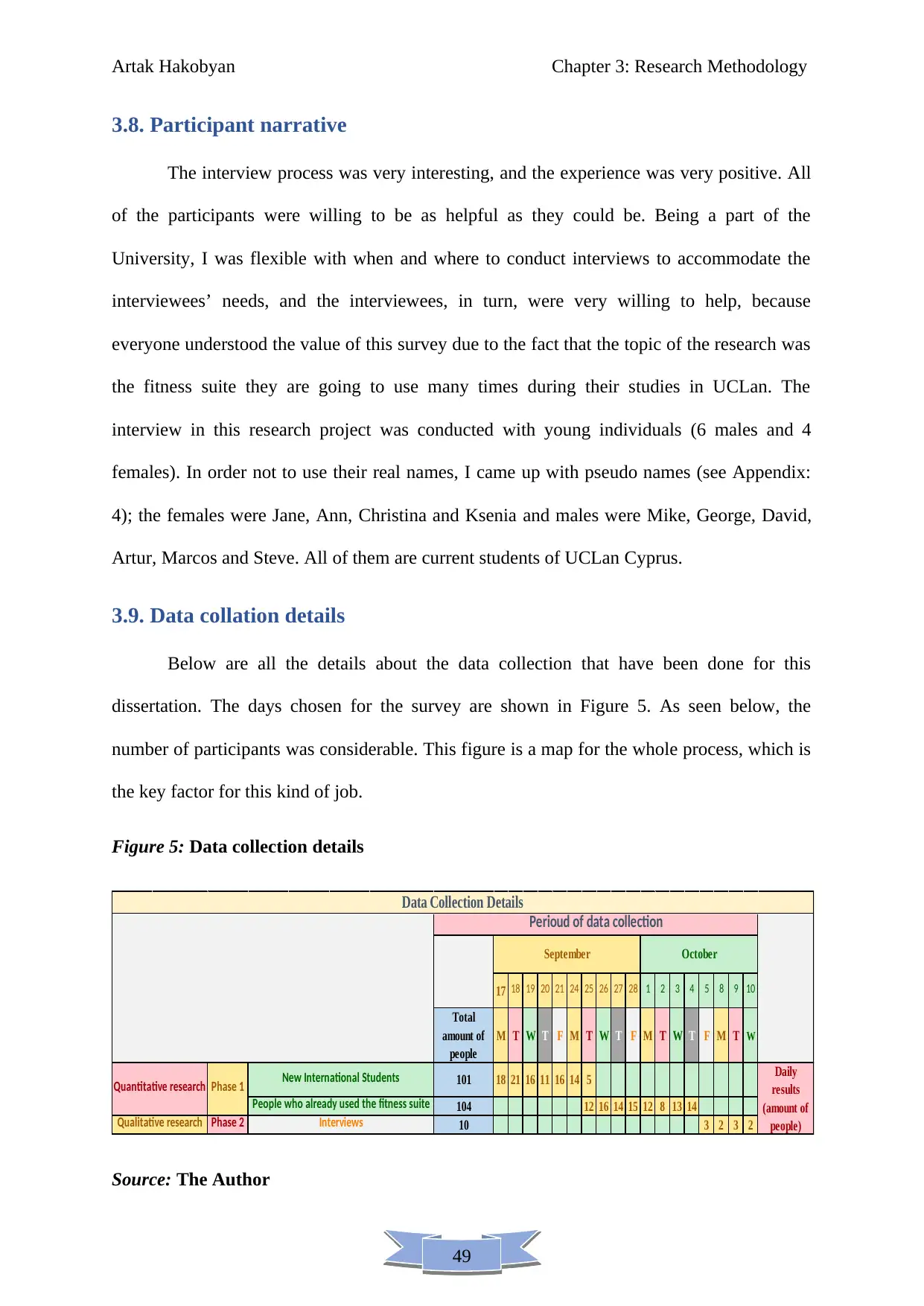
49
Artak Hakobyan Chapter 3: Research Methodology
3.8. Participant narrative
The interview process was very interesting, and the experience was very positive. All
of the participants were willing to be as helpful as they could be. Being a part of the
University, I was flexible with when and where to conduct interviews to accommodate the
interviewees’ needs, and the interviewees, in turn, were very willing to help, because
everyone understood the value of this survey due to the fact that the topic of the research was
the fitness suite they are going to use many times during their studies in UCLan. The
interview in this research project was conducted with young individuals (6 males and 4
females). In order not to use their real names, I came up with pseudo names (see Appendix:
4); the females were Jane, Ann, Christina and Ksenia and males were Mike, George, David,
Artur, Marcos and Steve. All of them are current students of UCLan Cyprus.
3.9. Data collation details
Below are all the details about the data collection that have been done for this
dissertation. The days chosen for the survey are shown in Figure 5. As seen below, the
number of participants was considerable. This figure is a map for the whole process, which is
the key factor for this kind of job.
Figure 5: Data collection details
17 18 19 20 21 24 25 26 27 28 1 2 3 4 5 8 9 10
Total
amount of
people
M T W T F M T W T F M T W T F M T W
101 18 21 16 11 16 14 5
104 12 16 14 15 12 8 13 14
Phase 2 10 3 2 3 2
September October
Daily
results
(amount of
people)
Data Collection Details
People who already used the fitness suite
New International Students
Interviews
Phase 1Quantitative research
Qualitative research
Perioud of data collection
Source: The Author
Artak Hakobyan Chapter 3: Research Methodology
3.8. Participant narrative
The interview process was very interesting, and the experience was very positive. All
of the participants were willing to be as helpful as they could be. Being a part of the
University, I was flexible with when and where to conduct interviews to accommodate the
interviewees’ needs, and the interviewees, in turn, were very willing to help, because
everyone understood the value of this survey due to the fact that the topic of the research was
the fitness suite they are going to use many times during their studies in UCLan. The
interview in this research project was conducted with young individuals (6 males and 4
females). In order not to use their real names, I came up with pseudo names (see Appendix:
4); the females were Jane, Ann, Christina and Ksenia and males were Mike, George, David,
Artur, Marcos and Steve. All of them are current students of UCLan Cyprus.
3.9. Data collation details
Below are all the details about the data collection that have been done for this
dissertation. The days chosen for the survey are shown in Figure 5. As seen below, the
number of participants was considerable. This figure is a map for the whole process, which is
the key factor for this kind of job.
Figure 5: Data collection details
17 18 19 20 21 24 25 26 27 28 1 2 3 4 5 8 9 10
Total
amount of
people
M T W T F M T W T F M T W T F M T W
101 18 21 16 11 16 14 5
104 12 16 14 15 12 8 13 14
Phase 2 10 3 2 3 2
September October
Daily
results
(amount of
people)
Data Collection Details
People who already used the fitness suite
New International Students
Interviews
Phase 1Quantitative research
Qualitative research
Perioud of data collection
Source: The Author
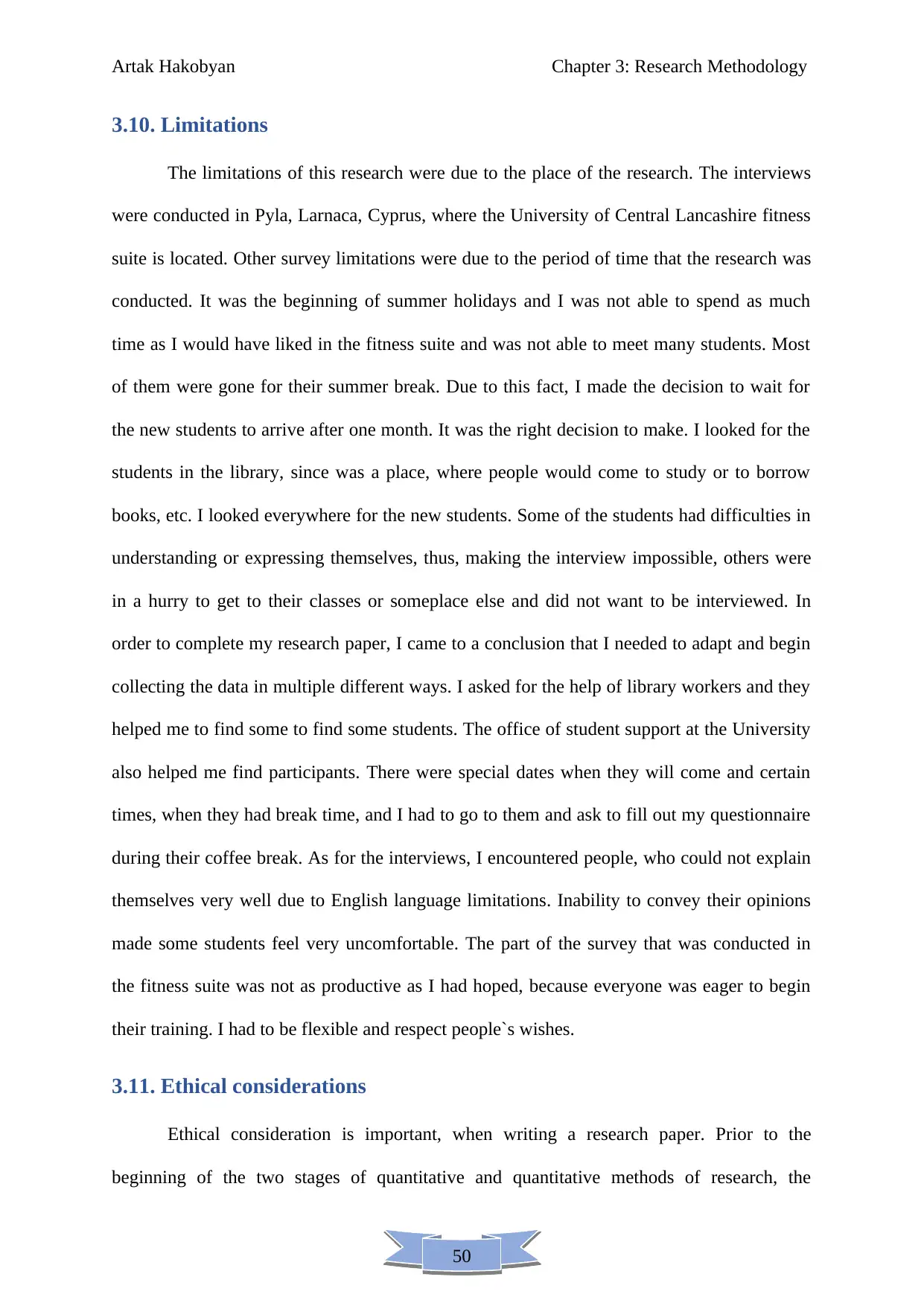
50
Artak Hakobyan Chapter 3: Research Methodology
3.10. Limitations
The limitations of this research were due to the place of the research. The interviews
were conducted in Pyla, Larnaca, Cyprus, where the University of Central Lancashire fitness
suite is located. Other survey limitations were due to the period of time that the research was
conducted. It was the beginning of summer holidays and I was not able to spend as much
time as I would have liked in the fitness suite and was not able to meet many students. Most
of them were gone for their summer break. Due to this fact, I made the decision to wait for
the new students to arrive after one month. It was the right decision to make. I looked for the
students in the library, since was a place, where people would come to study or to borrow
books, etc. I looked everywhere for the new students. Some of the students had difficulties in
understanding or expressing themselves, thus, making the interview impossible, others were
in a hurry to get to their classes or someplace else and did not want to be interviewed. In
order to complete my research paper, I came to a conclusion that I needed to adapt and begin
collecting the data in multiple different ways. I asked for the help of library workers and they
helped me to find some to find some students. The office of student support at the University
also helped me find participants. There were special dates when they will come and certain
times, when they had break time, and I had to go to them and ask to fill out my questionnaire
during their coffee break. As for the interviews, I encountered people, who could not explain
themselves very well due to English language limitations. Inability to convey their opinions
made some students feel very uncomfortable. The part of the survey that was conducted in
the fitness suite was not as productive as I had hoped, because everyone was eager to begin
their training. I had to be flexible and respect people`s wishes.
3.11. Ethical considerations
Ethical consideration is important, when writing a research paper. Prior to the
beginning of the two stages of quantitative and quantitative methods of research, the
Artak Hakobyan Chapter 3: Research Methodology
3.10. Limitations
The limitations of this research were due to the place of the research. The interviews
were conducted in Pyla, Larnaca, Cyprus, where the University of Central Lancashire fitness
suite is located. Other survey limitations were due to the period of time that the research was
conducted. It was the beginning of summer holidays and I was not able to spend as much
time as I would have liked in the fitness suite and was not able to meet many students. Most
of them were gone for their summer break. Due to this fact, I made the decision to wait for
the new students to arrive after one month. It was the right decision to make. I looked for the
students in the library, since was a place, where people would come to study or to borrow
books, etc. I looked everywhere for the new students. Some of the students had difficulties in
understanding or expressing themselves, thus, making the interview impossible, others were
in a hurry to get to their classes or someplace else and did not want to be interviewed. In
order to complete my research paper, I came to a conclusion that I needed to adapt and begin
collecting the data in multiple different ways. I asked for the help of library workers and they
helped me to find some to find some students. The office of student support at the University
also helped me find participants. There were special dates when they will come and certain
times, when they had break time, and I had to go to them and ask to fill out my questionnaire
during their coffee break. As for the interviews, I encountered people, who could not explain
themselves very well due to English language limitations. Inability to convey their opinions
made some students feel very uncomfortable. The part of the survey that was conducted in
the fitness suite was not as productive as I had hoped, because everyone was eager to begin
their training. I had to be flexible and respect people`s wishes.
3.11. Ethical considerations
Ethical consideration is important, when writing a research paper. Prior to the
beginning of the two stages of quantitative and quantitative methods of research, the
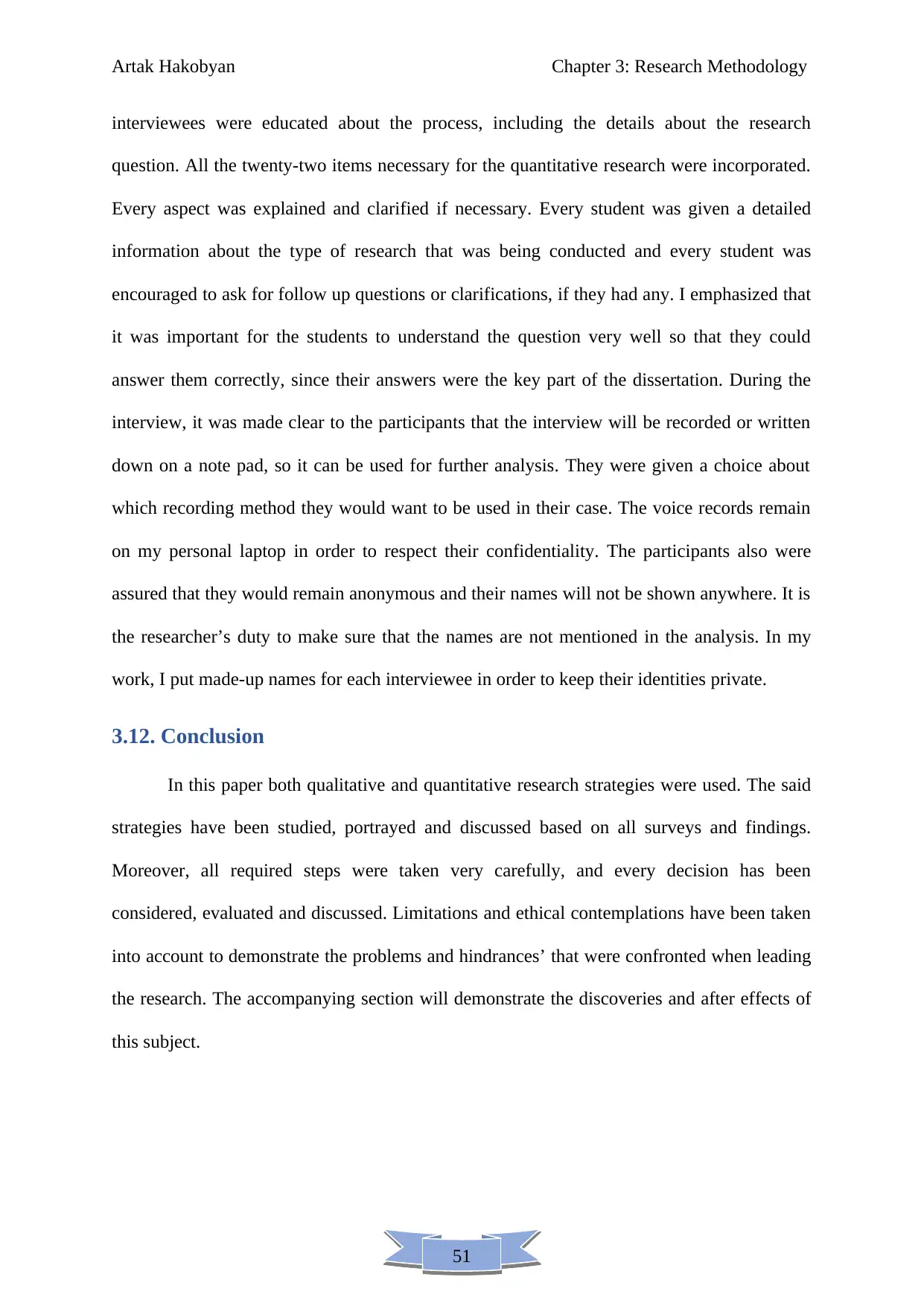
51
Artak Hakobyan Chapter 3: Research Methodology
interviewees were educated about the process, including the details about the research
question. All the twenty-two items necessary for the quantitative research were incorporated.
Every aspect was explained and clarified if necessary. Every student was given a detailed
information about the type of research that was being conducted and every student was
encouraged to ask for follow up questions or clarifications, if they had any. I emphasized that
it was important for the students to understand the question very well so that they could
answer them correctly, since their answers were the key part of the dissertation. During the
interview, it was made clear to the participants that the interview will be recorded or written
down on a note pad, so it can be used for further analysis. They were given a choice about
which recording method they would want to be used in their case. The voice records remain
on my personal laptop in order to respect their confidentiality. The participants also were
assured that they would remain anonymous and their names will not be shown anywhere. It is
the researcher’s duty to make sure that the names are not mentioned in the analysis. In my
work, I put made-up names for each interviewee in order to keep their identities private.
3.12. Conclusion
In this paper both qualitative and quantitative research strategies were used. The said
strategies have been studied, portrayed and discussed based on all surveys and findings.
Moreover, all required steps were taken very carefully, and every decision has been
considered, evaluated and discussed. Limitations and ethical contemplations have been taken
into account to demonstrate the problems and hindrances’ that were confronted when leading
the research. The accompanying section will demonstrate the discoveries and after effects of
this subject.
Artak Hakobyan Chapter 3: Research Methodology
interviewees were educated about the process, including the details about the research
question. All the twenty-two items necessary for the quantitative research were incorporated.
Every aspect was explained and clarified if necessary. Every student was given a detailed
information about the type of research that was being conducted and every student was
encouraged to ask for follow up questions or clarifications, if they had any. I emphasized that
it was important for the students to understand the question very well so that they could
answer them correctly, since their answers were the key part of the dissertation. During the
interview, it was made clear to the participants that the interview will be recorded or written
down on a note pad, so it can be used for further analysis. They were given a choice about
which recording method they would want to be used in their case. The voice records remain
on my personal laptop in order to respect their confidentiality. The participants also were
assured that they would remain anonymous and their names will not be shown anywhere. It is
the researcher’s duty to make sure that the names are not mentioned in the analysis. In my
work, I put made-up names for each interviewee in order to keep their identities private.
3.12. Conclusion
In this paper both qualitative and quantitative research strategies were used. The said
strategies have been studied, portrayed and discussed based on all surveys and findings.
Moreover, all required steps were taken very carefully, and every decision has been
considered, evaluated and discussed. Limitations and ethical contemplations have been taken
into account to demonstrate the problems and hindrances’ that were confronted when leading
the research. The accompanying section will demonstrate the discoveries and after effects of
this subject.
Secure Best Marks with AI Grader
Need help grading? Try our AI Grader for instant feedback on your assignments.
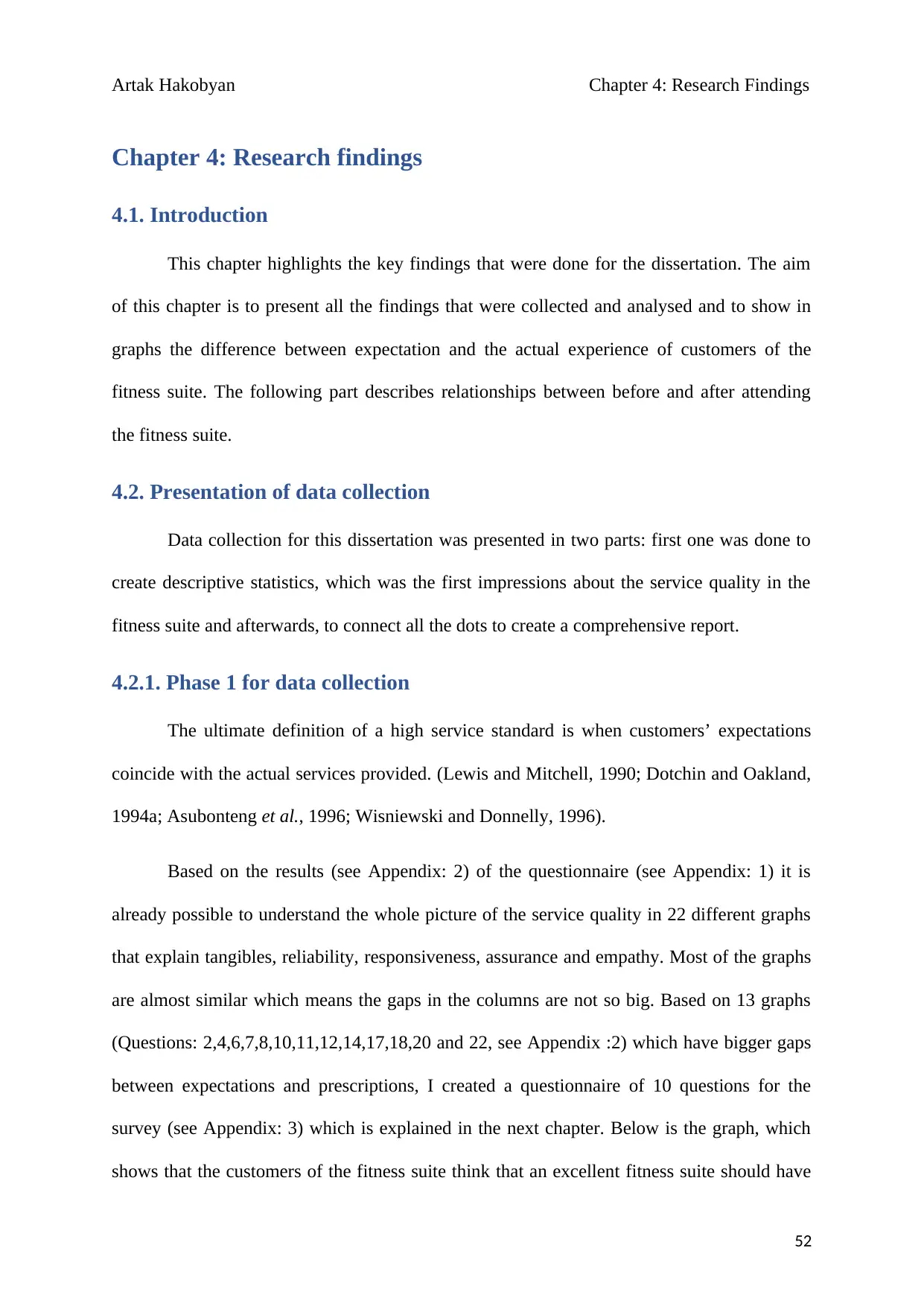
Artak Hakobyan Chapter 4: Research Findings
Chapter 4: Research findings
4.1. Introduction
This chapter highlights the key findings that were done for the dissertation. The aim
of this chapter is to present all the findings that were collected and analysed and to show in
graphs the difference between expectation and the actual experience of customers of the
fitness suite. The following part describes relationships between before and after attending
the fitness suite.
4.2. Presentation of data collection
Data collection for this dissertation was presented in two parts: first one was done to
create descriptive statistics, which was the first impressions about the service quality in the
fitness suite and afterwards, to connect all the dots to create a comprehensive report.
4.2.1. Phase 1 for data collection
The ultimate definition of a high service standard is when customers’ expectations
coincide with the actual services provided. (Lewis and Mitchell, 1990; Dotchin and Oakland,
1994a; Asubonteng et al., 1996; Wisniewski and Donnelly, 1996).
Based on the results (see Appendix: 2) of the questionnaire (see Appendix: 1) it is
already possible to understand the whole picture of the service quality in 22 different graphs
that explain tangibles, reliability, responsiveness, assurance and empathy. Most of the graphs
are almost similar which means the gaps in the columns are not so big. Based on 13 graphs
(Questions: 2,4,6,7,8,10,11,12,14,17,18,20 and 22, see Appendix :2) which have bigger gaps
between expectations and prescriptions, I created a questionnaire of 10 questions for the
survey (see Appendix: 3) which is explained in the next chapter. Below is the graph, which
shows that the customers of the fitness suite think that an excellent fitness suite should have
52
Chapter 4: Research findings
4.1. Introduction
This chapter highlights the key findings that were done for the dissertation. The aim
of this chapter is to present all the findings that were collected and analysed and to show in
graphs the difference between expectation and the actual experience of customers of the
fitness suite. The following part describes relationships between before and after attending
the fitness suite.
4.2. Presentation of data collection
Data collection for this dissertation was presented in two parts: first one was done to
create descriptive statistics, which was the first impressions about the service quality in the
fitness suite and afterwards, to connect all the dots to create a comprehensive report.
4.2.1. Phase 1 for data collection
The ultimate definition of a high service standard is when customers’ expectations
coincide with the actual services provided. (Lewis and Mitchell, 1990; Dotchin and Oakland,
1994a; Asubonteng et al., 1996; Wisniewski and Donnelly, 1996).
Based on the results (see Appendix: 2) of the questionnaire (see Appendix: 1) it is
already possible to understand the whole picture of the service quality in 22 different graphs
that explain tangibles, reliability, responsiveness, assurance and empathy. Most of the graphs
are almost similar which means the gaps in the columns are not so big. Based on 13 graphs
(Questions: 2,4,6,7,8,10,11,12,14,17,18,20 and 22, see Appendix :2) which have bigger gaps
between expectations and prescriptions, I created a questionnaire of 10 questions for the
survey (see Appendix: 3) which is explained in the next chapter. Below is the graph, which
shows that the customers of the fitness suite think that an excellent fitness suite should have
52
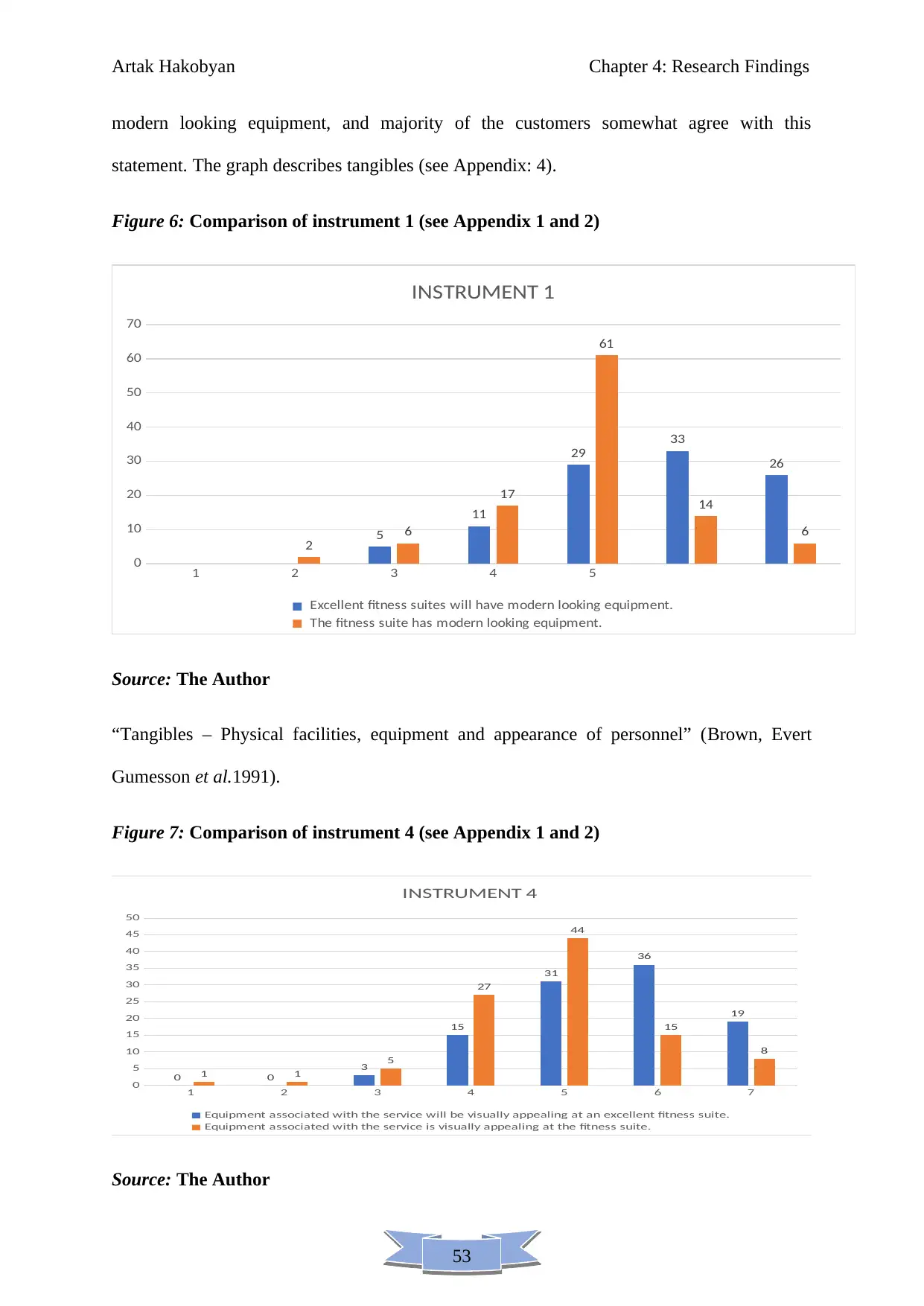
53
Artak Hakobyan Chapter 4: Research Findings
modern looking equipment, and majority of the customers somewhat agree with this
statement. The graph describes tangibles (see Appendix: 4).
Figure 6: Comparison of instrument 1 (see Appendix 1 and 2)
1 2 3 4 5
0
10
20
30
40
50
60
70
2
6
17
61
14
65
11
29
33
26
INSTRUMENT 1
Excellent fitness suites will have modern looking equipment.
The fitness suite has modern looking equipment.
Source: The Author
“Tangibles – Physical facilities, equipment and appearance of personnel” (Brown, Evert
Gumesson et al.1991).
Figure 7: Comparison of instrument 4 (see Appendix 1 and 2)
1 2 3 4 5 6 7
0
5
10
15
20
25
30
35
40
45
50
0 0
3
15
31
36
19
1 1
5
27
44
15
8
INSTRUMENT 4
Equipment associated with the service will be visually appealing at an excellent fitness suite.
Equipment associated with the service is visually appealing at the fitness suite.
Source: The Author
Artak Hakobyan Chapter 4: Research Findings
modern looking equipment, and majority of the customers somewhat agree with this
statement. The graph describes tangibles (see Appendix: 4).
Figure 6: Comparison of instrument 1 (see Appendix 1 and 2)
1 2 3 4 5
0
10
20
30
40
50
60
70
2
6
17
61
14
65
11
29
33
26
INSTRUMENT 1
Excellent fitness suites will have modern looking equipment.
The fitness suite has modern looking equipment.
Source: The Author
“Tangibles – Physical facilities, equipment and appearance of personnel” (Brown, Evert
Gumesson et al.1991).
Figure 7: Comparison of instrument 4 (see Appendix 1 and 2)
1 2 3 4 5 6 7
0
5
10
15
20
25
30
35
40
45
50
0 0
3
15
31
36
19
1 1
5
27
44
15
8
INSTRUMENT 4
Equipment associated with the service will be visually appealing at an excellent fitness suite.
Equipment associated with the service is visually appealing at the fitness suite.
Source: The Author
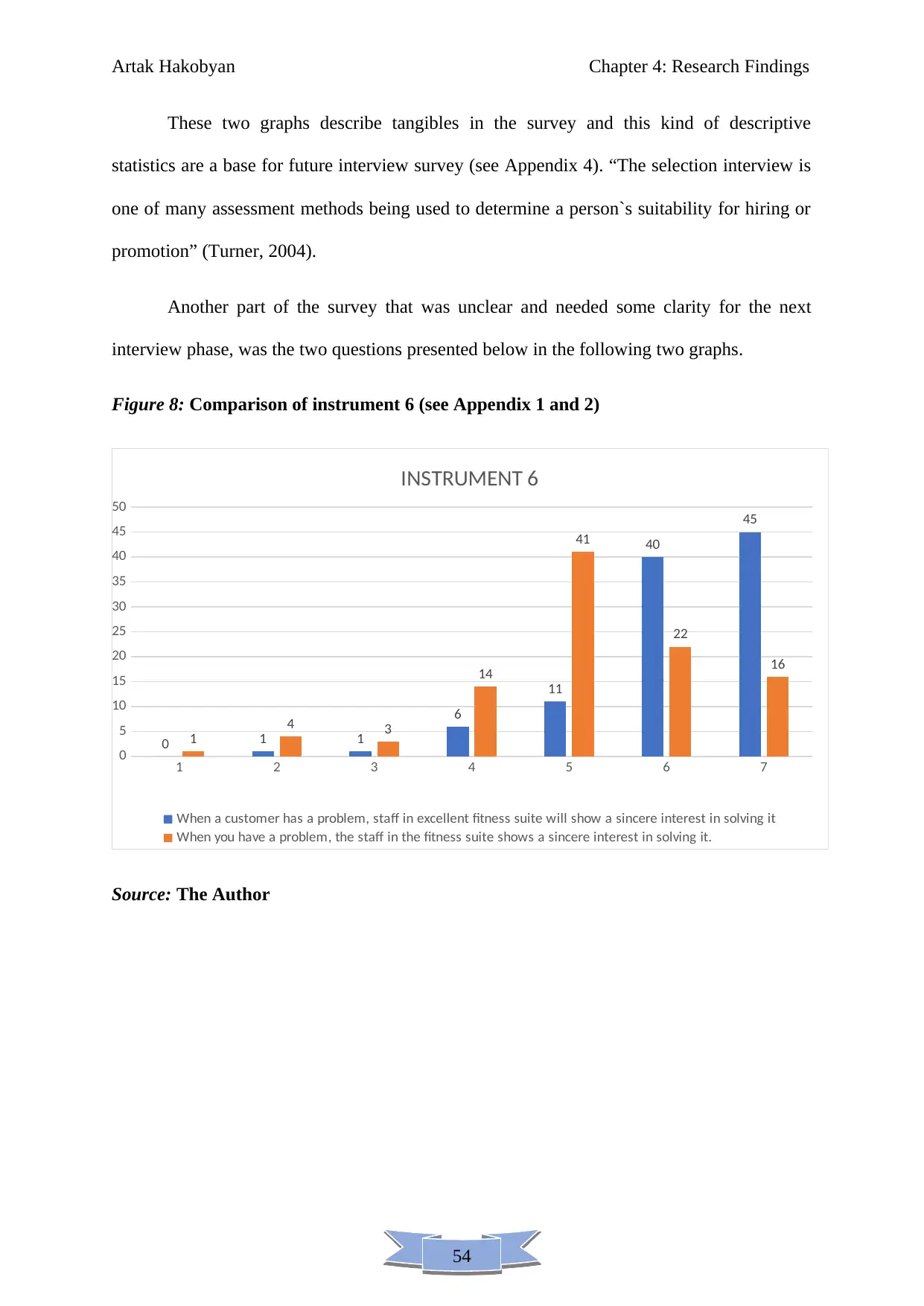
54
Artak Hakobyan Chapter 4: Research Findings
These two graphs describe tangibles in the survey and this kind of descriptive
statistics are a base for future interview survey (see Appendix 4). “The selection interview is
one of many assessment methods being used to determine a person`s suitability for hiring or
promotion” (Turner, 2004).
Another part of the survey that was unclear and needed some clarity for the next
interview phase, was the two questions presented below in the following two graphs.
Figure 8: Comparison of instrument 6 (see Appendix 1 and 2)
1 2 3 4 5 6 7
0
5
10
15
20
25
30
35
40
45
50
0 1 1
6
11
40
45
1
4 3
14
41
22
16
INSTRUMENT 6
When a customer has a problem, staff in excellent fitness suite will show a sincere interest in solving it
When you have a problem, the staff in the fitness suite shows a sincere interest in solving it.
Source: The Author
Artak Hakobyan Chapter 4: Research Findings
These two graphs describe tangibles in the survey and this kind of descriptive
statistics are a base for future interview survey (see Appendix 4). “The selection interview is
one of many assessment methods being used to determine a person`s suitability for hiring or
promotion” (Turner, 2004).
Another part of the survey that was unclear and needed some clarity for the next
interview phase, was the two questions presented below in the following two graphs.
Figure 8: Comparison of instrument 6 (see Appendix 1 and 2)
1 2 3 4 5 6 7
0
5
10
15
20
25
30
35
40
45
50
0 1 1
6
11
40
45
1
4 3
14
41
22
16
INSTRUMENT 6
When a customer has a problem, staff in excellent fitness suite will show a sincere interest in solving it
When you have a problem, the staff in the fitness suite shows a sincere interest in solving it.
Source: The Author
Paraphrase This Document
Need a fresh take? Get an instant paraphrase of this document with our AI Paraphraser
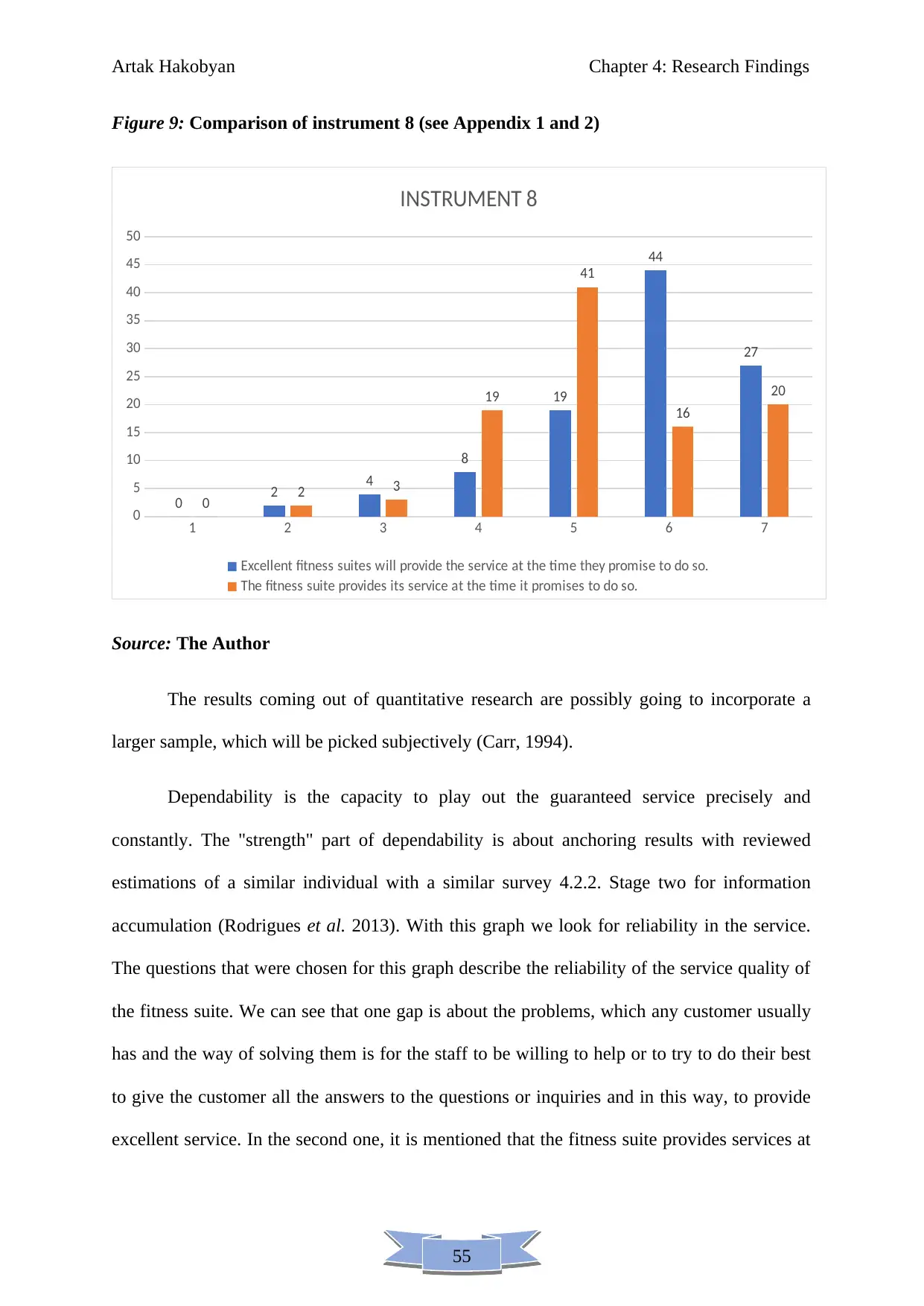
55
Artak Hakobyan Chapter 4: Research Findings
Figure 9: Comparison of instrument 8 (see Appendix 1 and 2)
1 2 3 4 5 6 7
0
5
10
15
20
25
30
35
40
45
50
0 2 4
8
19
44
27
0 2 3
19
41
16
20
INSTRUMENT 8
Excellent fitness suites will provide the service at the time they promise to do so.
The fitness suite provides its service at the time it promises to do so.
Source: The Author
The results coming out of quantitative research are possibly going to incorporate a
larger sample, which will be picked subjectively (Carr, 1994).
Dependability is the capacity to play out the guaranteed service precisely and
constantly. The "strength" part of dependability is about anchoring results with reviewed
estimations of a similar individual with a similar survey 4.2.2. Stage two for information
accumulation (Rodrigues et al. 2013). With this graph we look for reliability in the service.
The questions that were chosen for this graph describe the reliability of the service quality of
the fitness suite. We can see that one gap is about the problems, which any customer usually
has and the way of solving them is for the staff to be willing to help or to try to do their best
to give the customer all the answers to the questions or inquiries and in this way, to provide
excellent service. In the second one, it is mentioned that the fitness suite provides services at
Artak Hakobyan Chapter 4: Research Findings
Figure 9: Comparison of instrument 8 (see Appendix 1 and 2)
1 2 3 4 5 6 7
0
5
10
15
20
25
30
35
40
45
50
0 2 4
8
19
44
27
0 2 3
19
41
16
20
INSTRUMENT 8
Excellent fitness suites will provide the service at the time they promise to do so.
The fitness suite provides its service at the time it promises to do so.
Source: The Author
The results coming out of quantitative research are possibly going to incorporate a
larger sample, which will be picked subjectively (Carr, 1994).
Dependability is the capacity to play out the guaranteed service precisely and
constantly. The "strength" part of dependability is about anchoring results with reviewed
estimations of a similar individual with a similar survey 4.2.2. Stage two for information
accumulation (Rodrigues et al. 2013). With this graph we look for reliability in the service.
The questions that were chosen for this graph describe the reliability of the service quality of
the fitness suite. We can see that one gap is about the problems, which any customer usually
has and the way of solving them is for the staff to be willing to help or to try to do their best
to give the customer all the answers to the questions or inquiries and in this way, to provide
excellent service. In the second one, it is mentioned that the fitness suite provides services at
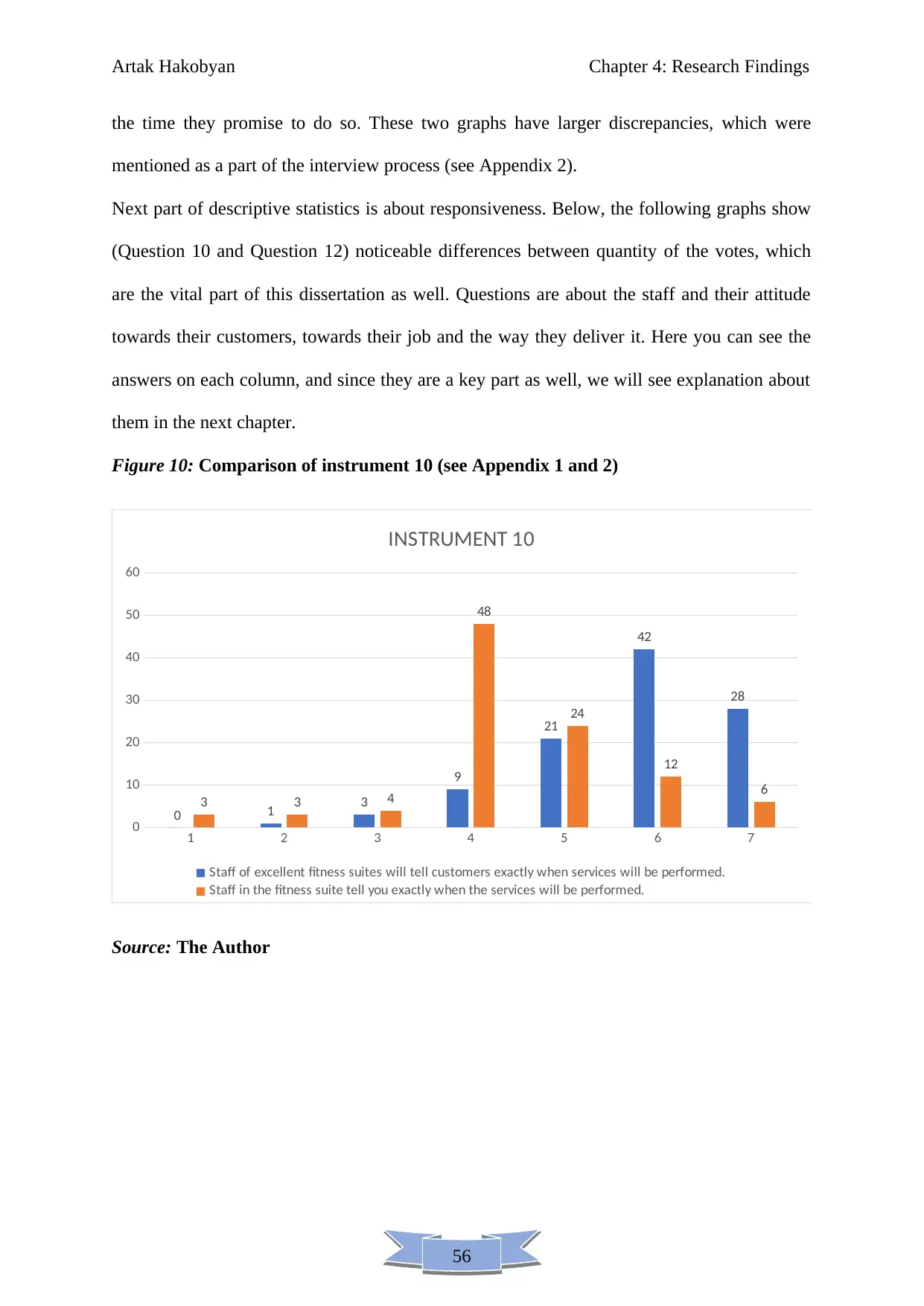
56
Artak Hakobyan Chapter 4: Research Findings
the time they promise to do so. These two graphs have larger discrepancies, which were
mentioned as a part of the interview process (see Appendix 2).
Next part of descriptive statistics is about responsiveness. Below, the following graphs show
(Question 10 and Question 12) noticeable differences between quantity of the votes, which
are the vital part of this dissertation as well. Questions are about the staff and their attitude
towards their customers, towards their job and the way they deliver it. Here you can see the
answers on each column, and since they are a key part as well, we will see explanation about
them in the next chapter.
Figure 10: Comparison of instrument 10 (see Appendix 1 and 2)
1 2 3 4 5 6 7
0
10
20
30
40
50
60
0 1 3
9
21
42
28
3 3 4
48
24
12
6
INSTRUMENT 10
Staff of excellent fitness suites will tell customers exactly when services will be performed.
Staff in the fitness suite tell you exactly when the services will be performed.
Source: The Author
Artak Hakobyan Chapter 4: Research Findings
the time they promise to do so. These two graphs have larger discrepancies, which were
mentioned as a part of the interview process (see Appendix 2).
Next part of descriptive statistics is about responsiveness. Below, the following graphs show
(Question 10 and Question 12) noticeable differences between quantity of the votes, which
are the vital part of this dissertation as well. Questions are about the staff and their attitude
towards their customers, towards their job and the way they deliver it. Here you can see the
answers on each column, and since they are a key part as well, we will see explanation about
them in the next chapter.
Figure 10: Comparison of instrument 10 (see Appendix 1 and 2)
1 2 3 4 5 6 7
0
10
20
30
40
50
60
0 1 3
9
21
42
28
3 3 4
48
24
12
6
INSTRUMENT 10
Staff of excellent fitness suites will tell customers exactly when services will be performed.
Staff in the fitness suite tell you exactly when the services will be performed.
Source: The Author
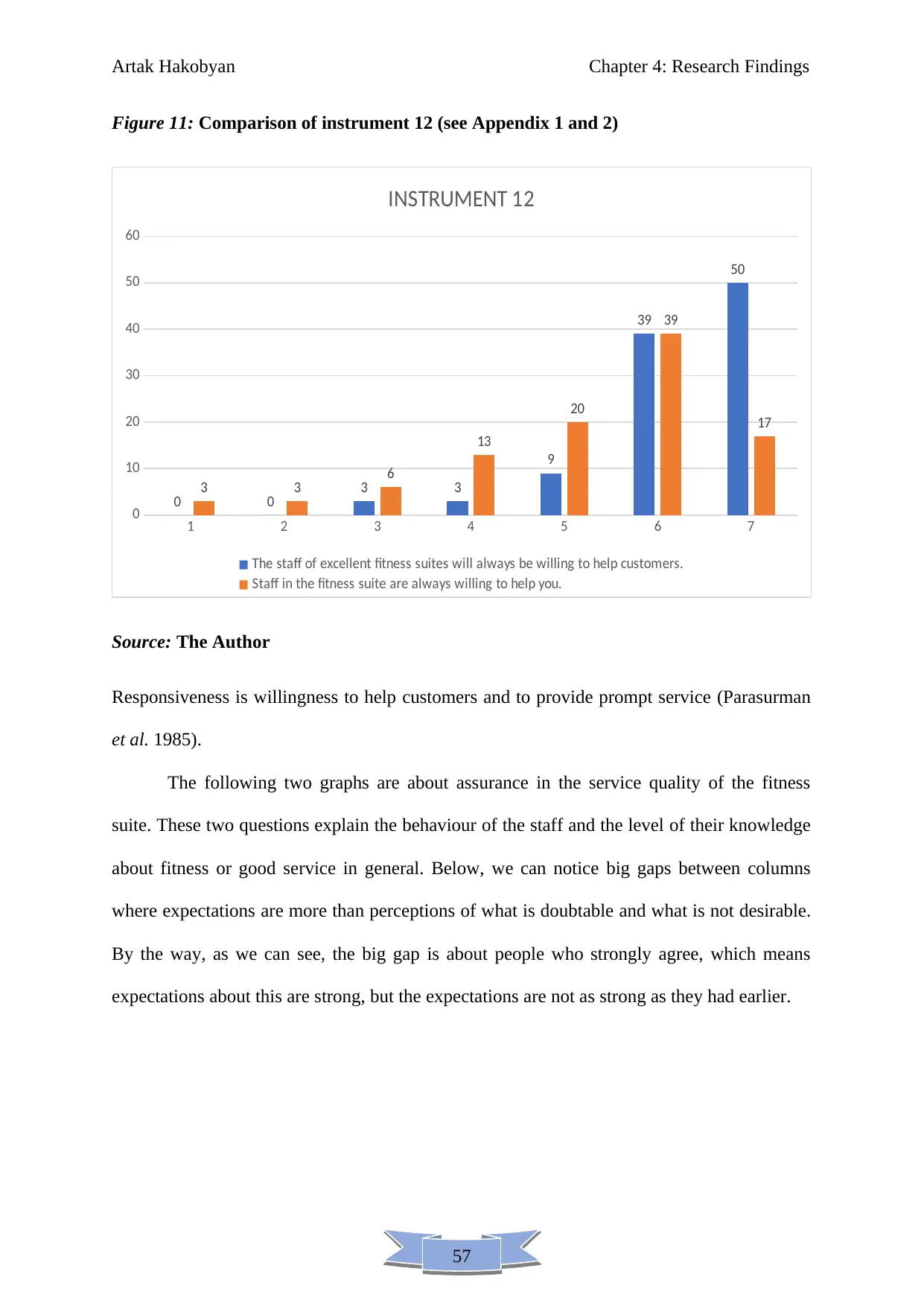
57
Artak Hakobyan Chapter 4: Research Findings
Figure 11: Comparison of instrument 12 (see Appendix 1 and 2)
1 2 3 4 5 6 7
0
10
20
30
40
50
60
0 0 3 3
9
39
50
3 3 6
13
20
39
17
INSTRUMENT 12
The staff of excellent fitness suites will always be willing to help customers.
Staff in the fitness suite are always willing to help you.
Source: The Author
Responsiveness is willingness to help customers and to provide prompt service (Parasurman
et al. 1985).
The following two graphs are about assurance in the service quality of the fitness
suite. These two questions explain the behaviour of the staff and the level of their knowledge
about fitness or good service in general. Below, we can notice big gaps between columns
where expectations are more than perceptions of what is doubtable and what is not desirable.
By the way, as we can see, the big gap is about people who strongly agree, which means
expectations about this are strong, but the expectations are not as strong as they had earlier.
Artak Hakobyan Chapter 4: Research Findings
Figure 11: Comparison of instrument 12 (see Appendix 1 and 2)
1 2 3 4 5 6 7
0
10
20
30
40
50
60
0 0 3 3
9
39
50
3 3 6
13
20
39
17
INSTRUMENT 12
The staff of excellent fitness suites will always be willing to help customers.
Staff in the fitness suite are always willing to help you.
Source: The Author
Responsiveness is willingness to help customers and to provide prompt service (Parasurman
et al. 1985).
The following two graphs are about assurance in the service quality of the fitness
suite. These two questions explain the behaviour of the staff and the level of their knowledge
about fitness or good service in general. Below, we can notice big gaps between columns
where expectations are more than perceptions of what is doubtable and what is not desirable.
By the way, as we can see, the big gap is about people who strongly agree, which means
expectations about this are strong, but the expectations are not as strong as they had earlier.
Secure Best Marks with AI Grader
Need help grading? Try our AI Grader for instant feedback on your assignments.
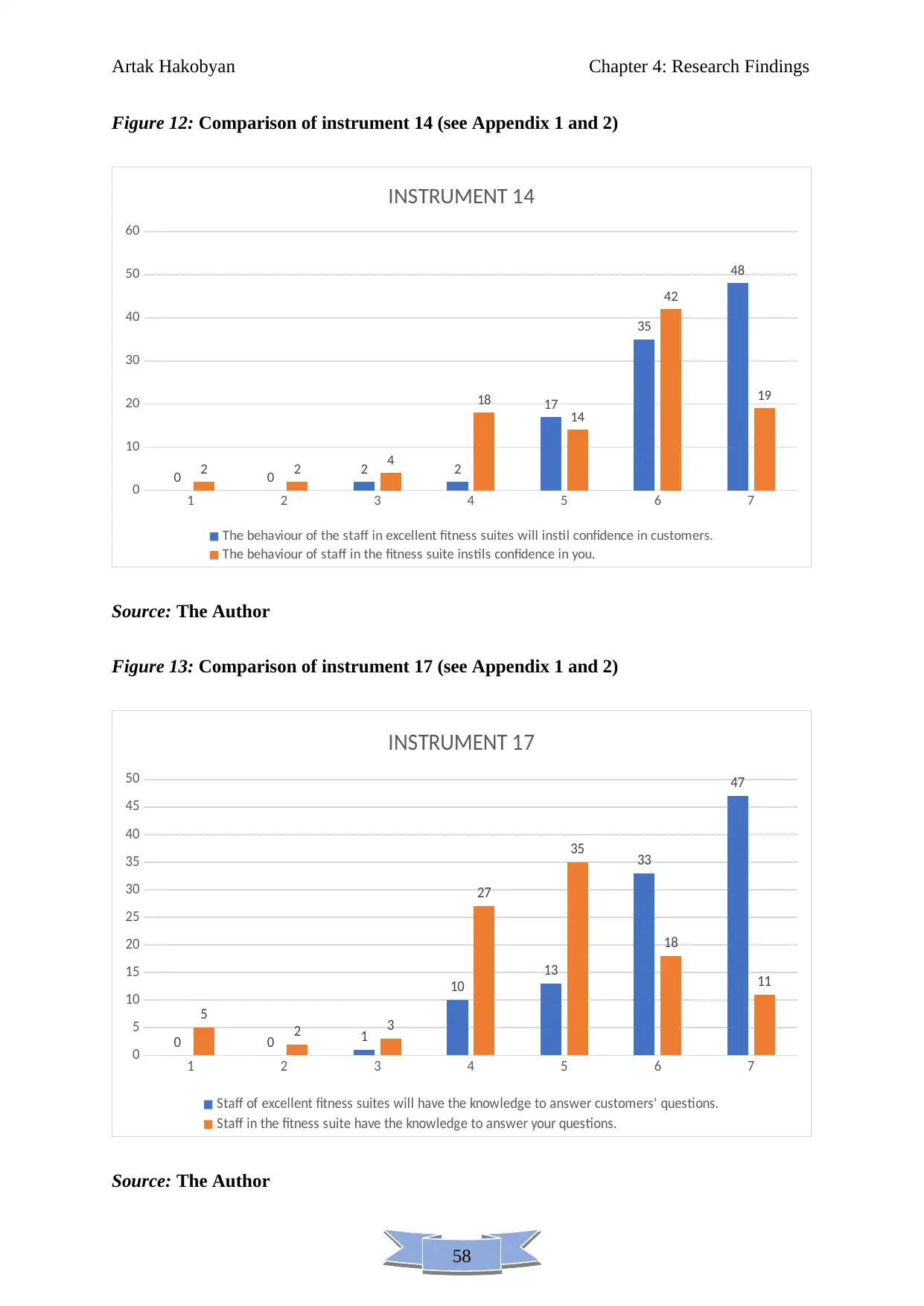
58
Artak Hakobyan Chapter 4: Research Findings
Figure 12: Comparison of instrument 14 (see Appendix 1 and 2)
1 2 3 4 5 6 7
0
10
20
30
40
50
60
0 0 2 2
17
35
48
2 2 4
18
14
42
19
INSTRUMENT 14
The behaviour of the staff in excellent fitness suites will instil confidence in customers.
The behaviour of staff in the fitness suite instils confidence in you.
Source: The Author
Figure 13: Comparison of instrument 17 (see Appendix 1 and 2)
1 2 3 4 5 6 7
0
5
10
15
20
25
30
35
40
45
50
0 0 1
10
13
33
47
5
2 3
27
35
18
11
INSTRUMENT 17
Staff of excellent fitness suites will have the knowledge to answer customers' questions.
Staff in the fitness suite have the knowledge to answer your questions.
Source: The Author
Artak Hakobyan Chapter 4: Research Findings
Figure 12: Comparison of instrument 14 (see Appendix 1 and 2)
1 2 3 4 5 6 7
0
10
20
30
40
50
60
0 0 2 2
17
35
48
2 2 4
18
14
42
19
INSTRUMENT 14
The behaviour of the staff in excellent fitness suites will instil confidence in customers.
The behaviour of staff in the fitness suite instils confidence in you.
Source: The Author
Figure 13: Comparison of instrument 17 (see Appendix 1 and 2)
1 2 3 4 5 6 7
0
5
10
15
20
25
30
35
40
45
50
0 0 1
10
13
33
47
5
2 3
27
35
18
11
INSTRUMENT 17
Staff of excellent fitness suites will have the knowledge to answer customers' questions.
Staff in the fitness suite have the knowledge to answer your questions.
Source: The Author
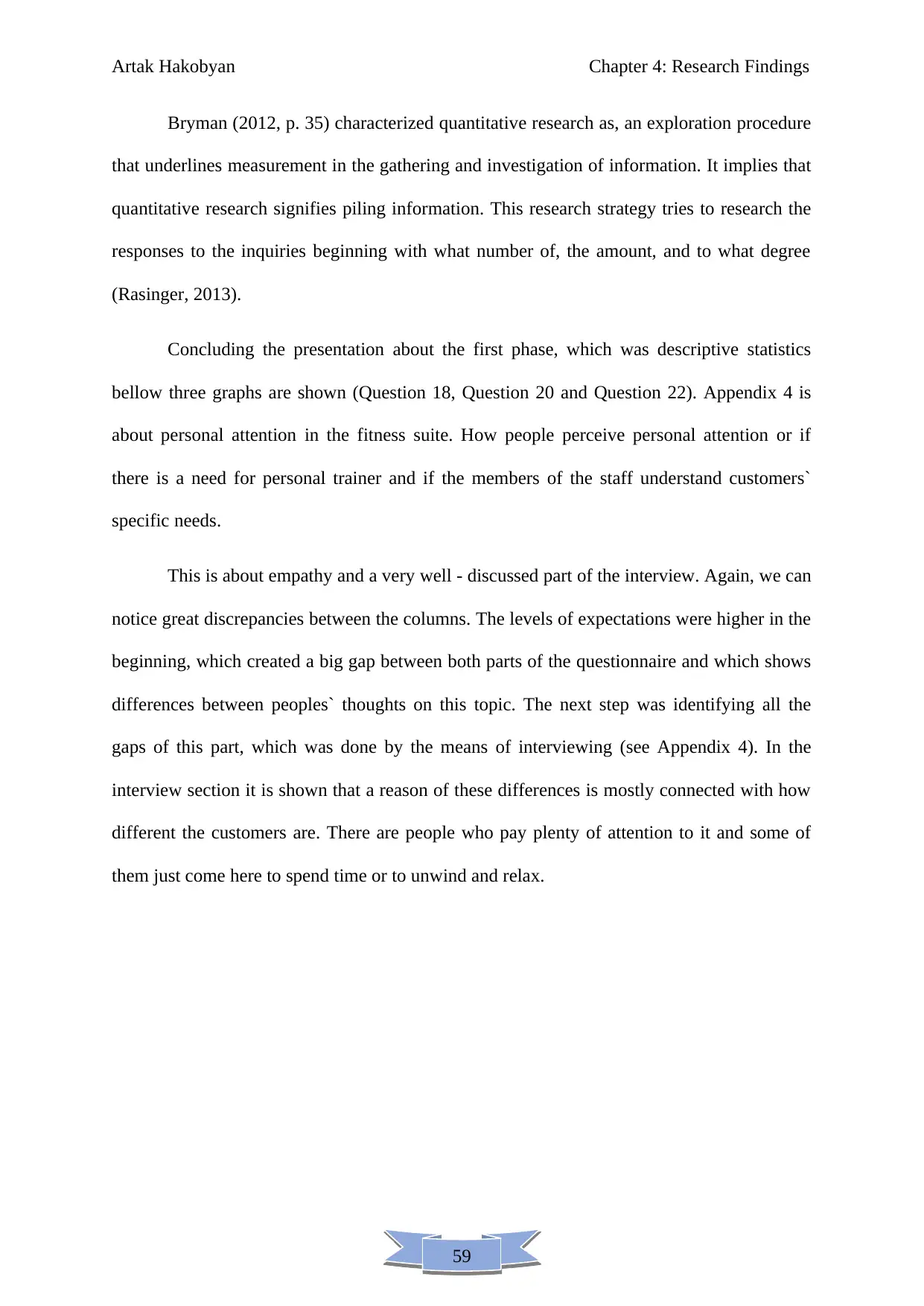
59
Artak Hakobyan Chapter 4: Research Findings
Bryman (2012, p. 35) characterized quantitative research as, an exploration procedure
that underlines measurement in the gathering and investigation of information. It implies that
quantitative research signifies piling information. This research strategy tries to research the
responses to the inquiries beginning with what number of, the amount, and to what degree
(Rasinger, 2013).
Concluding the presentation about the first phase, which was descriptive statistics
bellow three graphs are shown (Question 18, Question 20 and Question 22). Appendix 4 is
about personal attention in the fitness suite. How people perceive personal attention or if
there is a need for personal trainer and if the members of the staff understand customers`
specific needs.
This is about empathy and a very well - discussed part of the interview. Again, we can
notice great discrepancies between the columns. The levels of expectations were higher in the
beginning, which created a big gap between both parts of the questionnaire and which shows
differences between peoples` thoughts on this topic. The next step was identifying all the
gaps of this part, which was done by the means of interviewing (see Appendix 4). In the
interview section it is shown that a reason of these differences is mostly connected with how
different the customers are. There are people who pay plenty of attention to it and some of
them just come here to spend time or to unwind and relax.
Artak Hakobyan Chapter 4: Research Findings
Bryman (2012, p. 35) characterized quantitative research as, an exploration procedure
that underlines measurement in the gathering and investigation of information. It implies that
quantitative research signifies piling information. This research strategy tries to research the
responses to the inquiries beginning with what number of, the amount, and to what degree
(Rasinger, 2013).
Concluding the presentation about the first phase, which was descriptive statistics
bellow three graphs are shown (Question 18, Question 20 and Question 22). Appendix 4 is
about personal attention in the fitness suite. How people perceive personal attention or if
there is a need for personal trainer and if the members of the staff understand customers`
specific needs.
This is about empathy and a very well - discussed part of the interview. Again, we can
notice great discrepancies between the columns. The levels of expectations were higher in the
beginning, which created a big gap between both parts of the questionnaire and which shows
differences between peoples` thoughts on this topic. The next step was identifying all the
gaps of this part, which was done by the means of interviewing (see Appendix 4). In the
interview section it is shown that a reason of these differences is mostly connected with how
different the customers are. There are people who pay plenty of attention to it and some of
them just come here to spend time or to unwind and relax.
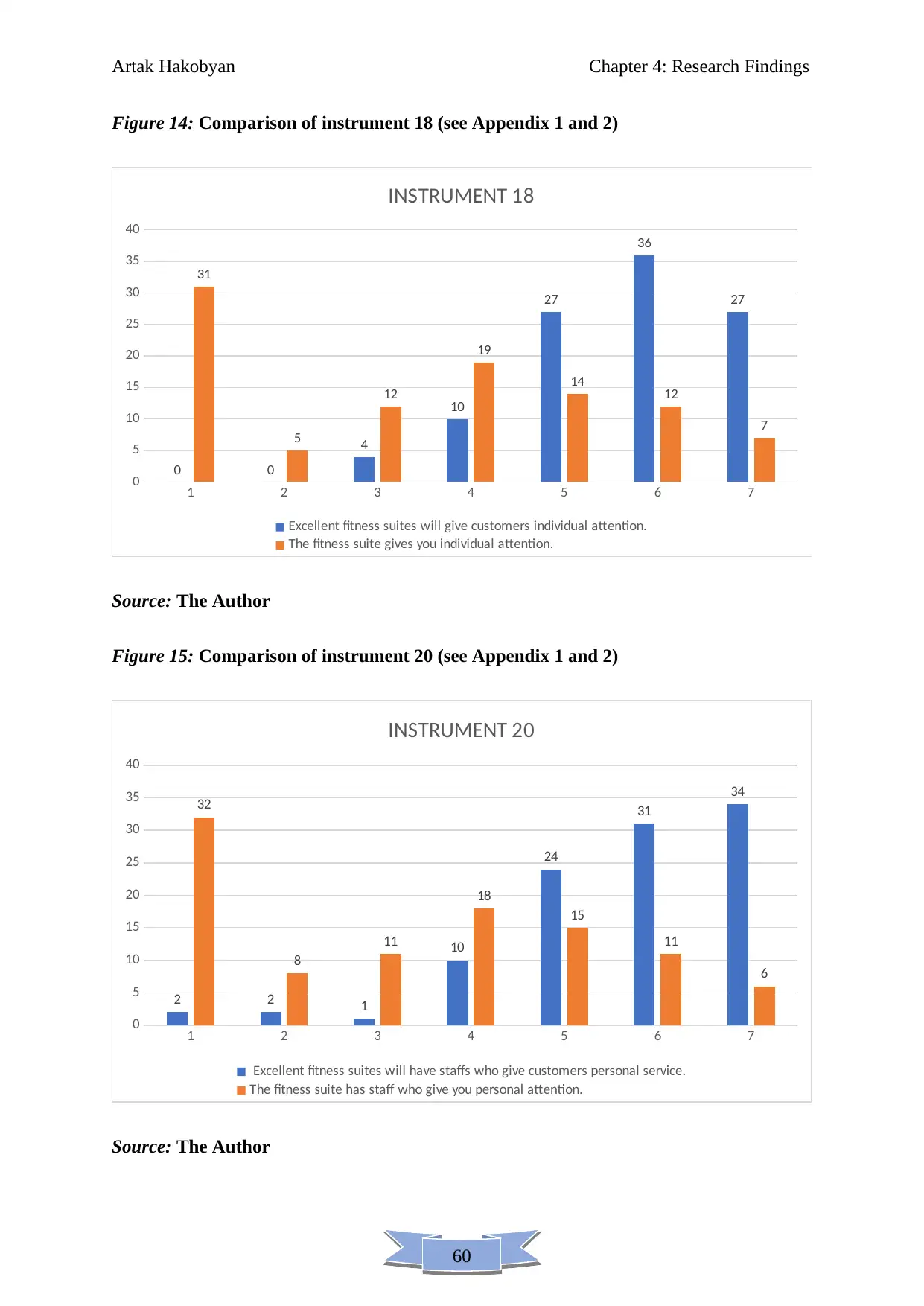
60
Artak Hakobyan Chapter 4: Research Findings
Figure 14: Comparison of instrument 18 (see Appendix 1 and 2)
1 2 3 4 5 6 7
0
5
10
15
20
25
30
35
40
0 0
4
10
27
36
27
31
5
12
19
14 12
7
INSTRUMENT 18
Excellent fitness suites will give customers individual attention.
The fitness suite gives you individual attention.
Source: The Author
Figure 15: Comparison of instrument 20 (see Appendix 1 and 2)
1 2 3 4 5 6 7
0
5
10
15
20
25
30
35
40
2 2 1
10
24
31
34
32
8
11
18
15
11
6
INSTRUMENT 20
Excellent fitness suites will have staffs who give customers personal service.
The fitness suite has staff who give you personal attention.
Source: The Author
Artak Hakobyan Chapter 4: Research Findings
Figure 14: Comparison of instrument 18 (see Appendix 1 and 2)
1 2 3 4 5 6 7
0
5
10
15
20
25
30
35
40
0 0
4
10
27
36
27
31
5
12
19
14 12
7
INSTRUMENT 18
Excellent fitness suites will give customers individual attention.
The fitness suite gives you individual attention.
Source: The Author
Figure 15: Comparison of instrument 20 (see Appendix 1 and 2)
1 2 3 4 5 6 7
0
5
10
15
20
25
30
35
40
2 2 1
10
24
31
34
32
8
11
18
15
11
6
INSTRUMENT 20
Excellent fitness suites will have staffs who give customers personal service.
The fitness suite has staff who give you personal attention.
Source: The Author
Paraphrase This Document
Need a fresh take? Get an instant paraphrase of this document with our AI Paraphraser
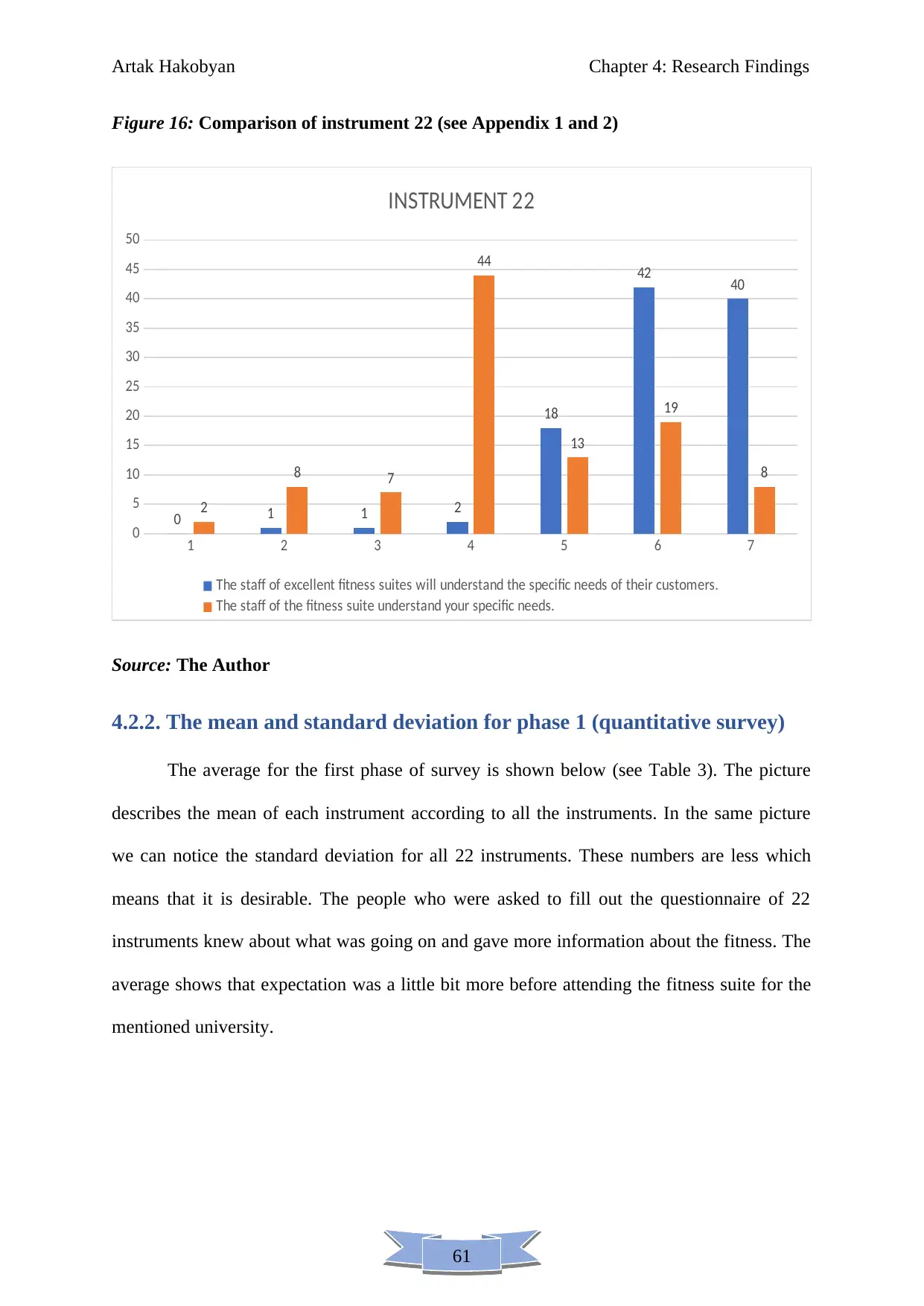
61
Artak Hakobyan Chapter 4: Research Findings
Figure 16: Comparison of instrument 22 (see Appendix 1 and 2)
1 2 3 4 5 6 7
0
5
10
15
20
25
30
35
40
45
50
0 1 1 2
18
42 40
2
8 7
44
13
19
8
INSTRUMENT 22
The staff of excellent fitness suites will understand the specific needs of their customers.
The staff of the fitness suite understand your specific needs.
Source: The Author
4.2.2. The mean and standard deviation for phase 1 (quantitative survey)
The average for the first phase of survey is shown below (see Table 3). The picture
describes the mean of each instrument according to all the instruments. In the same picture
we can notice the standard deviation for all 22 instruments. These numbers are less which
means that it is desirable. The people who were asked to fill out the questionnaire of 22
instruments knew about what was going on and gave more information about the fitness. The
average shows that expectation was a little bit more before attending the fitness suite for the
mentioned university.
Artak Hakobyan Chapter 4: Research Findings
Figure 16: Comparison of instrument 22 (see Appendix 1 and 2)
1 2 3 4 5 6 7
0
5
10
15
20
25
30
35
40
45
50
0 1 1 2
18
42 40
2
8 7
44
13
19
8
INSTRUMENT 22
The staff of excellent fitness suites will understand the specific needs of their customers.
The staff of the fitness suite understand your specific needs.
Source: The Author
4.2.2. The mean and standard deviation for phase 1 (quantitative survey)
The average for the first phase of survey is shown below (see Table 3). The picture
describes the mean of each instrument according to all the instruments. In the same picture
we can notice the standard deviation for all 22 instruments. These numbers are less which
means that it is desirable. The people who were asked to fill out the questionnaire of 22
instruments knew about what was going on and gave more information about the fitness. The
average shows that expectation was a little bit more before attending the fitness suite for the
mentioned university.
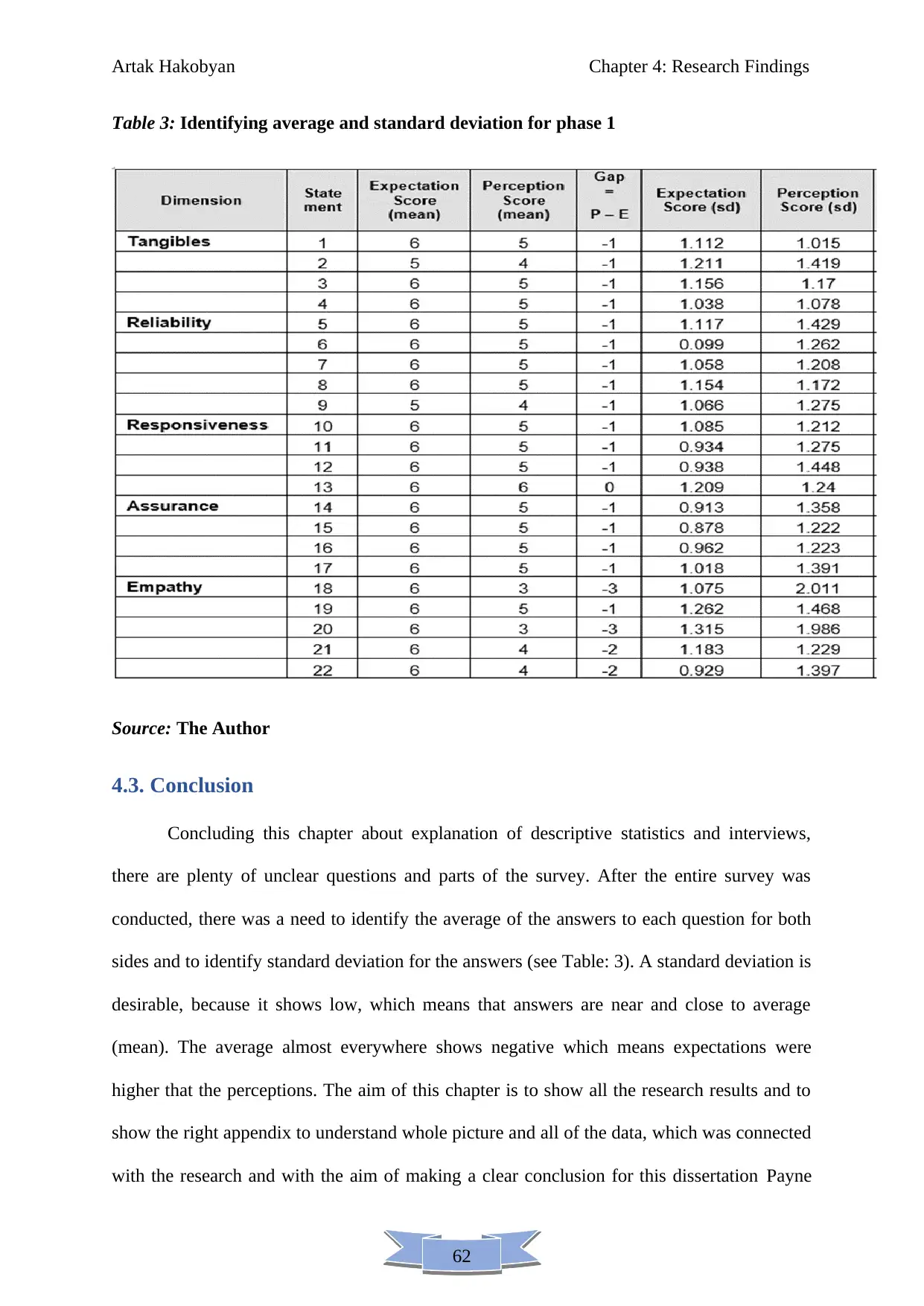
62
Artak Hakobyan Chapter 4: Research Findings
Table 3: Identifying average and standard deviation for phase 1
Source: The Author
4.3. Conclusion
Concluding this chapter about explanation of descriptive statistics and interviews,
there are plenty of unclear questions and parts of the survey. After the entire survey was
conducted, there was a need to identify the average of the answers to each question for both
sides and to identify standard deviation for the answers (see Table: 3). A standard deviation is
desirable, because it shows low, which means that answers are near and close to average
(mean). The average almost everywhere shows negative which means expectations were
higher that the perceptions. The aim of this chapter is to show all the research results and to
show the right appendix to understand whole picture and all of the data, which was connected
with the research and with the aim of making a clear conclusion for this dissertation Payne
Artak Hakobyan Chapter 4: Research Findings
Table 3: Identifying average and standard deviation for phase 1
Source: The Author
4.3. Conclusion
Concluding this chapter about explanation of descriptive statistics and interviews,
there are plenty of unclear questions and parts of the survey. After the entire survey was
conducted, there was a need to identify the average of the answers to each question for both
sides and to identify standard deviation for the answers (see Table: 3). A standard deviation is
desirable, because it shows low, which means that answers are near and close to average
(mean). The average almost everywhere shows negative which means expectations were
higher that the perceptions. The aim of this chapter is to show all the research results and to
show the right appendix to understand whole picture and all of the data, which was connected
with the research and with the aim of making a clear conclusion for this dissertation Payne

63
Artak Hakobyan Chapter 4: Research Findings
and Payne (2004, p. 180) expressed that quantitative strategies (typically utilizing deductive
rationale) look for steadiness in people's lives, by isolating the real world into exact parts
called factors which can be represented through numbers, the relationship with one another
can be investigated by factual methods and achieved through a scientist, who presented
upgrades and methodical estimation.
Artak Hakobyan Chapter 4: Research Findings
and Payne (2004, p. 180) expressed that quantitative strategies (typically utilizing deductive
rationale) look for steadiness in people's lives, by isolating the real world into exact parts
called factors which can be represented through numbers, the relationship with one another
can be investigated by factual methods and achieved through a scientist, who presented
upgrades and methodical estimation.
Secure Best Marks with AI Grader
Need help grading? Try our AI Grader for instant feedback on your assignments.
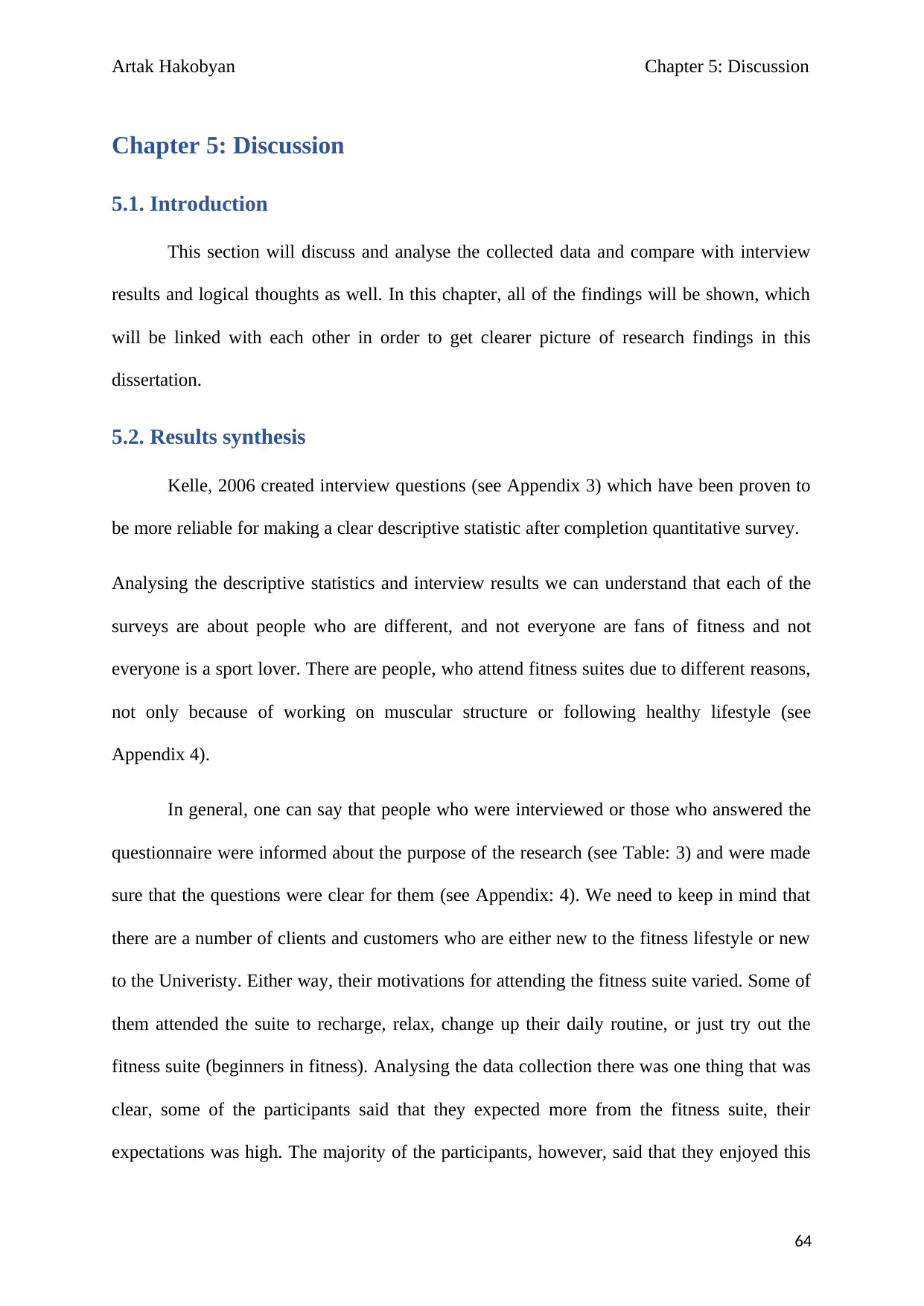
Artak Hakobyan Chapter 5: Discussion
Chapter 5: Discussion
5.1. Introduction
This section will discuss and analyse the collected data and compare with interview
results and logical thoughts as well. In this chapter, all of the findings will be shown, which
will be linked with each other in order to get clearer picture of research findings in this
dissertation.
5.2. Results synthesis
Kelle, 2006 created interview questions (see Appendix 3) which have been proven to
be more reliable for making a clear descriptive statistic after completion quantitative survey.
Analysing the descriptive statistics and interview results we can understand that each of the
surveys are about people who are different, and not everyone are fans of fitness and not
everyone is a sport lover. There are people, who attend fitness suites due to different reasons,
not only because of working on muscular structure or following healthy lifestyle (see
Appendix 4).
In general, one can say that people who were interviewed or those who answered the
questionnaire were informed about the purpose of the research (see Table: 3) and were made
sure that the questions were clear for them (see Appendix: 4). We need to keep in mind that
there are a number of clients and customers who are either new to the fitness lifestyle or new
to the Univeristy. Either way, their motivations for attending the fitness suite varied. Some of
them attended the suite to recharge, relax, change up their daily routine, or just try out the
fitness suite (beginners in fitness). Analysing the data collection there was one thing that was
clear, some of the participants said that they expected more from the fitness suite, their
expectations was high. The majority of the participants, however, said that they enjoyed this
64
Chapter 5: Discussion
5.1. Introduction
This section will discuss and analyse the collected data and compare with interview
results and logical thoughts as well. In this chapter, all of the findings will be shown, which
will be linked with each other in order to get clearer picture of research findings in this
dissertation.
5.2. Results synthesis
Kelle, 2006 created interview questions (see Appendix 3) which have been proven to
be more reliable for making a clear descriptive statistic after completion quantitative survey.
Analysing the descriptive statistics and interview results we can understand that each of the
surveys are about people who are different, and not everyone are fans of fitness and not
everyone is a sport lover. There are people, who attend fitness suites due to different reasons,
not only because of working on muscular structure or following healthy lifestyle (see
Appendix 4).
In general, one can say that people who were interviewed or those who answered the
questionnaire were informed about the purpose of the research (see Table: 3) and were made
sure that the questions were clear for them (see Appendix: 4). We need to keep in mind that
there are a number of clients and customers who are either new to the fitness lifestyle or new
to the Univeristy. Either way, their motivations for attending the fitness suite varied. Some of
them attended the suite to recharge, relax, change up their daily routine, or just try out the
fitness suite (beginners in fitness). Analysing the data collection there was one thing that was
clear, some of the participants said that they expected more from the fitness suite, their
expectations was high. The majority of the participants, however, said that they enjoyed this
64
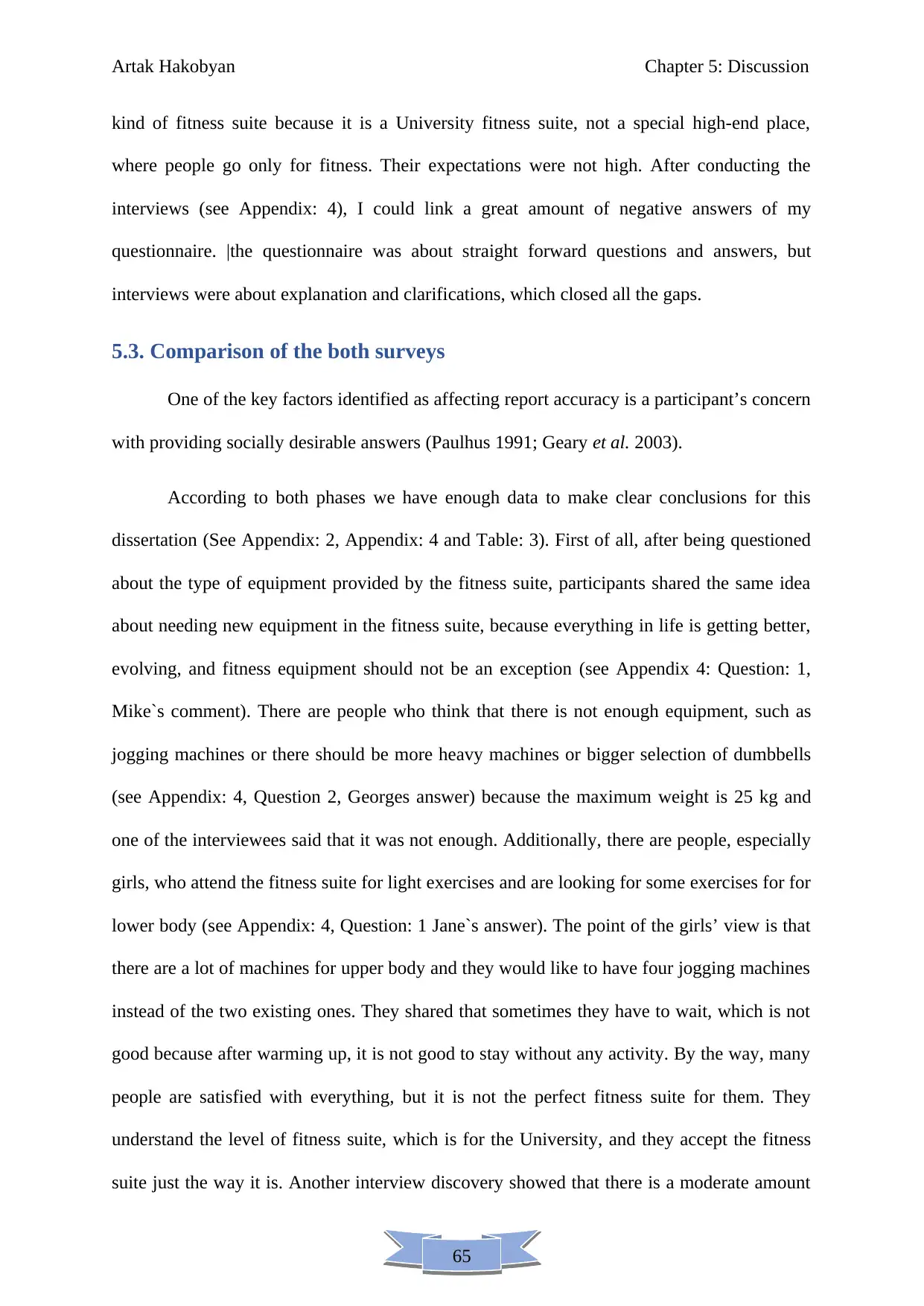
65
Artak Hakobyan Chapter 5: Discussion
kind of fitness suite because it is a University fitness suite, not a special high-end place,
where people go only for fitness. Their expectations were not high. After conducting the
interviews (see Appendix: 4), I could link a great amount of negative answers of my
questionnaire. |the questionnaire was about straight forward questions and answers, but
interviews were about explanation and clarifications, which closed all the gaps.
5.3. Comparison of the both surveys
One of the key factors identified as affecting report accuracy is a participant’s concern
with providing socially desirable answers (Paulhus 1991; Geary et al. 2003).
According to both phases we have enough data to make clear conclusions for this
dissertation (See Appendix: 2, Appendix: 4 and Table: 3). First of all, after being questioned
about the type of equipment provided by the fitness suite, participants shared the same idea
about needing new equipment in the fitness suite, because everything in life is getting better,
evolving, and fitness equipment should not be an exception (see Appendix 4: Question: 1,
Mike`s comment). There are people who think that there is not enough equipment, such as
jogging machines or there should be more heavy machines or bigger selection of dumbbells
(see Appendix: 4, Question 2, Georges answer) because the maximum weight is 25 kg and
one of the interviewees said that it was not enough. Additionally, there are people, especially
girls, who attend the fitness suite for light exercises and are looking for some exercises for for
lower body (see Appendix: 4, Question: 1 Jane`s answer). The point of the girls’ view is that
there are a lot of machines for upper body and they would like to have four jogging machines
instead of the two existing ones. They shared that sometimes they have to wait, which is not
good because after warming up, it is not good to stay without any activity. By the way, many
people are satisfied with everything, but it is not the perfect fitness suite for them. They
understand the level of fitness suite, which is for the University, and they accept the fitness
suite just the way it is. Another interview discovery showed that there is a moderate amount
Artak Hakobyan Chapter 5: Discussion
kind of fitness suite because it is a University fitness suite, not a special high-end place,
where people go only for fitness. Their expectations were not high. After conducting the
interviews (see Appendix: 4), I could link a great amount of negative answers of my
questionnaire. |the questionnaire was about straight forward questions and answers, but
interviews were about explanation and clarifications, which closed all the gaps.
5.3. Comparison of the both surveys
One of the key factors identified as affecting report accuracy is a participant’s concern
with providing socially desirable answers (Paulhus 1991; Geary et al. 2003).
According to both phases we have enough data to make clear conclusions for this
dissertation (See Appendix: 2, Appendix: 4 and Table: 3). First of all, after being questioned
about the type of equipment provided by the fitness suite, participants shared the same idea
about needing new equipment in the fitness suite, because everything in life is getting better,
evolving, and fitness equipment should not be an exception (see Appendix 4: Question: 1,
Mike`s comment). There are people who think that there is not enough equipment, such as
jogging machines or there should be more heavy machines or bigger selection of dumbbells
(see Appendix: 4, Question 2, Georges answer) because the maximum weight is 25 kg and
one of the interviewees said that it was not enough. Additionally, there are people, especially
girls, who attend the fitness suite for light exercises and are looking for some exercises for for
lower body (see Appendix: 4, Question: 1 Jane`s answer). The point of the girls’ view is that
there are a lot of machines for upper body and they would like to have four jogging machines
instead of the two existing ones. They shared that sometimes they have to wait, which is not
good because after warming up, it is not good to stay without any activity. By the way, many
people are satisfied with everything, but it is not the perfect fitness suite for them. They
understand the level of fitness suite, which is for the University, and they accept the fitness
suite just the way it is. Another interview discovery showed that there is a moderate amount
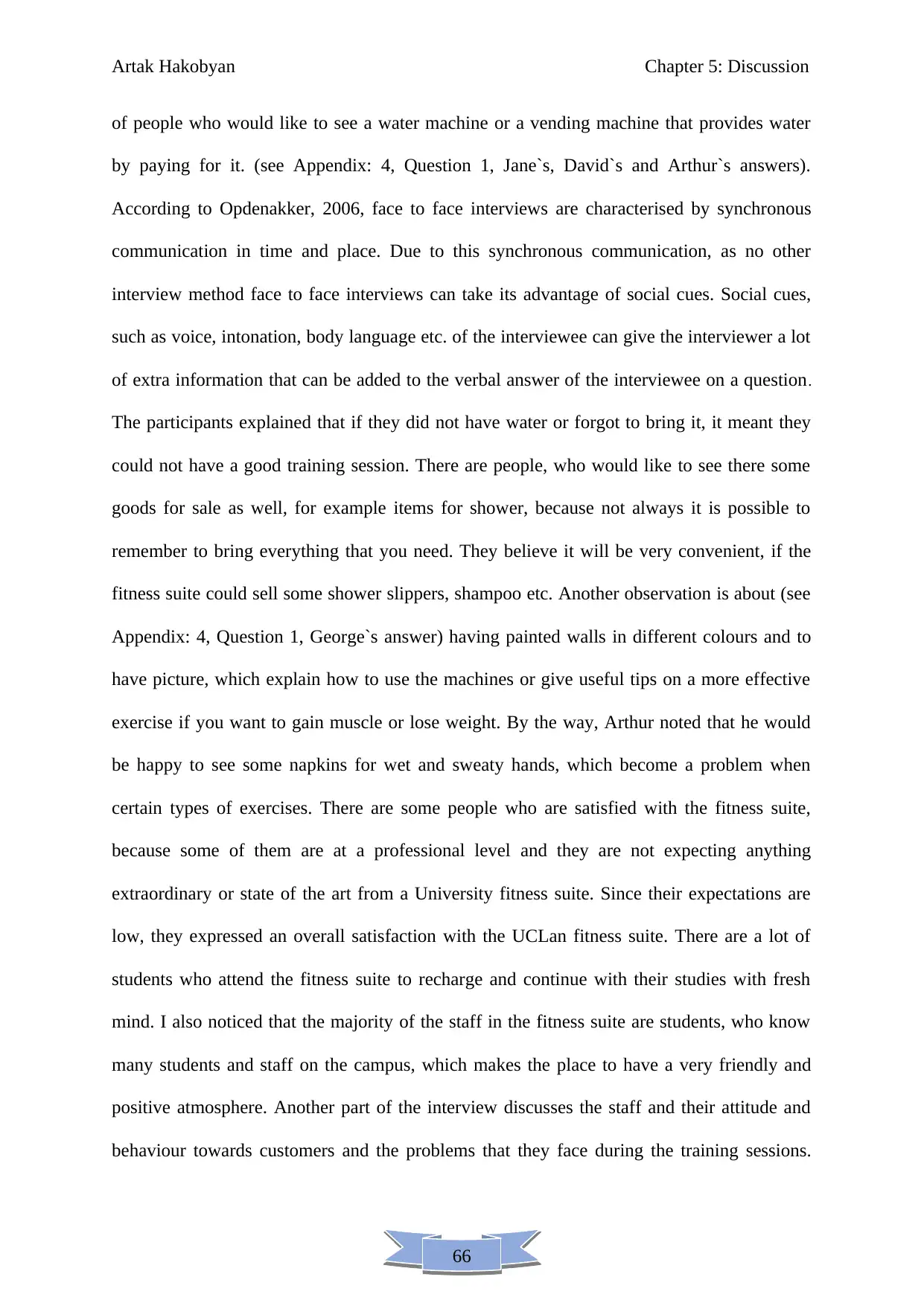
66
Artak Hakobyan Chapter 5: Discussion
of people who would like to see a water machine or a vending machine that provides water
by paying for it. (see Appendix: 4, Question 1, Jane`s, David`s and Arthur`s answers).
According to Opdenakker, 2006, face to face interviews are characterised by synchronous
communication in time and place. Due to this synchronous communication, as no other
interview method face to face interviews can take its advantage of social cues. Social cues,
such as voice, intonation, body language etc. of the interviewee can give the interviewer a lot
of extra information that can be added to the verbal answer of the interviewee on a question.
The participants explained that if they did not have water or forgot to bring it, it meant they
could not have a good training session. There are people, who would like to see there some
goods for sale as well, for example items for shower, because not always it is possible to
remember to bring everything that you need. They believe it will be very convenient, if the
fitness suite could sell some shower slippers, shampoo etc. Another observation is about (see
Appendix: 4, Question 1, George`s answer) having painted walls in different colours and to
have picture, which explain how to use the machines or give useful tips on a more effective
exercise if you want to gain muscle or lose weight. By the way, Arthur noted that he would
be happy to see some napkins for wet and sweaty hands, which become a problem when
certain types of exercises. There are some people who are satisfied with the fitness suite,
because some of them are at a professional level and they are not expecting anything
extraordinary or state of the art from a University fitness suite. Since their expectations are
low, they expressed an overall satisfaction with the UCLan fitness suite. There are a lot of
students who attend the fitness suite to recharge and continue with their studies with fresh
mind. I also noticed that the majority of the staff in the fitness suite are students, who know
many students and staff on the campus, which makes the place to have a very friendly and
positive atmosphere. Another part of the interview discusses the staff and their attitude and
behaviour towards customers and the problems that they face during the training sessions.
Artak Hakobyan Chapter 5: Discussion
of people who would like to see a water machine or a vending machine that provides water
by paying for it. (see Appendix: 4, Question 1, Jane`s, David`s and Arthur`s answers).
According to Opdenakker, 2006, face to face interviews are characterised by synchronous
communication in time and place. Due to this synchronous communication, as no other
interview method face to face interviews can take its advantage of social cues. Social cues,
such as voice, intonation, body language etc. of the interviewee can give the interviewer a lot
of extra information that can be added to the verbal answer of the interviewee on a question.
The participants explained that if they did not have water or forgot to bring it, it meant they
could not have a good training session. There are people, who would like to see there some
goods for sale as well, for example items for shower, because not always it is possible to
remember to bring everything that you need. They believe it will be very convenient, if the
fitness suite could sell some shower slippers, shampoo etc. Another observation is about (see
Appendix: 4, Question 1, George`s answer) having painted walls in different colours and to
have picture, which explain how to use the machines or give useful tips on a more effective
exercise if you want to gain muscle or lose weight. By the way, Arthur noted that he would
be happy to see some napkins for wet and sweaty hands, which become a problem when
certain types of exercises. There are some people who are satisfied with the fitness suite,
because some of them are at a professional level and they are not expecting anything
extraordinary or state of the art from a University fitness suite. Since their expectations are
low, they expressed an overall satisfaction with the UCLan fitness suite. There are a lot of
students who attend the fitness suite to recharge and continue with their studies with fresh
mind. I also noticed that the majority of the staff in the fitness suite are students, who know
many students and staff on the campus, which makes the place to have a very friendly and
positive atmosphere. Another part of the interview discusses the staff and their attitude and
behaviour towards customers and the problems that they face during the training sessions.
Paraphrase This Document
Need a fresh take? Get an instant paraphrase of this document with our AI Paraphraser
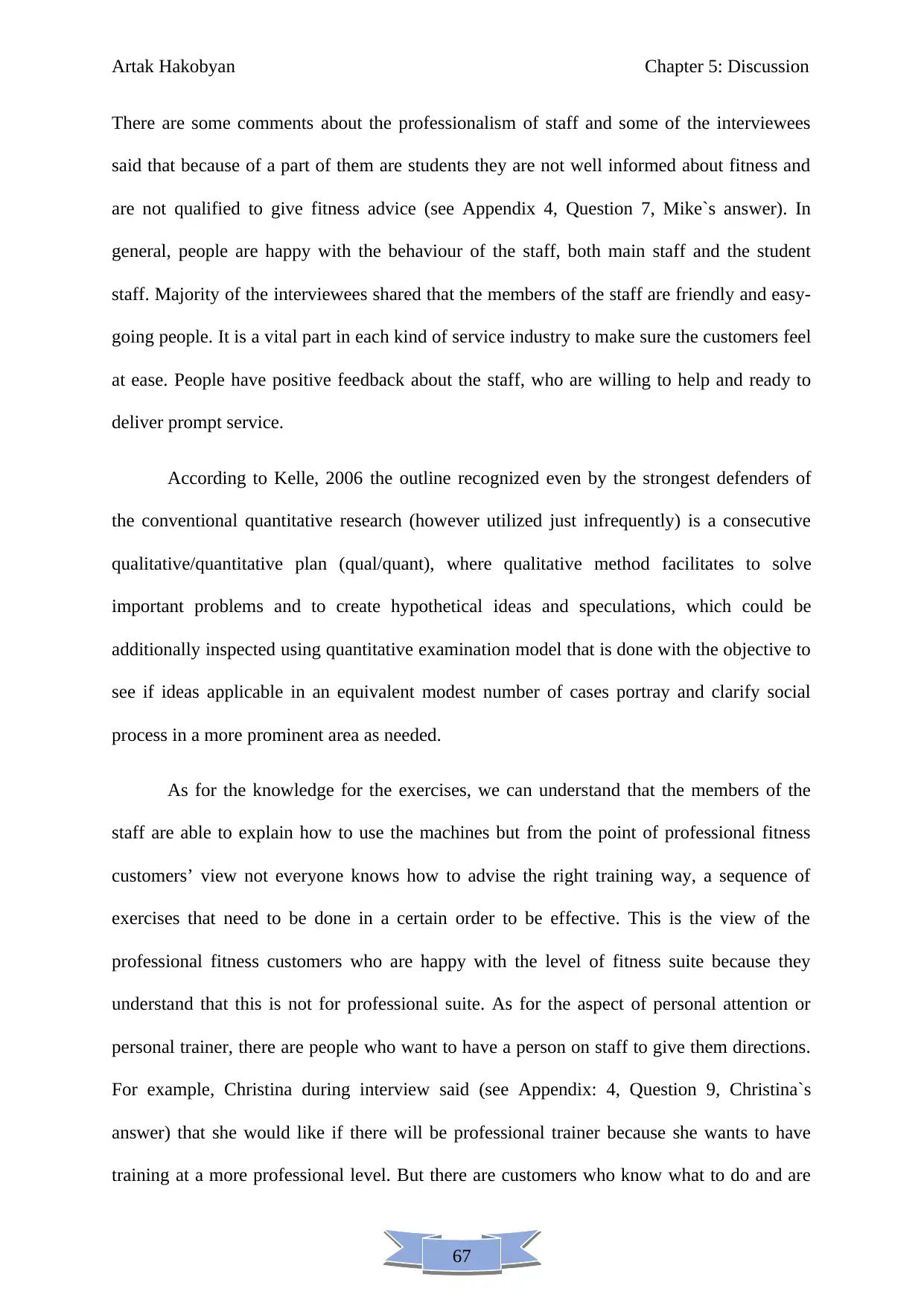
67
Artak Hakobyan Chapter 5: Discussion
There are some comments about the professionalism of staff and some of the interviewees
said that because of a part of them are students they are not well informed about fitness and
are not qualified to give fitness advice (see Appendix 4, Question 7, Mike`s answer). In
general, people are happy with the behaviour of the staff, both main staff and the student
staff. Majority of the interviewees shared that the members of the staff are friendly and easy-
going people. It is a vital part in each kind of service industry to make sure the customers feel
at ease. People have positive feedback about the staff, who are willing to help and ready to
deliver prompt service.
According to Kelle, 2006 the outline recognized even by the strongest defenders of
the conventional quantitative research (however utilized just infrequently) is a consecutive
qualitative/quantitative plan (qual/quant), where qualitative method facilitates to solve
important problems and to create hypothetical ideas and speculations, which could be
additionally inspected using quantitative examination model that is done with the objective to
see if ideas applicable in an equivalent modest number of cases portray and clarify social
process in a more prominent area as needed.
As for the knowledge for the exercises, we can understand that the members of the
staff are able to explain how to use the machines but from the point of professional fitness
customers’ view not everyone knows how to advise the right training way, a sequence of
exercises that need to be done in a certain order to be effective. This is the view of the
professional fitness customers who are happy with the level of fitness suite because they
understand that this is not for professional suite. As for the aspect of personal attention or
personal trainer, there are people who want to have a person on staff to give them directions.
For example, Christina during interview said (see Appendix: 4, Question 9, Christina`s
answer) that she would like if there will be professional trainer because she wants to have
training at a more professional level. But there are customers who know what to do and are
Artak Hakobyan Chapter 5: Discussion
There are some comments about the professionalism of staff and some of the interviewees
said that because of a part of them are students they are not well informed about fitness and
are not qualified to give fitness advice (see Appendix 4, Question 7, Mike`s answer). In
general, people are happy with the behaviour of the staff, both main staff and the student
staff. Majority of the interviewees shared that the members of the staff are friendly and easy-
going people. It is a vital part in each kind of service industry to make sure the customers feel
at ease. People have positive feedback about the staff, who are willing to help and ready to
deliver prompt service.
According to Kelle, 2006 the outline recognized even by the strongest defenders of
the conventional quantitative research (however utilized just infrequently) is a consecutive
qualitative/quantitative plan (qual/quant), where qualitative method facilitates to solve
important problems and to create hypothetical ideas and speculations, which could be
additionally inspected using quantitative examination model that is done with the objective to
see if ideas applicable in an equivalent modest number of cases portray and clarify social
process in a more prominent area as needed.
As for the knowledge for the exercises, we can understand that the members of the
staff are able to explain how to use the machines but from the point of professional fitness
customers’ view not everyone knows how to advise the right training way, a sequence of
exercises that need to be done in a certain order to be effective. This is the view of the
professional fitness customers who are happy with the level of fitness suite because they
understand that this is not for professional suite. As for the aspect of personal attention or
personal trainer, there are people who want to have a person on staff to give them directions.
For example, Christina during interview said (see Appendix: 4, Question 9, Christina`s
answer) that she would like if there will be professional trainer because she wants to have
training at a more professional level. But there are customers who know what to do and are
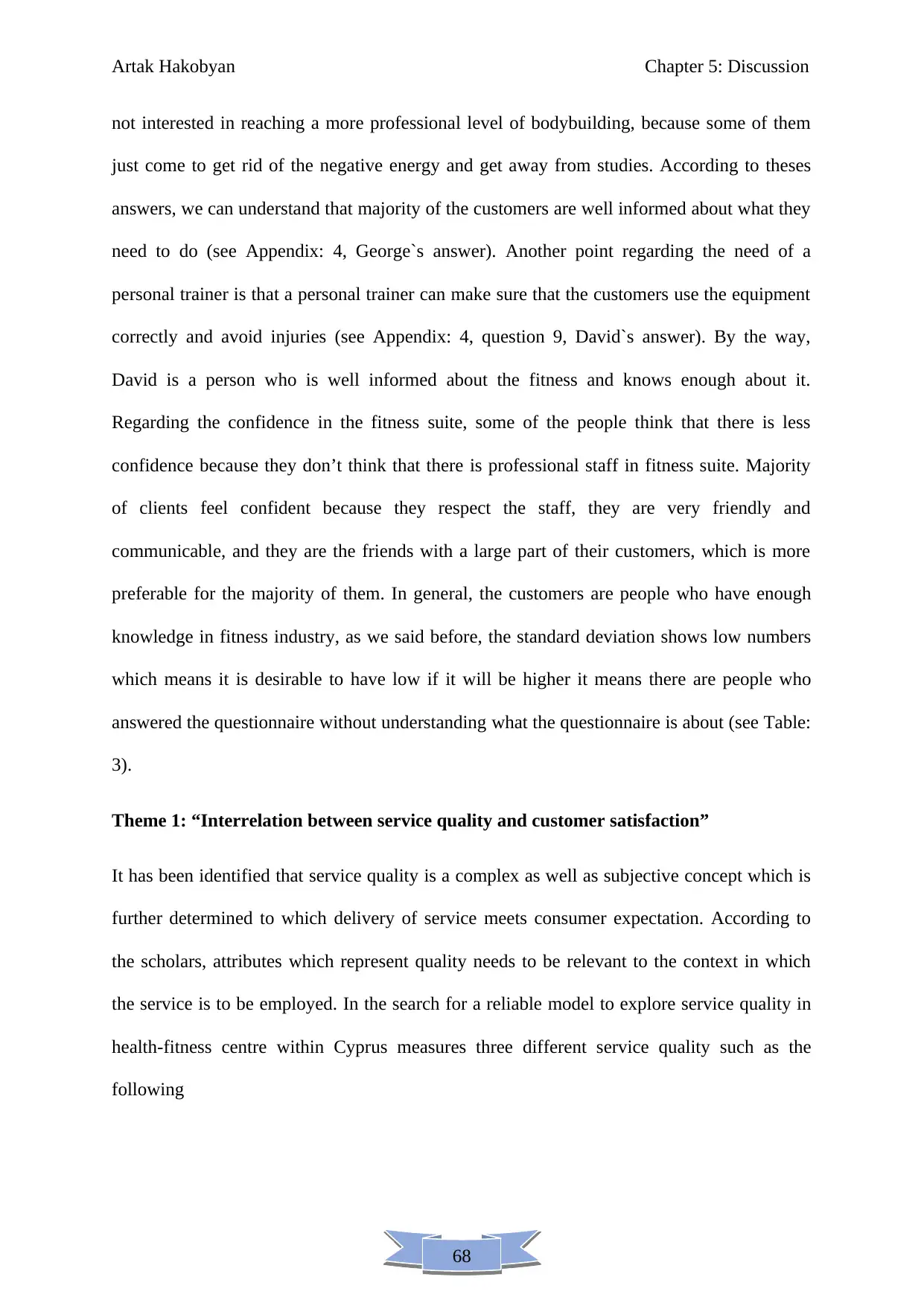
68
Artak Hakobyan Chapter 5: Discussion
not interested in reaching a more professional level of bodybuilding, because some of them
just come to get rid of the negative energy and get away from studies. According to theses
answers, we can understand that majority of the customers are well informed about what they
need to do (see Appendix: 4, George`s answer). Another point regarding the need of a
personal trainer is that a personal trainer can make sure that the customers use the equipment
correctly and avoid injuries (see Appendix: 4, question 9, David`s answer). By the way,
David is a person who is well informed about the fitness and knows enough about it.
Regarding the confidence in the fitness suite, some of the people think that there is less
confidence because they don’t think that there is professional staff in fitness suite. Majority
of clients feel confident because they respect the staff, they are very friendly and
communicable, and they are the friends with a large part of their customers, which is more
preferable for the majority of them. In general, the customers are people who have enough
knowledge in fitness industry, as we said before, the standard deviation shows low numbers
which means it is desirable to have low if it will be higher it means there are people who
answered the questionnaire without understanding what the questionnaire is about (see Table:
3).
Theme 1: “Interrelation between service quality and customer satisfaction”
It has been identified that service quality is a complex as well as subjective concept which is
further determined to which delivery of service meets consumer expectation. According to
the scholars, attributes which represent quality needs to be relevant to the context in which
the service is to be employed. In the search for a reliable model to explore service quality in
health-fitness centre within Cyprus measures three different service quality such as the
following
Artak Hakobyan Chapter 5: Discussion
not interested in reaching a more professional level of bodybuilding, because some of them
just come to get rid of the negative energy and get away from studies. According to theses
answers, we can understand that majority of the customers are well informed about what they
need to do (see Appendix: 4, George`s answer). Another point regarding the need of a
personal trainer is that a personal trainer can make sure that the customers use the equipment
correctly and avoid injuries (see Appendix: 4, question 9, David`s answer). By the way,
David is a person who is well informed about the fitness and knows enough about it.
Regarding the confidence in the fitness suite, some of the people think that there is less
confidence because they don’t think that there is professional staff in fitness suite. Majority
of clients feel confident because they respect the staff, they are very friendly and
communicable, and they are the friends with a large part of their customers, which is more
preferable for the majority of them. In general, the customers are people who have enough
knowledge in fitness industry, as we said before, the standard deviation shows low numbers
which means it is desirable to have low if it will be higher it means there are people who
answered the questionnaire without understanding what the questionnaire is about (see Table:
3).
Theme 1: “Interrelation between service quality and customer satisfaction”
It has been identified that service quality is a complex as well as subjective concept which is
further determined to which delivery of service meets consumer expectation. According to
the scholars, attributes which represent quality needs to be relevant to the context in which
the service is to be employed. In the search for a reliable model to explore service quality in
health-fitness centre within Cyprus measures three different service quality such as the
following
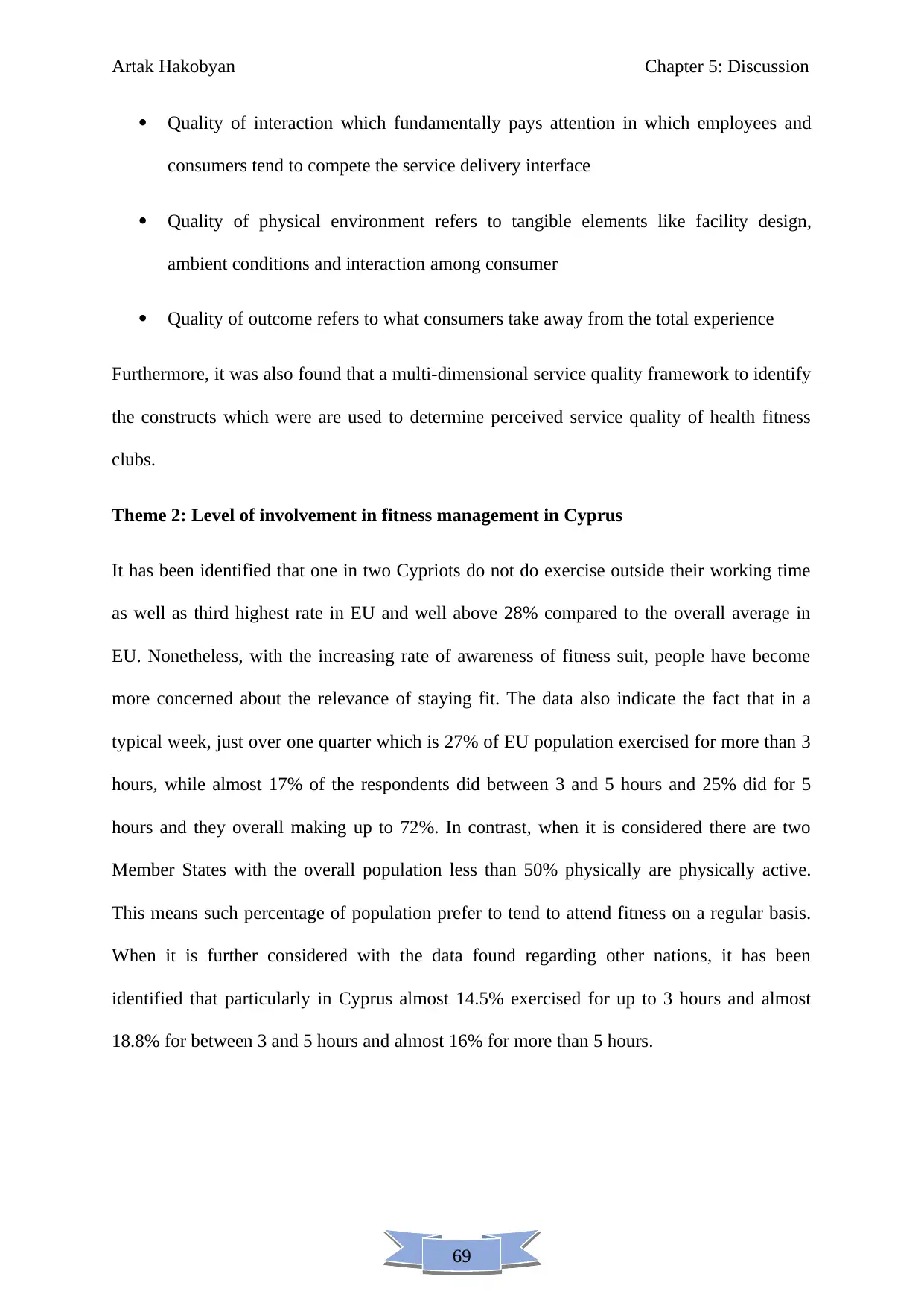
69
Artak Hakobyan Chapter 5: Discussion
Quality of interaction which fundamentally pays attention in which employees and
consumers tend to compete the service delivery interface
Quality of physical environment refers to tangible elements like facility design,
ambient conditions and interaction among consumer
Quality of outcome refers to what consumers take away from the total experience
Furthermore, it was also found that a multi-dimensional service quality framework to identify
the constructs which were are used to determine perceived service quality of health fitness
clubs.
Theme 2: Level of involvement in fitness management in Cyprus
It has been identified that one in two Cypriots do not do exercise outside their working time
as well as third highest rate in EU and well above 28% compared to the overall average in
EU. Nonetheless, with the increasing rate of awareness of fitness suit, people have become
more concerned about the relevance of staying fit. The data also indicate the fact that in a
typical week, just over one quarter which is 27% of EU population exercised for more than 3
hours, while almost 17% of the respondents did between 3 and 5 hours and 25% did for 5
hours and they overall making up to 72%. In contrast, when it is considered there are two
Member States with the overall population less than 50% physically are physically active.
This means such percentage of population prefer to tend to attend fitness on a regular basis.
When it is further considered with the data found regarding other nations, it has been
identified that particularly in Cyprus almost 14.5% exercised for up to 3 hours and almost
18.8% for between 3 and 5 hours and almost 16% for more than 5 hours.
Artak Hakobyan Chapter 5: Discussion
Quality of interaction which fundamentally pays attention in which employees and
consumers tend to compete the service delivery interface
Quality of physical environment refers to tangible elements like facility design,
ambient conditions and interaction among consumer
Quality of outcome refers to what consumers take away from the total experience
Furthermore, it was also found that a multi-dimensional service quality framework to identify
the constructs which were are used to determine perceived service quality of health fitness
clubs.
Theme 2: Level of involvement in fitness management in Cyprus
It has been identified that one in two Cypriots do not do exercise outside their working time
as well as third highest rate in EU and well above 28% compared to the overall average in
EU. Nonetheless, with the increasing rate of awareness of fitness suit, people have become
more concerned about the relevance of staying fit. The data also indicate the fact that in a
typical week, just over one quarter which is 27% of EU population exercised for more than 3
hours, while almost 17% of the respondents did between 3 and 5 hours and 25% did for 5
hours and they overall making up to 72%. In contrast, when it is considered there are two
Member States with the overall population less than 50% physically are physically active.
This means such percentage of population prefer to tend to attend fitness on a regular basis.
When it is further considered with the data found regarding other nations, it has been
identified that particularly in Cyprus almost 14.5% exercised for up to 3 hours and almost
18.8% for between 3 and 5 hours and almost 16% for more than 5 hours.
Secure Best Marks with AI Grader
Need help grading? Try our AI Grader for instant feedback on your assignments.
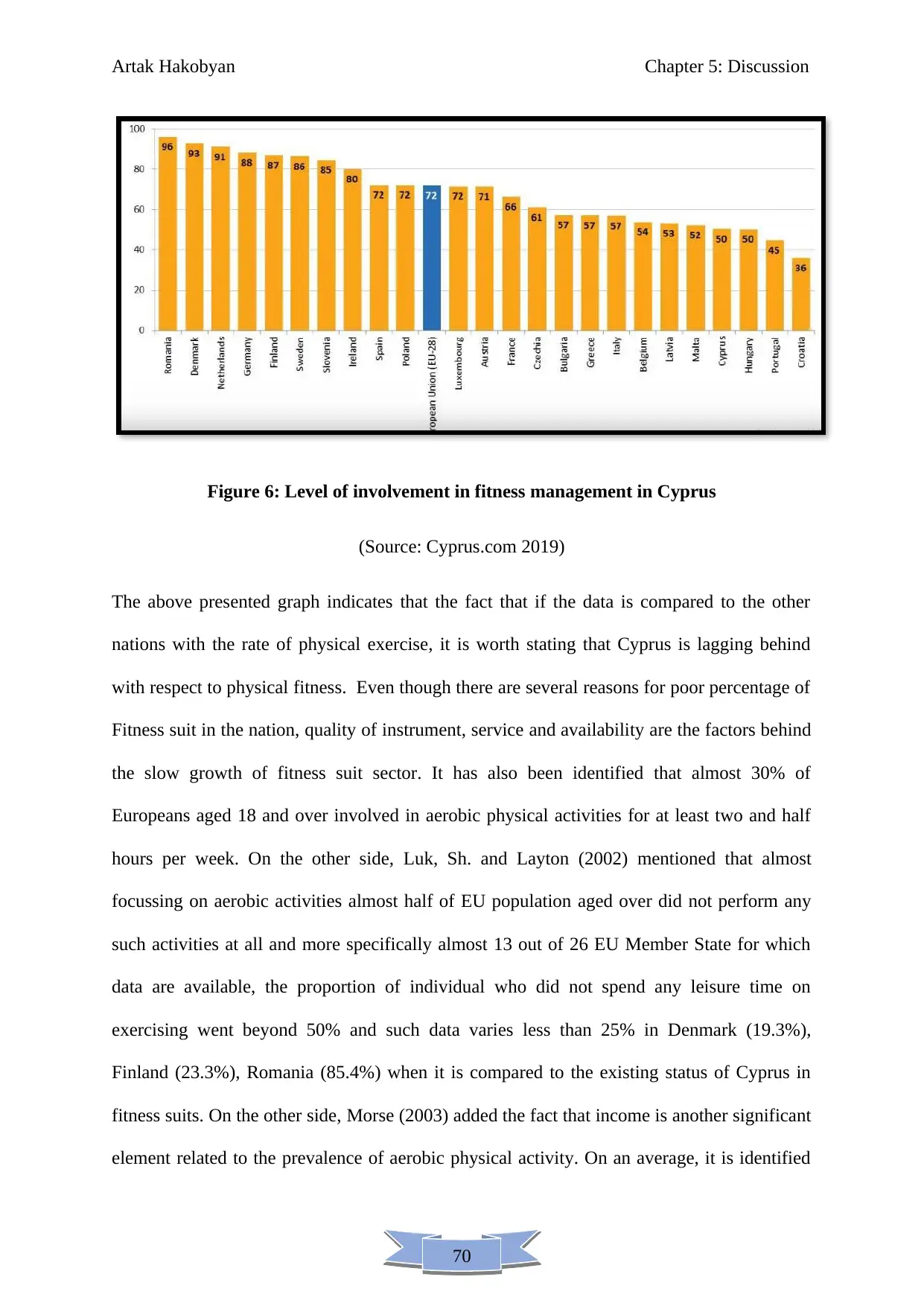
70
Artak Hakobyan Chapter 5: Discussion
Figure 6: Level of involvement in fitness management in Cyprus
(Source: Cyprus.com 2019)
The above presented graph indicates that the fact that if the data is compared to the other
nations with the rate of physical exercise, it is worth stating that Cyprus is lagging behind
with respect to physical fitness. Even though there are several reasons for poor percentage of
Fitness suit in the nation, quality of instrument, service and availability are the factors behind
the slow growth of fitness suit sector. It has also been identified that almost 30% of
Europeans aged 18 and over involved in aerobic physical activities for at least two and half
hours per week. On the other side, Luk, Sh. and Layton (2002) mentioned that almost
focussing on aerobic activities almost half of EU population aged over did not perform any
such activities at all and more specifically almost 13 out of 26 EU Member State for which
data are available, the proportion of individual who did not spend any leisure time on
exercising went beyond 50% and such data varies less than 25% in Denmark (19.3%),
Finland (23.3%), Romania (85.4%) when it is compared to the existing status of Cyprus in
fitness suits. On the other side, Morse (2003) added the fact that income is another significant
element related to the prevalence of aerobic physical activity. On an average, it is identified
Artak Hakobyan Chapter 5: Discussion
Figure 6: Level of involvement in fitness management in Cyprus
(Source: Cyprus.com 2019)
The above presented graph indicates that the fact that if the data is compared to the other
nations with the rate of physical exercise, it is worth stating that Cyprus is lagging behind
with respect to physical fitness. Even though there are several reasons for poor percentage of
Fitness suit in the nation, quality of instrument, service and availability are the factors behind
the slow growth of fitness suit sector. It has also been identified that almost 30% of
Europeans aged 18 and over involved in aerobic physical activities for at least two and half
hours per week. On the other side, Luk, Sh. and Layton (2002) mentioned that almost
focussing on aerobic activities almost half of EU population aged over did not perform any
such activities at all and more specifically almost 13 out of 26 EU Member State for which
data are available, the proportion of individual who did not spend any leisure time on
exercising went beyond 50% and such data varies less than 25% in Denmark (19.3%),
Finland (23.3%), Romania (85.4%) when it is compared to the existing status of Cyprus in
fitness suits. On the other side, Morse (2003) added the fact that income is another significant
element related to the prevalence of aerobic physical activity. On an average, it is identified
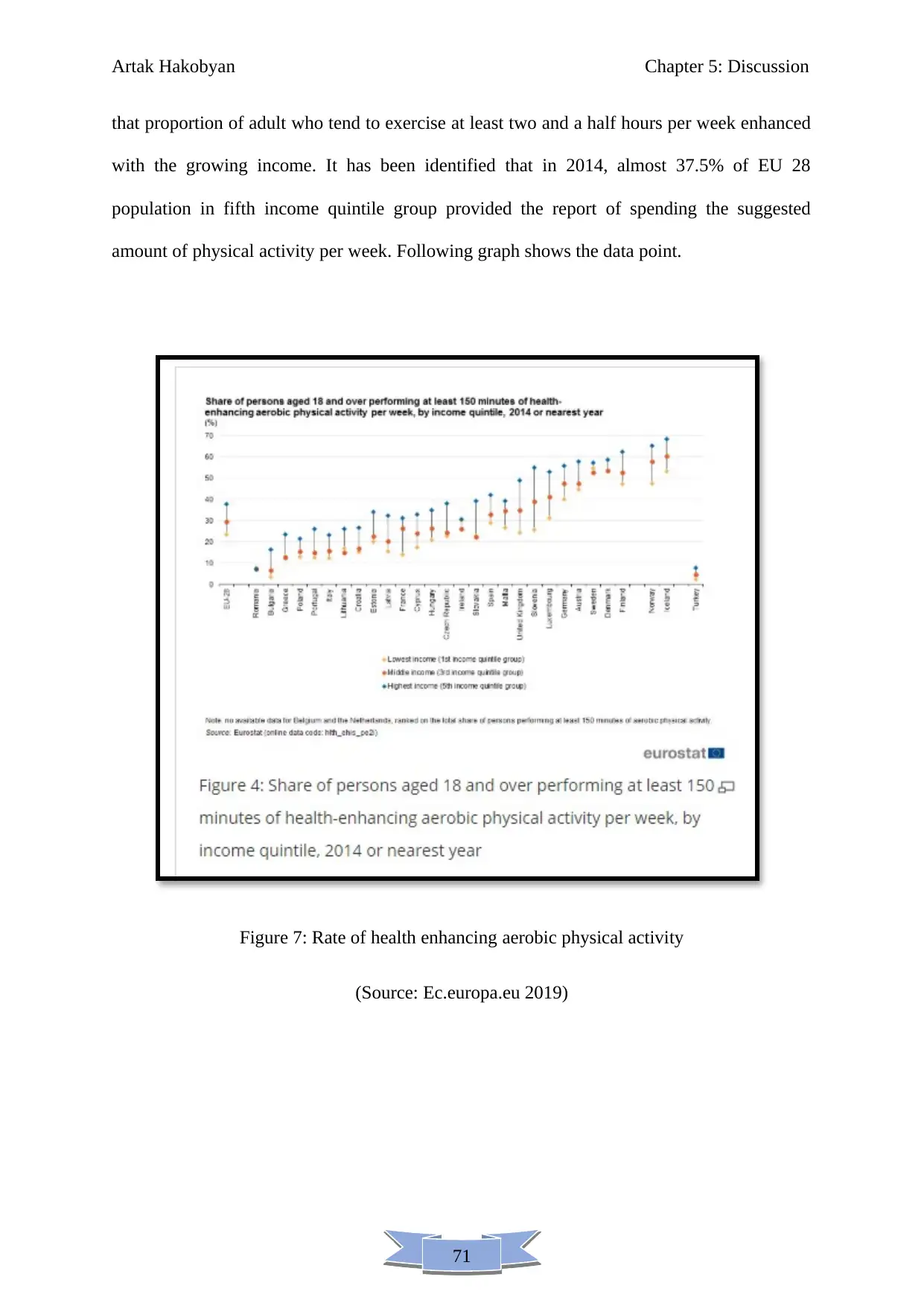
71
Artak Hakobyan Chapter 5: Discussion
that proportion of adult who tend to exercise at least two and a half hours per week enhanced
with the growing income. It has been identified that in 2014, almost 37.5% of EU 28
population in fifth income quintile group provided the report of spending the suggested
amount of physical activity per week. Following graph shows the data point.
Figure 7: Rate of health enhancing aerobic physical activity
(Source: Ec.europa.eu 2019)
Artak Hakobyan Chapter 5: Discussion
that proportion of adult who tend to exercise at least two and a half hours per week enhanced
with the growing income. It has been identified that in 2014, almost 37.5% of EU 28
population in fifth income quintile group provided the report of spending the suggested
amount of physical activity per week. Following graph shows the data point.
Figure 7: Rate of health enhancing aerobic physical activity
(Source: Ec.europa.eu 2019)
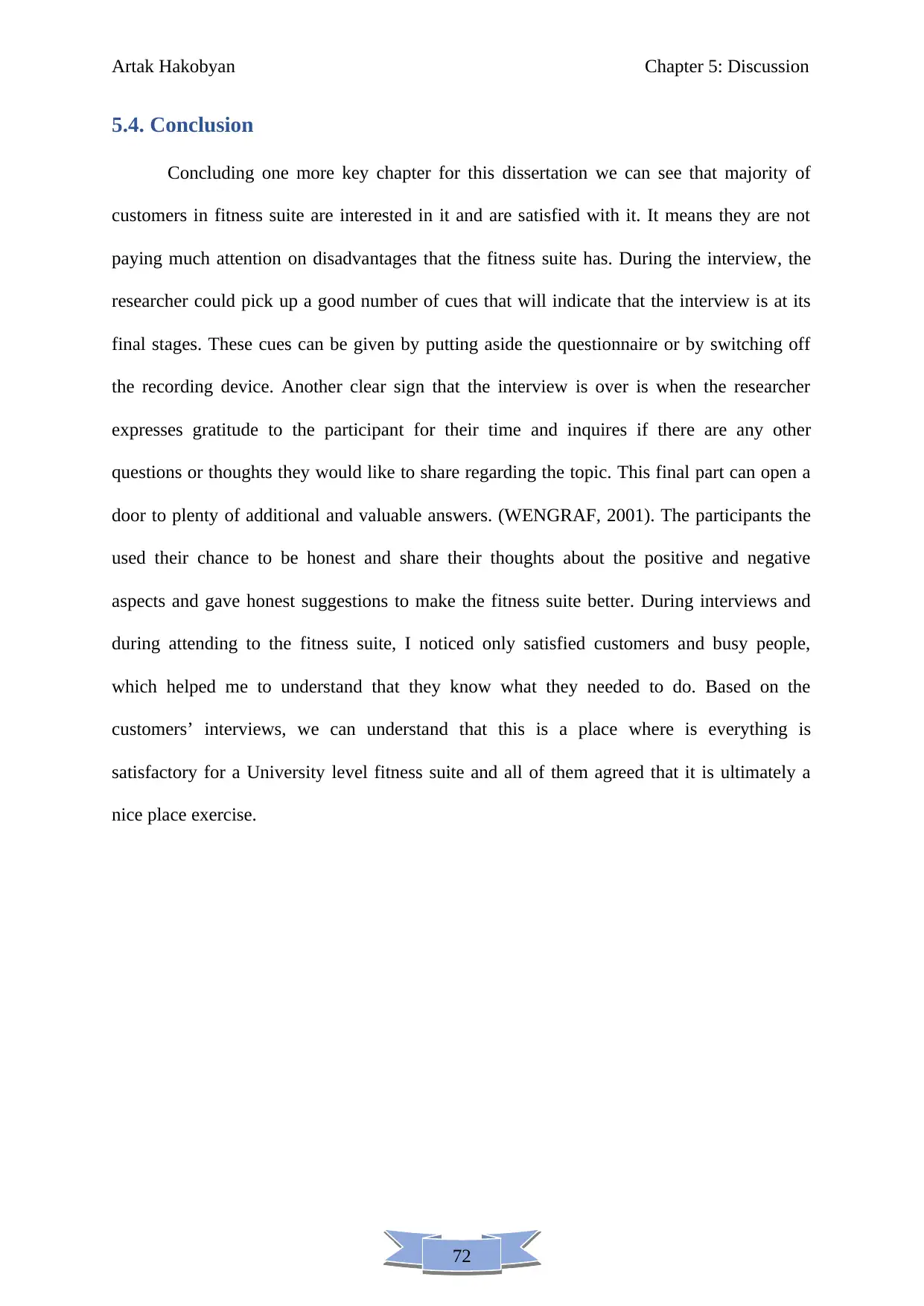
72
Artak Hakobyan Chapter 5: Discussion
5.4. Conclusion
Concluding one more key chapter for this dissertation we can see that majority of
customers in fitness suite are interested in it and are satisfied with it. It means they are not
paying much attention on disadvantages that the fitness suite has. During the interview, the
researcher could pick up a good number of cues that will indicate that the interview is at its
final stages. These cues can be given by putting aside the questionnaire or by switching off
the recording device. Another clear sign that the interview is over is when the researcher
expresses gratitude to the participant for their time and inquires if there are any other
questions or thoughts they would like to share regarding the topic. This final part can open a
door to plenty of additional and valuable answers. (WENGRAF, 2001). The participants the
used their chance to be honest and share their thoughts about the positive and negative
aspects and gave honest suggestions to make the fitness suite better. During interviews and
during attending to the fitness suite, I noticed only satisfied customers and busy people,
which helped me to understand that they know what they needed to do. Based on the
customers’ interviews, we can understand that this is a place where is everything is
satisfactory for a University level fitness suite and all of them agreed that it is ultimately a
nice place exercise.
Artak Hakobyan Chapter 5: Discussion
5.4. Conclusion
Concluding one more key chapter for this dissertation we can see that majority of
customers in fitness suite are interested in it and are satisfied with it. It means they are not
paying much attention on disadvantages that the fitness suite has. During the interview, the
researcher could pick up a good number of cues that will indicate that the interview is at its
final stages. These cues can be given by putting aside the questionnaire or by switching off
the recording device. Another clear sign that the interview is over is when the researcher
expresses gratitude to the participant for their time and inquires if there are any other
questions or thoughts they would like to share regarding the topic. This final part can open a
door to plenty of additional and valuable answers. (WENGRAF, 2001). The participants the
used their chance to be honest and share their thoughts about the positive and negative
aspects and gave honest suggestions to make the fitness suite better. During interviews and
during attending to the fitness suite, I noticed only satisfied customers and busy people,
which helped me to understand that they know what they needed to do. Based on the
customers’ interviews, we can understand that this is a place where is everything is
satisfactory for a University level fitness suite and all of them agreed that it is ultimately a
nice place exercise.
Paraphrase This Document
Need a fresh take? Get an instant paraphrase of this document with our AI Paraphraser
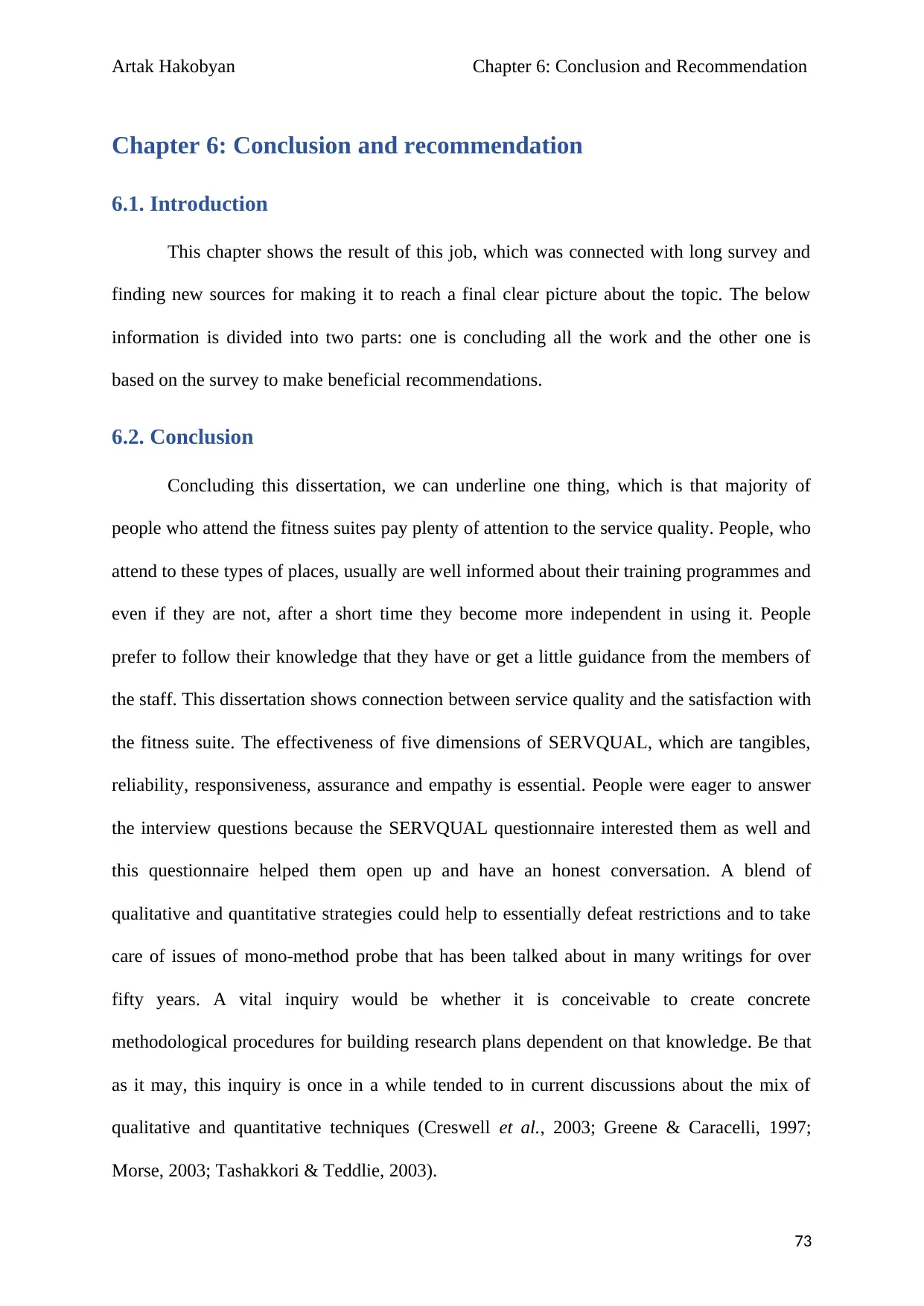
Artak Hakobyan Chapter 6: Conclusion and Recommendation
Chapter 6: Conclusion and recommendation
6.1. Introduction
This chapter shows the result of this job, which was connected with long survey and
finding new sources for making it to reach a final clear picture about the topic. The below
information is divided into two parts: one is concluding all the work and the other one is
based on the survey to make beneficial recommendations.
6.2. Conclusion
Concluding this dissertation, we can underline one thing, which is that majority of
people who attend the fitness suites pay plenty of attention to the service quality. People, who
attend to these types of places, usually are well informed about their training programmes and
even if they are not, after a short time they become more independent in using it. People
prefer to follow their knowledge that they have or get a little guidance from the members of
the staff. This dissertation shows connection between service quality and the satisfaction with
the fitness suite. The effectiveness of five dimensions of SERVQUAL, which are tangibles,
reliability, responsiveness, assurance and empathy is essential. People were eager to answer
the interview questions because the SERVQUAL questionnaire interested them as well and
this questionnaire helped them open up and have an honest conversation. A blend of
qualitative and quantitative strategies could help to essentially defeat restrictions and to take
care of issues of mono-method probe that has been talked about in many writings for over
fifty years. A vital inquiry would be whether it is conceivable to create concrete
methodological procedures for building research plans dependent on that knowledge. Be that
as it may, this inquiry is once in a while tended to in current discussions about the mix of
qualitative and quantitative techniques (Creswell et al., 2003; Greene & Caracelli, 1997;
Morse, 2003; Tashakkori & Teddlie, 2003).
73
Chapter 6: Conclusion and recommendation
6.1. Introduction
This chapter shows the result of this job, which was connected with long survey and
finding new sources for making it to reach a final clear picture about the topic. The below
information is divided into two parts: one is concluding all the work and the other one is
based on the survey to make beneficial recommendations.
6.2. Conclusion
Concluding this dissertation, we can underline one thing, which is that majority of
people who attend the fitness suites pay plenty of attention to the service quality. People, who
attend to these types of places, usually are well informed about their training programmes and
even if they are not, after a short time they become more independent in using it. People
prefer to follow their knowledge that they have or get a little guidance from the members of
the staff. This dissertation shows connection between service quality and the satisfaction with
the fitness suite. The effectiveness of five dimensions of SERVQUAL, which are tangibles,
reliability, responsiveness, assurance and empathy is essential. People were eager to answer
the interview questions because the SERVQUAL questionnaire interested them as well and
this questionnaire helped them open up and have an honest conversation. A blend of
qualitative and quantitative strategies could help to essentially defeat restrictions and to take
care of issues of mono-method probe that has been talked about in many writings for over
fifty years. A vital inquiry would be whether it is conceivable to create concrete
methodological procedures for building research plans dependent on that knowledge. Be that
as it may, this inquiry is once in a while tended to in current discussions about the mix of
qualitative and quantitative techniques (Creswell et al., 2003; Greene & Caracelli, 1997;
Morse, 2003; Tashakkori & Teddlie, 2003).
73
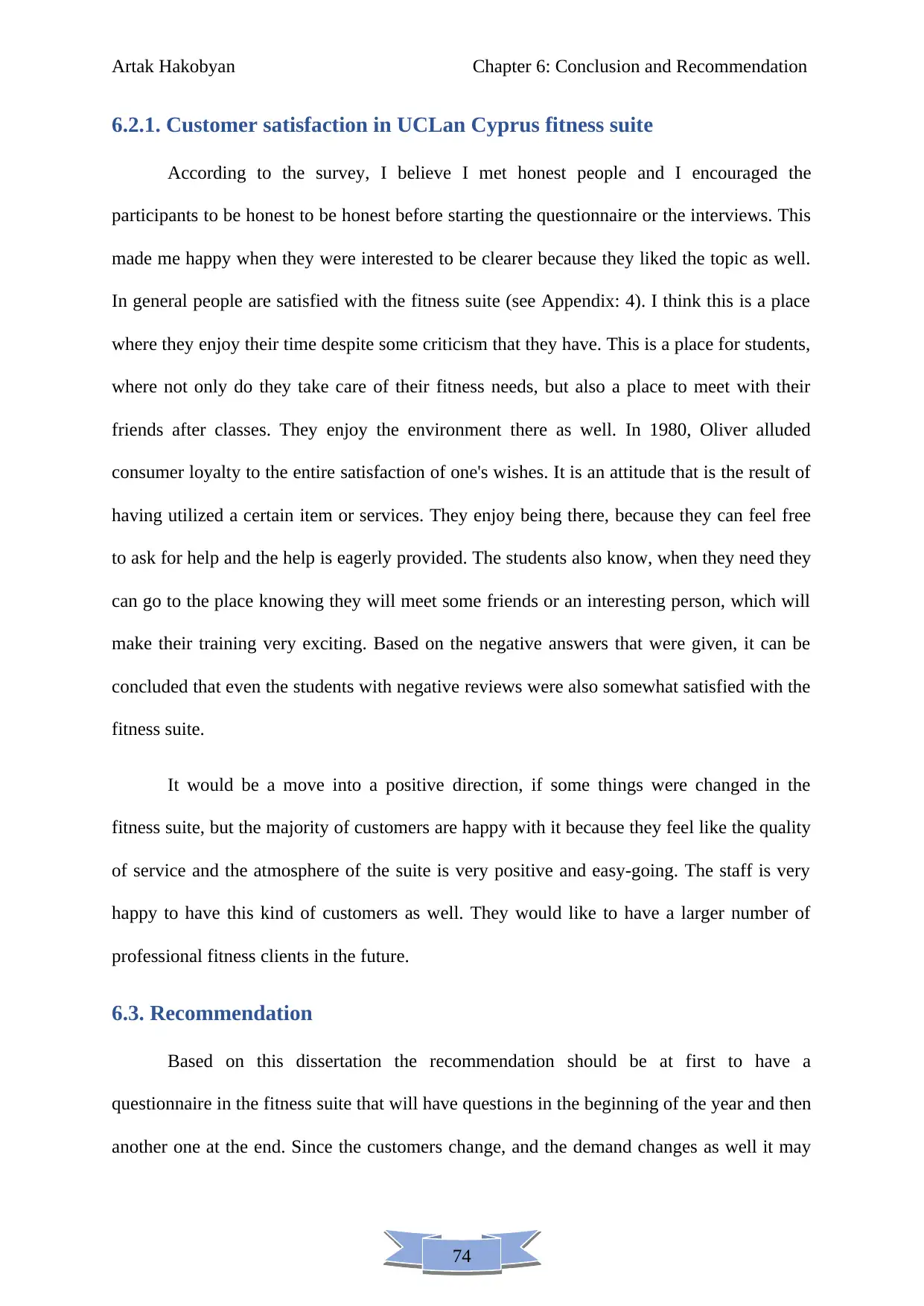
74
Artak Hakobyan Chapter 6: Conclusion and Recommendation
6.2.1. Customer satisfaction in UCLan Cyprus fitness suite
According to the survey, I believe I met honest people and I encouraged the
participants to be honest to be honest before starting the questionnaire or the interviews. This
made me happy when they were interested to be clearer because they liked the topic as well.
In general people are satisfied with the fitness suite (see Appendix: 4). I think this is a place
where they enjoy their time despite some criticism that they have. This is a place for students,
where not only do they take care of their fitness needs, but also a place to meet with their
friends after classes. They enjoy the environment there as well. In 1980, Oliver alluded
consumer loyalty to the entire satisfaction of one's wishes. It is an attitude that is the result of
having utilized a certain item or services. They enjoy being there, because they can feel free
to ask for help and the help is eagerly provided. The students also know, when they need they
can go to the place knowing they will meet some friends or an interesting person, which will
make their training very exciting. Based on the negative answers that were given, it can be
concluded that even the students with negative reviews were also somewhat satisfied with the
fitness suite.
It would be a move into a positive direction, if some things were changed in the
fitness suite, but the majority of customers are happy with it because they feel like the quality
of service and the atmosphere of the suite is very positive and easy-going. The staff is very
happy to have this kind of customers as well. They would like to have a larger number of
professional fitness clients in the future.
6.3. Recommendation
Based on this dissertation the recommendation should be at first to have a
questionnaire in the fitness suite that will have questions in the beginning of the year and then
another one at the end. Since the customers change, and the demand changes as well it may
Artak Hakobyan Chapter 6: Conclusion and Recommendation
6.2.1. Customer satisfaction in UCLan Cyprus fitness suite
According to the survey, I believe I met honest people and I encouraged the
participants to be honest to be honest before starting the questionnaire or the interviews. This
made me happy when they were interested to be clearer because they liked the topic as well.
In general people are satisfied with the fitness suite (see Appendix: 4). I think this is a place
where they enjoy their time despite some criticism that they have. This is a place for students,
where not only do they take care of their fitness needs, but also a place to meet with their
friends after classes. They enjoy the environment there as well. In 1980, Oliver alluded
consumer loyalty to the entire satisfaction of one's wishes. It is an attitude that is the result of
having utilized a certain item or services. They enjoy being there, because they can feel free
to ask for help and the help is eagerly provided. The students also know, when they need they
can go to the place knowing they will meet some friends or an interesting person, which will
make their training very exciting. Based on the negative answers that were given, it can be
concluded that even the students with negative reviews were also somewhat satisfied with the
fitness suite.
It would be a move into a positive direction, if some things were changed in the
fitness suite, but the majority of customers are happy with it because they feel like the quality
of service and the atmosphere of the suite is very positive and easy-going. The staff is very
happy to have this kind of customers as well. They would like to have a larger number of
professional fitness clients in the future.
6.3. Recommendation
Based on this dissertation the recommendation should be at first to have a
questionnaire in the fitness suite that will have questions in the beginning of the year and then
another one at the end. Since the customers change, and the demand changes as well it may
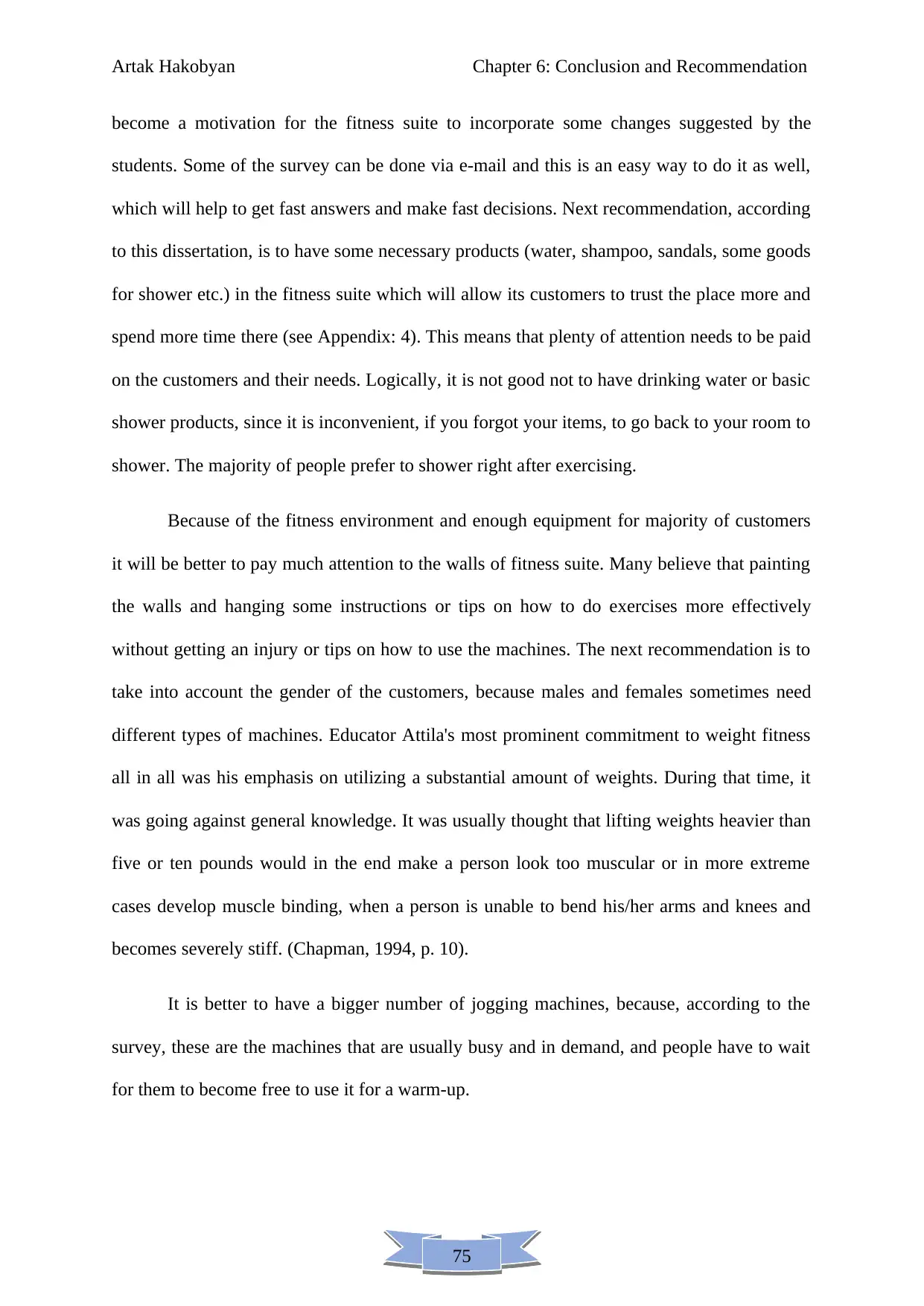
75
Artak Hakobyan Chapter 6: Conclusion and Recommendation
become a motivation for the fitness suite to incorporate some changes suggested by the
students. Some of the survey can be done via e-mail and this is an easy way to do it as well,
which will help to get fast answers and make fast decisions. Next recommendation, according
to this dissertation, is to have some necessary products (water, shampoo, sandals, some goods
for shower etc.) in the fitness suite which will allow its customers to trust the place more and
spend more time there (see Appendix: 4). This means that plenty of attention needs to be paid
on the customers and their needs. Logically, it is not good not to have drinking water or basic
shower products, since it is inconvenient, if you forgot your items, to go back to your room to
shower. The majority of people prefer to shower right after exercising.
Because of the fitness environment and enough equipment for majority of customers
it will be better to pay much attention to the walls of fitness suite. Many believe that painting
the walls and hanging some instructions or tips on how to do exercises more effectively
without getting an injury or tips on how to use the machines. The next recommendation is to
take into account the gender of the customers, because males and females sometimes need
different types of machines. Educator Attila's most prominent commitment to weight fitness
all in all was his emphasis on utilizing a substantial amount of weights. During that time, it
was going against general knowledge. It was usually thought that lifting weights heavier than
five or ten pounds would in the end make a person look too muscular or in more extreme
cases develop muscle binding, when a person is unable to bend his/her arms and knees and
becomes severely stiff. (Chapman, 1994, p. 10).
It is better to have a bigger number of jogging machines, because, according to the
survey, these are the machines that are usually busy and in demand, and people have to wait
for them to become free to use it for a warm-up.
Artak Hakobyan Chapter 6: Conclusion and Recommendation
become a motivation for the fitness suite to incorporate some changes suggested by the
students. Some of the survey can be done via e-mail and this is an easy way to do it as well,
which will help to get fast answers and make fast decisions. Next recommendation, according
to this dissertation, is to have some necessary products (water, shampoo, sandals, some goods
for shower etc.) in the fitness suite which will allow its customers to trust the place more and
spend more time there (see Appendix: 4). This means that plenty of attention needs to be paid
on the customers and their needs. Logically, it is not good not to have drinking water or basic
shower products, since it is inconvenient, if you forgot your items, to go back to your room to
shower. The majority of people prefer to shower right after exercising.
Because of the fitness environment and enough equipment for majority of customers
it will be better to pay much attention to the walls of fitness suite. Many believe that painting
the walls and hanging some instructions or tips on how to do exercises more effectively
without getting an injury or tips on how to use the machines. The next recommendation is to
take into account the gender of the customers, because males and females sometimes need
different types of machines. Educator Attila's most prominent commitment to weight fitness
all in all was his emphasis on utilizing a substantial amount of weights. During that time, it
was going against general knowledge. It was usually thought that lifting weights heavier than
five or ten pounds would in the end make a person look too muscular or in more extreme
cases develop muscle binding, when a person is unable to bend his/her arms and knees and
becomes severely stiff. (Chapman, 1994, p. 10).
It is better to have a bigger number of jogging machines, because, according to the
survey, these are the machines that are usually busy and in demand, and people have to wait
for them to become free to use it for a warm-up.
Secure Best Marks with AI Grader
Need help grading? Try our AI Grader for instant feedback on your assignments.
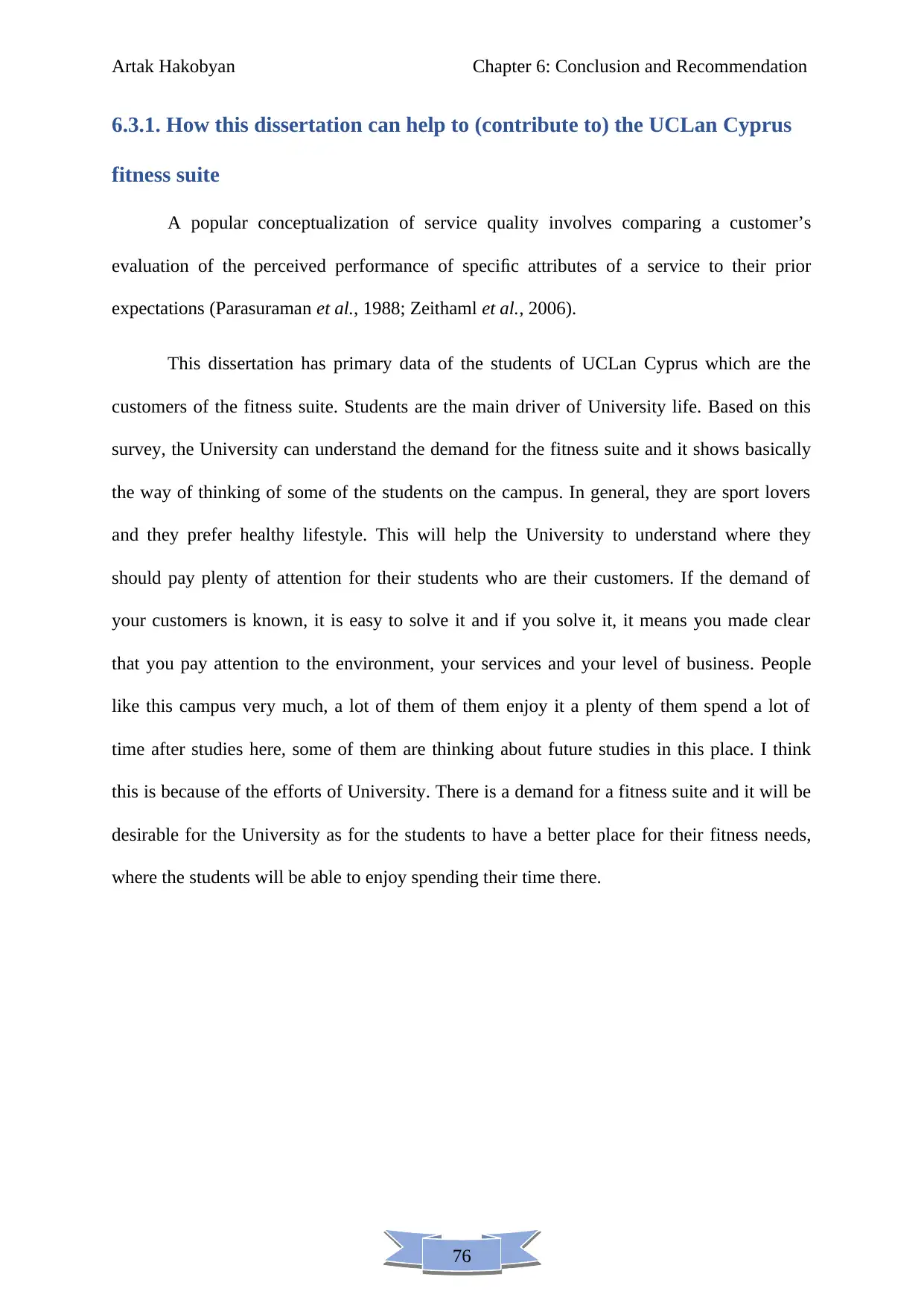
76
Artak Hakobyan Chapter 6: Conclusion and Recommendation
6.3.1. How this dissertation can help to (contribute to) the UCLan Cyprus
fitness suite
A popular conceptualization of service quality involves comparing a customer’s
evaluation of the perceived performance of specific attributes of a service to their prior
expectations (Parasuraman et al., 1988; Zeithaml et al., 2006).
This dissertation has primary data of the students of UCLan Cyprus which are the
customers of the fitness suite. Students are the main driver of University life. Based on this
survey, the University can understand the demand for the fitness suite and it shows basically
the way of thinking of some of the students on the campus. In general, they are sport lovers
and they prefer healthy lifestyle. This will help the University to understand where they
should pay plenty of attention for their students who are their customers. If the demand of
your customers is known, it is easy to solve it and if you solve it, it means you made clear
that you pay attention to the environment, your services and your level of business. People
like this campus very much, a lot of them of them enjoy it a plenty of them spend a lot of
time after studies here, some of them are thinking about future studies in this place. I think
this is because of the efforts of University. There is a demand for a fitness suite and it will be
desirable for the University as for the students to have a better place for their fitness needs,
where the students will be able to enjoy spending their time there.
Artak Hakobyan Chapter 6: Conclusion and Recommendation
6.3.1. How this dissertation can help to (contribute to) the UCLan Cyprus
fitness suite
A popular conceptualization of service quality involves comparing a customer’s
evaluation of the perceived performance of specific attributes of a service to their prior
expectations (Parasuraman et al., 1988; Zeithaml et al., 2006).
This dissertation has primary data of the students of UCLan Cyprus which are the
customers of the fitness suite. Students are the main driver of University life. Based on this
survey, the University can understand the demand for the fitness suite and it shows basically
the way of thinking of some of the students on the campus. In general, they are sport lovers
and they prefer healthy lifestyle. This will help the University to understand where they
should pay plenty of attention for their students who are their customers. If the demand of
your customers is known, it is easy to solve it and if you solve it, it means you made clear
that you pay attention to the environment, your services and your level of business. People
like this campus very much, a lot of them of them enjoy it a plenty of them spend a lot of
time after studies here, some of them are thinking about future studies in this place. I think
this is because of the efforts of University. There is a demand for a fitness suite and it will be
desirable for the University as for the students to have a better place for their fitness needs,
where the students will be able to enjoy spending their time there.
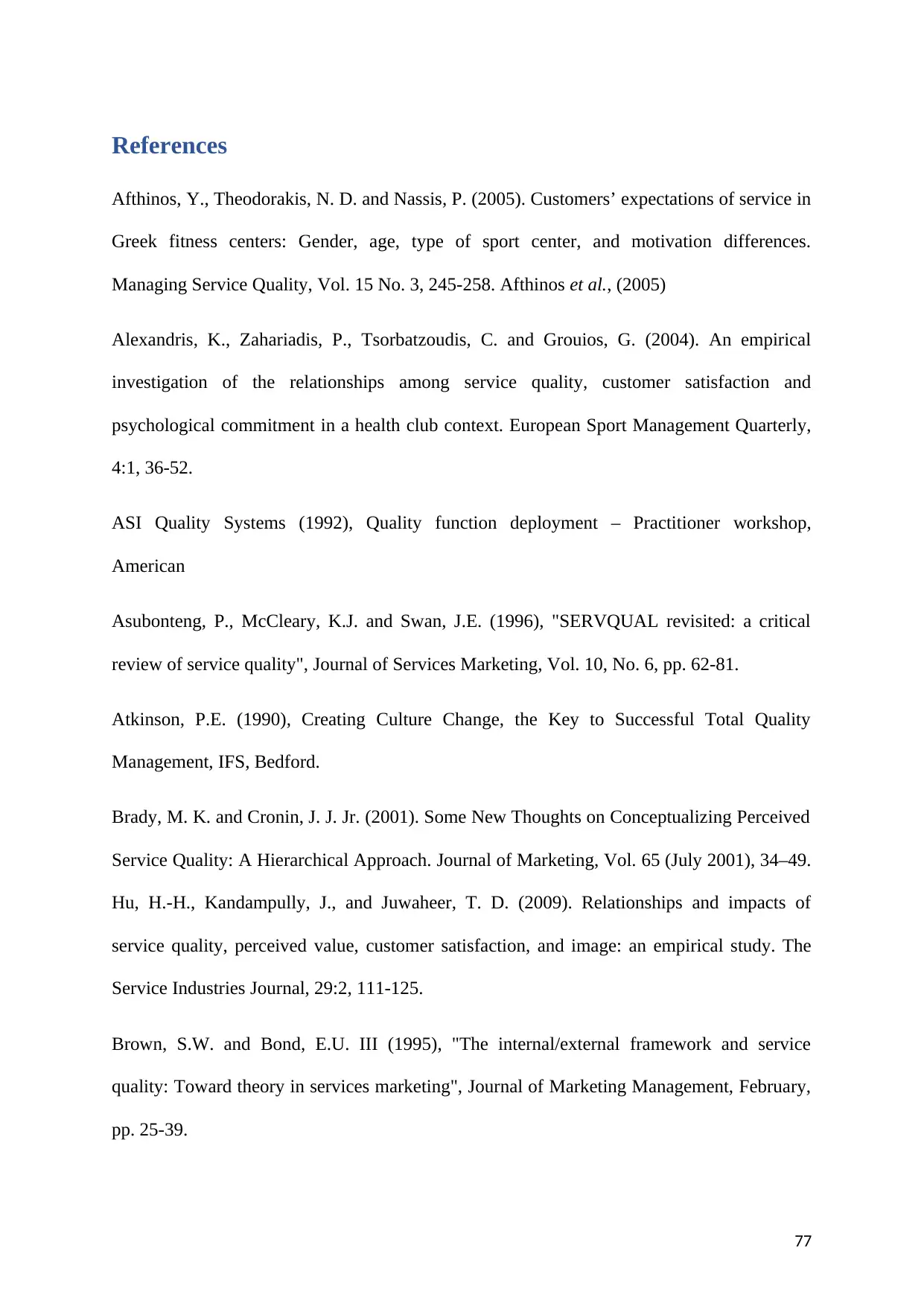
References
Afthinos, Y., Theodorakis, N. D. and Nassis, P. (2005). Customers’ expectations of service in
Greek fitness centers: Gender, age, type of sport center, and motivation differences.
Managing Service Quality, Vol. 15 No. 3, 245-258. Afthinos et al., (2005)
Alexandris, K., Zahariadis, P., Tsorbatzoudis, C. and Grouios, G. (2004). An empirical
investigation of the relationships among service quality, customer satisfaction and
psychological commitment in a health club context. European Sport Management Quarterly,
4:1, 36-52.
ASI Quality Systems (1992), Quality function deployment – Practitioner workshop,
American
Asubonteng, P., McCleary, K.J. and Swan, J.E. (1996), "SERVQUAL revisited: a critical
review of service quality", Journal of Services Marketing, Vol. 10, No. 6, pp. 62-81.
Atkinson, P.E. (1990), Creating Culture Change, the Key to Successful Total Quality
Management, IFS, Bedford.
Brady, M. K. and Cronin, J. J. Jr. (2001). Some New Thoughts on Conceptualizing Perceived
Service Quality: A Hierarchical Approach. Journal of Marketing, Vol. 65 (July 2001), 34–49.
Hu, H.-H., Kandampully, J., and Juwaheer, T. D. (2009). Relationships and impacts of
service quality, perceived value, customer satisfaction, and image: an empirical study. The
Service Industries Journal, 29:2, 111-125.
Brown, S.W. and Bond, E.U. III (1995), "The internal/external framework and service
quality: Toward theory in services marketing", Journal of Marketing Management, February,
pp. 25-39.
77
Afthinos, Y., Theodorakis, N. D. and Nassis, P. (2005). Customers’ expectations of service in
Greek fitness centers: Gender, age, type of sport center, and motivation differences.
Managing Service Quality, Vol. 15 No. 3, 245-258. Afthinos et al., (2005)
Alexandris, K., Zahariadis, P., Tsorbatzoudis, C. and Grouios, G. (2004). An empirical
investigation of the relationships among service quality, customer satisfaction and
psychological commitment in a health club context. European Sport Management Quarterly,
4:1, 36-52.
ASI Quality Systems (1992), Quality function deployment – Practitioner workshop,
American
Asubonteng, P., McCleary, K.J. and Swan, J.E. (1996), "SERVQUAL revisited: a critical
review of service quality", Journal of Services Marketing, Vol. 10, No. 6, pp. 62-81.
Atkinson, P.E. (1990), Creating Culture Change, the Key to Successful Total Quality
Management, IFS, Bedford.
Brady, M. K. and Cronin, J. J. Jr. (2001). Some New Thoughts on Conceptualizing Perceived
Service Quality: A Hierarchical Approach. Journal of Marketing, Vol. 65 (July 2001), 34–49.
Hu, H.-H., Kandampully, J., and Juwaheer, T. D. (2009). Relationships and impacts of
service quality, perceived value, customer satisfaction, and image: an empirical study. The
Service Industries Journal, 29:2, 111-125.
Brown, S.W. and Bond, E.U. III (1995), "The internal/external framework and service
quality: Toward theory in services marketing", Journal of Marketing Management, February,
pp. 25-39.
77
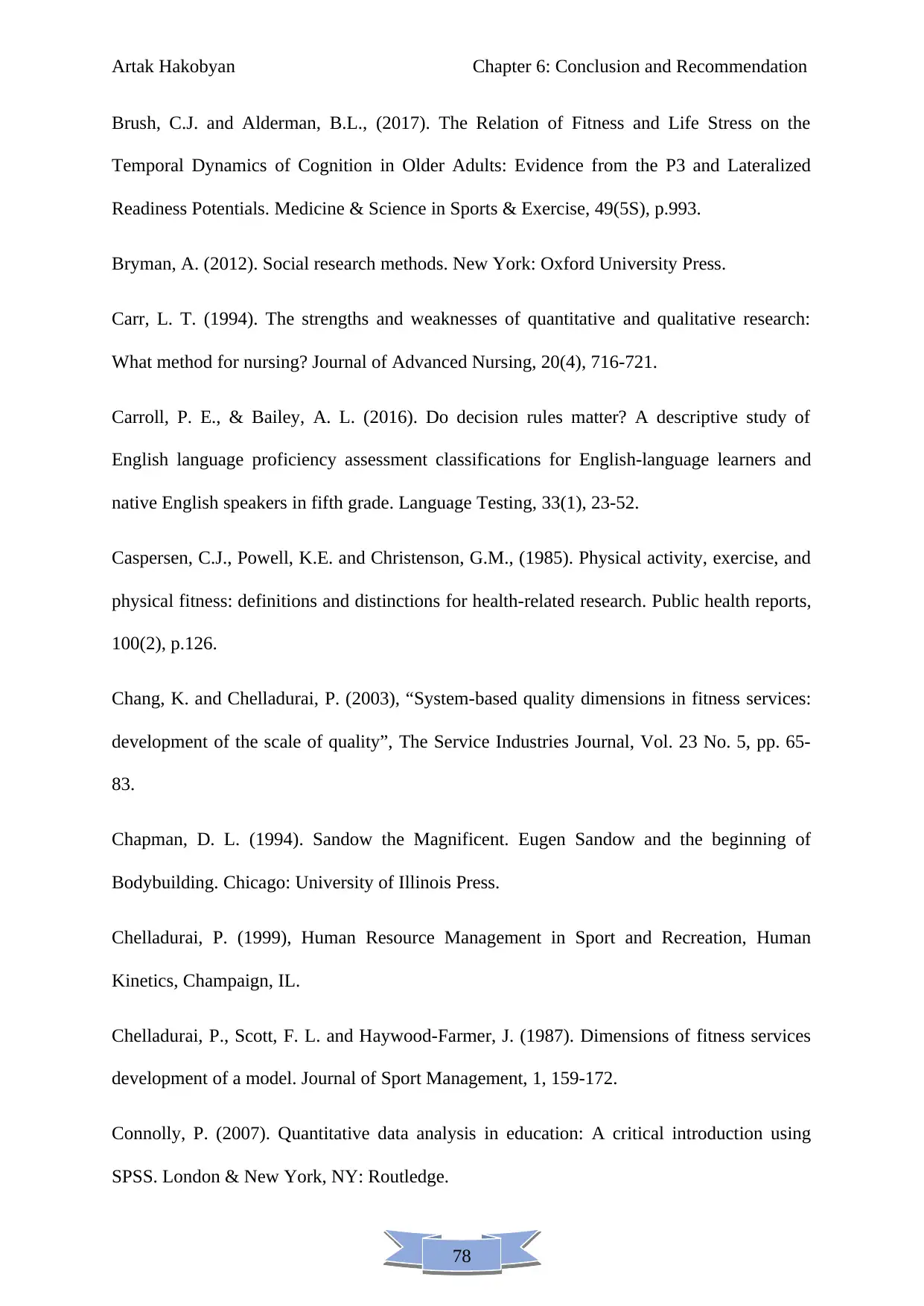
78
Artak Hakobyan Chapter 6: Conclusion and Recommendation
Brush, C.J. and Alderman, B.L., (2017). The Relation of Fitness and Life Stress on the
Temporal Dynamics of Cognition in Older Adults: Evidence from the P3 and Lateralized
Readiness Potentials. Medicine & Science in Sports & Exercise, 49(5S), p.993.
Bryman, A. (2012). Social research methods. New York: Oxford University Press.
Carr, L. T. (1994). The strengths and weaknesses of quantitative and qualitative research:
What method for nursing? Journal of Advanced Nursing, 20(4), 716-721.
Carroll, P. E., & Bailey, A. L. (2016). Do decision rules matter? A descriptive study of
English language proficiency assessment classifications for English-language learners and
native English speakers in fifth grade. Language Testing, 33(1), 23-52.
Caspersen, C.J., Powell, K.E. and Christenson, G.M., (1985). Physical activity, exercise, and
physical fitness: definitions and distinctions for health-related research. Public health reports,
100(2), p.126.
Chang, K. and Chelladurai, P. (2003), “System-based quality dimensions in fitness services:
development of the scale of quality”, The Service Industries Journal, Vol. 23 No. 5, pp. 65-
83.
Chapman, D. L. (1994). Sandow the Magnificent. Eugen Sandow and the beginning of
Bodybuilding. Chicago: University of Illinois Press.
Chelladurai, P. (1999), Human Resource Management in Sport and Recreation, Human
Kinetics, Champaign, IL.
Chelladurai, P., Scott, F. L. and Haywood-Farmer, J. (1987). Dimensions of fitness services
development of a model. Journal of Sport Management, 1, 159-172.
Connolly, P. (2007). Quantitative data analysis in education: A critical introduction using
SPSS. London & New York, NY: Routledge.
Artak Hakobyan Chapter 6: Conclusion and Recommendation
Brush, C.J. and Alderman, B.L., (2017). The Relation of Fitness and Life Stress on the
Temporal Dynamics of Cognition in Older Adults: Evidence from the P3 and Lateralized
Readiness Potentials. Medicine & Science in Sports & Exercise, 49(5S), p.993.
Bryman, A. (2012). Social research methods. New York: Oxford University Press.
Carr, L. T. (1994). The strengths and weaknesses of quantitative and qualitative research:
What method for nursing? Journal of Advanced Nursing, 20(4), 716-721.
Carroll, P. E., & Bailey, A. L. (2016). Do decision rules matter? A descriptive study of
English language proficiency assessment classifications for English-language learners and
native English speakers in fifth grade. Language Testing, 33(1), 23-52.
Caspersen, C.J., Powell, K.E. and Christenson, G.M., (1985). Physical activity, exercise, and
physical fitness: definitions and distinctions for health-related research. Public health reports,
100(2), p.126.
Chang, K. and Chelladurai, P. (2003), “System-based quality dimensions in fitness services:
development of the scale of quality”, The Service Industries Journal, Vol. 23 No. 5, pp. 65-
83.
Chapman, D. L. (1994). Sandow the Magnificent. Eugen Sandow and the beginning of
Bodybuilding. Chicago: University of Illinois Press.
Chelladurai, P. (1999), Human Resource Management in Sport and Recreation, Human
Kinetics, Champaign, IL.
Chelladurai, P., Scott, F. L. and Haywood-Farmer, J. (1987). Dimensions of fitness services
development of a model. Journal of Sport Management, 1, 159-172.
Connolly, P. (2007). Quantitative data analysis in education: A critical introduction using
SPSS. London & New York, NY: Routledge.
Paraphrase This Document
Need a fresh take? Get an instant paraphrase of this document with our AI Paraphraser
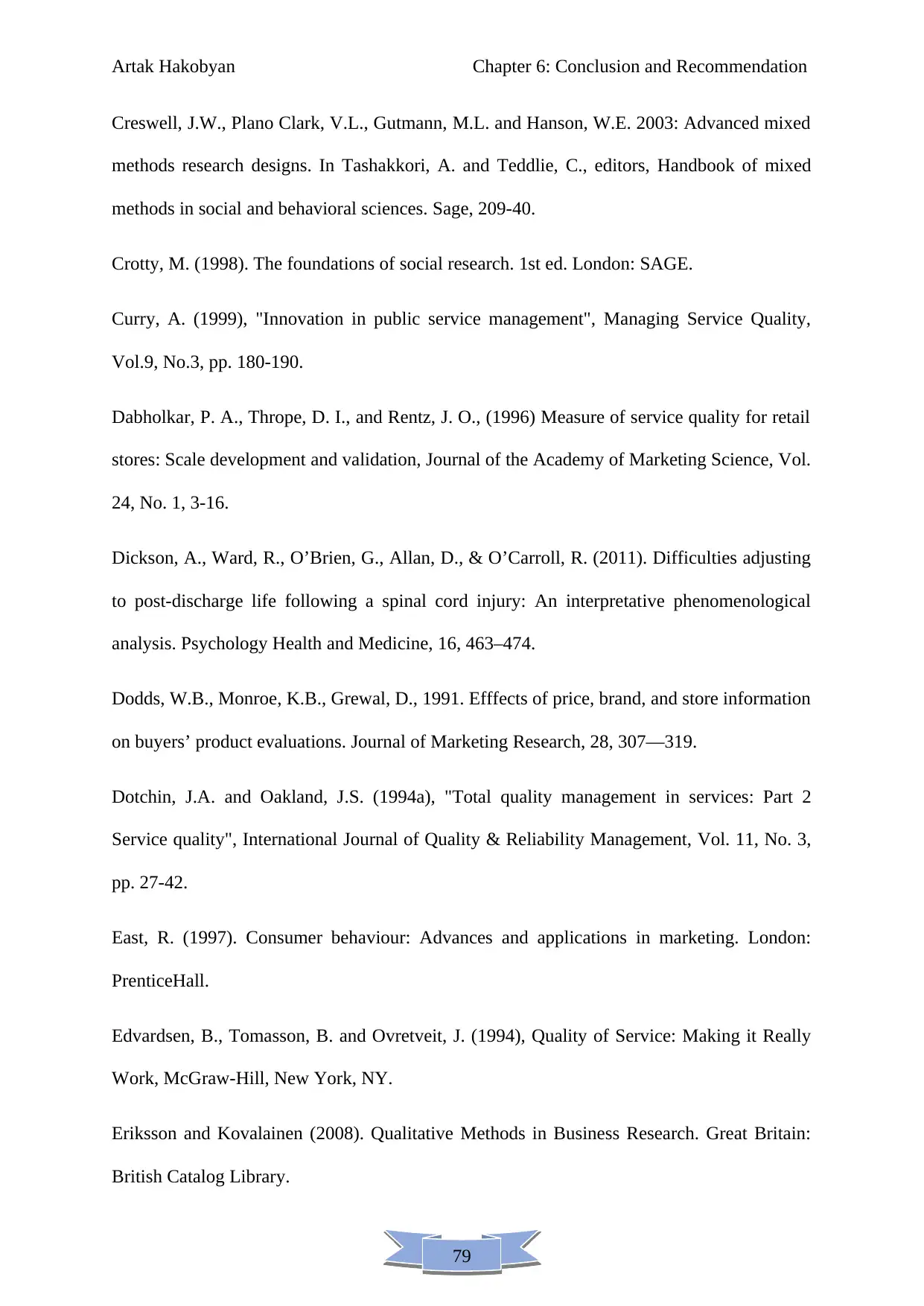
79
Artak Hakobyan Chapter 6: Conclusion and Recommendation
Creswell, J.W., Plano Clark, V.L., Gutmann, M.L. and Hanson, W.E. 2003: Advanced mixed
methods research designs. In Tashakkori, A. and Teddlie, C., editors, Handbook of mixed
methods in social and behavioral sciences. Sage, 209-40.
Crotty, M. (1998). The foundations of social research. 1st ed. London: SAGE.
Curry, A. (1999), "Innovation in public service management", Managing Service Quality,
Vol.9, No.3, pp. 180-190.
Dabholkar, P. A., Thrope, D. I., and Rentz, J. O., (1996) Measure of service quality for retail
stores: Scale development and validation, Journal of the Academy of Marketing Science, Vol.
24, No. 1, 3-16.
Dickson, A., Ward, R., O’Brien, G., Allan, D., & O’Carroll, R. (2011). Difficulties adjusting
to post-discharge life following a spinal cord injury: An interpretative phenomenological
analysis. Psychology Health and Medicine, 16, 463–474.
Dodds, W.B., Monroe, K.B., Grewal, D., 1991. Efffects of price, brand, and store information
on buyers’ product evaluations. Journal of Marketing Research, 28, 307—319.
Dotchin, J.A. and Oakland, J.S. (1994a), "Total quality management in services: Part 2
Service quality", International Journal of Quality & Reliability Management, Vol. 11, No. 3,
pp. 27-42.
East, R. (1997). Consumer behaviour: Advances and applications in marketing. London:
PrenticeHall.
Edvardsen, B., Tomasson, B. and Ovretveit, J. (1994), Quality of Service: Making it Really
Work, McGraw-Hill, New York, NY.
Eriksson and Kovalainen (2008). Qualitative Methods in Business Research. Great Britain:
British Catalog Library.
Artak Hakobyan Chapter 6: Conclusion and Recommendation
Creswell, J.W., Plano Clark, V.L., Gutmann, M.L. and Hanson, W.E. 2003: Advanced mixed
methods research designs. In Tashakkori, A. and Teddlie, C., editors, Handbook of mixed
methods in social and behavioral sciences. Sage, 209-40.
Crotty, M. (1998). The foundations of social research. 1st ed. London: SAGE.
Curry, A. (1999), "Innovation in public service management", Managing Service Quality,
Vol.9, No.3, pp. 180-190.
Dabholkar, P. A., Thrope, D. I., and Rentz, J. O., (1996) Measure of service quality for retail
stores: Scale development and validation, Journal of the Academy of Marketing Science, Vol.
24, No. 1, 3-16.
Dickson, A., Ward, R., O’Brien, G., Allan, D., & O’Carroll, R. (2011). Difficulties adjusting
to post-discharge life following a spinal cord injury: An interpretative phenomenological
analysis. Psychology Health and Medicine, 16, 463–474.
Dodds, W.B., Monroe, K.B., Grewal, D., 1991. Efffects of price, brand, and store information
on buyers’ product evaluations. Journal of Marketing Research, 28, 307—319.
Dotchin, J.A. and Oakland, J.S. (1994a), "Total quality management in services: Part 2
Service quality", International Journal of Quality & Reliability Management, Vol. 11, No. 3,
pp. 27-42.
East, R. (1997). Consumer behaviour: Advances and applications in marketing. London:
PrenticeHall.
Edvardsen, B., Tomasson, B. and Ovretveit, J. (1994), Quality of Service: Making it Really
Work, McGraw-Hill, New York, NY.
Eriksson and Kovalainen (2008). Qualitative Methods in Business Research. Great Britain:
British Catalog Library.
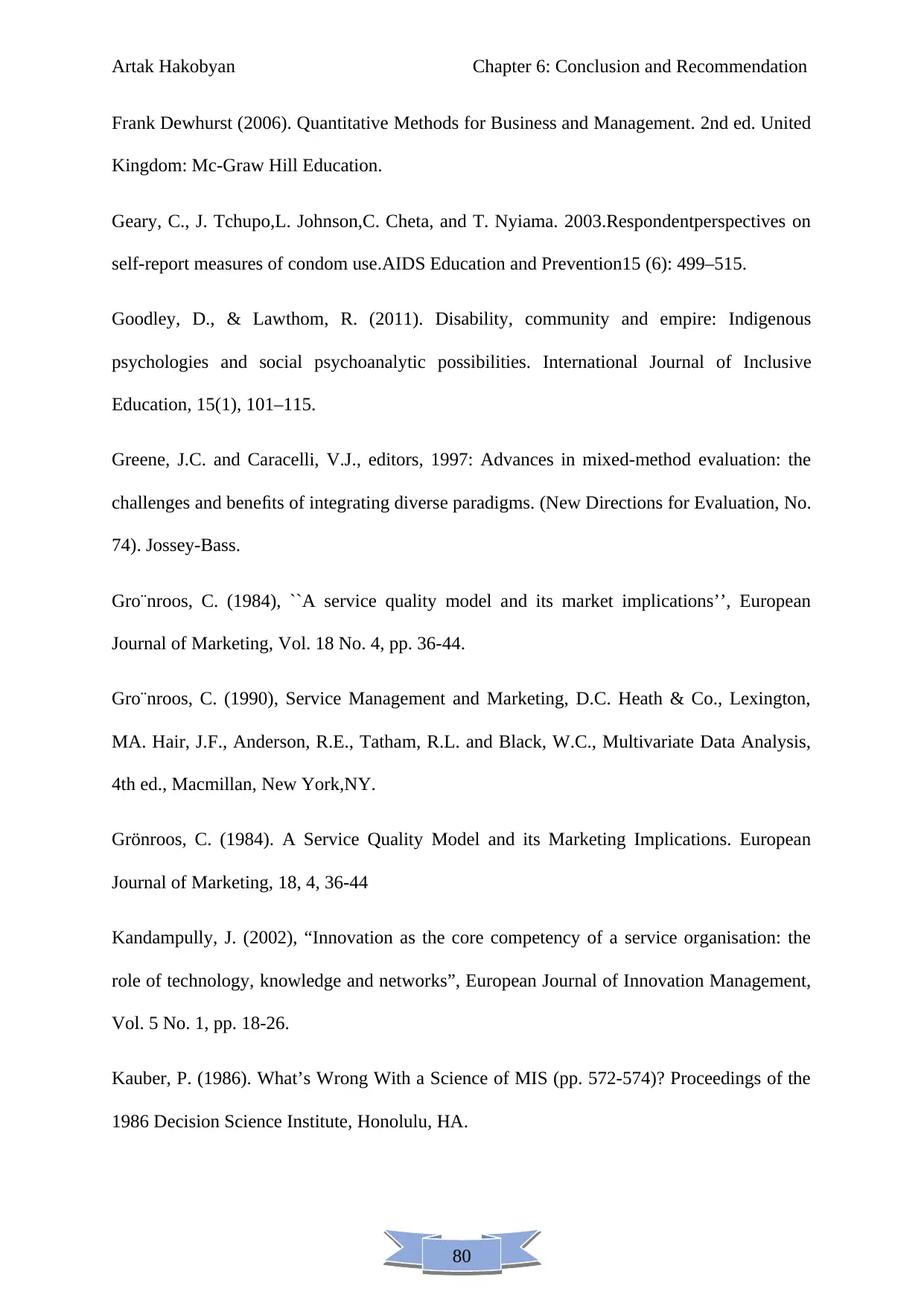
80
Artak Hakobyan Chapter 6: Conclusion and Recommendation
Frank Dewhurst (2006). Quantitative Methods for Business and Management. 2nd ed. United
Kingdom: Mc-Graw Hill Education.
Geary, C., J. Tchupo,L. Johnson,C. Cheta, and T. Nyiama. 2003.Respondentperspectives on
self-report measures of condom use.AIDS Education and Prevention15 (6): 499–515.
Goodley, D., & Lawthom, R. (2011). Disability, community and empire: Indigenous
psychologies and social psychoanalytic possibilities. International Journal of Inclusive
Education, 15(1), 101–115.
Greene, J.C. and Caracelli, V.J., editors, 1997: Advances in mixed-method evaluation: the
challenges and benefits of integrating diverse paradigms. (New Directions for Evaluation, No.
74). Jossey-Bass.
Gro¨nroos, C. (1984), ``A service quality model and its market implications’’, European
Journal of Marketing, Vol. 18 No. 4, pp. 36-44.
Gro¨nroos, C. (1990), Service Management and Marketing, D.C. Heath & Co., Lexington,
MA. Hair, J.F., Anderson, R.E., Tatham, R.L. and Black, W.C., Multivariate Data Analysis,
4th ed., Macmillan, New York,NY.
Grönroos, C. (1984). A Service Quality Model and its Marketing Implications. European
Journal of Marketing, 18, 4, 36-44
Kandampully, J. (2002), “Innovation as the core competency of a service organisation: the
role of technology, knowledge and networks”, European Journal of Innovation Management,
Vol. 5 No. 1, pp. 18-26.
Kauber, P. (1986). What’s Wrong With a Science of MIS (pp. 572-574)? Proceedings of the
1986 Decision Science Institute, Honolulu, HA.
Artak Hakobyan Chapter 6: Conclusion and Recommendation
Frank Dewhurst (2006). Quantitative Methods for Business and Management. 2nd ed. United
Kingdom: Mc-Graw Hill Education.
Geary, C., J. Tchupo,L. Johnson,C. Cheta, and T. Nyiama. 2003.Respondentperspectives on
self-report measures of condom use.AIDS Education and Prevention15 (6): 499–515.
Goodley, D., & Lawthom, R. (2011). Disability, community and empire: Indigenous
psychologies and social psychoanalytic possibilities. International Journal of Inclusive
Education, 15(1), 101–115.
Greene, J.C. and Caracelli, V.J., editors, 1997: Advances in mixed-method evaluation: the
challenges and benefits of integrating diverse paradigms. (New Directions for Evaluation, No.
74). Jossey-Bass.
Gro¨nroos, C. (1984), ``A service quality model and its market implications’’, European
Journal of Marketing, Vol. 18 No. 4, pp. 36-44.
Gro¨nroos, C. (1990), Service Management and Marketing, D.C. Heath & Co., Lexington,
MA. Hair, J.F., Anderson, R.E., Tatham, R.L. and Black, W.C., Multivariate Data Analysis,
4th ed., Macmillan, New York,NY.
Grönroos, C. (1984). A Service Quality Model and its Marketing Implications. European
Journal of Marketing, 18, 4, 36-44
Kandampully, J. (2002), “Innovation as the core competency of a service organisation: the
role of technology, knowledge and networks”, European Journal of Innovation Management,
Vol. 5 No. 1, pp. 18-26.
Kauber, P. (1986). What’s Wrong With a Science of MIS (pp. 572-574)? Proceedings of the
1986 Decision Science Institute, Honolulu, HA.
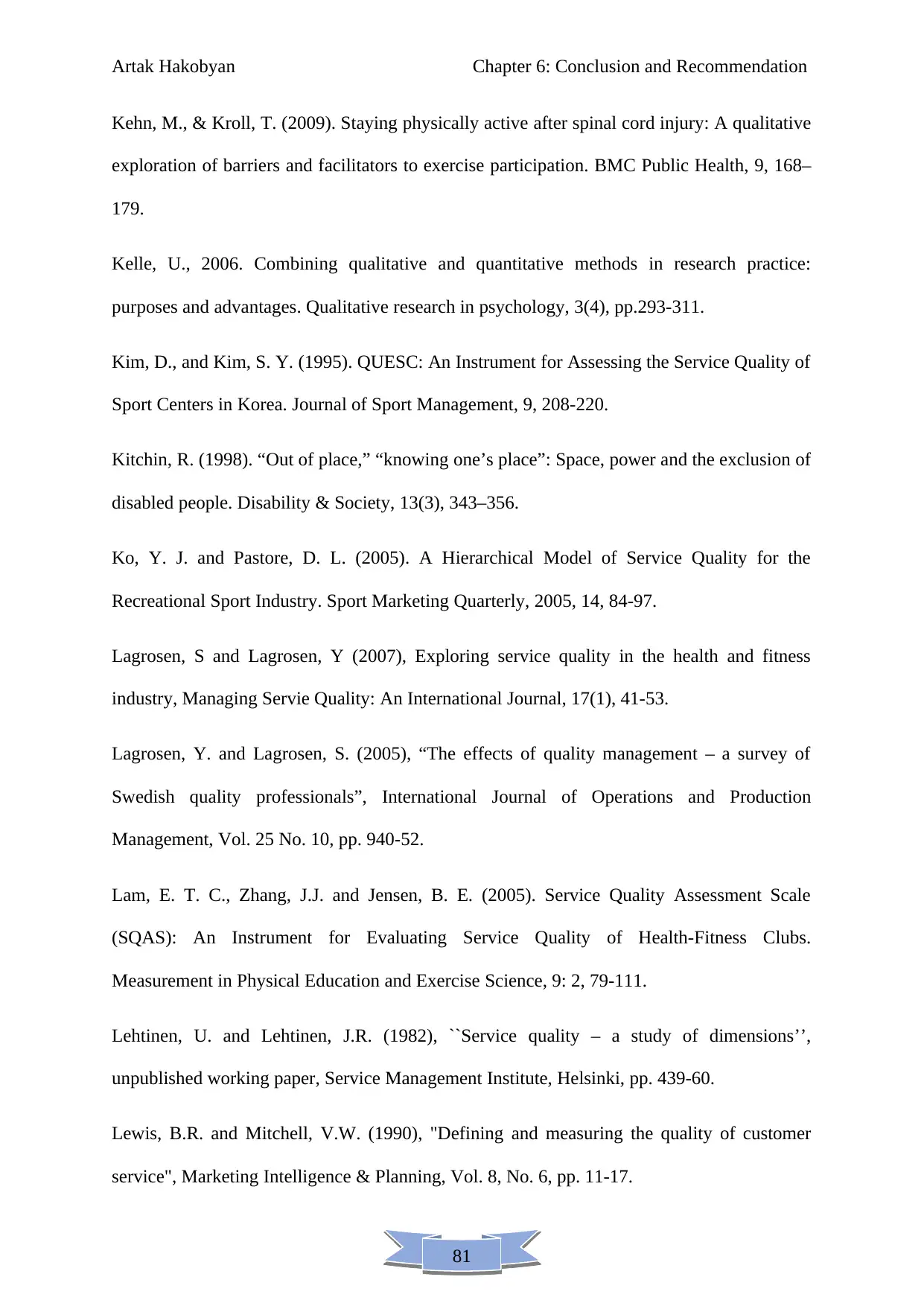
81
Artak Hakobyan Chapter 6: Conclusion and Recommendation
Kehn, M., & Kroll, T. (2009). Staying physically active after spinal cord injury: A qualitative
exploration of barriers and facilitators to exercise participation. BMC Public Health, 9, 168–
179.
Kelle, U., 2006. Combining qualitative and quantitative methods in research practice:
purposes and advantages. Qualitative research in psychology, 3(4), pp.293-311.
Kim, D., and Kim, S. Y. (1995). QUESC: An Instrument for Assessing the Service Quality of
Sport Centers in Korea. Journal of Sport Management, 9, 208-220.
Kitchin, R. (1998). “Out of place,” “knowing one’s place”: Space, power and the exclusion of
disabled people. Disability & Society, 13(3), 343–356.
Ko, Y. J. and Pastore, D. L. (2005). A Hierarchical Model of Service Quality for the
Recreational Sport Industry. Sport Marketing Quarterly, 2005, 14, 84-97.
Lagrosen, S and Lagrosen, Y (2007), Exploring service quality in the health and fitness
industry, Managing Servie Quality: An International Journal, 17(1), 41-53.
Lagrosen, Y. and Lagrosen, S. (2005), “The effects of quality management – a survey of
Swedish quality professionals”, International Journal of Operations and Production
Management, Vol. 25 No. 10, pp. 940-52.
Lam, E. T. C., Zhang, J.J. and Jensen, B. E. (2005). Service Quality Assessment Scale
(SQAS): An Instrument for Evaluating Service Quality of Health-Fitness Clubs.
Measurement in Physical Education and Exercise Science, 9: 2, 79-111.
Lehtinen, U. and Lehtinen, J.R. (1982), ``Service quality – a study of dimensions’’,
unpublished working paper, Service Management Institute, Helsinki, pp. 439-60.
Lewis, B.R. and Mitchell, V.W. (1990), "Defining and measuring the quality of customer
service", Marketing Intelligence & Planning, Vol. 8, No. 6, pp. 11-17.
Artak Hakobyan Chapter 6: Conclusion and Recommendation
Kehn, M., & Kroll, T. (2009). Staying physically active after spinal cord injury: A qualitative
exploration of barriers and facilitators to exercise participation. BMC Public Health, 9, 168–
179.
Kelle, U., 2006. Combining qualitative and quantitative methods in research practice:
purposes and advantages. Qualitative research in psychology, 3(4), pp.293-311.
Kim, D., and Kim, S. Y. (1995). QUESC: An Instrument for Assessing the Service Quality of
Sport Centers in Korea. Journal of Sport Management, 9, 208-220.
Kitchin, R. (1998). “Out of place,” “knowing one’s place”: Space, power and the exclusion of
disabled people. Disability & Society, 13(3), 343–356.
Ko, Y. J. and Pastore, D. L. (2005). A Hierarchical Model of Service Quality for the
Recreational Sport Industry. Sport Marketing Quarterly, 2005, 14, 84-97.
Lagrosen, S and Lagrosen, Y (2007), Exploring service quality in the health and fitness
industry, Managing Servie Quality: An International Journal, 17(1), 41-53.
Lagrosen, Y. and Lagrosen, S. (2005), “The effects of quality management – a survey of
Swedish quality professionals”, International Journal of Operations and Production
Management, Vol. 25 No. 10, pp. 940-52.
Lam, E. T. C., Zhang, J.J. and Jensen, B. E. (2005). Service Quality Assessment Scale
(SQAS): An Instrument for Evaluating Service Quality of Health-Fitness Clubs.
Measurement in Physical Education and Exercise Science, 9: 2, 79-111.
Lehtinen, U. and Lehtinen, J.R. (1982), ``Service quality – a study of dimensions’’,
unpublished working paper, Service Management Institute, Helsinki, pp. 439-60.
Lewis, B.R. and Mitchell, V.W. (1990), "Defining and measuring the quality of customer
service", Marketing Intelligence & Planning, Vol. 8, No. 6, pp. 11-17.
Secure Best Marks with AI Grader
Need help grading? Try our AI Grader for instant feedback on your assignments.
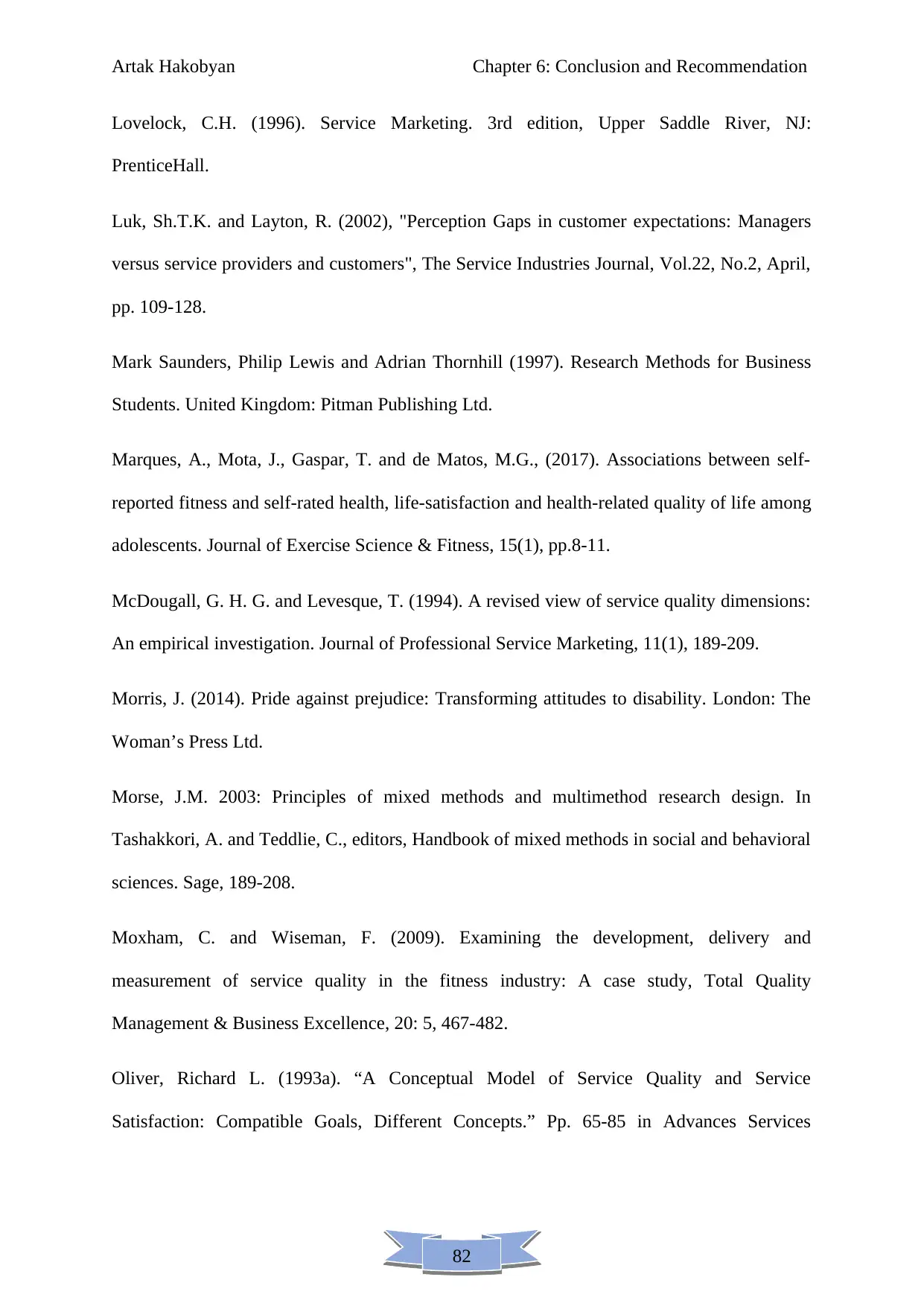
82
Artak Hakobyan Chapter 6: Conclusion and Recommendation
Lovelock, C.H. (1996). Service Marketing. 3rd edition, Upper Saddle River, NJ:
PrenticeHall.
Luk, Sh.T.K. and Layton, R. (2002), "Perception Gaps in customer expectations: Managers
versus service providers and customers", The Service Industries Journal, Vol.22, No.2, April,
pp. 109-128.
Mark Saunders, Philip Lewis and Adrian Thornhill (1997). Research Methods for Business
Students. United Kingdom: Pitman Publishing Ltd.
Marques, A., Mota, J., Gaspar, T. and de Matos, M.G., (2017). Associations between self-
reported fitness and self-rated health, life-satisfaction and health-related quality of life among
adolescents. Journal of Exercise Science & Fitness, 15(1), pp.8-11.
McDougall, G. H. G. and Levesque, T. (1994). A revised view of service quality dimensions:
An empirical investigation. Journal of Professional Service Marketing, 11(1), 189-209.
Morris, J. (2014). Pride against prejudice: Transforming attitudes to disability. London: The
Woman’s Press Ltd.
Morse, J.M. 2003: Principles of mixed methods and multimethod research design. In
Tashakkori, A. and Teddlie, C., editors, Handbook of mixed methods in social and behavioral
sciences. Sage, 189-208.
Moxham, C. and Wiseman, F. (2009). Examining the development, delivery and
measurement of service quality in the fitness industry: A case study, Total Quality
Management & Business Excellence, 20: 5, 467-482.
Oliver, Richard L. (1993a). “A Conceptual Model of Service Quality and Service
Satisfaction: Compatible Goals, Different Concepts.” Pp. 65-85 in Advances Services
Artak Hakobyan Chapter 6: Conclusion and Recommendation
Lovelock, C.H. (1996). Service Marketing. 3rd edition, Upper Saddle River, NJ:
PrenticeHall.
Luk, Sh.T.K. and Layton, R. (2002), "Perception Gaps in customer expectations: Managers
versus service providers and customers", The Service Industries Journal, Vol.22, No.2, April,
pp. 109-128.
Mark Saunders, Philip Lewis and Adrian Thornhill (1997). Research Methods for Business
Students. United Kingdom: Pitman Publishing Ltd.
Marques, A., Mota, J., Gaspar, T. and de Matos, M.G., (2017). Associations between self-
reported fitness and self-rated health, life-satisfaction and health-related quality of life among
adolescents. Journal of Exercise Science & Fitness, 15(1), pp.8-11.
McDougall, G. H. G. and Levesque, T. (1994). A revised view of service quality dimensions:
An empirical investigation. Journal of Professional Service Marketing, 11(1), 189-209.
Morris, J. (2014). Pride against prejudice: Transforming attitudes to disability. London: The
Woman’s Press Ltd.
Morse, J.M. 2003: Principles of mixed methods and multimethod research design. In
Tashakkori, A. and Teddlie, C., editors, Handbook of mixed methods in social and behavioral
sciences. Sage, 189-208.
Moxham, C. and Wiseman, F. (2009). Examining the development, delivery and
measurement of service quality in the fitness industry: A case study, Total Quality
Management & Business Excellence, 20: 5, 467-482.
Oliver, Richard L. (1993a). “A Conceptual Model of Service Quality and Service
Satisfaction: Compatible Goals, Different Concepts.” Pp. 65-85 in Advances Services
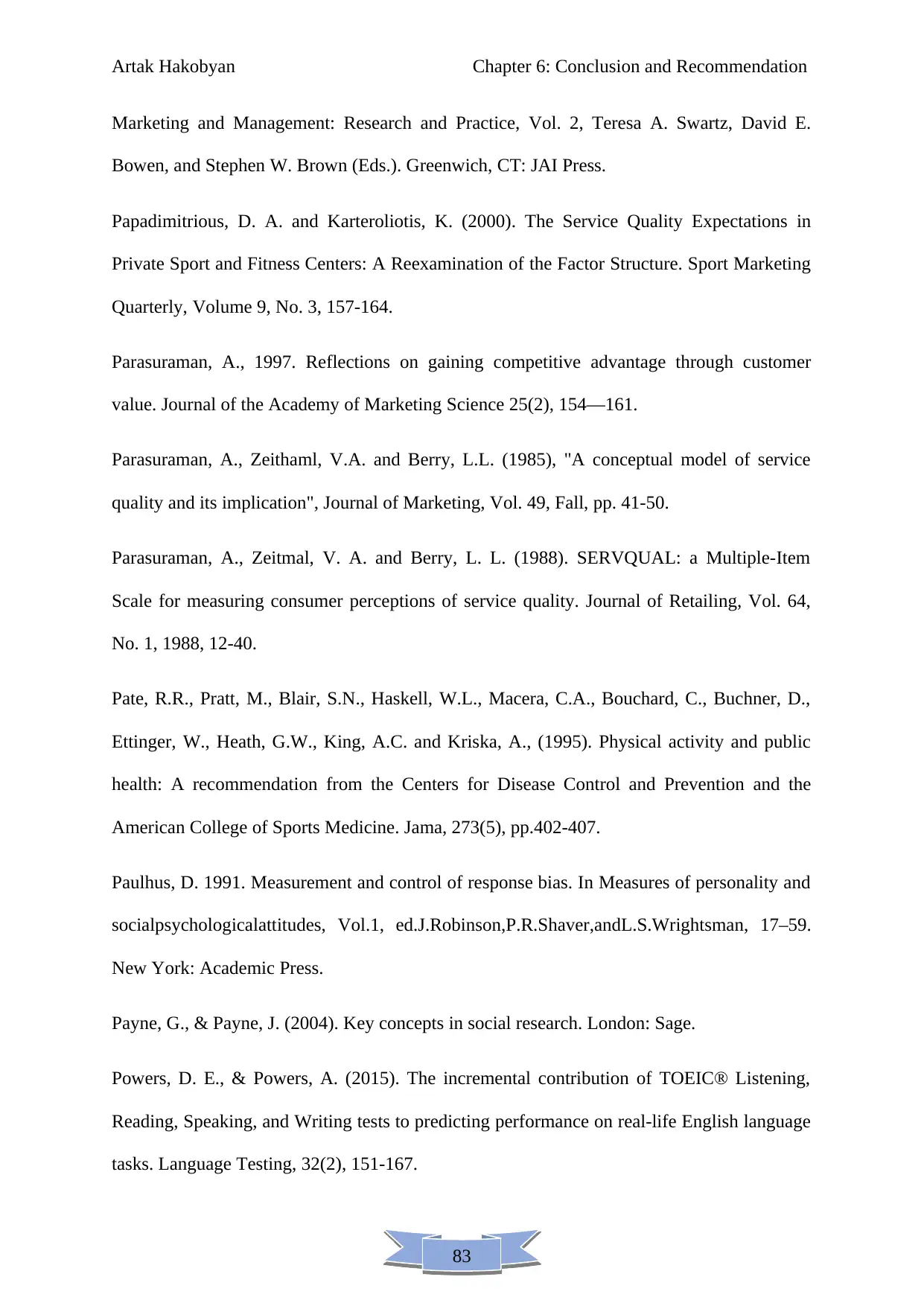
83
Artak Hakobyan Chapter 6: Conclusion and Recommendation
Marketing and Management: Research and Practice, Vol. 2, Teresa A. Swartz, David E.
Bowen, and Stephen W. Brown (Eds.). Greenwich, CT: JAI Press.
Papadimitrious, D. A. and Karteroliotis, K. (2000). The Service Quality Expectations in
Private Sport and Fitness Centers: A Reexamination of the Factor Structure. Sport Marketing
Quarterly, Volume 9, No. 3, 157-164.
Parasuraman, A., 1997. Reflections on gaining competitive advantage through customer
value. Journal of the Academy of Marketing Science 25(2), 154—161.
Parasuraman, A., Zeithaml, V.A. and Berry, L.L. (1985), "A conceptual model of service
quality and its implication", Journal of Marketing, Vol. 49, Fall, pp. 41-50.
Parasuraman, A., Zeitmal, V. A. and Berry, L. L. (1988). SERVQUAL: a Multiple-Item
Scale for measuring consumer perceptions of service quality. Journal of Retailing, Vol. 64,
No. 1, 1988, 12-40.
Pate, R.R., Pratt, M., Blair, S.N., Haskell, W.L., Macera, C.A., Bouchard, C., Buchner, D.,
Ettinger, W., Heath, G.W., King, A.C. and Kriska, A., (1995). Physical activity and public
health: A recommendation from the Centers for Disease Control and Prevention and the
American College of Sports Medicine. Jama, 273(5), pp.402-407.
Paulhus, D. 1991. Measurement and control of response bias. In Measures of personality and
socialpsychologicalattitudes, Vol.1, ed.J.Robinson,P.R.Shaver,andL.S.Wrightsman, 17–59.
New York: Academic Press.
Payne, G., & Payne, J. (2004). Key concepts in social research. London: Sage.
Powers, D. E., & Powers, A. (2015). The incremental contribution of TOEIC® Listening,
Reading, Speaking, and Writing tests to predicting performance on real-life English language
tasks. Language Testing, 32(2), 151-167.
Artak Hakobyan Chapter 6: Conclusion and Recommendation
Marketing and Management: Research and Practice, Vol. 2, Teresa A. Swartz, David E.
Bowen, and Stephen W. Brown (Eds.). Greenwich, CT: JAI Press.
Papadimitrious, D. A. and Karteroliotis, K. (2000). The Service Quality Expectations in
Private Sport and Fitness Centers: A Reexamination of the Factor Structure. Sport Marketing
Quarterly, Volume 9, No. 3, 157-164.
Parasuraman, A., 1997. Reflections on gaining competitive advantage through customer
value. Journal of the Academy of Marketing Science 25(2), 154—161.
Parasuraman, A., Zeithaml, V.A. and Berry, L.L. (1985), "A conceptual model of service
quality and its implication", Journal of Marketing, Vol. 49, Fall, pp. 41-50.
Parasuraman, A., Zeitmal, V. A. and Berry, L. L. (1988). SERVQUAL: a Multiple-Item
Scale for measuring consumer perceptions of service quality. Journal of Retailing, Vol. 64,
No. 1, 1988, 12-40.
Pate, R.R., Pratt, M., Blair, S.N., Haskell, W.L., Macera, C.A., Bouchard, C., Buchner, D.,
Ettinger, W., Heath, G.W., King, A.C. and Kriska, A., (1995). Physical activity and public
health: A recommendation from the Centers for Disease Control and Prevention and the
American College of Sports Medicine. Jama, 273(5), pp.402-407.
Paulhus, D. 1991. Measurement and control of response bias. In Measures of personality and
socialpsychologicalattitudes, Vol.1, ed.J.Robinson,P.R.Shaver,andL.S.Wrightsman, 17–59.
New York: Academic Press.
Payne, G., & Payne, J. (2004). Key concepts in social research. London: Sage.
Powers, D. E., & Powers, A. (2015). The incremental contribution of TOEIC® Listening,
Reading, Speaking, and Writing tests to predicting performance on real-life English language
tasks. Language Testing, 32(2), 151-167.
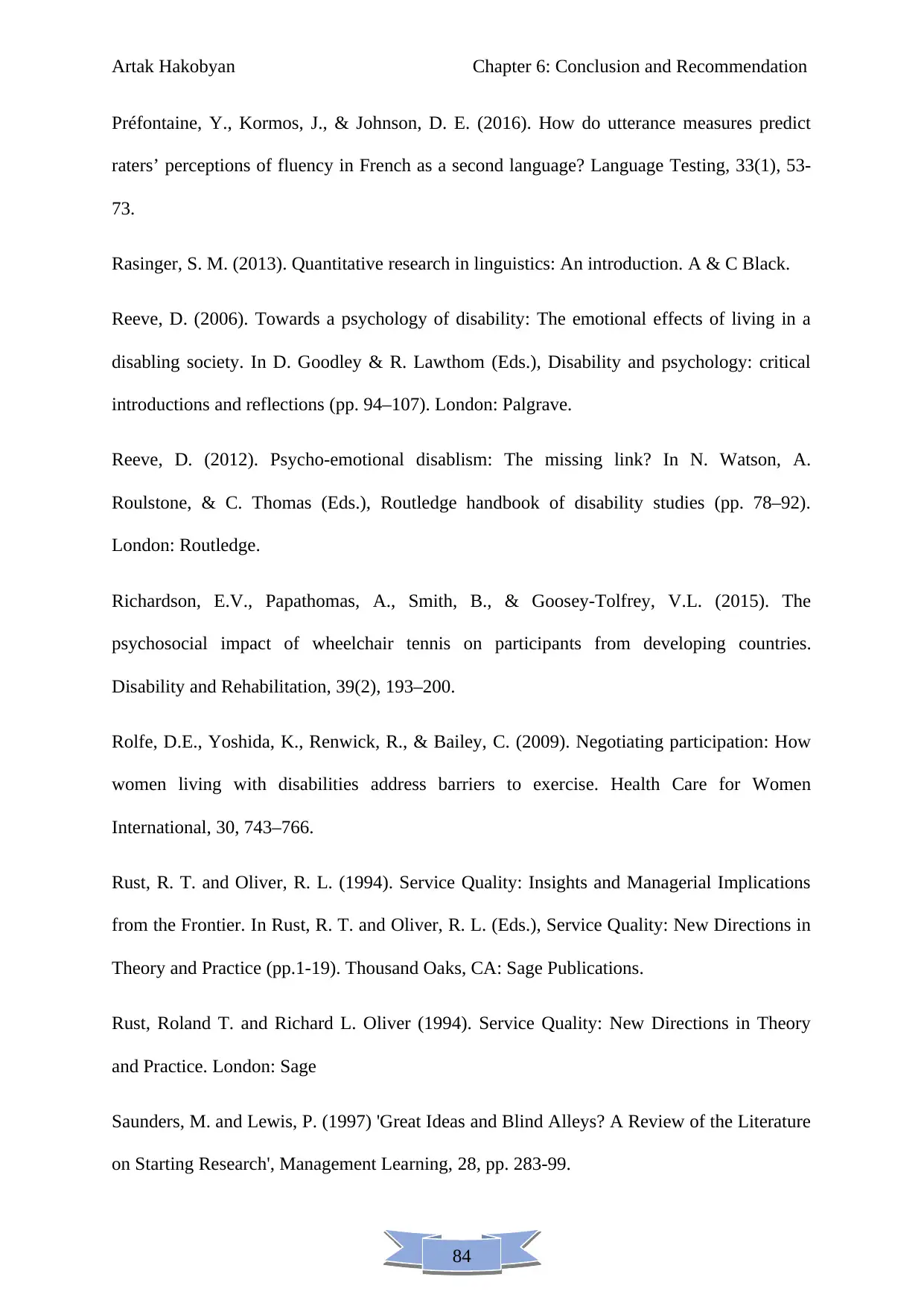
84
Artak Hakobyan Chapter 6: Conclusion and Recommendation
Préfontaine, Y., Kormos, J., & Johnson, D. E. (2016). How do utterance measures predict
raters’ perceptions of fluency in French as a second language? Language Testing, 33(1), 53-
73.
Rasinger, S. M. (2013). Quantitative research in linguistics: An introduction. A & C Black.
Reeve, D. (2006). Towards a psychology of disability: The emotional effects of living in a
disabling society. In D. Goodley & R. Lawthom (Eds.), Disability and psychology: critical
introductions and reflections (pp. 94–107). London: Palgrave.
Reeve, D. (2012). Psycho-emotional disablism: The missing link? In N. Watson, A.
Roulstone, & C. Thomas (Eds.), Routledge handbook of disability studies (pp. 78–92).
London: Routledge.
Richardson, E.V., Papathomas, A., Smith, B., & Goosey-Tolfrey, V.L. (2015). The
psychosocial impact of wheelchair tennis on participants from developing countries.
Disability and Rehabilitation, 39(2), 193–200.
Rolfe, D.E., Yoshida, K., Renwick, R., & Bailey, C. (2009). Negotiating participation: How
women living with disabilities address barriers to exercise. Health Care for Women
International, 30, 743–766.
Rust, R. T. and Oliver, R. L. (1994). Service Quality: Insights and Managerial Implications
from the Frontier. In Rust, R. T. and Oliver, R. L. (Eds.), Service Quality: New Directions in
Theory and Practice (pp.1-19). Thousand Oaks, CA: Sage Publications.
Rust, Roland T. and Richard L. Oliver (1994). Service Quality: New Directions in Theory
and Practice. London: Sage
Saunders, M. and Lewis, P. (1997) 'Great Ideas and Blind Alleys? A Review of the Literature
on Starting Research', Management Learning, 28, pp. 283-99.
Artak Hakobyan Chapter 6: Conclusion and Recommendation
Préfontaine, Y., Kormos, J., & Johnson, D. E. (2016). How do utterance measures predict
raters’ perceptions of fluency in French as a second language? Language Testing, 33(1), 53-
73.
Rasinger, S. M. (2013). Quantitative research in linguistics: An introduction. A & C Black.
Reeve, D. (2006). Towards a psychology of disability: The emotional effects of living in a
disabling society. In D. Goodley & R. Lawthom (Eds.), Disability and psychology: critical
introductions and reflections (pp. 94–107). London: Palgrave.
Reeve, D. (2012). Psycho-emotional disablism: The missing link? In N. Watson, A.
Roulstone, & C. Thomas (Eds.), Routledge handbook of disability studies (pp. 78–92).
London: Routledge.
Richardson, E.V., Papathomas, A., Smith, B., & Goosey-Tolfrey, V.L. (2015). The
psychosocial impact of wheelchair tennis on participants from developing countries.
Disability and Rehabilitation, 39(2), 193–200.
Rolfe, D.E., Yoshida, K., Renwick, R., & Bailey, C. (2009). Negotiating participation: How
women living with disabilities address barriers to exercise. Health Care for Women
International, 30, 743–766.
Rust, R. T. and Oliver, R. L. (1994). Service Quality: Insights and Managerial Implications
from the Frontier. In Rust, R. T. and Oliver, R. L. (Eds.), Service Quality: New Directions in
Theory and Practice (pp.1-19). Thousand Oaks, CA: Sage Publications.
Rust, Roland T. and Richard L. Oliver (1994). Service Quality: New Directions in Theory
and Practice. London: Sage
Saunders, M. and Lewis, P. (1997) 'Great Ideas and Blind Alleys? A Review of the Literature
on Starting Research', Management Learning, 28, pp. 283-99.
Paraphrase This Document
Need a fresh take? Get an instant paraphrase of this document with our AI Paraphraser
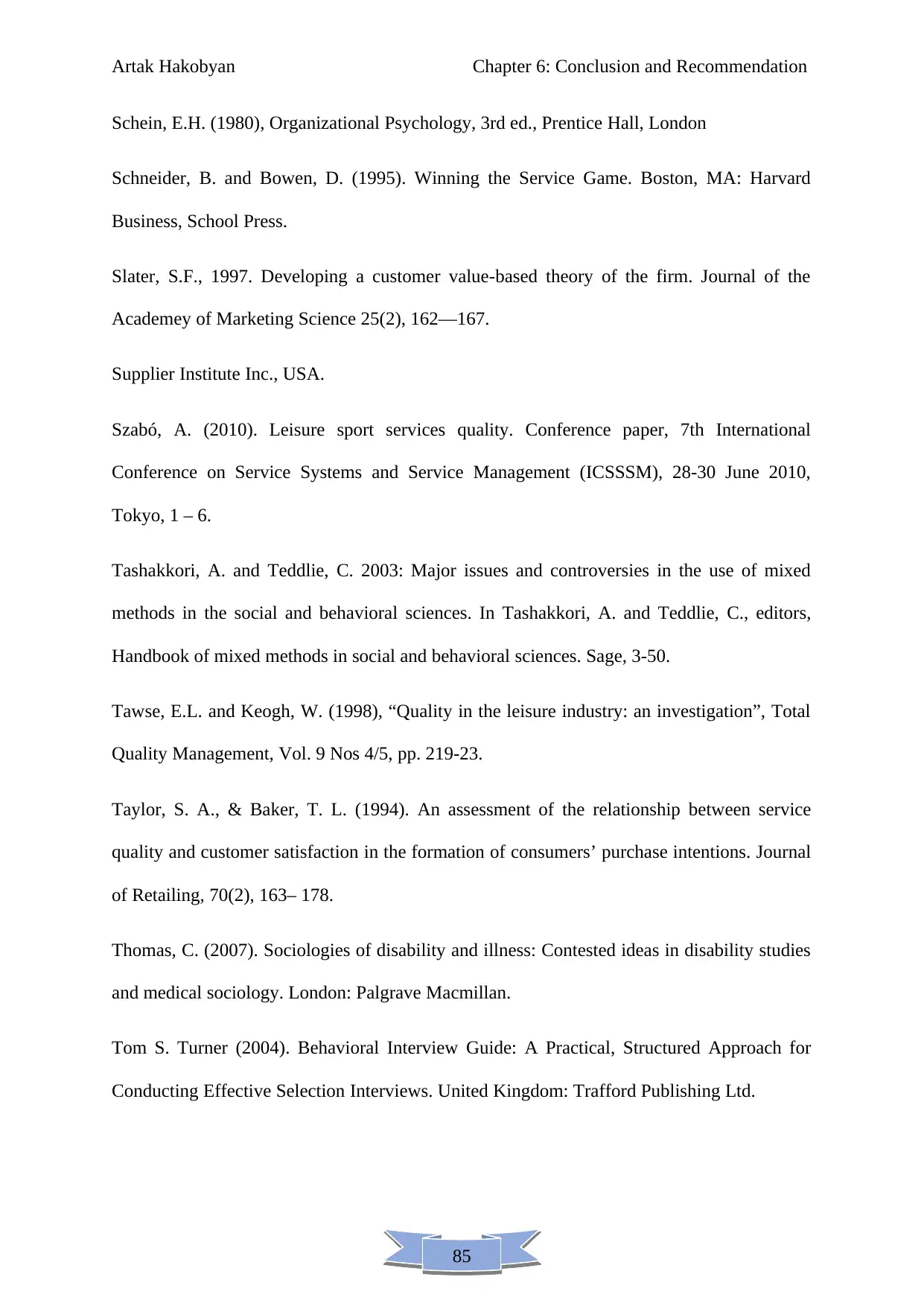
85
Artak Hakobyan Chapter 6: Conclusion and Recommendation
Schein, E.H. (1980), Organizational Psychology, 3rd ed., Prentice Hall, London
Schneider, B. and Bowen, D. (1995). Winning the Service Game. Boston, MA: Harvard
Business, School Press.
Slater, S.F., 1997. Developing a customer value-based theory of the firm. Journal of the
Academey of Marketing Science 25(2), 162—167.
Supplier Institute Inc., USA.
Szabó, A. (2010). Leisure sport services quality. Conference paper, 7th International
Conference on Service Systems and Service Management (ICSSSM), 28-30 June 2010,
Tokyo, 1 – 6.
Tashakkori, A. and Teddlie, C. 2003: Major issues and controversies in the use of mixed
methods in the social and behavioral sciences. In Tashakkori, A. and Teddlie, C., editors,
Handbook of mixed methods in social and behavioral sciences. Sage, 3-50.
Tawse, E.L. and Keogh, W. (1998), “Quality in the leisure industry: an investigation”, Total
Quality Management, Vol. 9 Nos 4/5, pp. 219-23.
Taylor, S. A., & Baker, T. L. (1994). An assessment of the relationship between service
quality and customer satisfaction in the formation of consumers’ purchase intentions. Journal
of Retailing, 70(2), 163– 178.
Thomas, C. (2007). Sociologies of disability and illness: Contested ideas in disability studies
and medical sociology. London: Palgrave Macmillan.
Tom S. Turner (2004). Behavioral Interview Guide: A Practical, Structured Approach for
Conducting Effective Selection Interviews. United Kingdom: Trafford Publishing Ltd.
Artak Hakobyan Chapter 6: Conclusion and Recommendation
Schein, E.H. (1980), Organizational Psychology, 3rd ed., Prentice Hall, London
Schneider, B. and Bowen, D. (1995). Winning the Service Game. Boston, MA: Harvard
Business, School Press.
Slater, S.F., 1997. Developing a customer value-based theory of the firm. Journal of the
Academey of Marketing Science 25(2), 162—167.
Supplier Institute Inc., USA.
Szabó, A. (2010). Leisure sport services quality. Conference paper, 7th International
Conference on Service Systems and Service Management (ICSSSM), 28-30 June 2010,
Tokyo, 1 – 6.
Tashakkori, A. and Teddlie, C. 2003: Major issues and controversies in the use of mixed
methods in the social and behavioral sciences. In Tashakkori, A. and Teddlie, C., editors,
Handbook of mixed methods in social and behavioral sciences. Sage, 3-50.
Tawse, E.L. and Keogh, W. (1998), “Quality in the leisure industry: an investigation”, Total
Quality Management, Vol. 9 Nos 4/5, pp. 219-23.
Taylor, S. A., & Baker, T. L. (1994). An assessment of the relationship between service
quality and customer satisfaction in the formation of consumers’ purchase intentions. Journal
of Retailing, 70(2), 163– 178.
Thomas, C. (2007). Sociologies of disability and illness: Contested ideas in disability studies
and medical sociology. London: Palgrave Macmillan.
Tom S. Turner (2004). Behavioral Interview Guide: A Practical, Structured Approach for
Conducting Effective Selection Interviews. United Kingdom: Trafford Publishing Ltd.
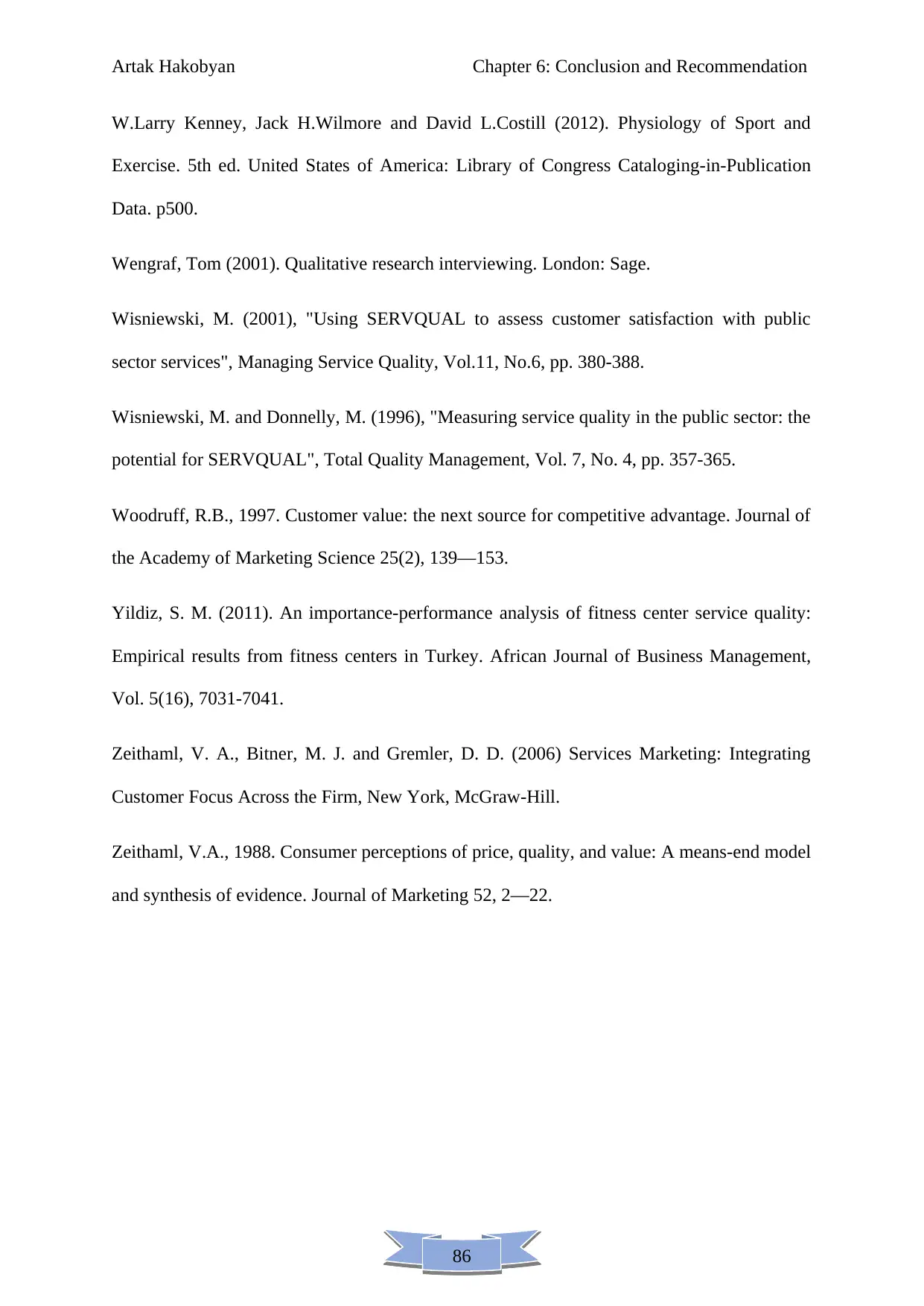
86
Artak Hakobyan Chapter 6: Conclusion and Recommendation
W.Larry Kenney, Jack H.Wilmore and David L.Costill (2012). Physiology of Sport and
Exercise. 5th ed. United States of America: Library of Congress Cataloging-in-Publication
Data. p500.
Wengraf, Tom (2001). Qualitative research interviewing. London: Sage.
Wisniewski, M. (2001), "Using SERVQUAL to assess customer satisfaction with public
sector services", Managing Service Quality, Vol.11, No.6, pp. 380-388.
Wisniewski, M. and Donnelly, M. (1996), "Measuring service quality in the public sector: the
potential for SERVQUAL", Total Quality Management, Vol. 7, No. 4, pp. 357-365.
Woodruff, R.B., 1997. Customer value: the next source for competitive advantage. Journal of
the Academy of Marketing Science 25(2), 139—153.
Yildiz, S. M. (2011). An importance-performance analysis of fitness center service quality:
Empirical results from fitness centers in Turkey. African Journal of Business Management,
Vol. 5(16), 7031-7041.
Zeithaml, V. A., Bitner, M. J. and Gremler, D. D. (2006) Services Marketing: Integrating
Customer Focus Across the Firm, New York, McGraw-Hill.
Zeithaml, V.A., 1988. Consumer perceptions of price, quality, and value: A means-end model
and synthesis of evidence. Journal of Marketing 52, 2—22.
Artak Hakobyan Chapter 6: Conclusion and Recommendation
W.Larry Kenney, Jack H.Wilmore and David L.Costill (2012). Physiology of Sport and
Exercise. 5th ed. United States of America: Library of Congress Cataloging-in-Publication
Data. p500.
Wengraf, Tom (2001). Qualitative research interviewing. London: Sage.
Wisniewski, M. (2001), "Using SERVQUAL to assess customer satisfaction with public
sector services", Managing Service Quality, Vol.11, No.6, pp. 380-388.
Wisniewski, M. and Donnelly, M. (1996), "Measuring service quality in the public sector: the
potential for SERVQUAL", Total Quality Management, Vol. 7, No. 4, pp. 357-365.
Woodruff, R.B., 1997. Customer value: the next source for competitive advantage. Journal of
the Academy of Marketing Science 25(2), 139—153.
Yildiz, S. M. (2011). An importance-performance analysis of fitness center service quality:
Empirical results from fitness centers in Turkey. African Journal of Business Management,
Vol. 5(16), 7031-7041.
Zeithaml, V. A., Bitner, M. J. and Gremler, D. D. (2006) Services Marketing: Integrating
Customer Focus Across the Firm, New York, McGraw-Hill.
Zeithaml, V.A., 1988. Consumer perceptions of price, quality, and value: A means-end model
and synthesis of evidence. Journal of Marketing 52, 2—22.
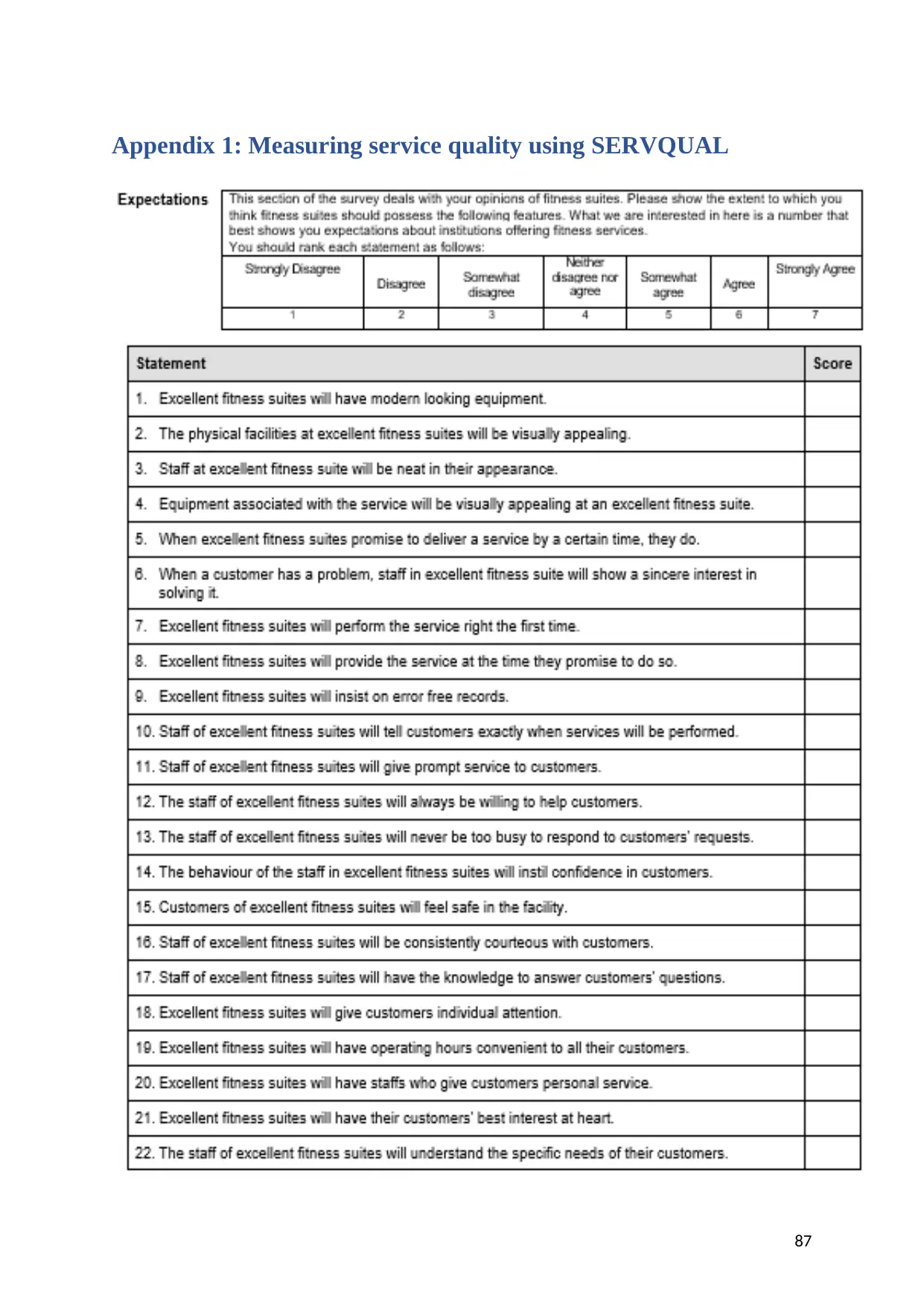
Appendix 1: Measuring service quality using SERVQUAL
87
87
Secure Best Marks with AI Grader
Need help grading? Try our AI Grader for instant feedback on your assignments.
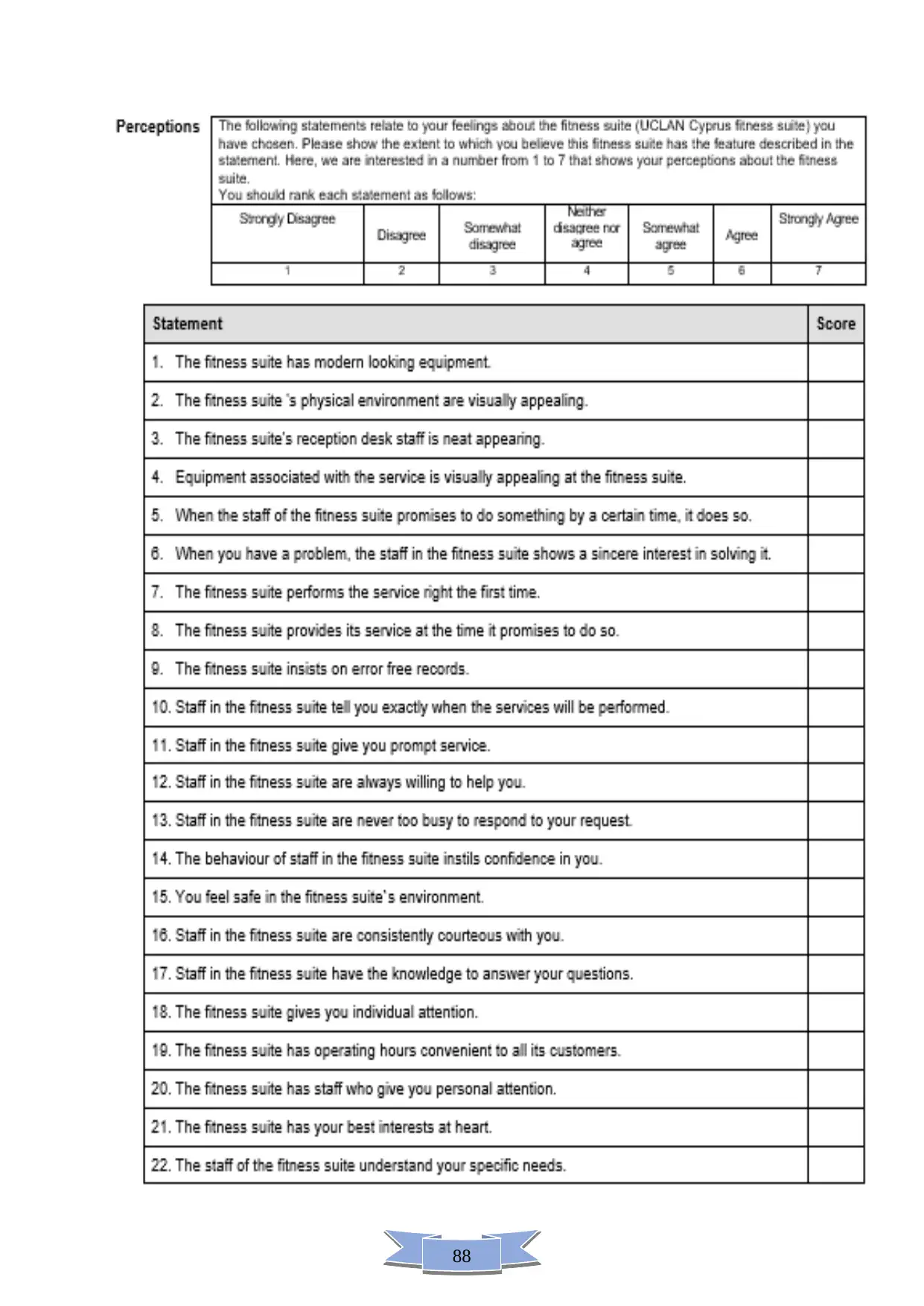
88
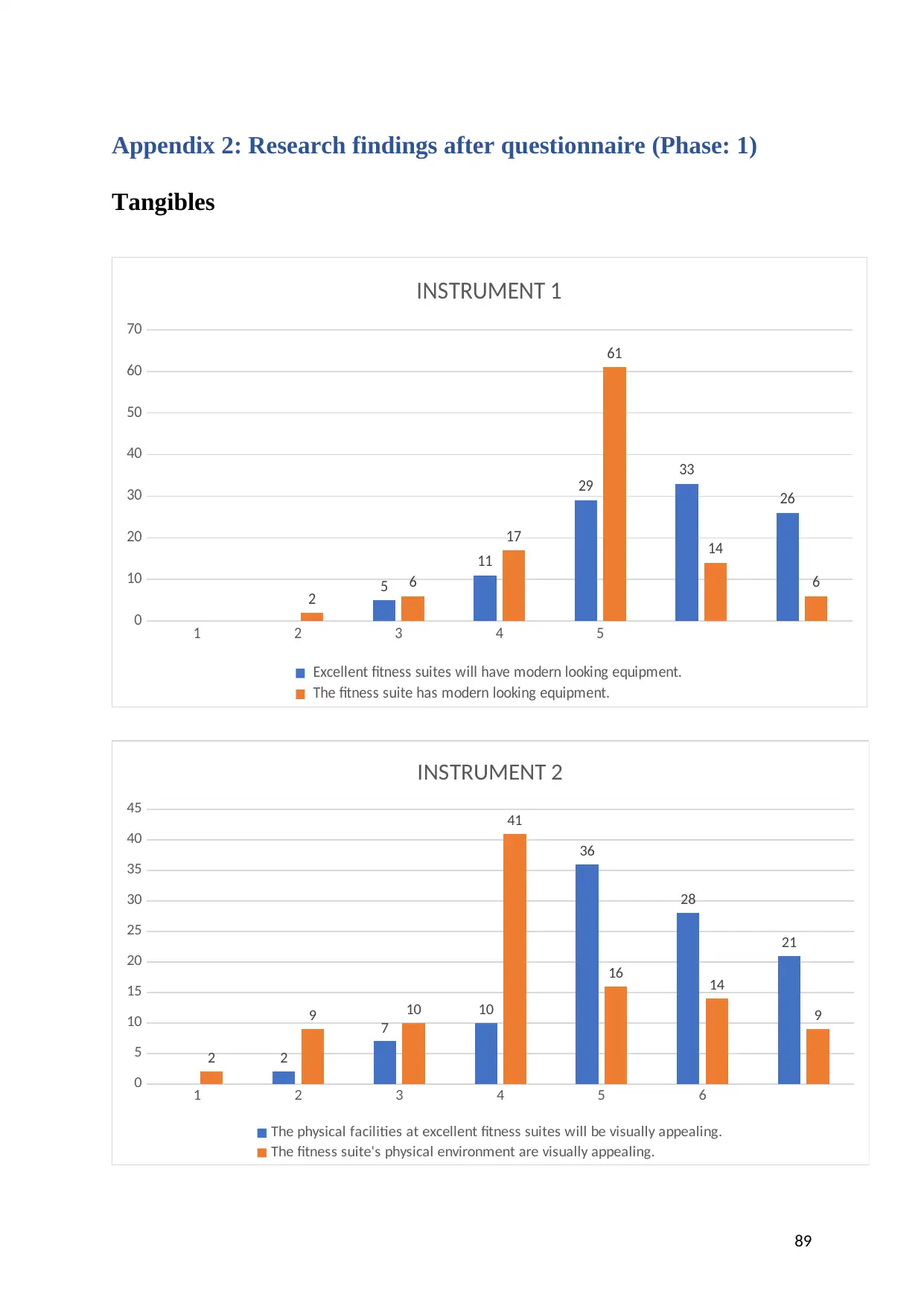
Appendix 2: Research findings after questionnaire (Phase: 1)
Tangibles
1 2 3 4 5
0
10
20
30
40
50
60
70
2
6
17
61
14
65
11
29
33
26
INSTRUMENT 1
Excellent fitness suites will have modern looking equipment.
The fitness suite has modern looking equipment.
1 2 3 4 5 6
0
5
10
15
20
25
30
35
40
45
2
9 10
41
16 14
9
2
7
10
36
28
21
INSTRUMENT 2
The physical facilities at excellent fitness suites will be visually appealing.
The fitness suite's physical environment are visually appealing.
89
Tangibles
1 2 3 4 5
0
10
20
30
40
50
60
70
2
6
17
61
14
65
11
29
33
26
INSTRUMENT 1
Excellent fitness suites will have modern looking equipment.
The fitness suite has modern looking equipment.
1 2 3 4 5 6
0
5
10
15
20
25
30
35
40
45
2
9 10
41
16 14
9
2
7
10
36
28
21
INSTRUMENT 2
The physical facilities at excellent fitness suites will be visually appealing.
The fitness suite's physical environment are visually appealing.
89
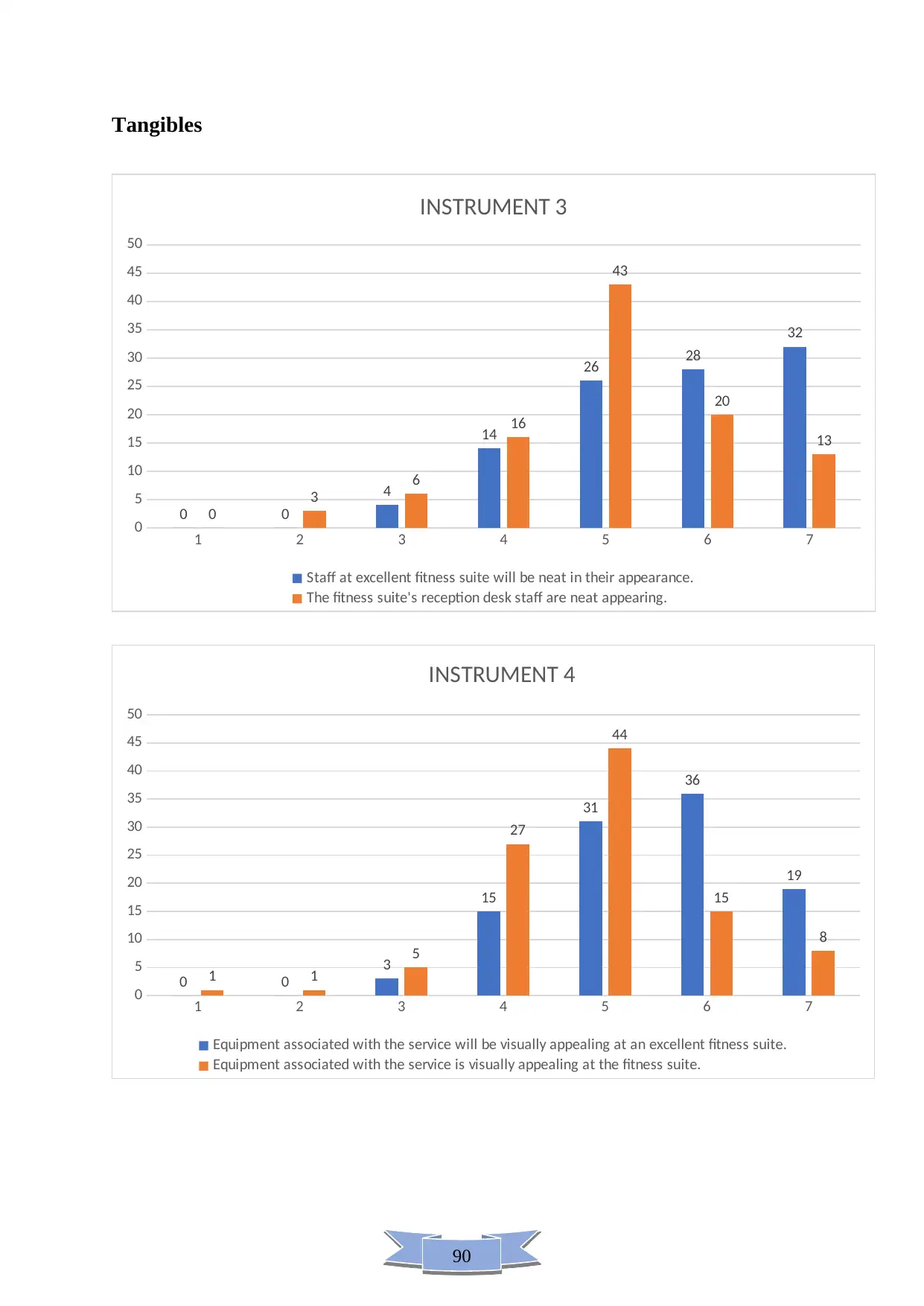
90
Tangibles
1 2 3 4 5 6 7
0
5
10
15
20
25
30
35
40
45
50
0 0
4
14
26 28
32
0
3
6
16
43
20
13
INSTRUMENT 3
Staff at excellent fitness suite will be neat in their appearance.
The fitness suite's reception desk staff are neat appearing.
1 2 3 4 5 6 7
0
5
10
15
20
25
30
35
40
45
50
0 0
3
15
31
36
19
1 1
5
27
44
15
8
INSTRUMENT 4
Equipment associated with the service will be visually appealing at an excellent fitness suite.
Equipment associated with the service is visually appealing at the fitness suite.
Tangibles
1 2 3 4 5 6 7
0
5
10
15
20
25
30
35
40
45
50
0 0
4
14
26 28
32
0
3
6
16
43
20
13
INSTRUMENT 3
Staff at excellent fitness suite will be neat in their appearance.
The fitness suite's reception desk staff are neat appearing.
1 2 3 4 5 6 7
0
5
10
15
20
25
30
35
40
45
50
0 0
3
15
31
36
19
1 1
5
27
44
15
8
INSTRUMENT 4
Equipment associated with the service will be visually appealing at an excellent fitness suite.
Equipment associated with the service is visually appealing at the fitness suite.
Paraphrase This Document
Need a fresh take? Get an instant paraphrase of this document with our AI Paraphraser
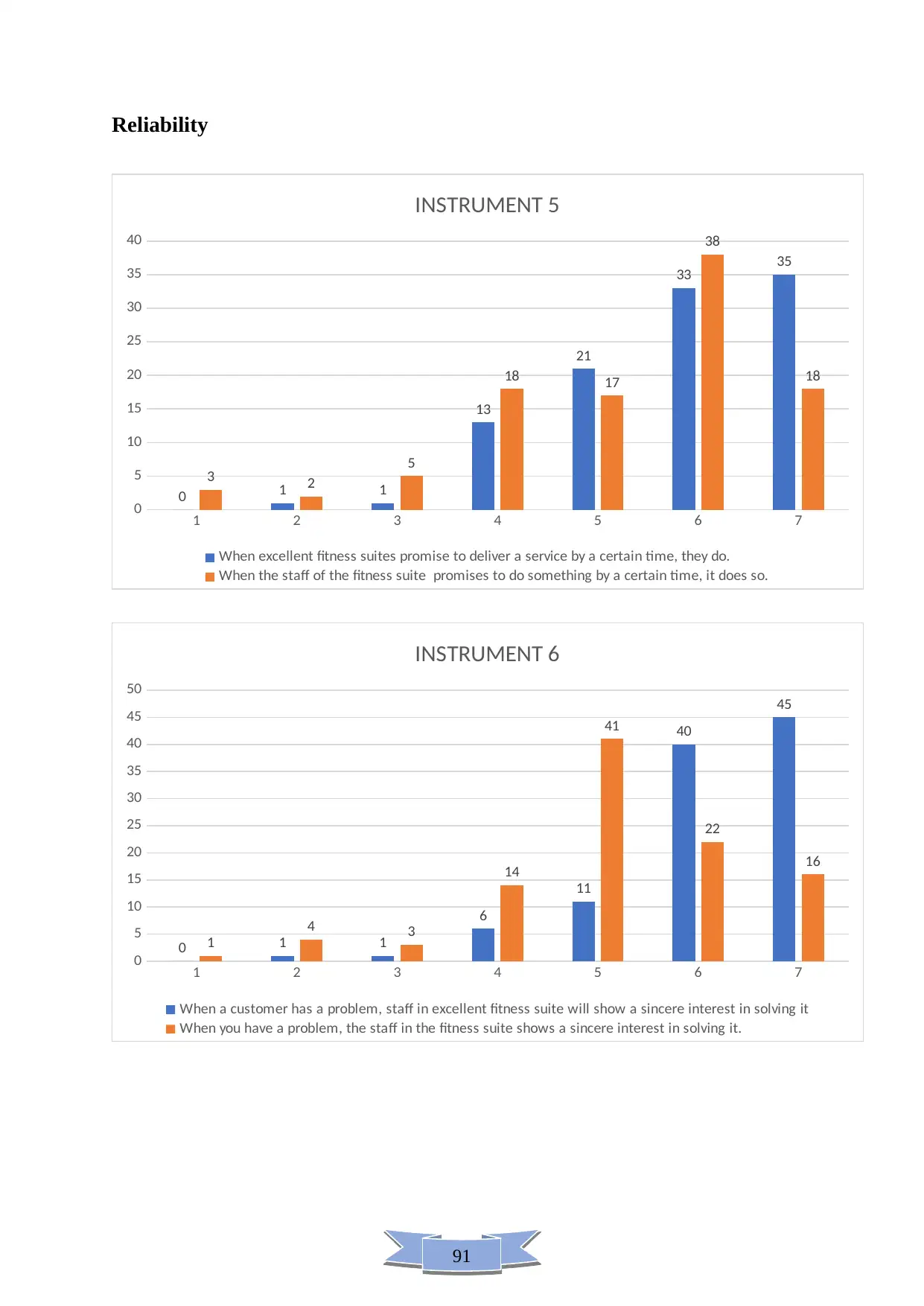
91
Reliability
1 2 3 4 5 6 7
0
5
10
15
20
25
30
35
40
0 1 1
13
21
33 35
3 2
5
18 17
38
18
INSTRUMENT 5
When excellent fitness suites promise to deliver a service by a certain time, they do.
When the staff of the fitness suite promises to do something by a certain time, it does so.
1 2 3 4 5 6 7
0
5
10
15
20
25
30
35
40
45
50
0 1 1
6
11
40
45
1
4 3
14
41
22
16
INSTRUMENT 6
When a customer has a problem, staff in excellent fitness suite will show a sincere interest in solving it
When you have a problem, the staff in the fitness suite shows a sincere interest in solving it.
Reliability
1 2 3 4 5 6 7
0
5
10
15
20
25
30
35
40
0 1 1
13
21
33 35
3 2
5
18 17
38
18
INSTRUMENT 5
When excellent fitness suites promise to deliver a service by a certain time, they do.
When the staff of the fitness suite promises to do something by a certain time, it does so.
1 2 3 4 5 6 7
0
5
10
15
20
25
30
35
40
45
50
0 1 1
6
11
40
45
1
4 3
14
41
22
16
INSTRUMENT 6
When a customer has a problem, staff in excellent fitness suite will show a sincere interest in solving it
When you have a problem, the staff in the fitness suite shows a sincere interest in solving it.
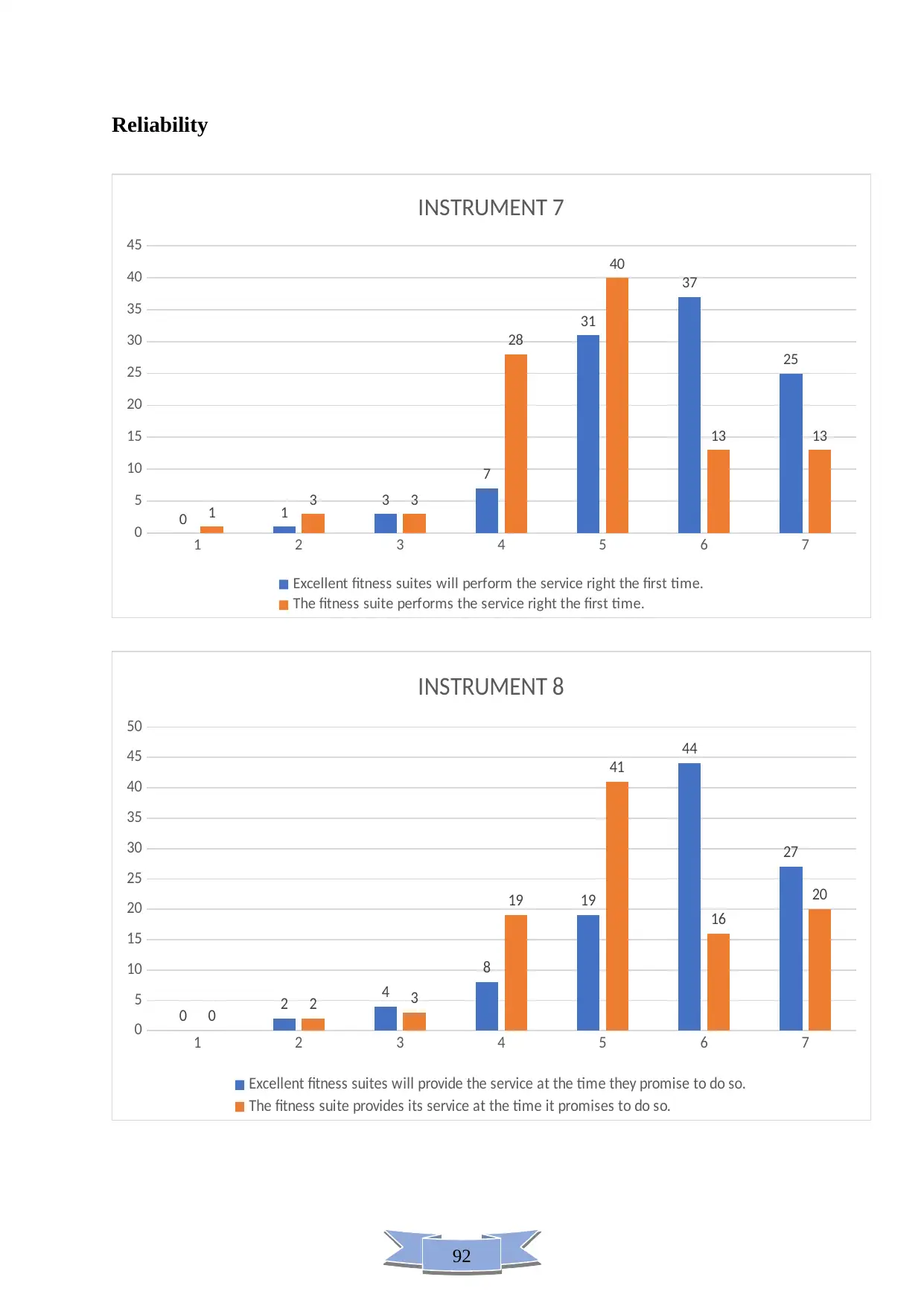
92
Reliability
1 2 3 4 5 6 7
0
5
10
15
20
25
30
35
40
45
0 1 3
7
31
37
25
1 3 3
28
40
13 13
INSTRUMENT 7
Excellent fitness suites will perform the service right the first time.
The fitness suite performs the service right the first time.
1 2 3 4 5 6 7
0
5
10
15
20
25
30
35
40
45
50
0 2 4
8
19
44
27
0 2 3
19
41
16
20
INSTRUMENT 8
Excellent fitness suites will provide the service at the time they promise to do so.
The fitness suite provides its service at the time it promises to do so.
Reliability
1 2 3 4 5 6 7
0
5
10
15
20
25
30
35
40
45
0 1 3
7
31
37
25
1 3 3
28
40
13 13
INSTRUMENT 7
Excellent fitness suites will perform the service right the first time.
The fitness suite performs the service right the first time.
1 2 3 4 5 6 7
0
5
10
15
20
25
30
35
40
45
50
0 2 4
8
19
44
27
0 2 3
19
41
16
20
INSTRUMENT 8
Excellent fitness suites will provide the service at the time they promise to do so.
The fitness suite provides its service at the time it promises to do so.
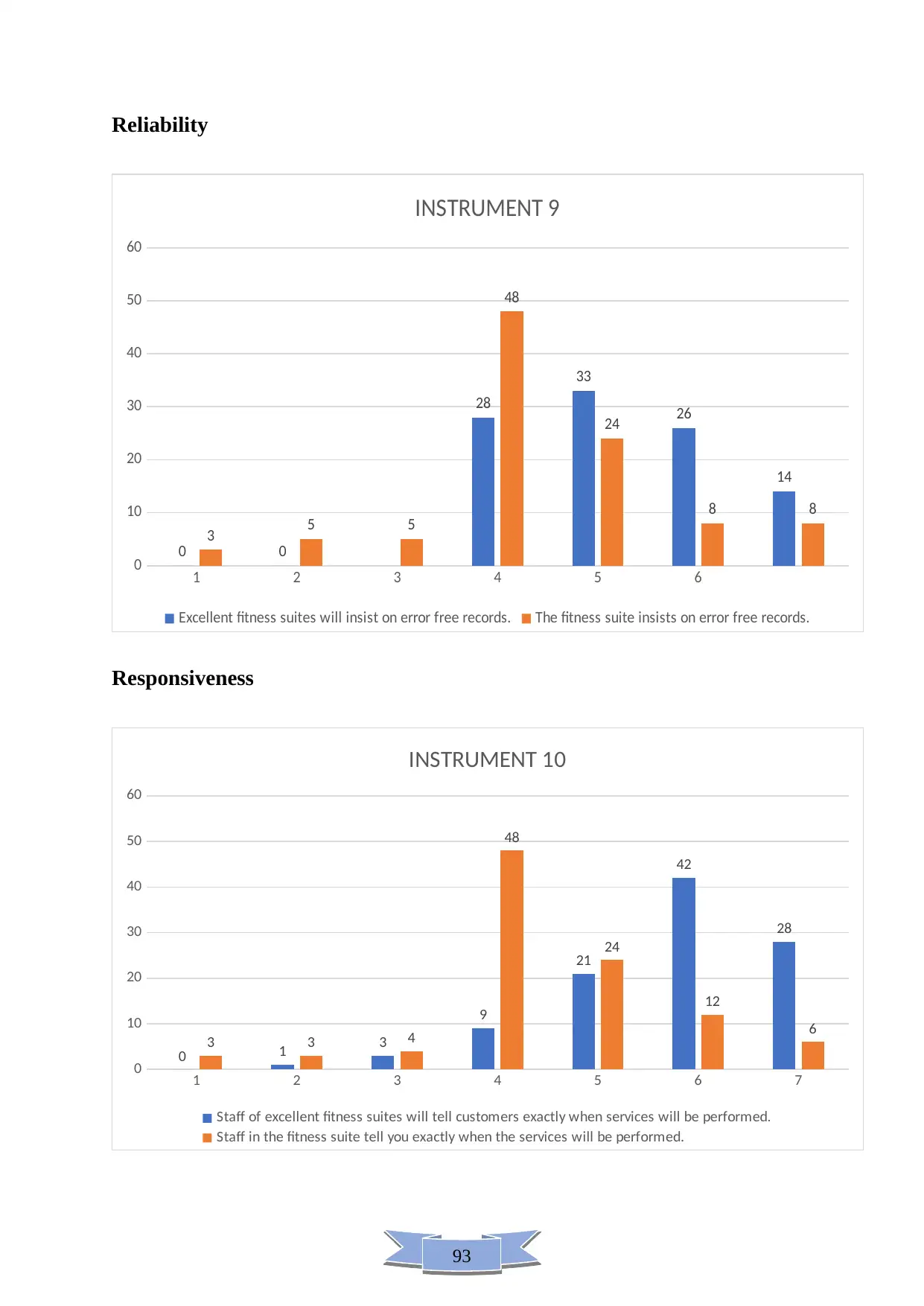
93
Reliability
1 2 3 4 5 6
0
10
20
30
40
50
60
0 0
28
33
26
14
3 5 5
48
24
8 8
INSTRUMENT 9
Excellent fitness suites will insist on error free records. The fitness suite insists on error free records.
Responsiveness
1 2 3 4 5 6 7
0
10
20
30
40
50
60
0 1 3
9
21
42
28
3 3 4
48
24
12
6
INSTRUMENT 10
Staff of excellent fitness suites will tell customers exactly when services will be performed.
Staff in the fitness suite tell you exactly when the services will be performed.
Reliability
1 2 3 4 5 6
0
10
20
30
40
50
60
0 0
28
33
26
14
3 5 5
48
24
8 8
INSTRUMENT 9
Excellent fitness suites will insist on error free records. The fitness suite insists on error free records.
Responsiveness
1 2 3 4 5 6 7
0
10
20
30
40
50
60
0 1 3
9
21
42
28
3 3 4
48
24
12
6
INSTRUMENT 10
Staff of excellent fitness suites will tell customers exactly when services will be performed.
Staff in the fitness suite tell you exactly when the services will be performed.
Secure Best Marks with AI Grader
Need help grading? Try our AI Grader for instant feedback on your assignments.
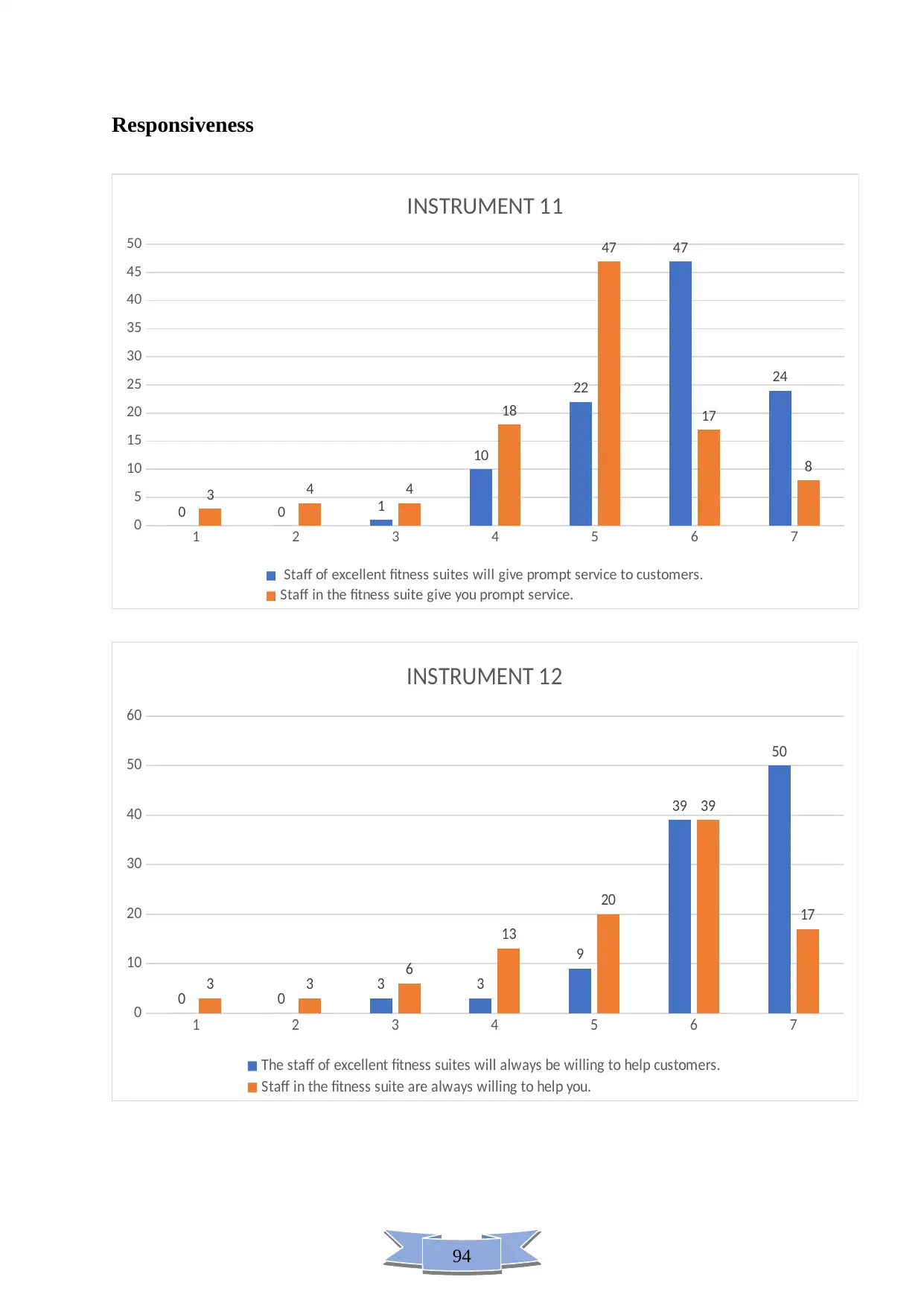
94
Responsiveness
1 2 3 4 5 6 7
0
5
10
15
20
25
30
35
40
45
50
0 0 1
10
22
47
24
3 4 4
18
47
17
8
INSTRUMENT 11
Staff of excellent fitness suites will give prompt service to customers.
Staff in the fitness suite give you prompt service.
1 2 3 4 5 6 7
0
10
20
30
40
50
60
0 0 3 3
9
39
50
3 3 6
13
20
39
17
INSTRUMENT 12
The staff of excellent fitness suites will always be willing to help customers.
Staff in the fitness suite are always willing to help you.
Responsiveness
1 2 3 4 5 6 7
0
5
10
15
20
25
30
35
40
45
50
0 0 1
10
22
47
24
3 4 4
18
47
17
8
INSTRUMENT 11
Staff of excellent fitness suites will give prompt service to customers.
Staff in the fitness suite give you prompt service.
1 2 3 4 5 6 7
0
10
20
30
40
50
60
0 0 3 3
9
39
50
3 3 6
13
20
39
17
INSTRUMENT 12
The staff of excellent fitness suites will always be willing to help customers.
Staff in the fitness suite are always willing to help you.
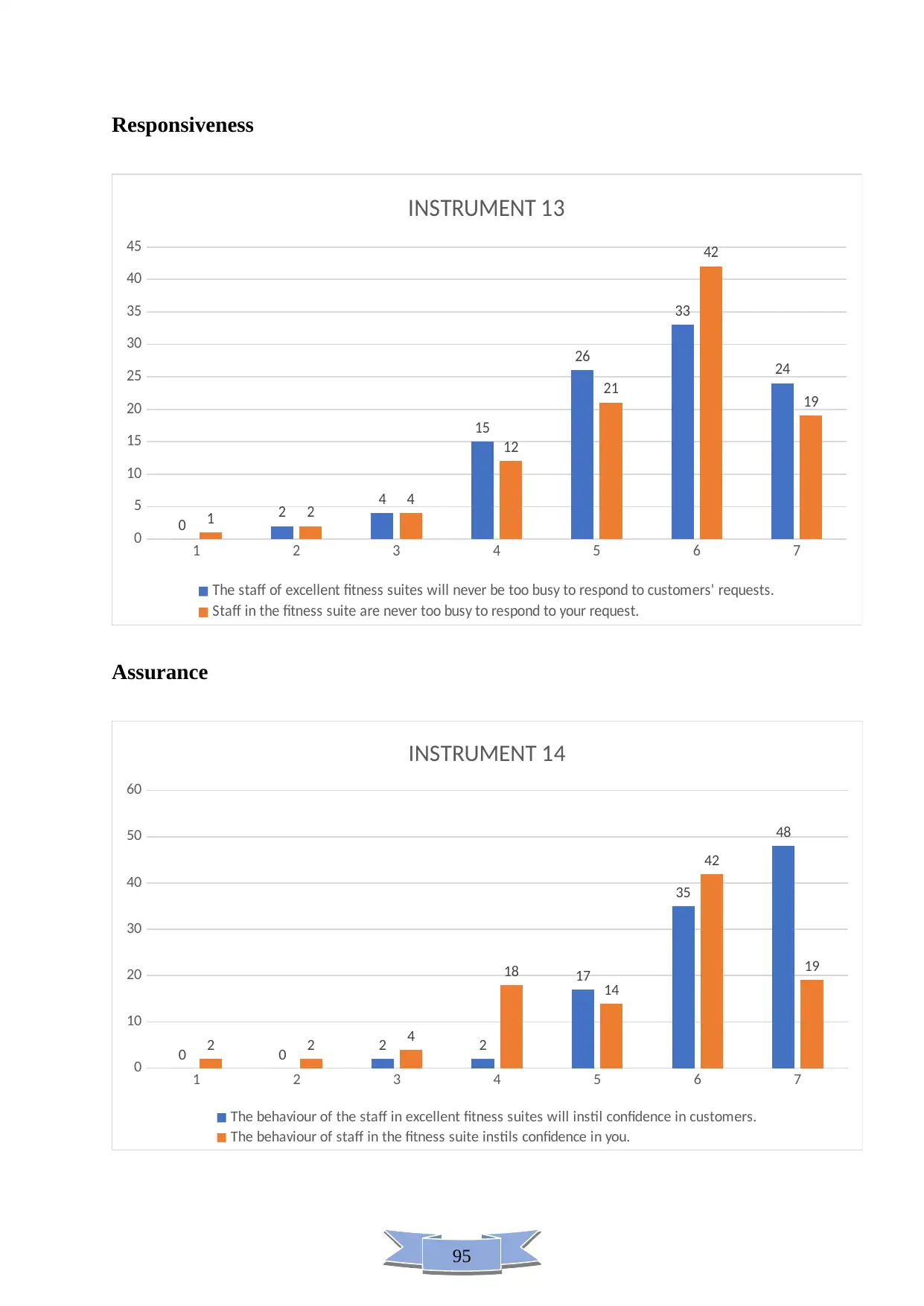
95
Responsiveness
1 2 3 4 5 6 7
0
5
10
15
20
25
30
35
40
45
0 2 4
15
26
33
24
1 2 4
12
21
42
19
INSTRUMENT 13
The staff of excellent fitness suites will never be too busy to respond to customers' requests.
Staff in the fitness suite are never too busy to respond to your request.
Assurance
1 2 3 4 5 6 7
0
10
20
30
40
50
60
0 0 2 2
17
35
48
2 2 4
18
14
42
19
INSTRUMENT 14
The behaviour of the staff in excellent fitness suites will instil confidence in customers.
The behaviour of staff in the fitness suite instils confidence in you.
Responsiveness
1 2 3 4 5 6 7
0
5
10
15
20
25
30
35
40
45
0 2 4
15
26
33
24
1 2 4
12
21
42
19
INSTRUMENT 13
The staff of excellent fitness suites will never be too busy to respond to customers' requests.
Staff in the fitness suite are never too busy to respond to your request.
Assurance
1 2 3 4 5 6 7
0
10
20
30
40
50
60
0 0 2 2
17
35
48
2 2 4
18
14
42
19
INSTRUMENT 14
The behaviour of the staff in excellent fitness suites will instil confidence in customers.
The behaviour of staff in the fitness suite instils confidence in you.
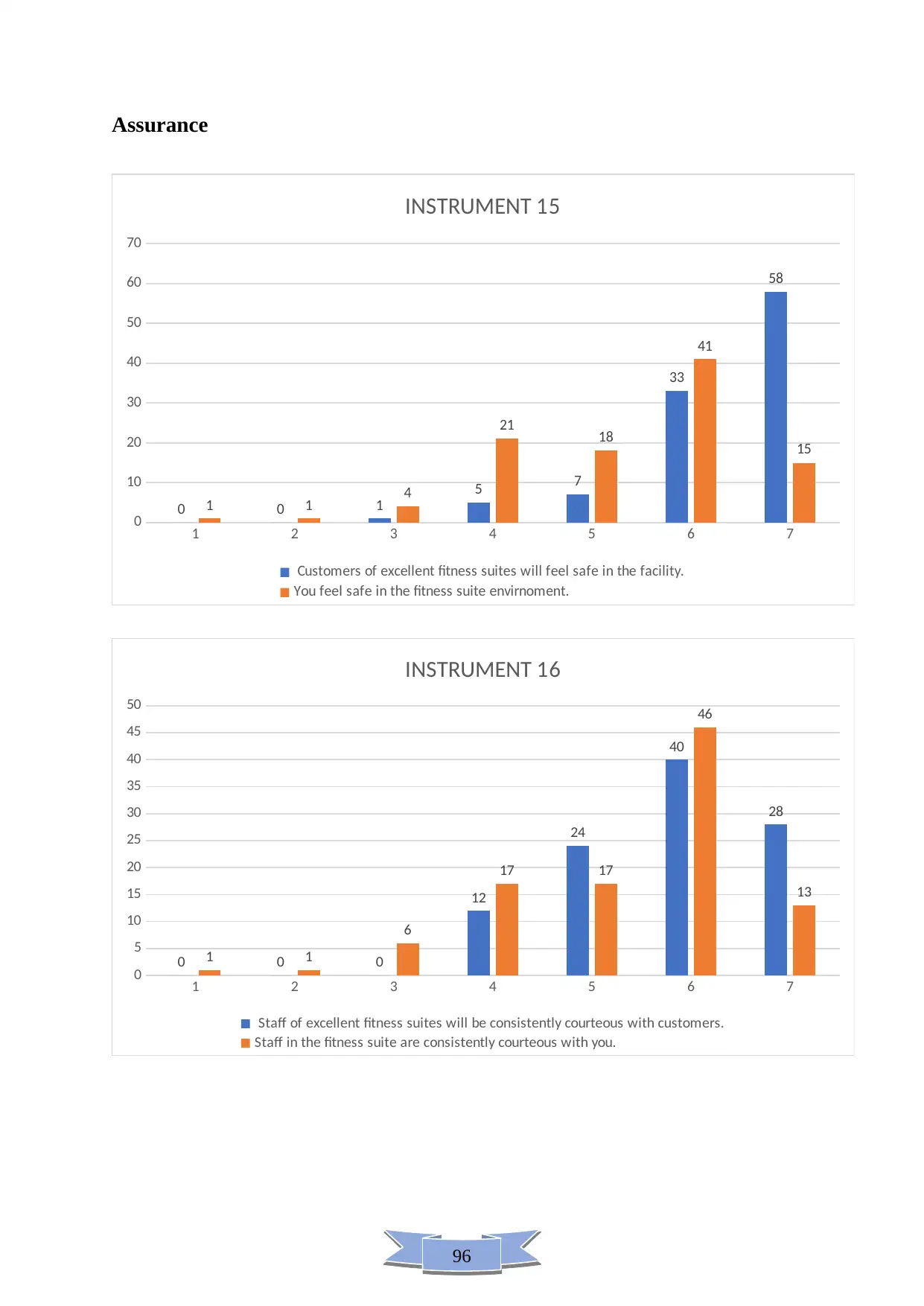
96
Assurance
1 2 3 4 5 6 7
0
10
20
30
40
50
60
70
0 0 1
5 7
33
58
1 1 4
21 18
41
15
INSTRUMENT 15
Customers of excellent fitness suites will feel safe in the facility.
You feel safe in the fitness suite envirnoment.
1 2 3 4 5 6 7
0
5
10
15
20
25
30
35
40
45
50
0 0 0
12
24
40
28
1 1
6
17 17
46
13
INSTRUMENT 16
Staff of excellent fitness suites will be consistently courteous with customers.
Staff in the fitness suite are consistently courteous with you.
Assurance
1 2 3 4 5 6 7
0
10
20
30
40
50
60
70
0 0 1
5 7
33
58
1 1 4
21 18
41
15
INSTRUMENT 15
Customers of excellent fitness suites will feel safe in the facility.
You feel safe in the fitness suite envirnoment.
1 2 3 4 5 6 7
0
5
10
15
20
25
30
35
40
45
50
0 0 0
12
24
40
28
1 1
6
17 17
46
13
INSTRUMENT 16
Staff of excellent fitness suites will be consistently courteous with customers.
Staff in the fitness suite are consistently courteous with you.
Paraphrase This Document
Need a fresh take? Get an instant paraphrase of this document with our AI Paraphraser
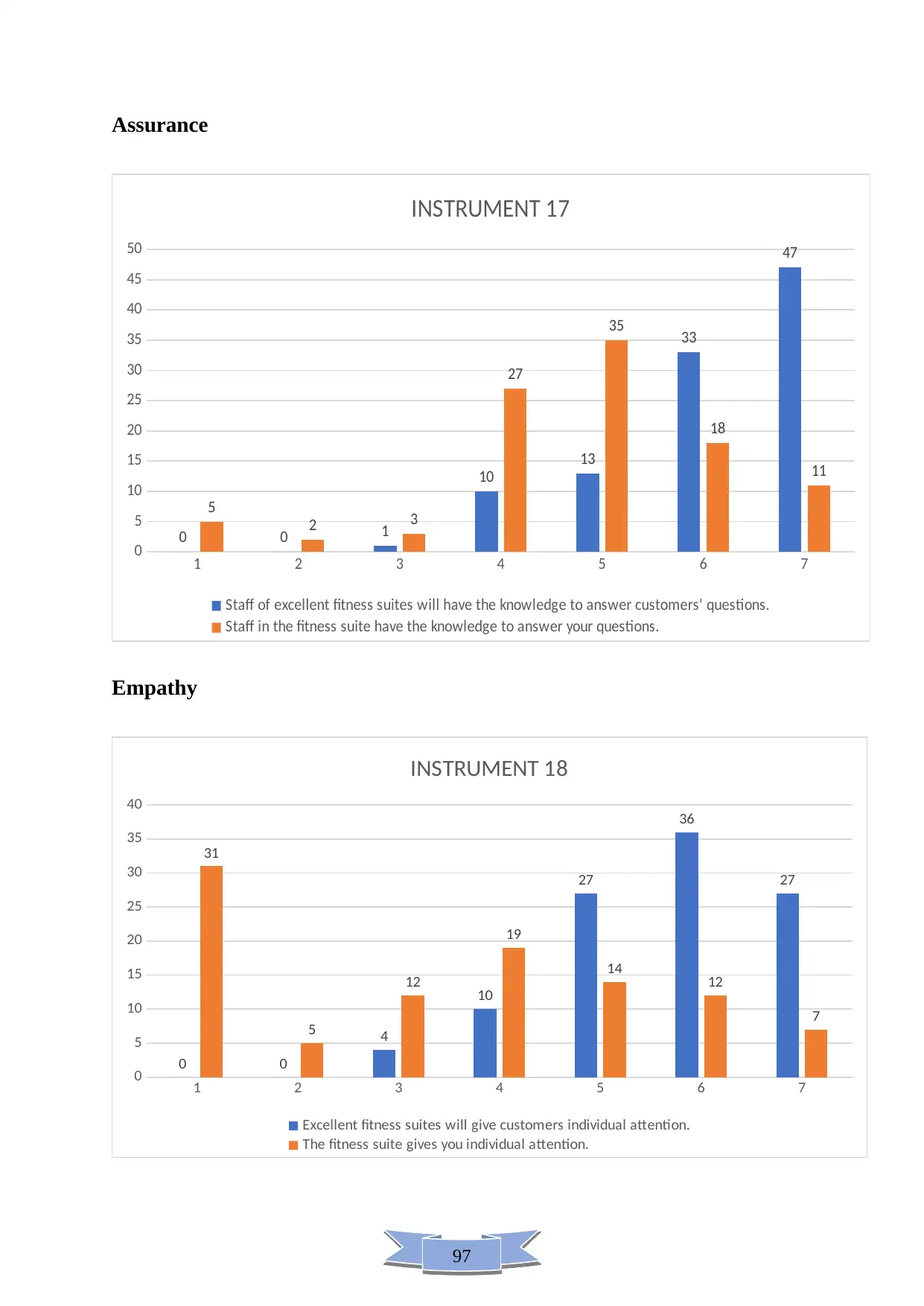
97
Assurance
1 2 3 4 5 6 7
0
5
10
15
20
25
30
35
40
45
50
0 0 1
10
13
33
47
5
2 3
27
35
18
11
INSTRUMENT 17
Staff of excellent fitness suites will have the knowledge to answer customers' questions.
Staff in the fitness suite have the knowledge to answer your questions.
Empathy
1 2 3 4 5 6 7
0
5
10
15
20
25
30
35
40
0 0
4
10
27
36
27
31
5
12
19
14 12
7
INSTRUMENT 18
Excellent fitness suites will give customers individual attention.
The fitness suite gives you individual attention.
Assurance
1 2 3 4 5 6 7
0
5
10
15
20
25
30
35
40
45
50
0 0 1
10
13
33
47
5
2 3
27
35
18
11
INSTRUMENT 17
Staff of excellent fitness suites will have the knowledge to answer customers' questions.
Staff in the fitness suite have the knowledge to answer your questions.
Empathy
1 2 3 4 5 6 7
0
5
10
15
20
25
30
35
40
0 0
4
10
27
36
27
31
5
12
19
14 12
7
INSTRUMENT 18
Excellent fitness suites will give customers individual attention.
The fitness suite gives you individual attention.
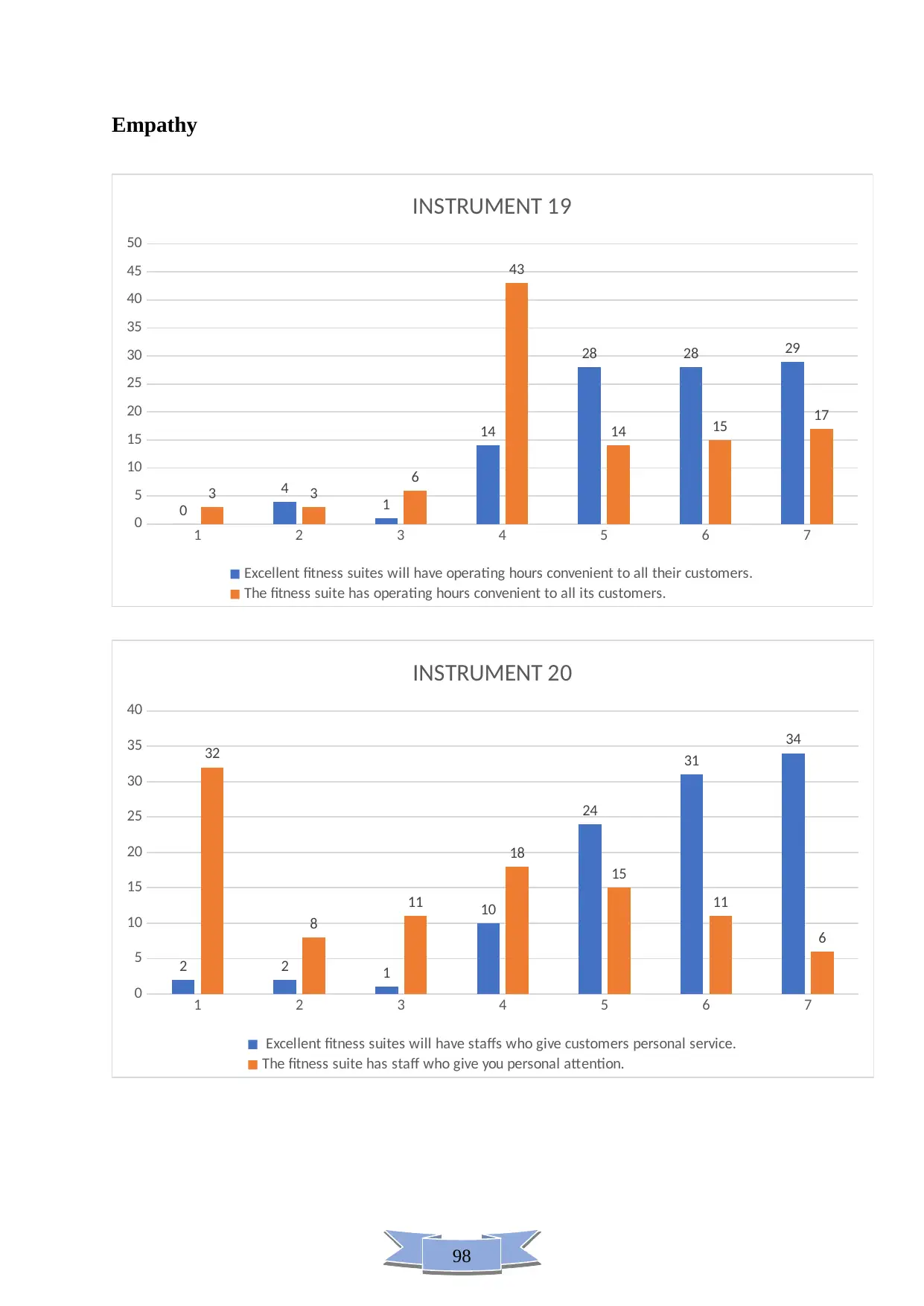
98
Empathy
1 2 3 4 5 6 7
0
5
10
15
20
25
30
35
40
45
50
0
4
1
14
28 28 29
3 3
6
43
14 15 17
INSTRUMENT 19
Excellent fitness suites will have operating hours convenient to all their customers.
The fitness suite has operating hours convenient to all its customers.
1 2 3 4 5 6 7
0
5
10
15
20
25
30
35
40
2 2 1
10
24
31
34
32
8
11
18
15
11
6
INSTRUMENT 20
Excellent fitness suites will have staffs who give customers personal service.
The fitness suite has staff who give you personal attention.
Empathy
1 2 3 4 5 6 7
0
5
10
15
20
25
30
35
40
45
50
0
4
1
14
28 28 29
3 3
6
43
14 15 17
INSTRUMENT 19
Excellent fitness suites will have operating hours convenient to all their customers.
The fitness suite has operating hours convenient to all its customers.
1 2 3 4 5 6 7
0
5
10
15
20
25
30
35
40
2 2 1
10
24
31
34
32
8
11
18
15
11
6
INSTRUMENT 20
Excellent fitness suites will have staffs who give customers personal service.
The fitness suite has staff who give you personal attention.
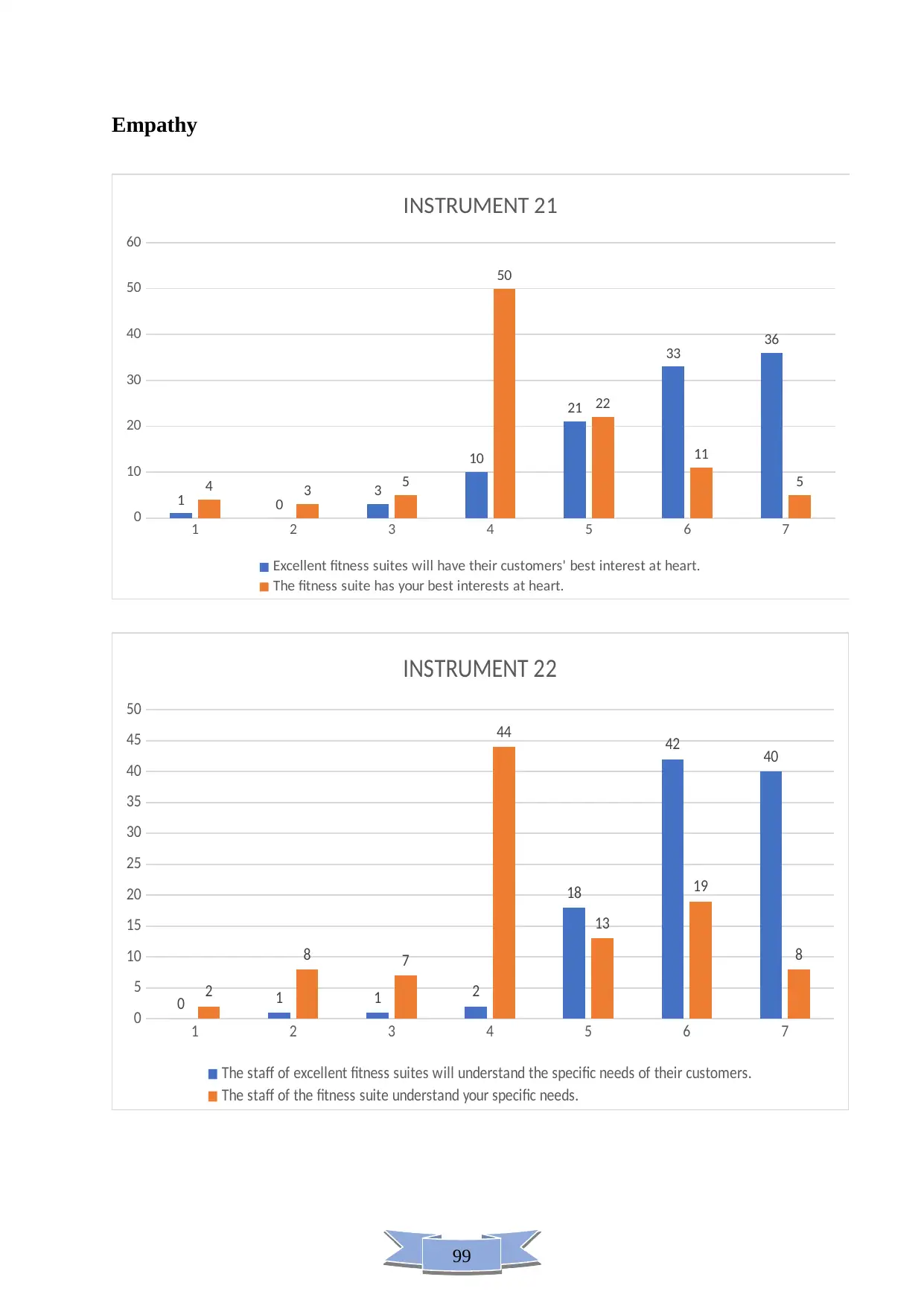
99
Empathy
1 2 3 4 5 6 7
0
10
20
30
40
50
60
1 0 3
10
21
33 36
4 3 5
50
22
11
5
INSTRUMENT 21
Excellent fitness suites will have their customers' best interest at heart.
The fitness suite has your best interests at heart.
1 2 3 4 5 6 7
0
5
10
15
20
25
30
35
40
45
50
0 1 1 2
18
42 40
2
8 7
44
13
19
8
INSTRUMENT 22
The staff of excellent fitness suites will understand the specific needs of their customers.
The staff of the fitness suite understand your specific needs.
Empathy
1 2 3 4 5 6 7
0
10
20
30
40
50
60
1 0 3
10
21
33 36
4 3 5
50
22
11
5
INSTRUMENT 21
Excellent fitness suites will have their customers' best interest at heart.
The fitness suite has your best interests at heart.
1 2 3 4 5 6 7
0
5
10
15
20
25
30
35
40
45
50
0 1 1 2
18
42 40
2
8 7
44
13
19
8
INSTRUMENT 22
The staff of excellent fitness suites will understand the specific needs of their customers.
The staff of the fitness suite understand your specific needs.
Secure Best Marks with AI Grader
Need help grading? Try our AI Grader for instant feedback on your assignments.
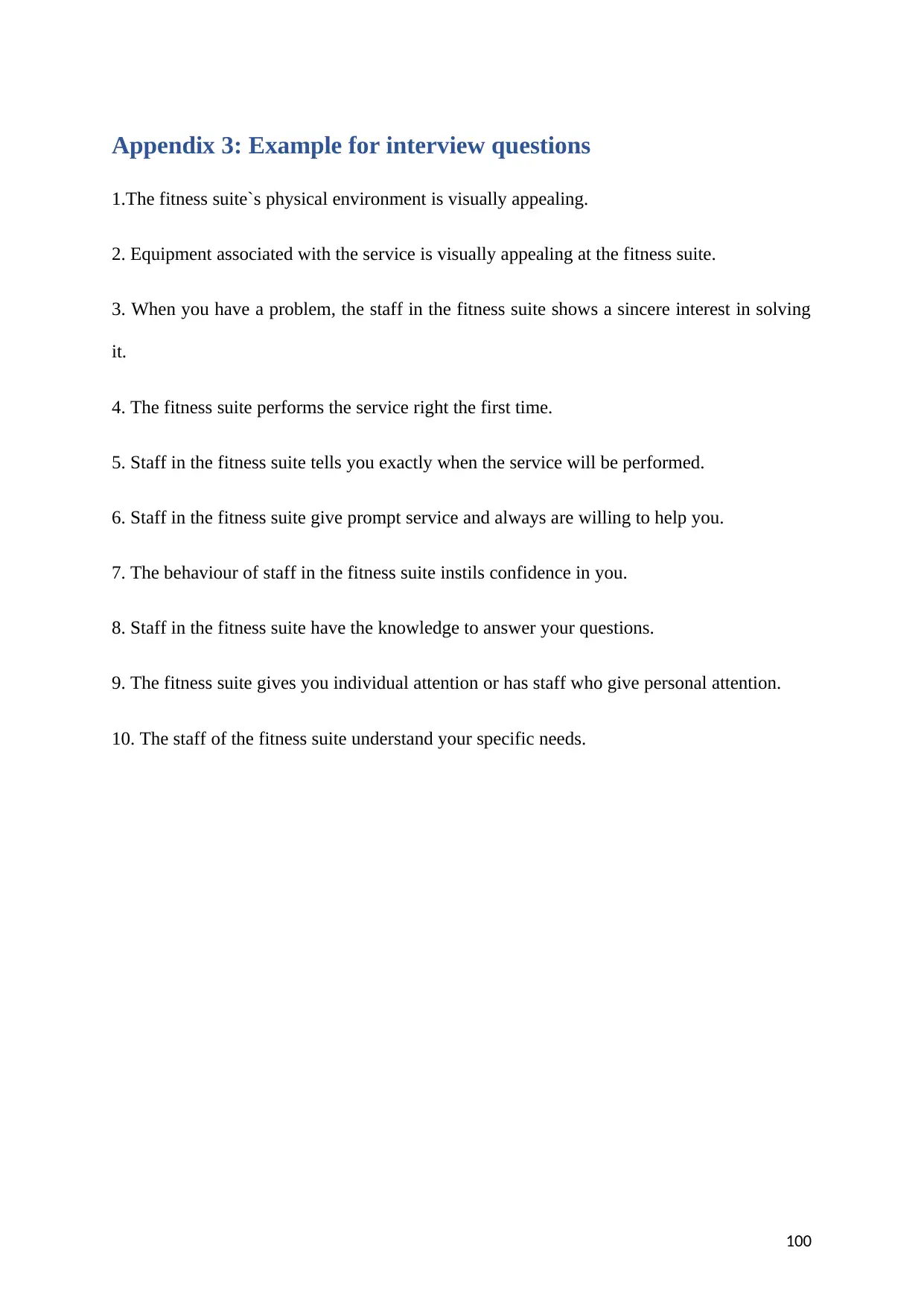
Appendix 3: Example for interview questions
1.The fitness suite`s physical environment is visually appealing.
2. Equipment associated with the service is visually appealing at the fitness suite.
3. When you have a problem, the staff in the fitness suite shows a sincere interest in solving
it.
4. The fitness suite performs the service right the first time.
5. Staff in the fitness suite tells you exactly when the service will be performed.
6. Staff in the fitness suite give prompt service and always are willing to help you.
7. The behaviour of staff in the fitness suite instils confidence in you.
8. Staff in the fitness suite have the knowledge to answer your questions.
9. The fitness suite gives you individual attention or has staff who give personal attention.
10. The staff of the fitness suite understand your specific needs.
100
1.The fitness suite`s physical environment is visually appealing.
2. Equipment associated with the service is visually appealing at the fitness suite.
3. When you have a problem, the staff in the fitness suite shows a sincere interest in solving
it.
4. The fitness suite performs the service right the first time.
5. Staff in the fitness suite tells you exactly when the service will be performed.
6. Staff in the fitness suite give prompt service and always are willing to help you.
7. The behaviour of staff in the fitness suite instils confidence in you.
8. Staff in the fitness suite have the knowledge to answer your questions.
9. The fitness suite gives you individual attention or has staff who give personal attention.
10. The staff of the fitness suite understand your specific needs.
100
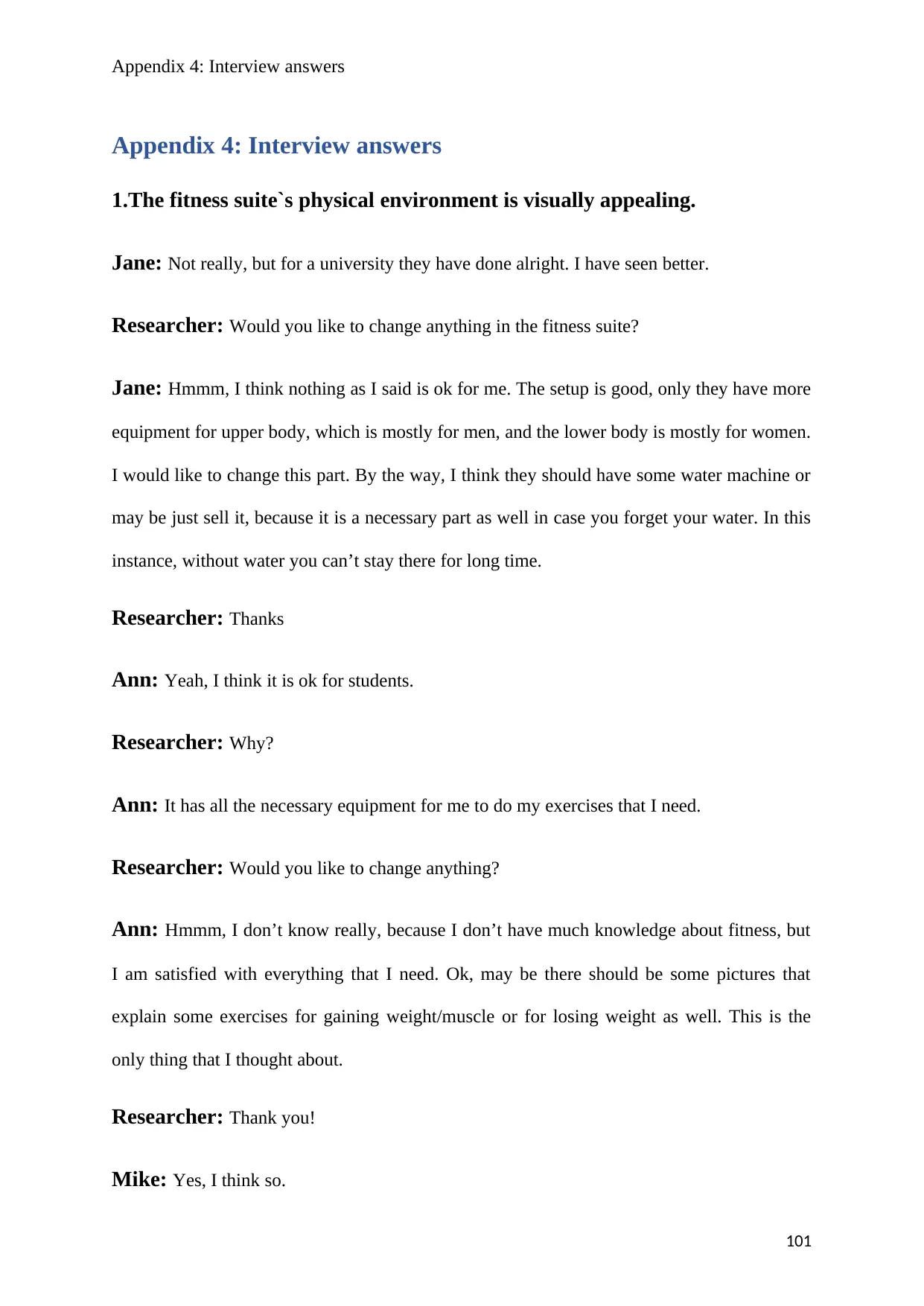
Appendix 4: Interview answers
Appendix 4: Interview answers
1.The fitness suite`s physical environment is visually appealing.
Jane: Not really, but for a university they have done alright. I have seen better.
Researcher: Would you like to change anything in the fitness suite?
Jane: Hmmm, I think nothing as I said is ok for me. The setup is good, only they have more
equipment for upper body, which is mostly for men, and the lower body is mostly for women.
I would like to change this part. By the way, I think they should have some water machine or
may be just sell it, because it is a necessary part as well in case you forget your water. In this
instance, without water you can’t stay there for long time.
Researcher: Thanks
Ann: Yeah, I think it is ok for students.
Researcher: Why?
Ann: It has all the necessary equipment for me to do my exercises that I need.
Researcher: Would you like to change anything?
Ann: Hmmm, I don’t know really, because I don’t have much knowledge about fitness, but
I am satisfied with everything that I need. Ok, may be there should be some pictures that
explain some exercises for gaining weight/muscle or for losing weight as well. This is the
only thing that I thought about.
Researcher: Thank you!
Mike: Yes, I think so.
101
Appendix 4: Interview answers
1.The fitness suite`s physical environment is visually appealing.
Jane: Not really, but for a university they have done alright. I have seen better.
Researcher: Would you like to change anything in the fitness suite?
Jane: Hmmm, I think nothing as I said is ok for me. The setup is good, only they have more
equipment for upper body, which is mostly for men, and the lower body is mostly for women.
I would like to change this part. By the way, I think they should have some water machine or
may be just sell it, because it is a necessary part as well in case you forget your water. In this
instance, without water you can’t stay there for long time.
Researcher: Thanks
Ann: Yeah, I think it is ok for students.
Researcher: Why?
Ann: It has all the necessary equipment for me to do my exercises that I need.
Researcher: Would you like to change anything?
Ann: Hmmm, I don’t know really, because I don’t have much knowledge about fitness, but
I am satisfied with everything that I need. Ok, may be there should be some pictures that
explain some exercises for gaining weight/muscle or for losing weight as well. This is the
only thing that I thought about.
Researcher: Thank you!
Mike: Yes, I think so.
101
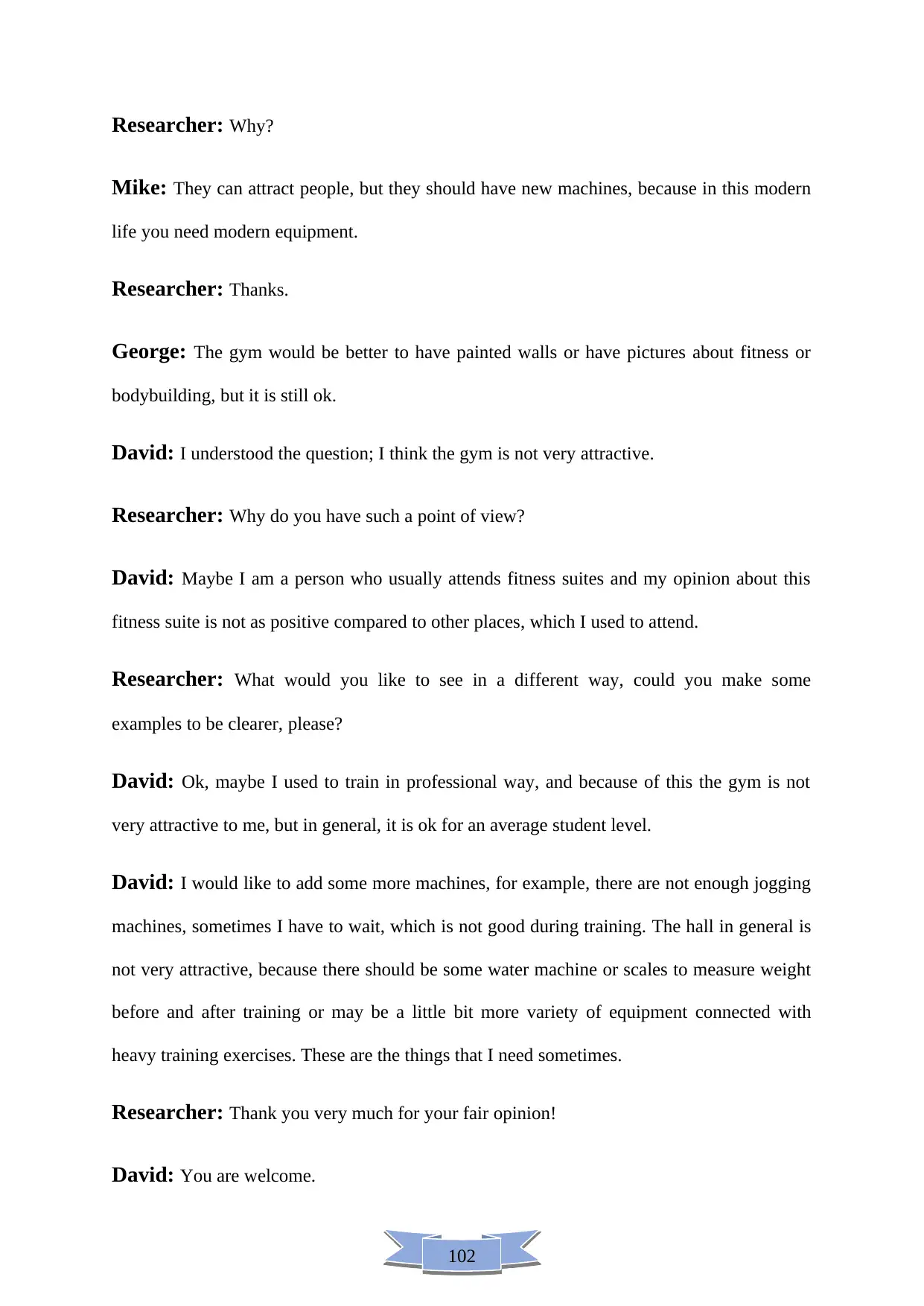
102
Researcher: Why?
Mike: They can attract people, but they should have new machines, because in this modern
life you need modern equipment.
Researcher: Thanks.
George: The gym would be better to have painted walls or have pictures about fitness or
bodybuilding, but it is still ok.
David: I understood the question; I think the gym is not very attractive.
Researcher: Why do you have such a point of view?
David: Maybe I am a person who usually attends fitness suites and my opinion about this
fitness suite is not as positive compared to other places, which I used to attend.
Researcher: What would you like to see in a different way, could you make some
examples to be clearer, please?
David: Ok, maybe I used to train in professional way, and because of this the gym is not
very attractive to me, but in general, it is ok for an average student level.
David: I would like to add some more machines, for example, there are not enough jogging
machines, sometimes I have to wait, which is not good during training. The hall in general is
not very attractive, because there should be some water machine or scales to measure weight
before and after training or may be a little bit more variety of equipment connected with
heavy training exercises. These are the things that I need sometimes.
Researcher: Thank you very much for your fair opinion!
David: You are welcome.
Researcher: Why?
Mike: They can attract people, but they should have new machines, because in this modern
life you need modern equipment.
Researcher: Thanks.
George: The gym would be better to have painted walls or have pictures about fitness or
bodybuilding, but it is still ok.
David: I understood the question; I think the gym is not very attractive.
Researcher: Why do you have such a point of view?
David: Maybe I am a person who usually attends fitness suites and my opinion about this
fitness suite is not as positive compared to other places, which I used to attend.
Researcher: What would you like to see in a different way, could you make some
examples to be clearer, please?
David: Ok, maybe I used to train in professional way, and because of this the gym is not
very attractive to me, but in general, it is ok for an average student level.
David: I would like to add some more machines, for example, there are not enough jogging
machines, sometimes I have to wait, which is not good during training. The hall in general is
not very attractive, because there should be some water machine or scales to measure weight
before and after training or may be a little bit more variety of equipment connected with
heavy training exercises. These are the things that I need sometimes.
Researcher: Thank you very much for your fair opinion!
David: You are welcome.
Paraphrase This Document
Need a fresh take? Get an instant paraphrase of this document with our AI Paraphraser
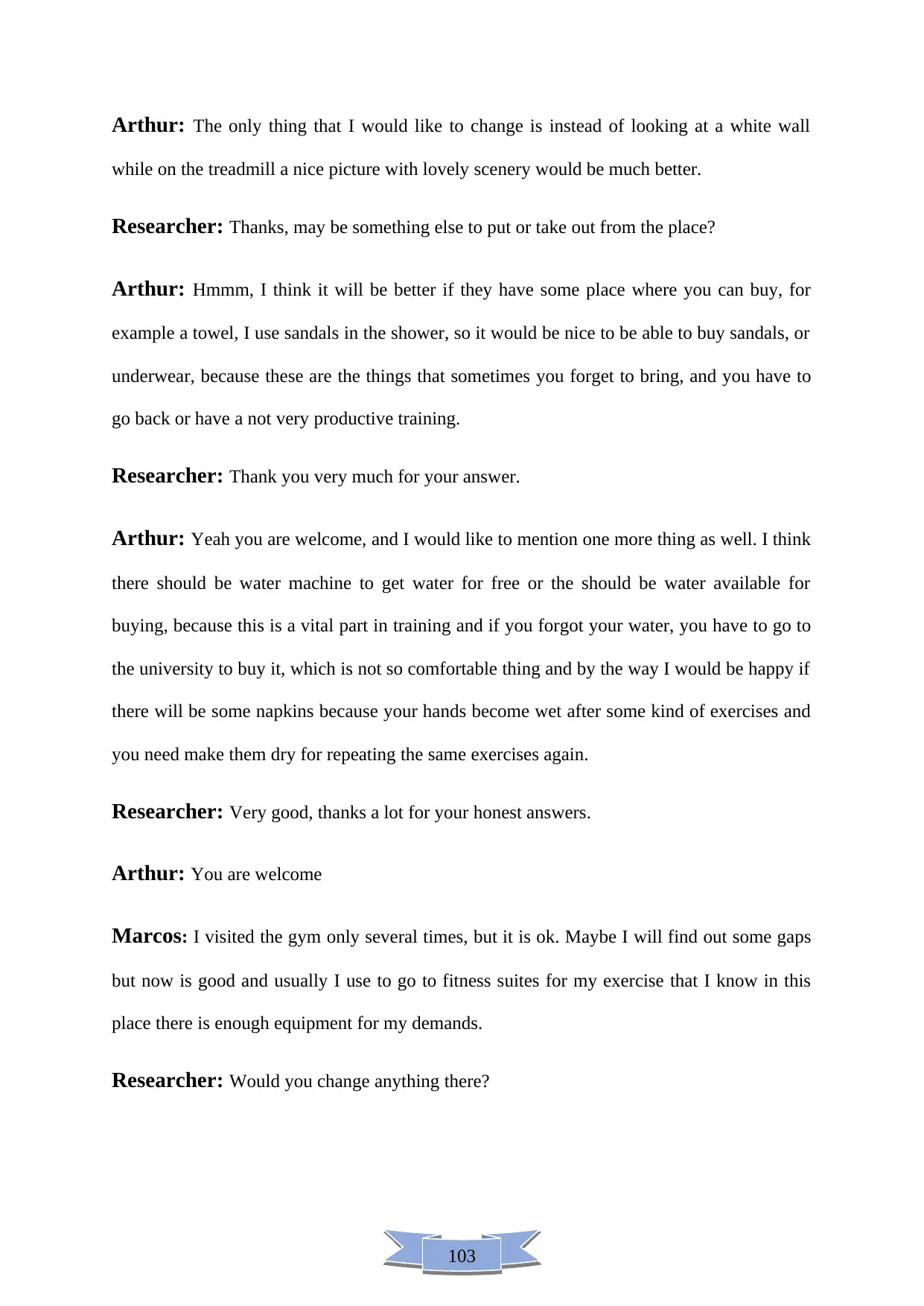
103
Arthur: The only thing that I would like to change is instead of looking at a white wall
while on the treadmill a nice picture with lovely scenery would be much better.
Researcher: Thanks, may be something else to put or take out from the place?
Arthur: Hmmm, I think it will be better if they have some place where you can buy, for
example a towel, I use sandals in the shower, so it would be nice to be able to buy sandals, or
underwear, because these are the things that sometimes you forget to bring, and you have to
go back or have a not very productive training.
Researcher: Thank you very much for your answer.
Arthur: Yeah you are welcome, and I would like to mention one more thing as well. I think
there should be water machine to get water for free or the should be water available for
buying, because this is a vital part in training and if you forgot your water, you have to go to
the university to buy it, which is not so comfortable thing and by the way I would be happy if
there will be some napkins because your hands become wet after some kind of exercises and
you need make them dry for repeating the same exercises again.
Researcher: Very good, thanks a lot for your honest answers.
Arthur: You are welcome
Marcos: I visited the gym only several times, but it is ok. Maybe I will find out some gaps
but now is good and usually I use to go to fitness suites for my exercise that I know in this
place there is enough equipment for my demands.
Researcher: Would you change anything there?
Arthur: The only thing that I would like to change is instead of looking at a white wall
while on the treadmill a nice picture with lovely scenery would be much better.
Researcher: Thanks, may be something else to put or take out from the place?
Arthur: Hmmm, I think it will be better if they have some place where you can buy, for
example a towel, I use sandals in the shower, so it would be nice to be able to buy sandals, or
underwear, because these are the things that sometimes you forget to bring, and you have to
go back or have a not very productive training.
Researcher: Thank you very much for your answer.
Arthur: Yeah you are welcome, and I would like to mention one more thing as well. I think
there should be water machine to get water for free or the should be water available for
buying, because this is a vital part in training and if you forgot your water, you have to go to
the university to buy it, which is not so comfortable thing and by the way I would be happy if
there will be some napkins because your hands become wet after some kind of exercises and
you need make them dry for repeating the same exercises again.
Researcher: Very good, thanks a lot for your honest answers.
Arthur: You are welcome
Marcos: I visited the gym only several times, but it is ok. Maybe I will find out some gaps
but now is good and usually I use to go to fitness suites for my exercise that I know in this
place there is enough equipment for my demands.
Researcher: Would you change anything there?
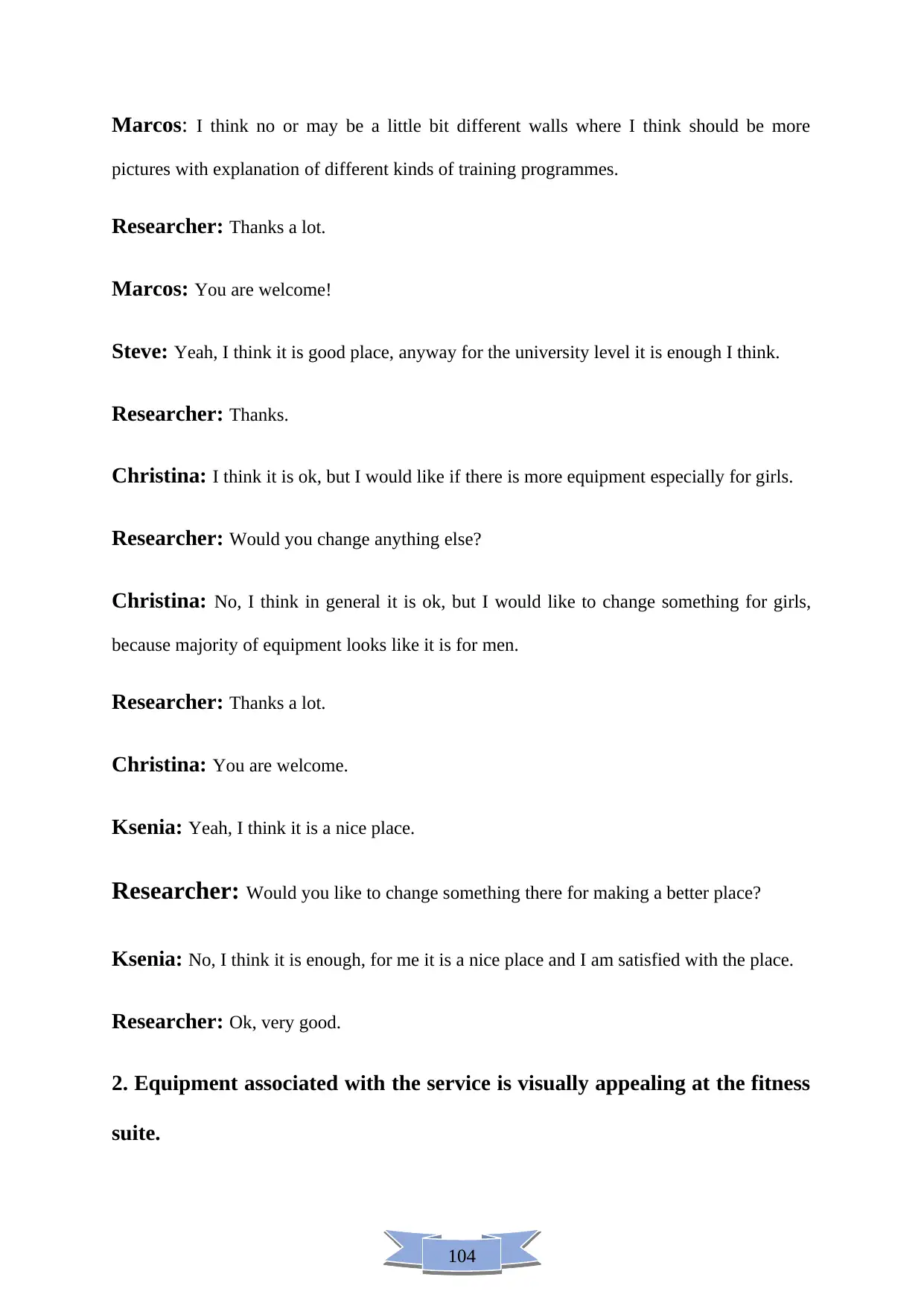
104
Marcos: I think no or may be a little bit different walls where I think should be more
pictures with explanation of different kinds of training programmes.
Researcher: Thanks a lot.
Marcos: You are welcome!
Steve: Yeah, I think it is good place, anyway for the university level it is enough I think.
Researcher: Thanks.
Christina: I think it is ok, but I would like if there is more equipment especially for girls.
Researcher: Would you change anything else?
Christina: No, I think in general it is ok, but I would like to change something for girls,
because majority of equipment looks like it is for men.
Researcher: Thanks a lot.
Christina: You are welcome.
Ksenia: Yeah, I think it is a nice place.
Researcher: Would you like to change something there for making a better place?
Ksenia: No, I think it is enough, for me it is a nice place and I am satisfied with the place.
Researcher: Ok, very good.
2. Equipment associated with the service is visually appealing at the fitness
suite.
Marcos: I think no or may be a little bit different walls where I think should be more
pictures with explanation of different kinds of training programmes.
Researcher: Thanks a lot.
Marcos: You are welcome!
Steve: Yeah, I think it is good place, anyway for the university level it is enough I think.
Researcher: Thanks.
Christina: I think it is ok, but I would like if there is more equipment especially for girls.
Researcher: Would you change anything else?
Christina: No, I think in general it is ok, but I would like to change something for girls,
because majority of equipment looks like it is for men.
Researcher: Thanks a lot.
Christina: You are welcome.
Ksenia: Yeah, I think it is a nice place.
Researcher: Would you like to change something there for making a better place?
Ksenia: No, I think it is enough, for me it is a nice place and I am satisfied with the place.
Researcher: Ok, very good.
2. Equipment associated with the service is visually appealing at the fitness
suite.
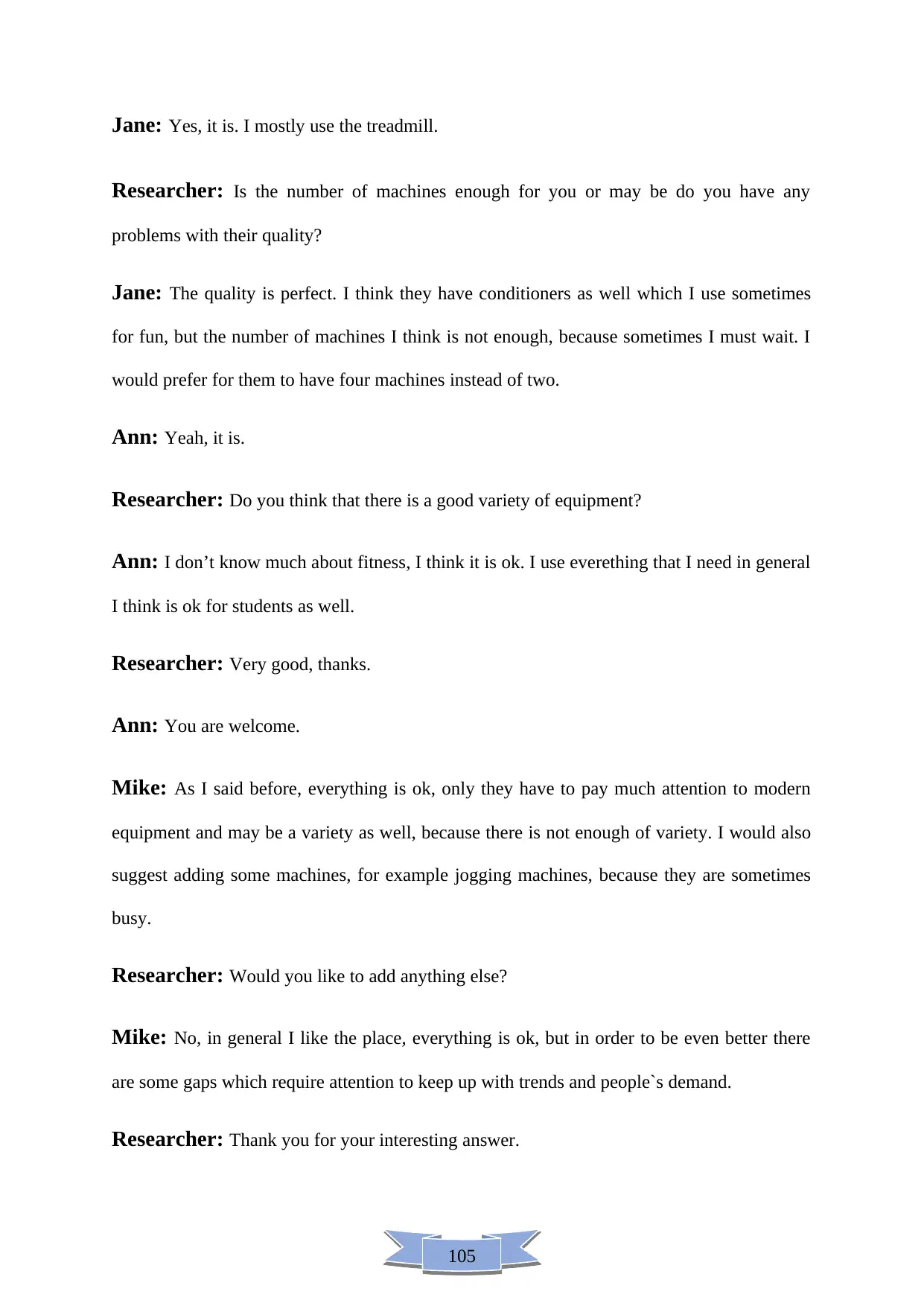
105
Jane: Yes, it is. I mostly use the treadmill.
Researcher: Is the number of machines enough for you or may be do you have any
problems with their quality?
Jane: The quality is perfect. I think they have conditioners as well which I use sometimes
for fun, but the number of machines I think is not enough, because sometimes I must wait. I
would prefer for them to have four machines instead of two.
Ann: Yeah, it is.
Researcher: Do you think that there is a good variety of equipment?
Ann: I don’t know much about fitness, I think it is ok. I use everething that I need in general
I think is ok for students as well.
Researcher: Very good, thanks.
Ann: You are welcome.
Mike: As I said before, everything is ok, only they have to pay much attention to modern
equipment and may be a variety as well, because there is not enough of variety. I would also
suggest adding some machines, for example jogging machines, because they are sometimes
busy.
Researcher: Would you like to add anything else?
Mike: No, in general I like the place, everything is ok, but in order to be even better there
are some gaps which require attention to keep up with trends and people`s demand.
Researcher: Thank you for your interesting answer.
Jane: Yes, it is. I mostly use the treadmill.
Researcher: Is the number of machines enough for you or may be do you have any
problems with their quality?
Jane: The quality is perfect. I think they have conditioners as well which I use sometimes
for fun, but the number of machines I think is not enough, because sometimes I must wait. I
would prefer for them to have four machines instead of two.
Ann: Yeah, it is.
Researcher: Do you think that there is a good variety of equipment?
Ann: I don’t know much about fitness, I think it is ok. I use everething that I need in general
I think is ok for students as well.
Researcher: Very good, thanks.
Ann: You are welcome.
Mike: As I said before, everything is ok, only they have to pay much attention to modern
equipment and may be a variety as well, because there is not enough of variety. I would also
suggest adding some machines, for example jogging machines, because they are sometimes
busy.
Researcher: Would you like to add anything else?
Mike: No, in general I like the place, everything is ok, but in order to be even better there
are some gaps which require attention to keep up with trends and people`s demand.
Researcher: Thank you for your interesting answer.
Secure Best Marks with AI Grader
Need help grading? Try our AI Grader for instant feedback on your assignments.
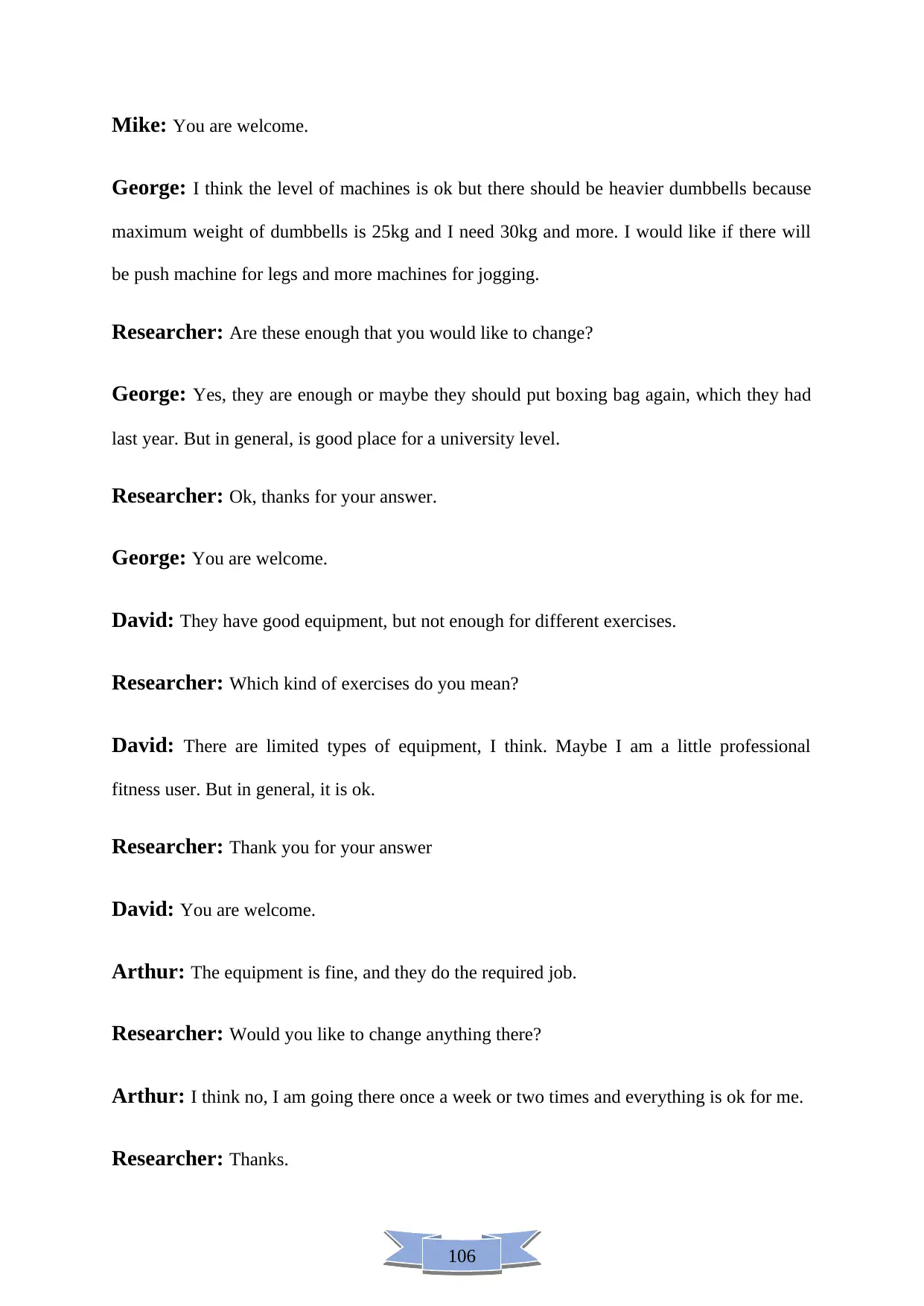
106
Mike: You are welcome.
George: I think the level of machines is ok but there should be heavier dumbbells because
maximum weight of dumbbells is 25kg and I need 30kg and more. I would like if there will
be push machine for legs and more machines for jogging.
Researcher: Are these enough that you would like to change?
George: Yes, they are enough or maybe they should put boxing bag again, which they had
last year. But in general, is good place for a university level.
Researcher: Ok, thanks for your answer.
George: You are welcome.
David: They have good equipment, but not enough for different exercises.
Researcher: Which kind of exercises do you mean?
David: There are limited types of equipment, I think. Maybe I am a little professional
fitness user. But in general, it is ok.
Researcher: Thank you for your answer
David: You are welcome.
Arthur: The equipment is fine, and they do the required job.
Researcher: Would you like to change anything there?
Arthur: I think no, I am going there once a week or two times and everything is ok for me.
Researcher: Thanks.
Mike: You are welcome.
George: I think the level of machines is ok but there should be heavier dumbbells because
maximum weight of dumbbells is 25kg and I need 30kg and more. I would like if there will
be push machine for legs and more machines for jogging.
Researcher: Are these enough that you would like to change?
George: Yes, they are enough or maybe they should put boxing bag again, which they had
last year. But in general, is good place for a university level.
Researcher: Ok, thanks for your answer.
George: You are welcome.
David: They have good equipment, but not enough for different exercises.
Researcher: Which kind of exercises do you mean?
David: There are limited types of equipment, I think. Maybe I am a little professional
fitness user. But in general, it is ok.
Researcher: Thank you for your answer
David: You are welcome.
Arthur: The equipment is fine, and they do the required job.
Researcher: Would you like to change anything there?
Arthur: I think no, I am going there once a week or two times and everything is ok for me.
Researcher: Thanks.
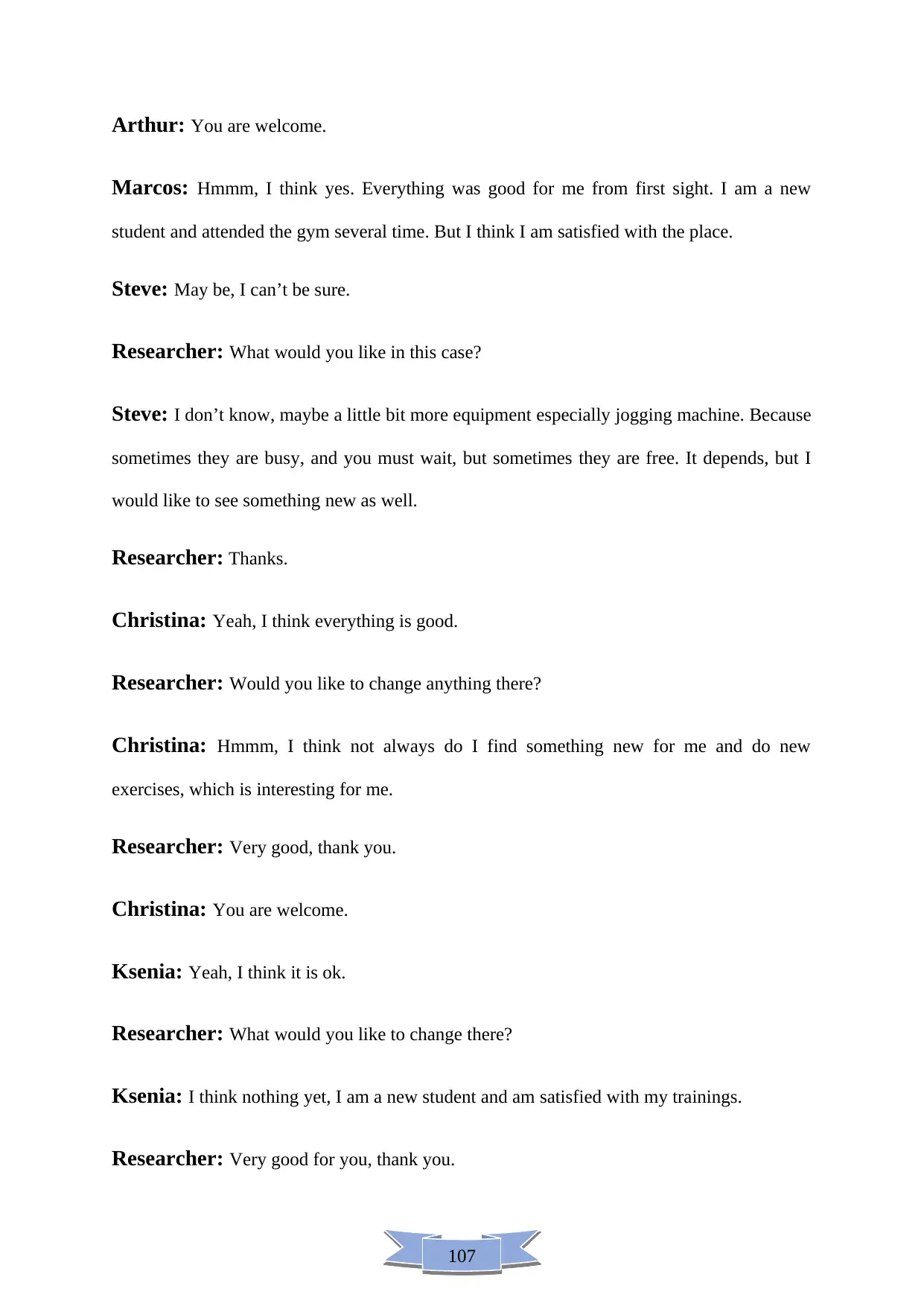
107
Arthur: You are welcome.
Marcos: Hmmm, I think yes. Everything was good for me from first sight. I am a new
student and attended the gym several time. But I think I am satisfied with the place.
Steve: May be, I can’t be sure.
Researcher: What would you like in this case?
Steve: I don’t know, maybe a little bit more equipment especially jogging machine. Because
sometimes they are busy, and you must wait, but sometimes they are free. It depends, but I
would like to see something new as well.
Researcher: Thanks.
Christina: Yeah, I think everything is good.
Researcher: Would you like to change anything there?
Christina: Hmmm, I think not always do I find something new for me and do new
exercises, which is interesting for me.
Researcher: Very good, thank you.
Christina: You are welcome.
Ksenia: Yeah, I think it is ok.
Researcher: What would you like to change there?
Ksenia: I think nothing yet, I am a new student and am satisfied with my trainings.
Researcher: Very good for you, thank you.
Arthur: You are welcome.
Marcos: Hmmm, I think yes. Everything was good for me from first sight. I am a new
student and attended the gym several time. But I think I am satisfied with the place.
Steve: May be, I can’t be sure.
Researcher: What would you like in this case?
Steve: I don’t know, maybe a little bit more equipment especially jogging machine. Because
sometimes they are busy, and you must wait, but sometimes they are free. It depends, but I
would like to see something new as well.
Researcher: Thanks.
Christina: Yeah, I think everything is good.
Researcher: Would you like to change anything there?
Christina: Hmmm, I think not always do I find something new for me and do new
exercises, which is interesting for me.
Researcher: Very good, thank you.
Christina: You are welcome.
Ksenia: Yeah, I think it is ok.
Researcher: What would you like to change there?
Ksenia: I think nothing yet, I am a new student and am satisfied with my trainings.
Researcher: Very good for you, thank you.
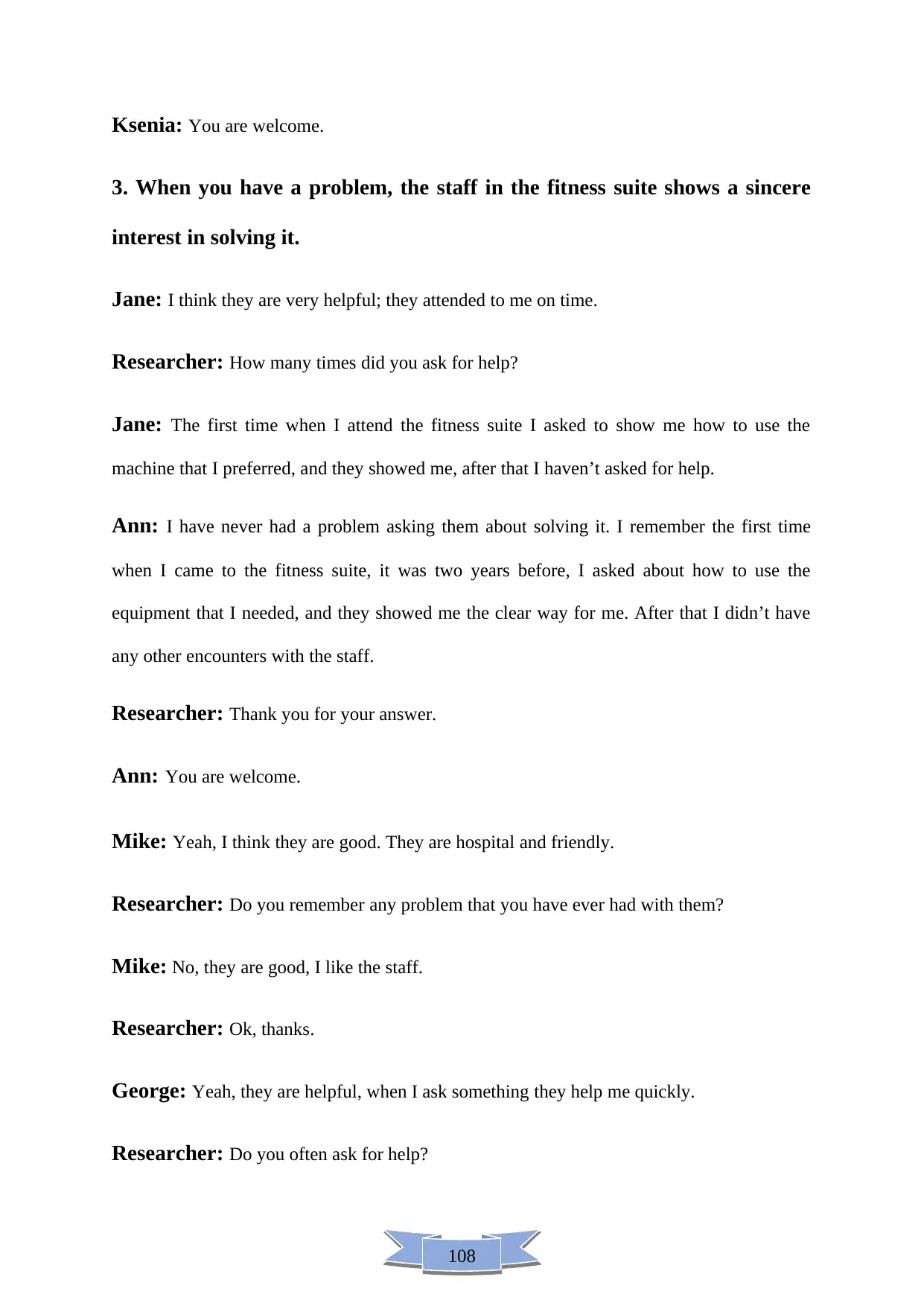
108
Ksenia: You are welcome.
3. When you have a problem, the staff in the fitness suite shows a sincere
interest in solving it.
Jane: I think they are very helpful; they attended to me on time.
Researcher: How many times did you ask for help?
Jane: The first time when I attend the fitness suite I asked to show me how to use the
machine that I preferred, and they showed me, after that I haven’t asked for help.
Ann: I have never had a problem asking them about solving it. I remember the first time
when I came to the fitness suite, it was two years before, I asked about how to use the
equipment that I needed, and they showed me the clear way for me. After that I didn’t have
any other encounters with the staff.
Researcher: Thank you for your answer.
Ann: You are welcome.
Mike: Yeah, I think they are good. They are hospital and friendly.
Researcher: Do you remember any problem that you have ever had with them?
Mike: No, they are good, I like the staff.
Researcher: Ok, thanks.
George: Yeah, they are helpful, when I ask something they help me quickly.
Researcher: Do you often ask for help?
Ksenia: You are welcome.
3. When you have a problem, the staff in the fitness suite shows a sincere
interest in solving it.
Jane: I think they are very helpful; they attended to me on time.
Researcher: How many times did you ask for help?
Jane: The first time when I attend the fitness suite I asked to show me how to use the
machine that I preferred, and they showed me, after that I haven’t asked for help.
Ann: I have never had a problem asking them about solving it. I remember the first time
when I came to the fitness suite, it was two years before, I asked about how to use the
equipment that I needed, and they showed me the clear way for me. After that I didn’t have
any other encounters with the staff.
Researcher: Thank you for your answer.
Ann: You are welcome.
Mike: Yeah, I think they are good. They are hospital and friendly.
Researcher: Do you remember any problem that you have ever had with them?
Mike: No, they are good, I like the staff.
Researcher: Ok, thanks.
George: Yeah, they are helpful, when I ask something they help me quickly.
Researcher: Do you often ask for help?
Paraphrase This Document
Need a fresh take? Get an instant paraphrase of this document with our AI Paraphraser
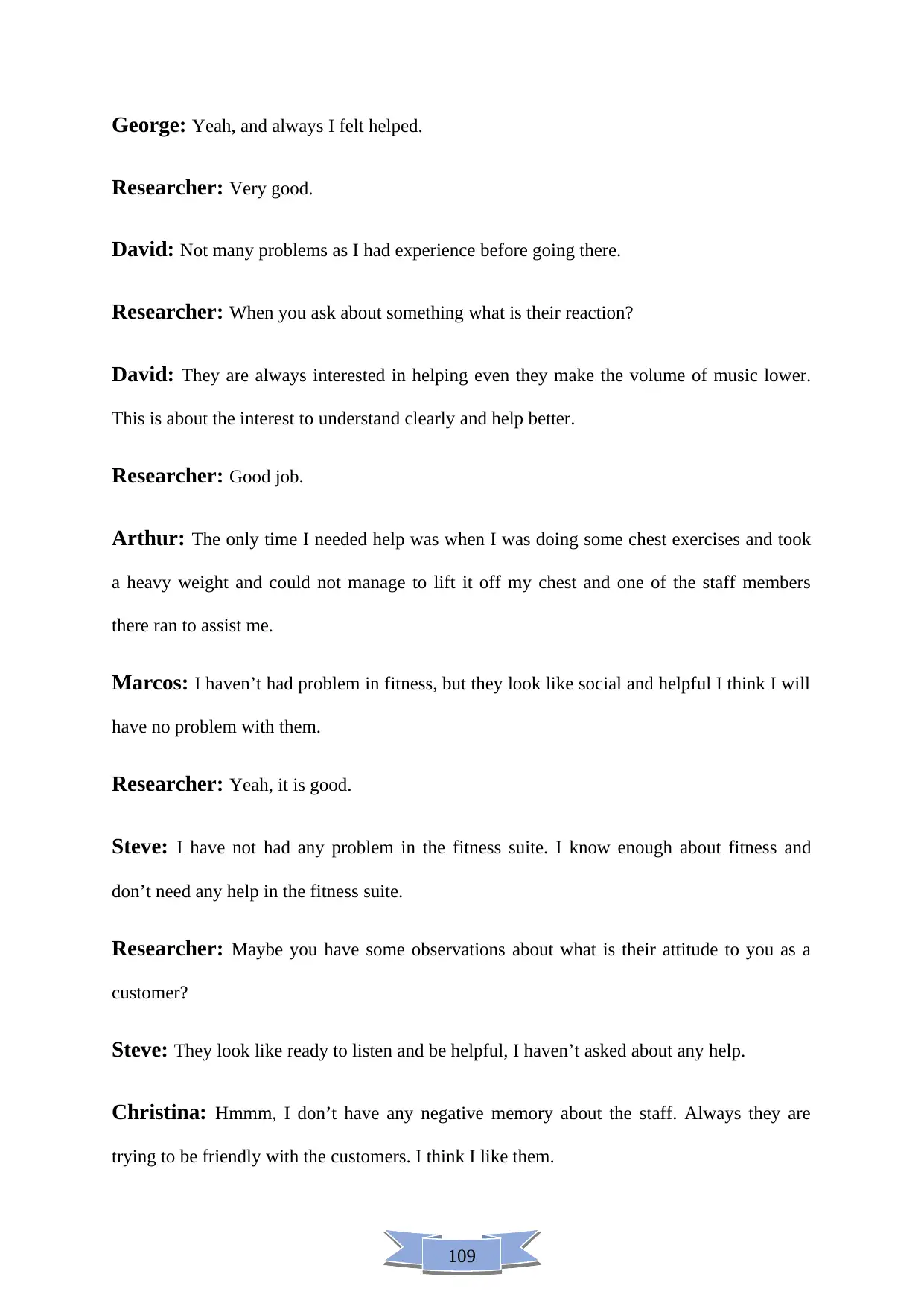
109
George: Yeah, and always I felt helped.
Researcher: Very good.
David: Not many problems as I had experience before going there.
Researcher: When you ask about something what is their reaction?
David: They are always interested in helping even they make the volume of music lower.
This is about the interest to understand clearly and help better.
Researcher: Good job.
Arthur: The only time I needed help was when I was doing some chest exercises and took
a heavy weight and could not manage to lift it off my chest and one of the staff members
there ran to assist me.
Marcos: I haven’t had problem in fitness, but they look like social and helpful I think I will
have no problem with them.
Researcher: Yeah, it is good.
Steve: I have not had any problem in the fitness suite. I know enough about fitness and
don’t need any help in the fitness suite.
Researcher: Maybe you have some observations about what is their attitude to you as a
customer?
Steve: They look like ready to listen and be helpful, I haven’t asked about any help.
Christina: Hmmm, I don’t have any negative memory about the staff. Always they are
trying to be friendly with the customers. I think I like them.
George: Yeah, and always I felt helped.
Researcher: Very good.
David: Not many problems as I had experience before going there.
Researcher: When you ask about something what is their reaction?
David: They are always interested in helping even they make the volume of music lower.
This is about the interest to understand clearly and help better.
Researcher: Good job.
Arthur: The only time I needed help was when I was doing some chest exercises and took
a heavy weight and could not manage to lift it off my chest and one of the staff members
there ran to assist me.
Marcos: I haven’t had problem in fitness, but they look like social and helpful I think I will
have no problem with them.
Researcher: Yeah, it is good.
Steve: I have not had any problem in the fitness suite. I know enough about fitness and
don’t need any help in the fitness suite.
Researcher: Maybe you have some observations about what is their attitude to you as a
customer?
Steve: They look like ready to listen and be helpful, I haven’t asked about any help.
Christina: Hmmm, I don’t have any negative memory about the staff. Always they are
trying to be friendly with the customers. I think I like them.
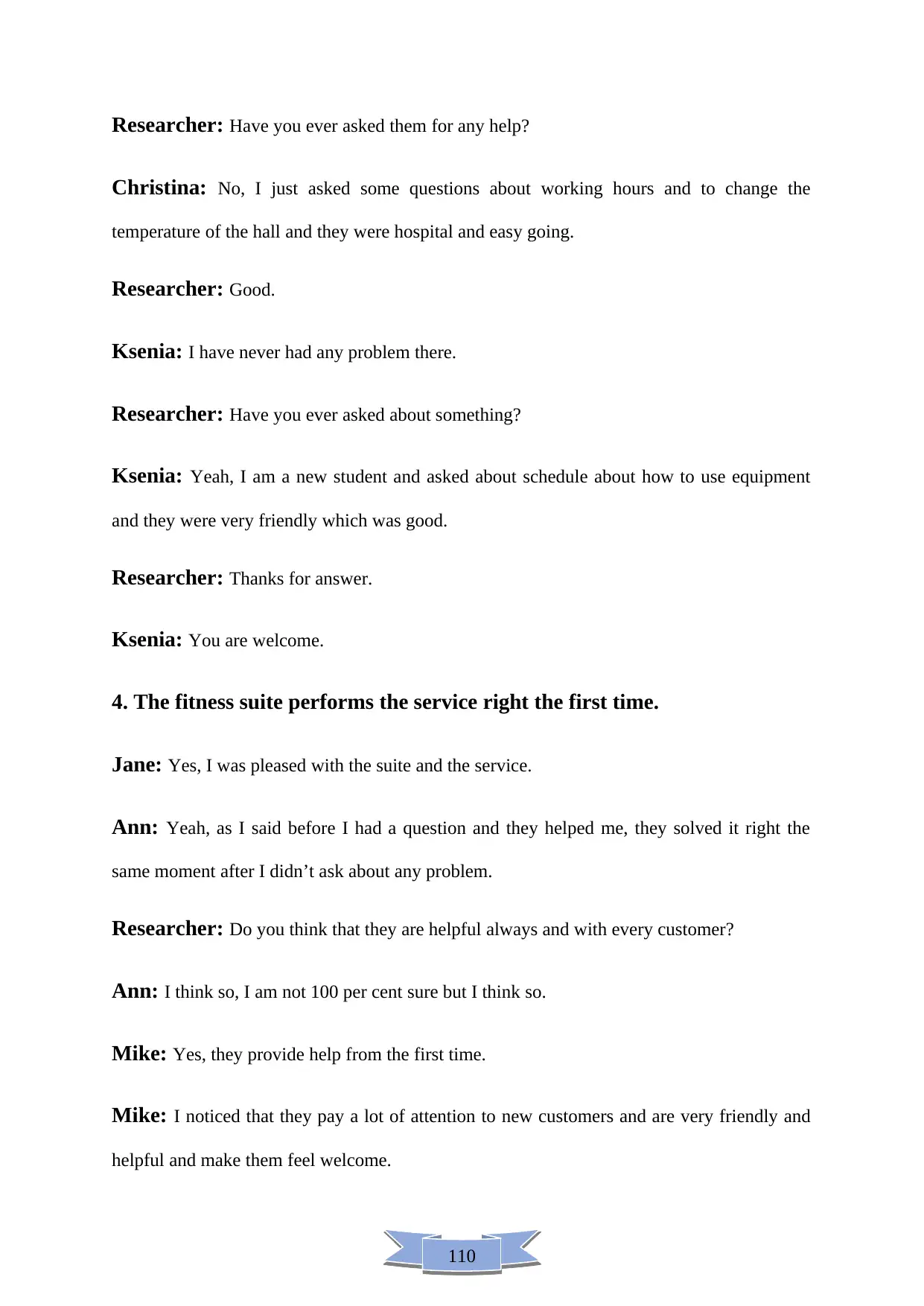
110
Researcher: Have you ever asked them for any help?
Christina: No, I just asked some questions about working hours and to change the
temperature of the hall and they were hospital and easy going.
Researcher: Good.
Ksenia: I have never had any problem there.
Researcher: Have you ever asked about something?
Ksenia: Yeah, I am a new student and asked about schedule about how to use equipment
and they were very friendly which was good.
Researcher: Thanks for answer.
Ksenia: You are welcome.
4. The fitness suite performs the service right the first time.
Jane: Yes, I was pleased with the suite and the service.
Ann: Yeah, as I said before I had a question and they helped me, they solved it right the
same moment after I didn’t ask about any problem.
Researcher: Do you think that they are helpful always and with every customer?
Ann: I think so, I am not 100 per cent sure but I think so.
Mike: Yes, they provide help from the first time.
Mike: I noticed that they pay a lot of attention to new customers and are very friendly and
helpful and make them feel welcome.
Researcher: Have you ever asked them for any help?
Christina: No, I just asked some questions about working hours and to change the
temperature of the hall and they were hospital and easy going.
Researcher: Good.
Ksenia: I have never had any problem there.
Researcher: Have you ever asked about something?
Ksenia: Yeah, I am a new student and asked about schedule about how to use equipment
and they were very friendly which was good.
Researcher: Thanks for answer.
Ksenia: You are welcome.
4. The fitness suite performs the service right the first time.
Jane: Yes, I was pleased with the suite and the service.
Ann: Yeah, as I said before I had a question and they helped me, they solved it right the
same moment after I didn’t ask about any problem.
Researcher: Do you think that they are helpful always and with every customer?
Ann: I think so, I am not 100 per cent sure but I think so.
Mike: Yes, they provide help from the first time.
Mike: I noticed that they pay a lot of attention to new customers and are very friendly and
helpful and make them feel welcome.
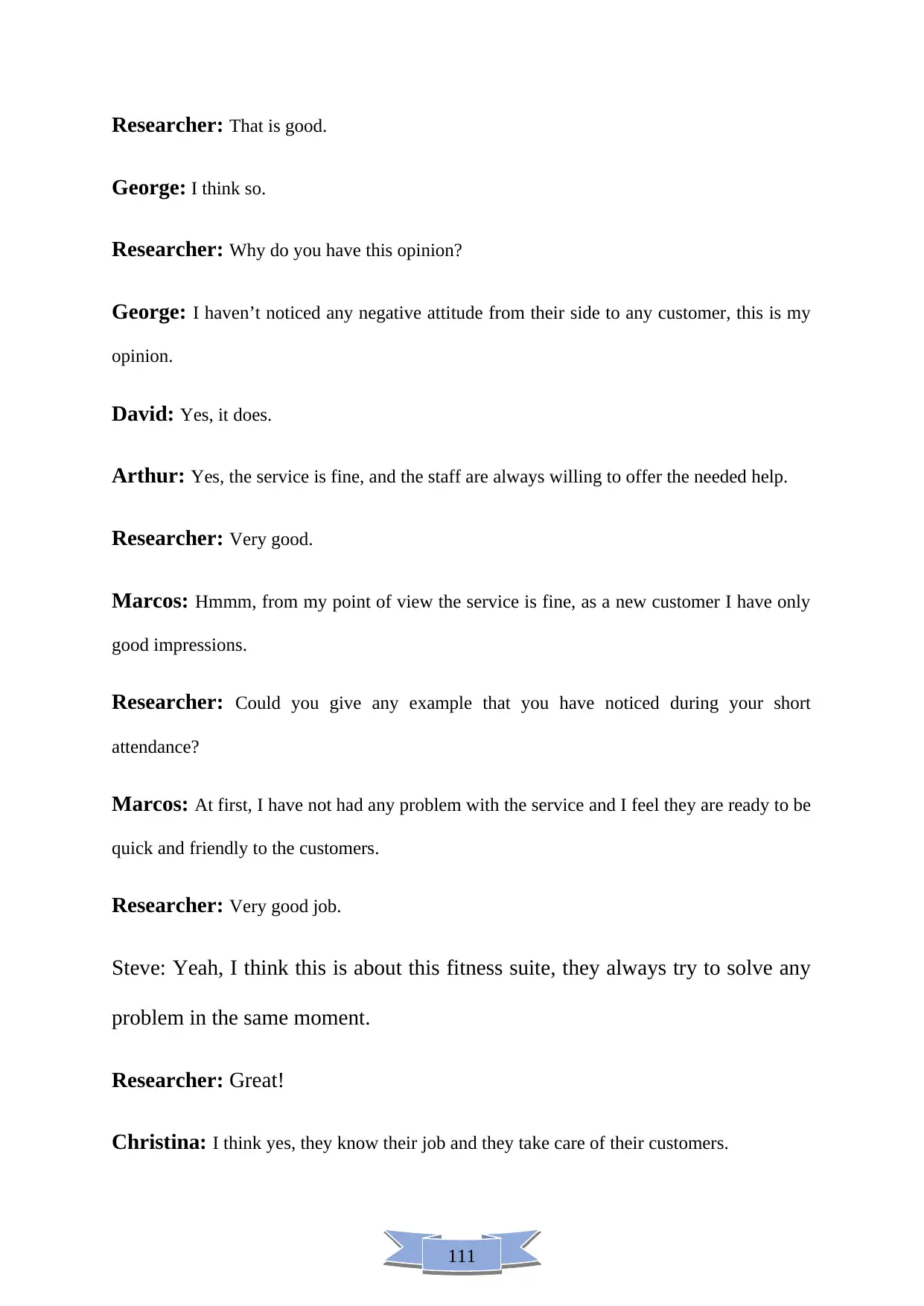
111
Researcher: That is good.
George: I think so.
Researcher: Why do you have this opinion?
George: I haven’t noticed any negative attitude from their side to any customer, this is my
opinion.
David: Yes, it does.
Arthur: Yes, the service is fine, and the staff are always willing to offer the needed help.
Researcher: Very good.
Marcos: Hmmm, from my point of view the service is fine, as a new customer I have only
good impressions.
Researcher: Could you give any example that you have noticed during your short
attendance?
Marcos: At first, I have not had any problem with the service and I feel they are ready to be
quick and friendly to the customers.
Researcher: Very good job.
Steve: Yeah, I think this is about this fitness suite, they always try to solve any
problem in the same moment.
Researcher: Great!
Christina: I think yes, they know their job and they take care of their customers.
Researcher: That is good.
George: I think so.
Researcher: Why do you have this opinion?
George: I haven’t noticed any negative attitude from their side to any customer, this is my
opinion.
David: Yes, it does.
Arthur: Yes, the service is fine, and the staff are always willing to offer the needed help.
Researcher: Very good.
Marcos: Hmmm, from my point of view the service is fine, as a new customer I have only
good impressions.
Researcher: Could you give any example that you have noticed during your short
attendance?
Marcos: At first, I have not had any problem with the service and I feel they are ready to be
quick and friendly to the customers.
Researcher: Very good job.
Steve: Yeah, I think this is about this fitness suite, they always try to solve any
problem in the same moment.
Researcher: Great!
Christina: I think yes, they know their job and they take care of their customers.
Secure Best Marks with AI Grader
Need help grading? Try our AI Grader for instant feedback on your assignments.
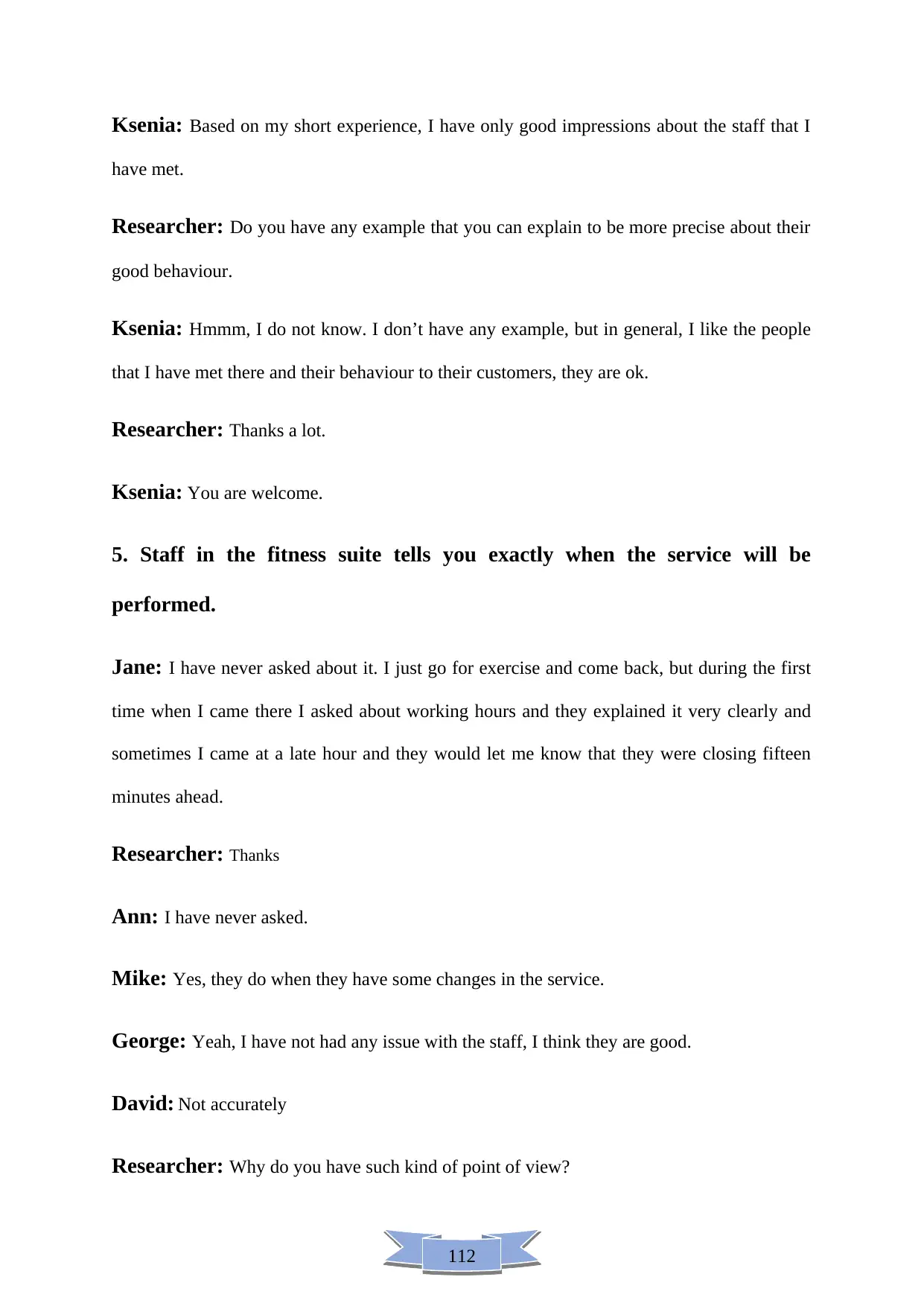
112
Ksenia: Based on my short experience, I have only good impressions about the staff that I
have met.
Researcher: Do you have any example that you can explain to be more precise about their
good behaviour.
Ksenia: Hmmm, I do not know. I don’t have any example, but in general, I like the people
that I have met there and their behaviour to their customers, they are ok.
Researcher: Thanks a lot.
Ksenia: You are welcome.
5. Staff in the fitness suite tells you exactly when the service will be
performed.
Jane: I have never asked about it. I just go for exercise and come back, but during the first
time when I came there I asked about working hours and they explained it very clearly and
sometimes I came at a late hour and they would let me know that they were closing fifteen
minutes ahead.
Researcher: Thanks
Ann: I have never asked.
Mike: Yes, they do when they have some changes in the service.
George: Yeah, I have not had any issue with the staff, I think they are good.
David: Not accurately
Researcher: Why do you have such kind of point of view?
Ksenia: Based on my short experience, I have only good impressions about the staff that I
have met.
Researcher: Do you have any example that you can explain to be more precise about their
good behaviour.
Ksenia: Hmmm, I do not know. I don’t have any example, but in general, I like the people
that I have met there and their behaviour to their customers, they are ok.
Researcher: Thanks a lot.
Ksenia: You are welcome.
5. Staff in the fitness suite tells you exactly when the service will be
performed.
Jane: I have never asked about it. I just go for exercise and come back, but during the first
time when I came there I asked about working hours and they explained it very clearly and
sometimes I came at a late hour and they would let me know that they were closing fifteen
minutes ahead.
Researcher: Thanks
Ann: I have never asked.
Mike: Yes, they do when they have some changes in the service.
George: Yeah, I have not had any issue with the staff, I think they are good.
David: Not accurately
Researcher: Why do you have such kind of point of view?
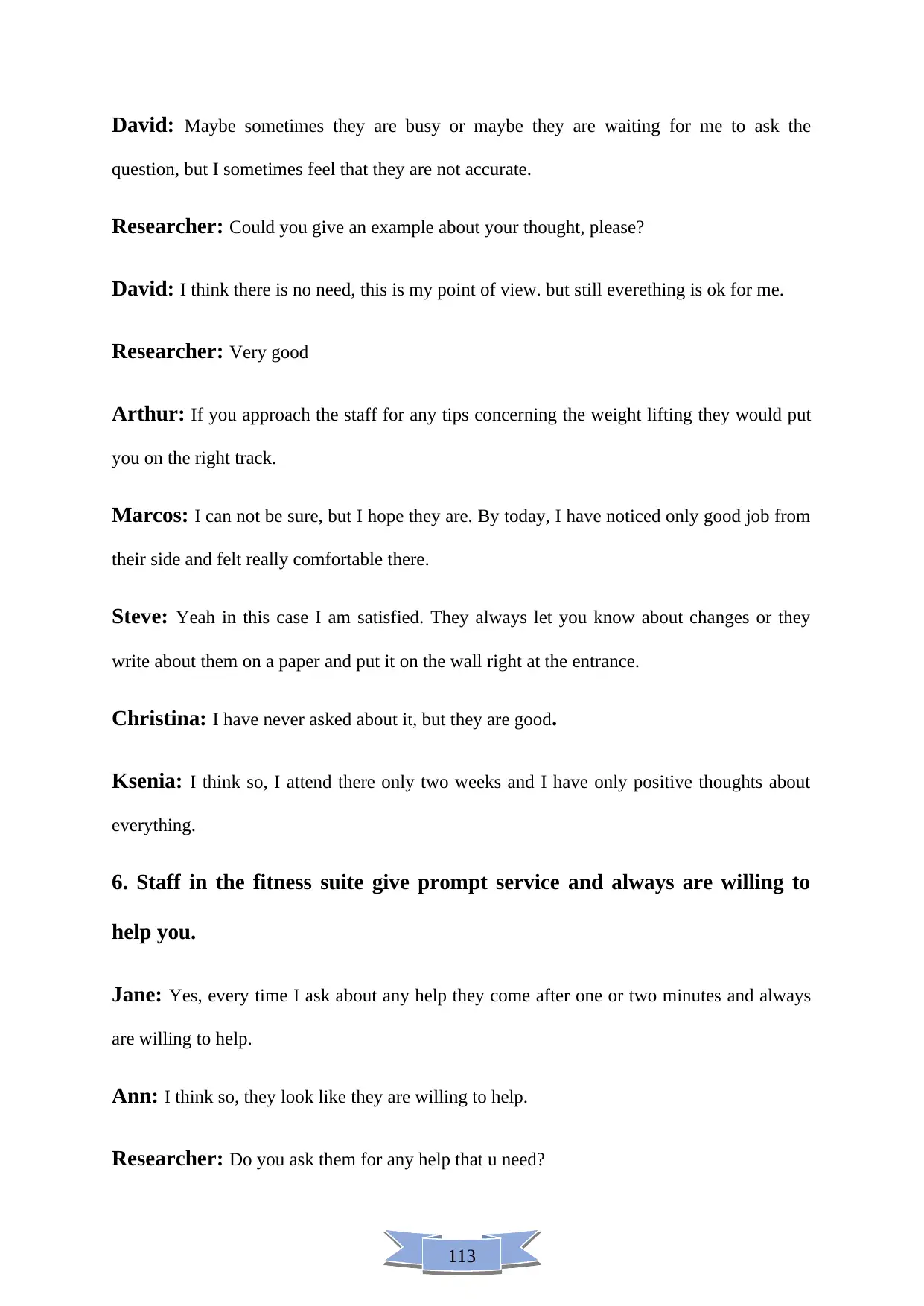
113
David: Maybe sometimes they are busy or maybe they are waiting for me to ask the
question, but I sometimes feel that they are not accurate.
Researcher: Could you give an example about your thought, please?
David: I think there is no need, this is my point of view. but still everething is ok for me.
Researcher: Very good
Arthur: If you approach the staff for any tips concerning the weight lifting they would put
you on the right track.
Marcos: I can not be sure, but I hope they are. By today, I have noticed only good job from
their side and felt really comfortable there.
Steve: Yeah in this case I am satisfied. They always let you know about changes or they
write about them on a paper and put it on the wall right at the entrance.
Christina: I have never asked about it, but they are good.
Ksenia: I think so, I attend there only two weeks and I have only positive thoughts about
everything.
6. Staff in the fitness suite give prompt service and always are willing to
help you.
Jane: Yes, every time I ask about any help they come after one or two minutes and always
are willing to help.
Ann: I think so, they look like they are willing to help.
Researcher: Do you ask them for any help that u need?
David: Maybe sometimes they are busy or maybe they are waiting for me to ask the
question, but I sometimes feel that they are not accurate.
Researcher: Could you give an example about your thought, please?
David: I think there is no need, this is my point of view. but still everething is ok for me.
Researcher: Very good
Arthur: If you approach the staff for any tips concerning the weight lifting they would put
you on the right track.
Marcos: I can not be sure, but I hope they are. By today, I have noticed only good job from
their side and felt really comfortable there.
Steve: Yeah in this case I am satisfied. They always let you know about changes or they
write about them on a paper and put it on the wall right at the entrance.
Christina: I have never asked about it, but they are good.
Ksenia: I think so, I attend there only two weeks and I have only positive thoughts about
everything.
6. Staff in the fitness suite give prompt service and always are willing to
help you.
Jane: Yes, every time I ask about any help they come after one or two minutes and always
are willing to help.
Ann: I think so, they look like they are willing to help.
Researcher: Do you ask them for any help that u need?
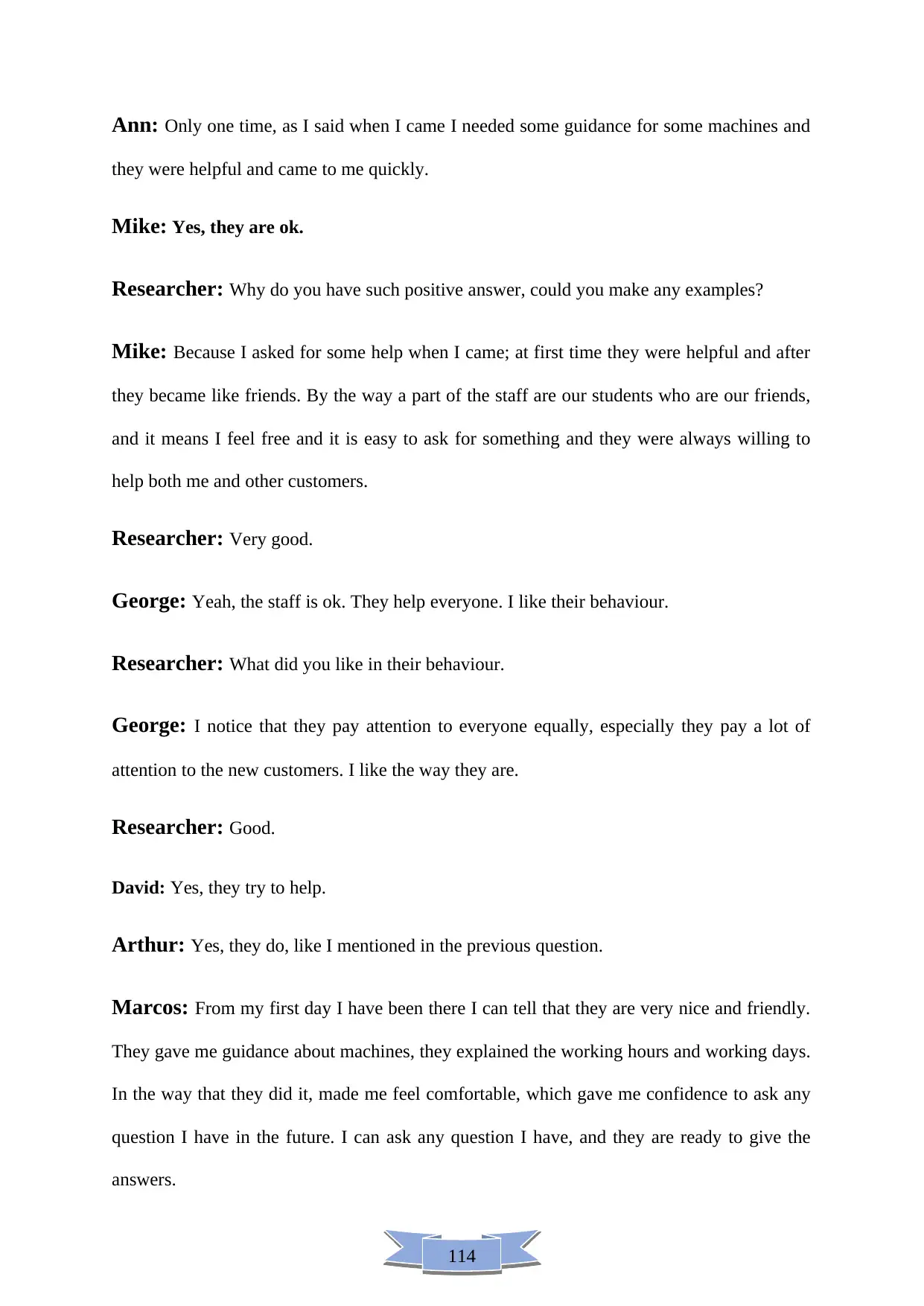
114
Ann: Only one time, as I said when I came I needed some guidance for some machines and
they were helpful and came to me quickly.
Mike: Yes, they are ok.
Researcher: Why do you have such positive answer, could you make any examples?
Mike: Because I asked for some help when I came; at first time they were helpful and after
they became like friends. By the way a part of the staff are our students who are our friends,
and it means I feel free and it is easy to ask for something and they were always willing to
help both me and other customers.
Researcher: Very good.
George: Yeah, the staff is ok. They help everyone. I like their behaviour.
Researcher: What did you like in their behaviour.
George: I notice that they pay attention to everyone equally, especially they pay a lot of
attention to the new customers. I like the way they are.
Researcher: Good.
David: Yes, they try to help.
Arthur: Yes, they do, like I mentioned in the previous question.
Marcos: From my first day I have been there I can tell that they are very nice and friendly.
They gave me guidance about machines, they explained the working hours and working days.
In the way that they did it, made me feel comfortable, which gave me confidence to ask any
question I have in the future. I can ask any question I have, and they are ready to give the
answers.
Ann: Only one time, as I said when I came I needed some guidance for some machines and
they were helpful and came to me quickly.
Mike: Yes, they are ok.
Researcher: Why do you have such positive answer, could you make any examples?
Mike: Because I asked for some help when I came; at first time they were helpful and after
they became like friends. By the way a part of the staff are our students who are our friends,
and it means I feel free and it is easy to ask for something and they were always willing to
help both me and other customers.
Researcher: Very good.
George: Yeah, the staff is ok. They help everyone. I like their behaviour.
Researcher: What did you like in their behaviour.
George: I notice that they pay attention to everyone equally, especially they pay a lot of
attention to the new customers. I like the way they are.
Researcher: Good.
David: Yes, they try to help.
Arthur: Yes, they do, like I mentioned in the previous question.
Marcos: From my first day I have been there I can tell that they are very nice and friendly.
They gave me guidance about machines, they explained the working hours and working days.
In the way that they did it, made me feel comfortable, which gave me confidence to ask any
question I have in the future. I can ask any question I have, and they are ready to give the
answers.
Paraphrase This Document
Need a fresh take? Get an instant paraphrase of this document with our AI Paraphraser
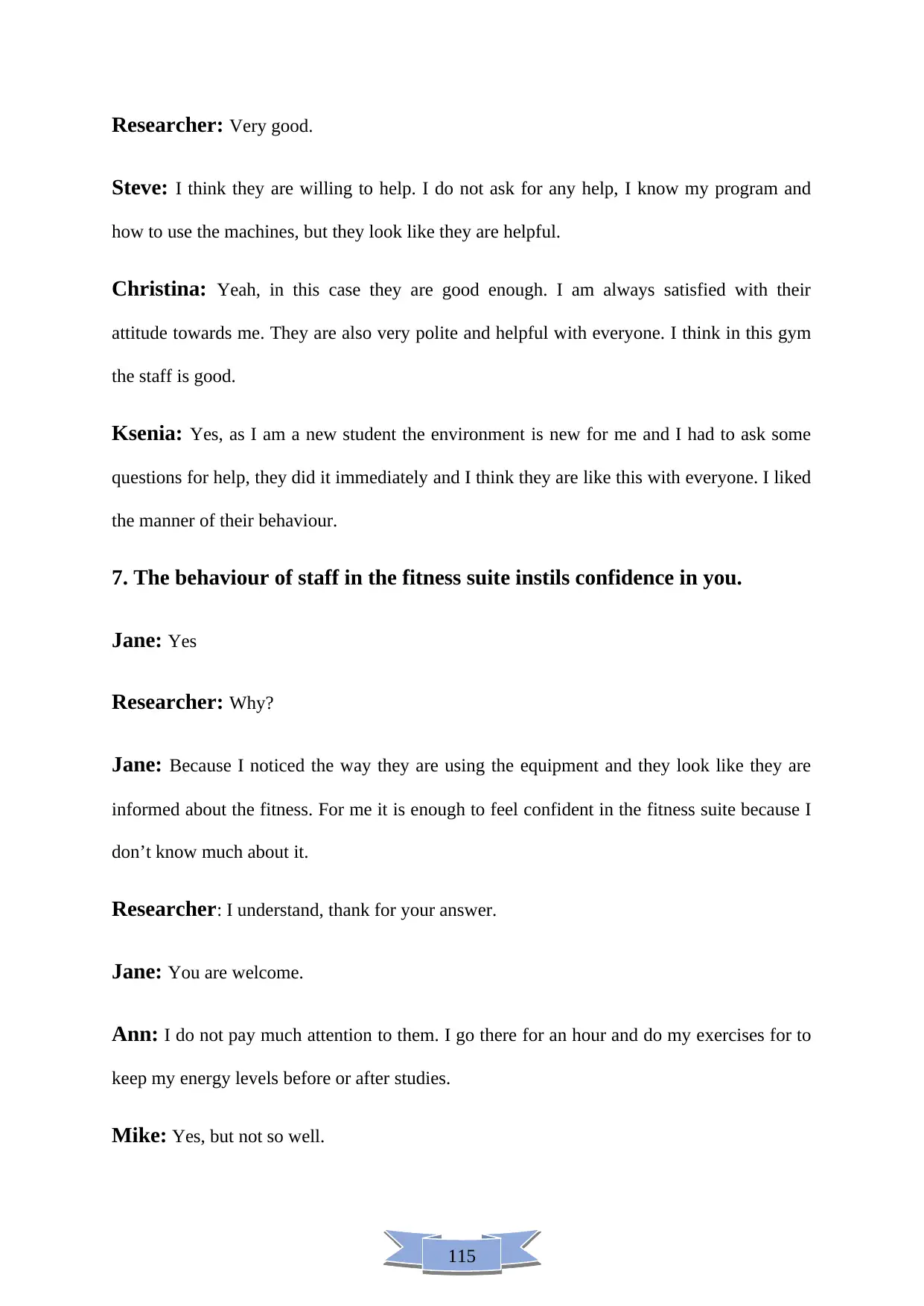
115
Researcher: Very good.
Steve: I think they are willing to help. I do not ask for any help, I know my program and
how to use the machines, but they look like they are helpful.
Christina: Yeah, in this case they are good enough. I am always satisfied with their
attitude towards me. They are also very polite and helpful with everyone. I think in this gym
the staff is good.
Ksenia: Yes, as I am a new student the environment is new for me and I had to ask some
questions for help, they did it immediately and I think they are like this with everyone. I liked
the manner of their behaviour.
7. The behaviour of staff in the fitness suite instils confidence in you.
Jane: Yes
Researcher: Why?
Jane: Because I noticed the way they are using the equipment and they look like they are
informed about the fitness. For me it is enough to feel confident in the fitness suite because I
don’t know much about it.
Researcher: I understand, thank for your answer.
Jane: You are welcome.
Ann: I do not pay much attention to them. I go there for an hour and do my exercises for to
keep my energy levels before or after studies.
Mike: Yes, but not so well.
Researcher: Very good.
Steve: I think they are willing to help. I do not ask for any help, I know my program and
how to use the machines, but they look like they are helpful.
Christina: Yeah, in this case they are good enough. I am always satisfied with their
attitude towards me. They are also very polite and helpful with everyone. I think in this gym
the staff is good.
Ksenia: Yes, as I am a new student the environment is new for me and I had to ask some
questions for help, they did it immediately and I think they are like this with everyone. I liked
the manner of their behaviour.
7. The behaviour of staff in the fitness suite instils confidence in you.
Jane: Yes
Researcher: Why?
Jane: Because I noticed the way they are using the equipment and they look like they are
informed about the fitness. For me it is enough to feel confident in the fitness suite because I
don’t know much about it.
Researcher: I understand, thank for your answer.
Jane: You are welcome.
Ann: I do not pay much attention to them. I go there for an hour and do my exercises for to
keep my energy levels before or after studies.
Mike: Yes, but not so well.
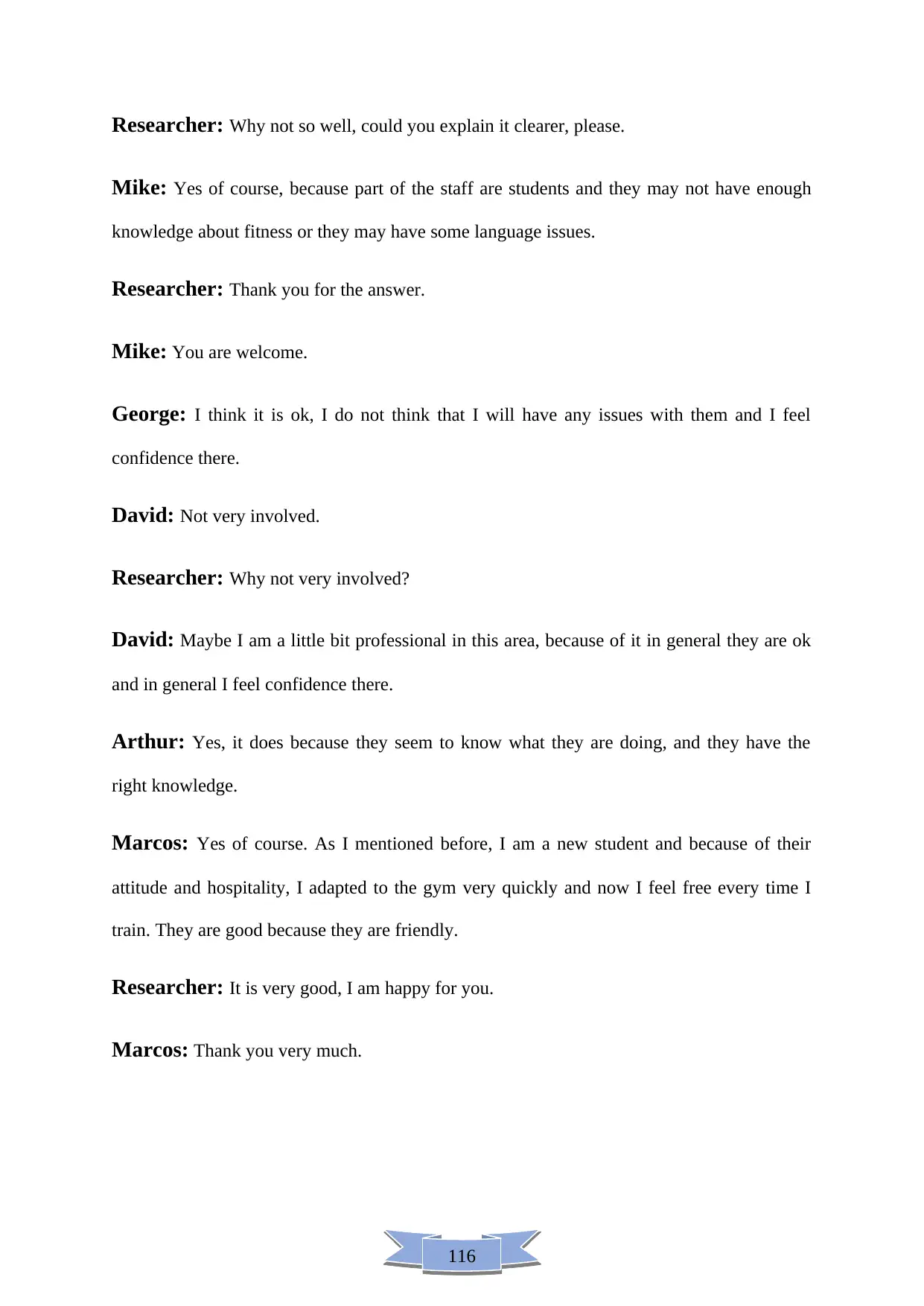
116
Researcher: Why not so well, could you explain it clearer, please.
Mike: Yes of course, because part of the staff are students and they may not have enough
knowledge about fitness or they may have some language issues.
Researcher: Thank you for the answer.
Mike: You are welcome.
George: I think it is ok, I do not think that I will have any issues with them and I feel
confidence there.
David: Not very involved.
Researcher: Why not very involved?
David: Maybe I am a little bit professional in this area, because of it in general they are ok
and in general I feel confidence there.
Arthur: Yes, it does because they seem to know what they are doing, and they have the
right knowledge.
Marcos: Yes of course. As I mentioned before, I am a new student and because of their
attitude and hospitality, I adapted to the gym very quickly and now I feel free every time I
train. They are good because they are friendly.
Researcher: It is very good, I am happy for you.
Marcos: Thank you very much.
Researcher: Why not so well, could you explain it clearer, please.
Mike: Yes of course, because part of the staff are students and they may not have enough
knowledge about fitness or they may have some language issues.
Researcher: Thank you for the answer.
Mike: You are welcome.
George: I think it is ok, I do not think that I will have any issues with them and I feel
confidence there.
David: Not very involved.
Researcher: Why not very involved?
David: Maybe I am a little bit professional in this area, because of it in general they are ok
and in general I feel confidence there.
Arthur: Yes, it does because they seem to know what they are doing, and they have the
right knowledge.
Marcos: Yes of course. As I mentioned before, I am a new student and because of their
attitude and hospitality, I adapted to the gym very quickly and now I feel free every time I
train. They are good because they are friendly.
Researcher: It is very good, I am happy for you.
Marcos: Thank you very much.
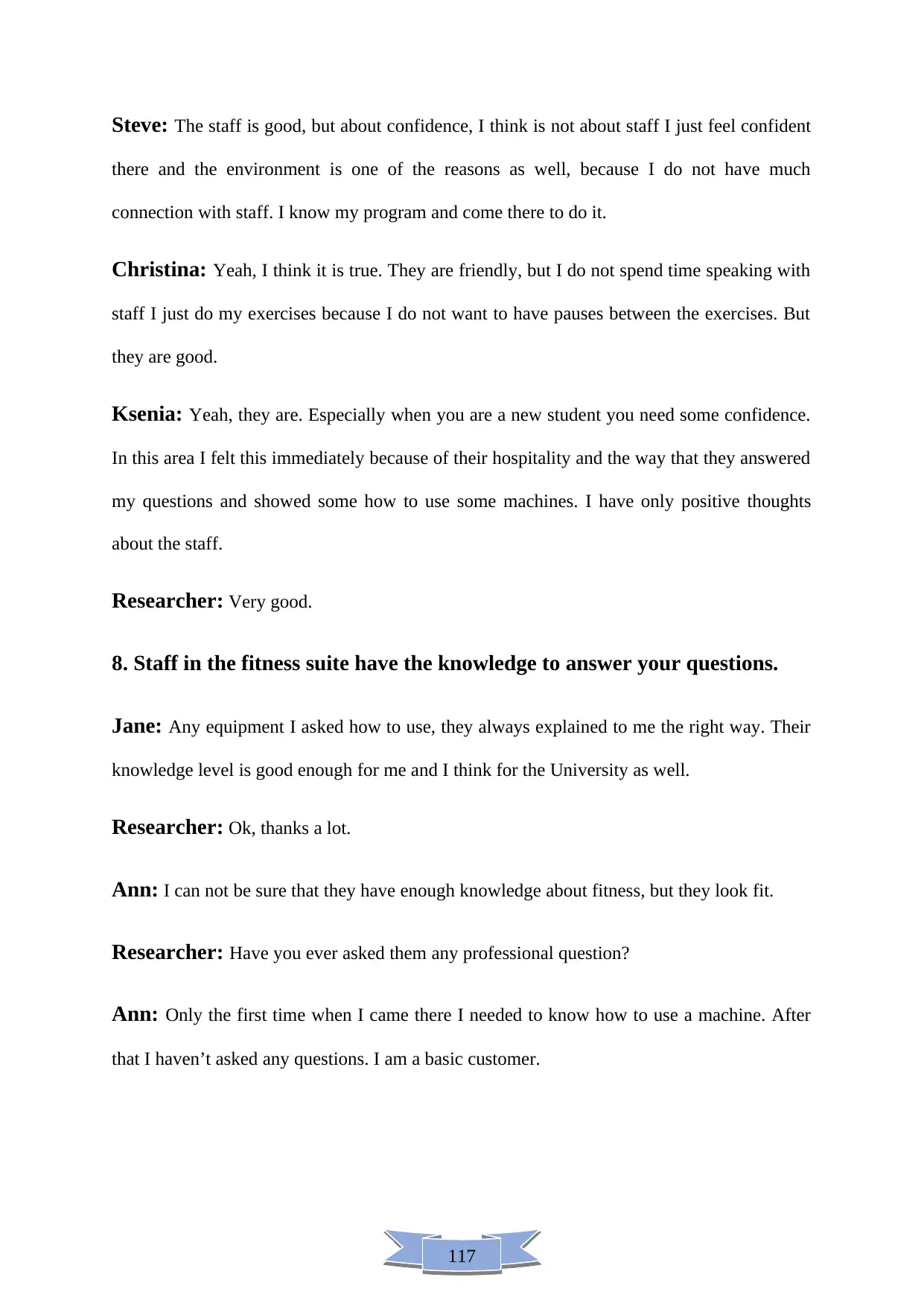
117
Steve: The staff is good, but about confidence, I think is not about staff I just feel confident
there and the environment is one of the reasons as well, because I do not have much
connection with staff. I know my program and come there to do it.
Christina: Yeah, I think it is true. They are friendly, but I do not spend time speaking with
staff I just do my exercises because I do not want to have pauses between the exercises. But
they are good.
Ksenia: Yeah, they are. Especially when you are a new student you need some confidence.
In this area I felt this immediately because of their hospitality and the way that they answered
my questions and showed some how to use some machines. I have only positive thoughts
about the staff.
Researcher: Very good.
8. Staff in the fitness suite have the knowledge to answer your questions.
Jane: Any equipment I asked how to use, they always explained to me the right way. Their
knowledge level is good enough for me and I think for the University as well.
Researcher: Ok, thanks a lot.
Ann: I can not be sure that they have enough knowledge about fitness, but they look fit.
Researcher: Have you ever asked them any professional question?
Ann: Only the first time when I came there I needed to know how to use a machine. After
that I haven’t asked any questions. I am a basic customer.
Steve: The staff is good, but about confidence, I think is not about staff I just feel confident
there and the environment is one of the reasons as well, because I do not have much
connection with staff. I know my program and come there to do it.
Christina: Yeah, I think it is true. They are friendly, but I do not spend time speaking with
staff I just do my exercises because I do not want to have pauses between the exercises. But
they are good.
Ksenia: Yeah, they are. Especially when you are a new student you need some confidence.
In this area I felt this immediately because of their hospitality and the way that they answered
my questions and showed some how to use some machines. I have only positive thoughts
about the staff.
Researcher: Very good.
8. Staff in the fitness suite have the knowledge to answer your questions.
Jane: Any equipment I asked how to use, they always explained to me the right way. Their
knowledge level is good enough for me and I think for the University as well.
Researcher: Ok, thanks a lot.
Ann: I can not be sure that they have enough knowledge about fitness, but they look fit.
Researcher: Have you ever asked them any professional question?
Ann: Only the first time when I came there I needed to know how to use a machine. After
that I haven’t asked any questions. I am a basic customer.
Secure Best Marks with AI Grader
Need help grading? Try our AI Grader for instant feedback on your assignments.
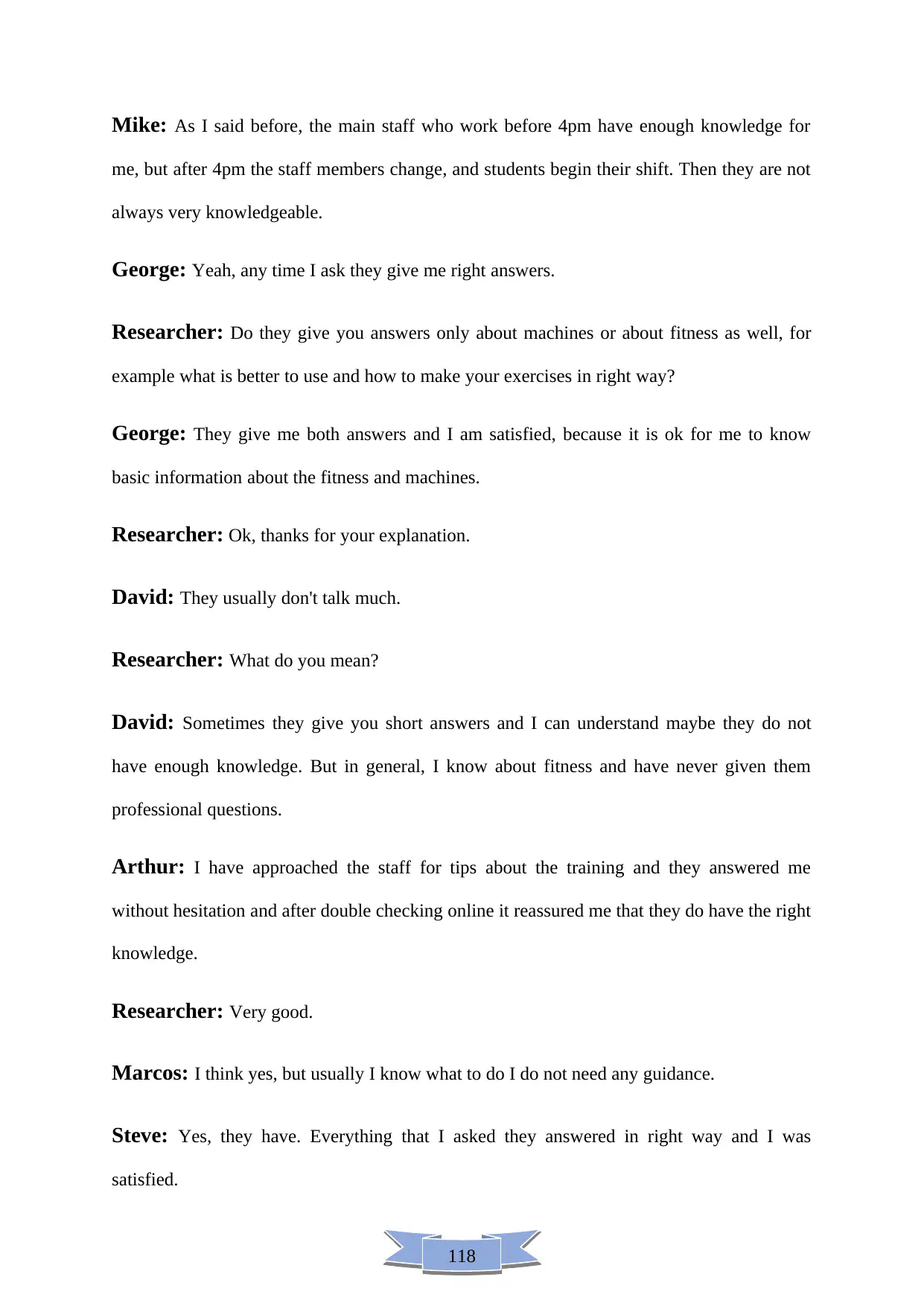
118
Mike: As I said before, the main staff who work before 4pm have enough knowledge for
me, but after 4pm the staff members change, and students begin their shift. Then they are not
always very knowledgeable.
George: Yeah, any time I ask they give me right answers.
Researcher: Do they give you answers only about machines or about fitness as well, for
example what is better to use and how to make your exercises in right way?
George: They give me both answers and I am satisfied, because it is ok for me to know
basic information about the fitness and machines.
Researcher: Ok, thanks for your explanation.
David: They usually don't talk much.
Researcher: What do you mean?
David: Sometimes they give you short answers and I can understand maybe they do not
have enough knowledge. But in general, I know about fitness and have never given them
professional questions.
Arthur: I have approached the staff for tips about the training and they answered me
without hesitation and after double checking online it reassured me that they do have the right
knowledge.
Researcher: Very good.
Marcos: I think yes, but usually I know what to do I do not need any guidance.
Steve: Yes, they have. Everything that I asked they answered in right way and I was
satisfied.
Mike: As I said before, the main staff who work before 4pm have enough knowledge for
me, but after 4pm the staff members change, and students begin their shift. Then they are not
always very knowledgeable.
George: Yeah, any time I ask they give me right answers.
Researcher: Do they give you answers only about machines or about fitness as well, for
example what is better to use and how to make your exercises in right way?
George: They give me both answers and I am satisfied, because it is ok for me to know
basic information about the fitness and machines.
Researcher: Ok, thanks for your explanation.
David: They usually don't talk much.
Researcher: What do you mean?
David: Sometimes they give you short answers and I can understand maybe they do not
have enough knowledge. But in general, I know about fitness and have never given them
professional questions.
Arthur: I have approached the staff for tips about the training and they answered me
without hesitation and after double checking online it reassured me that they do have the right
knowledge.
Researcher: Very good.
Marcos: I think yes, but usually I know what to do I do not need any guidance.
Steve: Yes, they have. Everything that I asked they answered in right way and I was
satisfied.
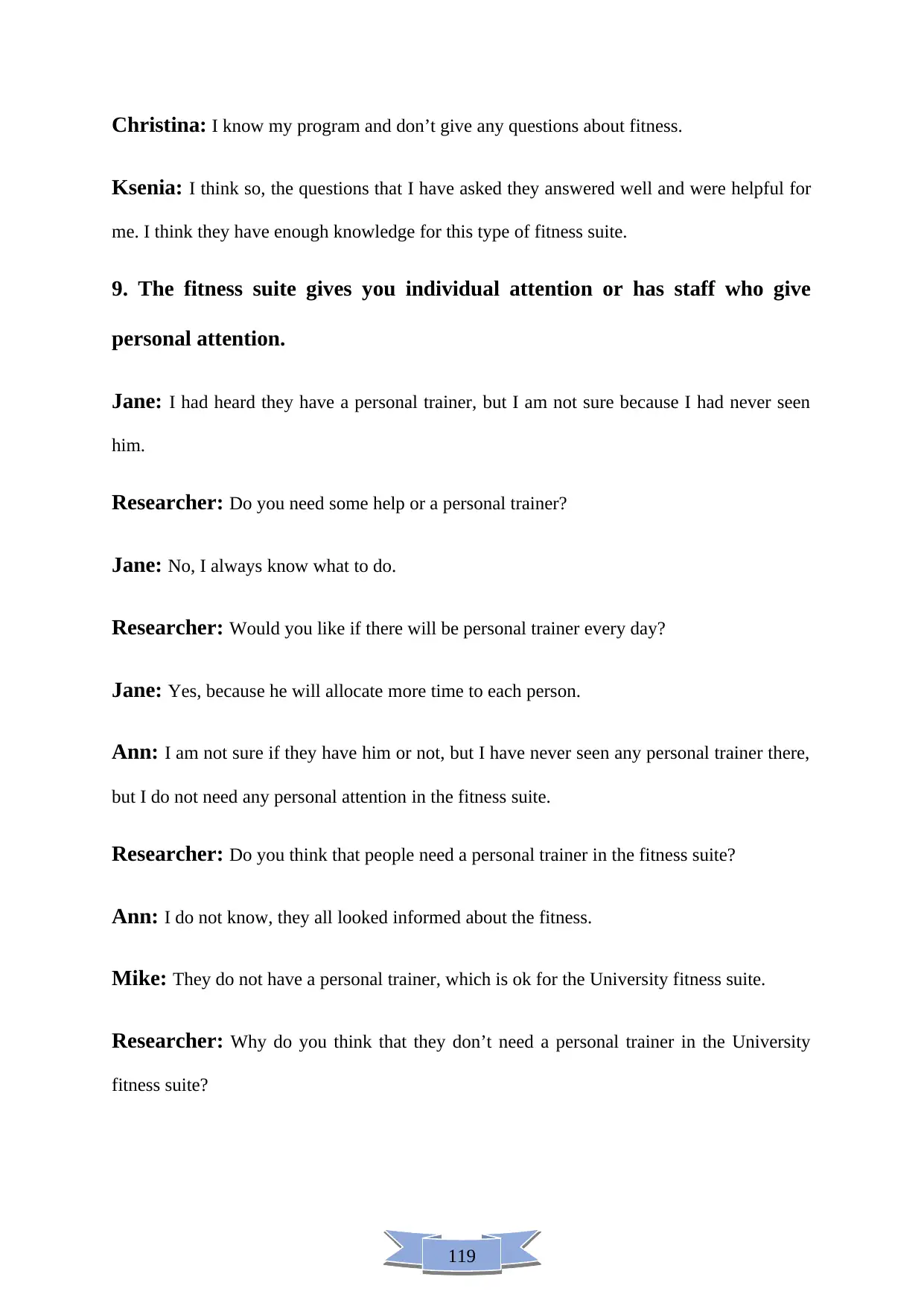
119
Christina: I know my program and don’t give any questions about fitness.
Ksenia: I think so, the questions that I have asked they answered well and were helpful for
me. I think they have enough knowledge for this type of fitness suite.
9. The fitness suite gives you individual attention or has staff who give
personal attention.
Jane: I had heard they have a personal trainer, but I am not sure because I had never seen
him.
Researcher: Do you need some help or a personal trainer?
Jane: No, I always know what to do.
Researcher: Would you like if there will be personal trainer every day?
Jane: Yes, because he will allocate more time to each person.
Ann: I am not sure if they have him or not, but I have never seen any personal trainer there,
but I do not need any personal attention in the fitness suite.
Researcher: Do you think that people need a personal trainer in the fitness suite?
Ann: I do not know, they all looked informed about the fitness.
Mike: They do not have a personal trainer, which is ok for the University fitness suite.
Researcher: Why do you think that they don’t need a personal trainer in the University
fitness suite?
Christina: I know my program and don’t give any questions about fitness.
Ksenia: I think so, the questions that I have asked they answered well and were helpful for
me. I think they have enough knowledge for this type of fitness suite.
9. The fitness suite gives you individual attention or has staff who give
personal attention.
Jane: I had heard they have a personal trainer, but I am not sure because I had never seen
him.
Researcher: Do you need some help or a personal trainer?
Jane: No, I always know what to do.
Researcher: Would you like if there will be personal trainer every day?
Jane: Yes, because he will allocate more time to each person.
Ann: I am not sure if they have him or not, but I have never seen any personal trainer there,
but I do not need any personal attention in the fitness suite.
Researcher: Do you think that people need a personal trainer in the fitness suite?
Ann: I do not know, they all looked informed about the fitness.
Mike: They do not have a personal trainer, which is ok for the University fitness suite.
Researcher: Why do you think that they don’t need a personal trainer in the University
fitness suite?
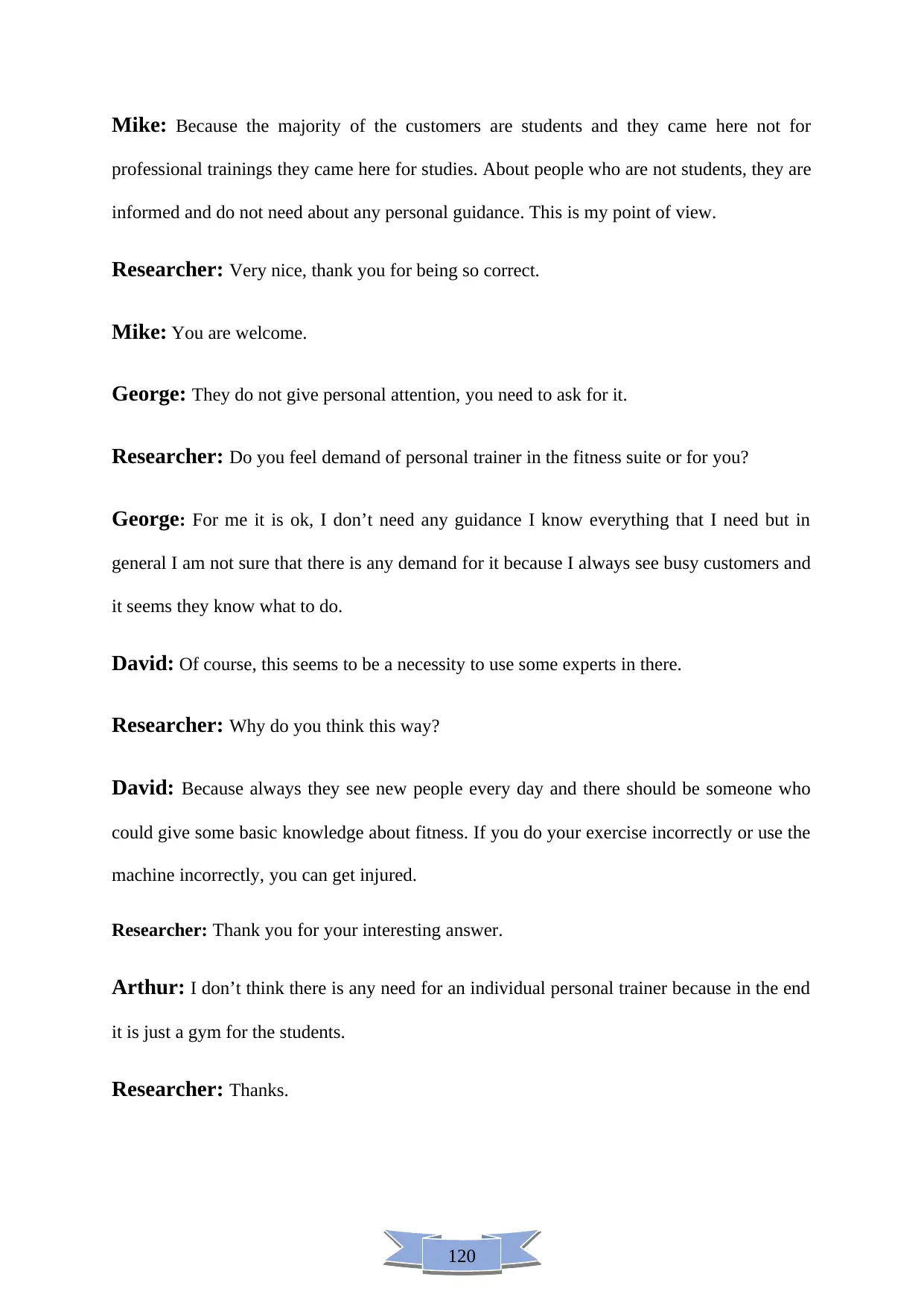
120
Mike: Because the majority of the customers are students and they came here not for
professional trainings they came here for studies. About people who are not students, they are
informed and do not need about any personal guidance. This is my point of view.
Researcher: Very nice, thank you for being so correct.
Mike: You are welcome.
George: They do not give personal attention, you need to ask for it.
Researcher: Do you feel demand of personal trainer in the fitness suite or for you?
George: For me it is ok, I don’t need any guidance I know everything that I need but in
general I am not sure that there is any demand for it because I always see busy customers and
it seems they know what to do.
David: Of course, this seems to be a necessity to use some experts in there.
Researcher: Why do you think this way?
David: Because always they see new people every day and there should be someone who
could give some basic knowledge about fitness. If you do your exercise incorrectly or use the
machine incorrectly, you can get injured.
Researcher: Thank you for your interesting answer.
Arthur: I don’t think there is any need for an individual personal trainer because in the end
it is just a gym for the students.
Researcher: Thanks.
Mike: Because the majority of the customers are students and they came here not for
professional trainings they came here for studies. About people who are not students, they are
informed and do not need about any personal guidance. This is my point of view.
Researcher: Very nice, thank you for being so correct.
Mike: You are welcome.
George: They do not give personal attention, you need to ask for it.
Researcher: Do you feel demand of personal trainer in the fitness suite or for you?
George: For me it is ok, I don’t need any guidance I know everything that I need but in
general I am not sure that there is any demand for it because I always see busy customers and
it seems they know what to do.
David: Of course, this seems to be a necessity to use some experts in there.
Researcher: Why do you think this way?
David: Because always they see new people every day and there should be someone who
could give some basic knowledge about fitness. If you do your exercise incorrectly or use the
machine incorrectly, you can get injured.
Researcher: Thank you for your interesting answer.
Arthur: I don’t think there is any need for an individual personal trainer because in the end
it is just a gym for the students.
Researcher: Thanks.
Paraphrase This Document
Need a fresh take? Get an instant paraphrase of this document with our AI Paraphraser
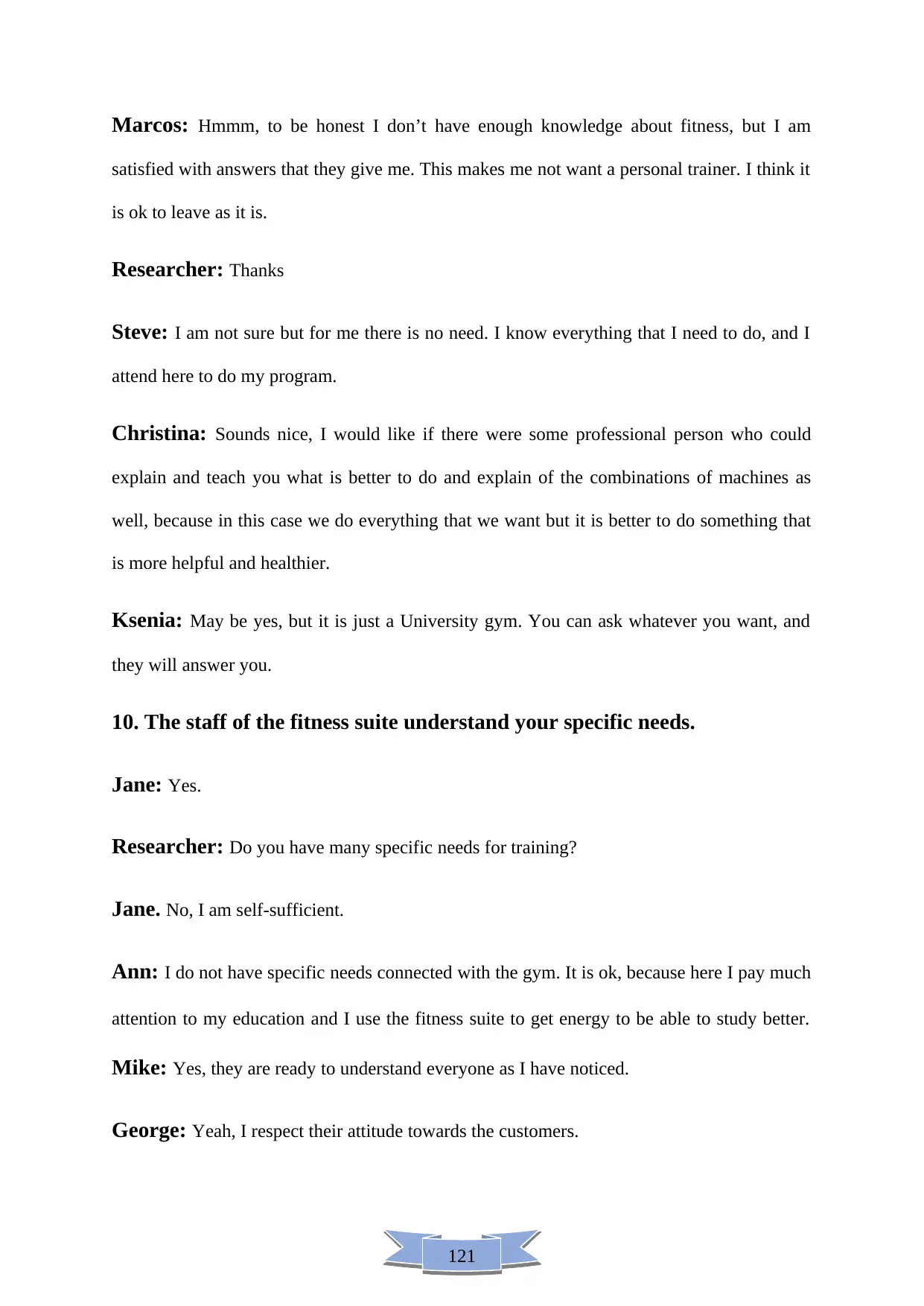
121
Marcos: Hmmm, to be honest I don’t have enough knowledge about fitness, but I am
satisfied with answers that they give me. This makes me not want a personal trainer. I think it
is ok to leave as it is.
Researcher: Thanks
Steve: I am not sure but for me there is no need. I know everything that I need to do, and I
attend here to do my program.
Christina: Sounds nice, I would like if there were some professional person who could
explain and teach you what is better to do and explain of the combinations of machines as
well, because in this case we do everything that we want but it is better to do something that
is more helpful and healthier.
Ksenia: May be yes, but it is just a University gym. You can ask whatever you want, and
they will answer you.
10. The staff of the fitness suite understand your specific needs.
Jane: Yes.
Researcher: Do you have many specific needs for training?
Jane. No, I am self-sufficient.
Ann: I do not have specific needs connected with the gym. It is ok, because here I pay much
attention to my education and I use the fitness suite to get energy to be able to study better.
Mike: Yes, they are ready to understand everyone as I have noticed.
George: Yeah, I respect their attitude towards the customers.
Marcos: Hmmm, to be honest I don’t have enough knowledge about fitness, but I am
satisfied with answers that they give me. This makes me not want a personal trainer. I think it
is ok to leave as it is.
Researcher: Thanks
Steve: I am not sure but for me there is no need. I know everything that I need to do, and I
attend here to do my program.
Christina: Sounds nice, I would like if there were some professional person who could
explain and teach you what is better to do and explain of the combinations of machines as
well, because in this case we do everything that we want but it is better to do something that
is more helpful and healthier.
Ksenia: May be yes, but it is just a University gym. You can ask whatever you want, and
they will answer you.
10. The staff of the fitness suite understand your specific needs.
Jane: Yes.
Researcher: Do you have many specific needs for training?
Jane. No, I am self-sufficient.
Ann: I do not have specific needs connected with the gym. It is ok, because here I pay much
attention to my education and I use the fitness suite to get energy to be able to study better.
Mike: Yes, they are ready to understand everyone as I have noticed.
George: Yeah, I respect their attitude towards the customers.
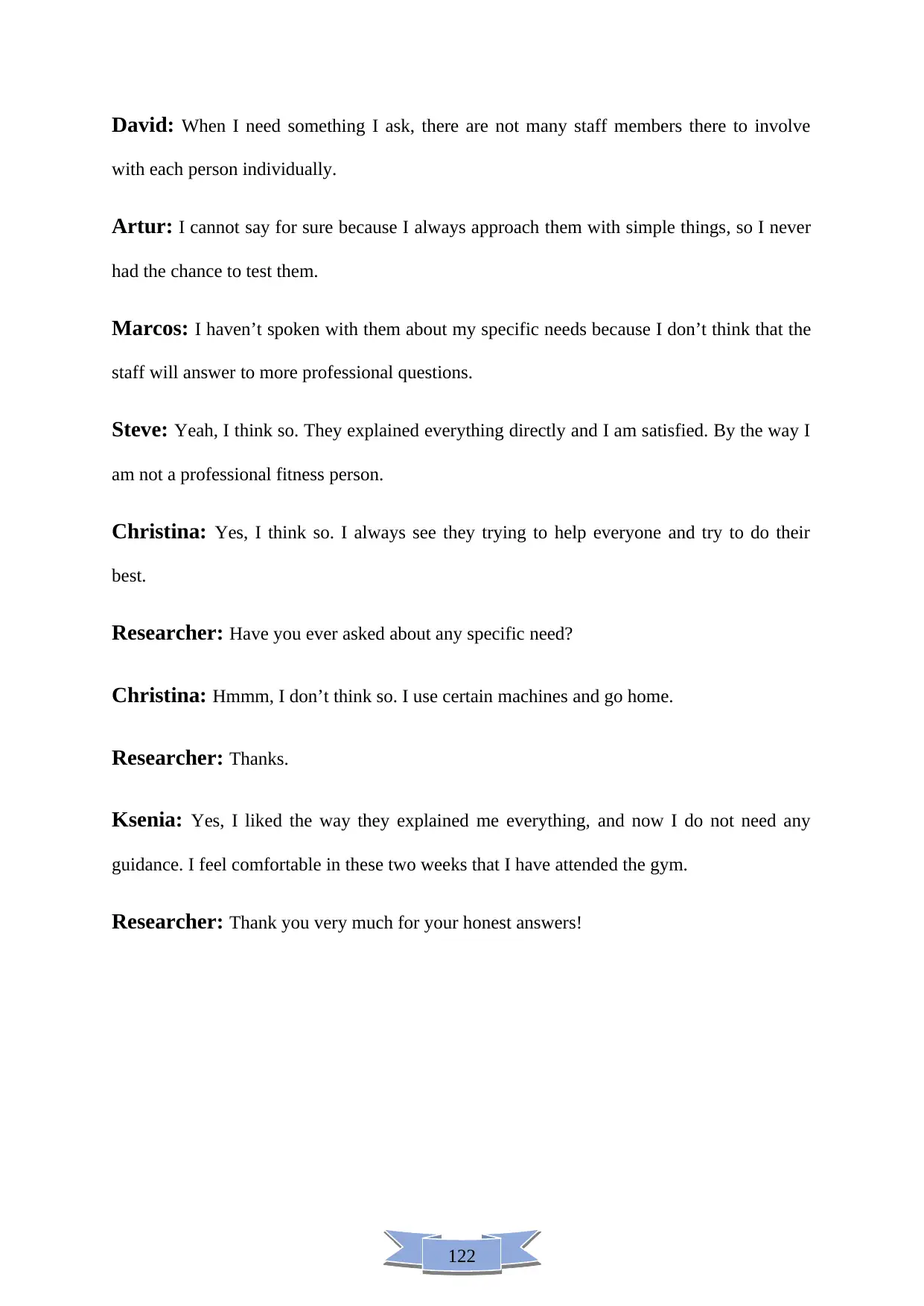
122
David: When I need something I ask, there are not many staff members there to involve
with each person individually.
Artur: I cannot say for sure because I always approach them with simple things, so I never
had the chance to test them.
Marcos: I haven’t spoken with them about my specific needs because I don’t think that the
staff will answer to more professional questions.
Steve: Yeah, I think so. They explained everything directly and I am satisfied. By the way I
am not a professional fitness person.
Christina: Yes, I think so. I always see they trying to help everyone and try to do their
best.
Researcher: Have you ever asked about any specific need?
Christina: Hmmm, I don’t think so. I use certain machines and go home.
Researcher: Thanks.
Ksenia: Yes, I liked the way they explained me everything, and now I do not need any
guidance. I feel comfortable in these two weeks that I have attended the gym.
Researcher: Thank you very much for your honest answers!
David: When I need something I ask, there are not many staff members there to involve
with each person individually.
Artur: I cannot say for sure because I always approach them with simple things, so I never
had the chance to test them.
Marcos: I haven’t spoken with them about my specific needs because I don’t think that the
staff will answer to more professional questions.
Steve: Yeah, I think so. They explained everything directly and I am satisfied. By the way I
am not a professional fitness person.
Christina: Yes, I think so. I always see they trying to help everyone and try to do their
best.
Researcher: Have you ever asked about any specific need?
Christina: Hmmm, I don’t think so. I use certain machines and go home.
Researcher: Thanks.
Ksenia: Yes, I liked the way they explained me everything, and now I do not need any
guidance. I feel comfortable in these two weeks that I have attended the gym.
Researcher: Thank you very much for your honest answers!
1 out of 123
Related Documents
Your All-in-One AI-Powered Toolkit for Academic Success.
+13062052269
info@desklib.com
Available 24*7 on WhatsApp / Email
![[object Object]](/_next/static/media/star-bottom.7253800d.svg)
Unlock your academic potential
© 2024 | Zucol Services PVT LTD | All rights reserved.





